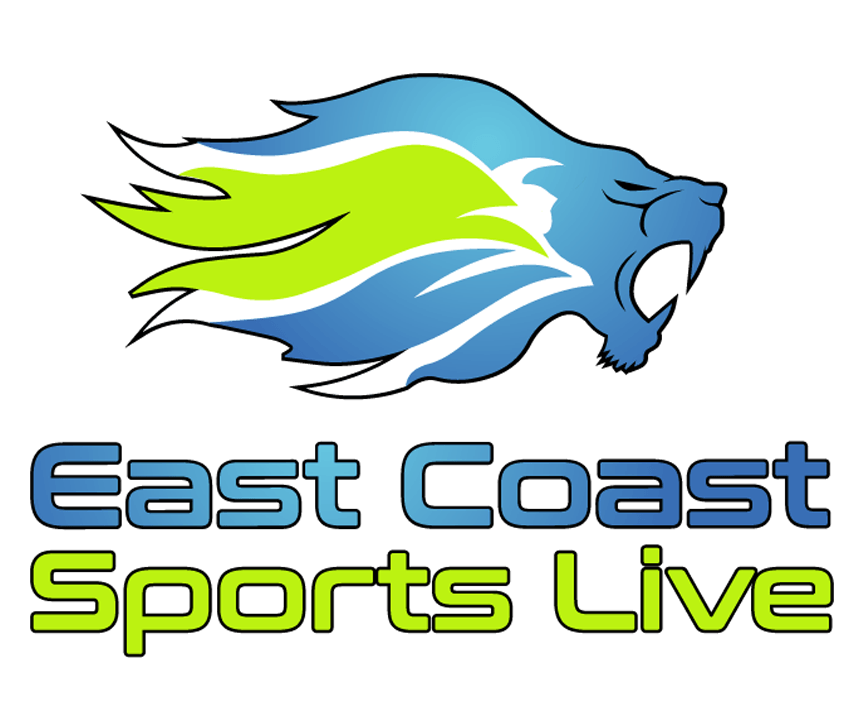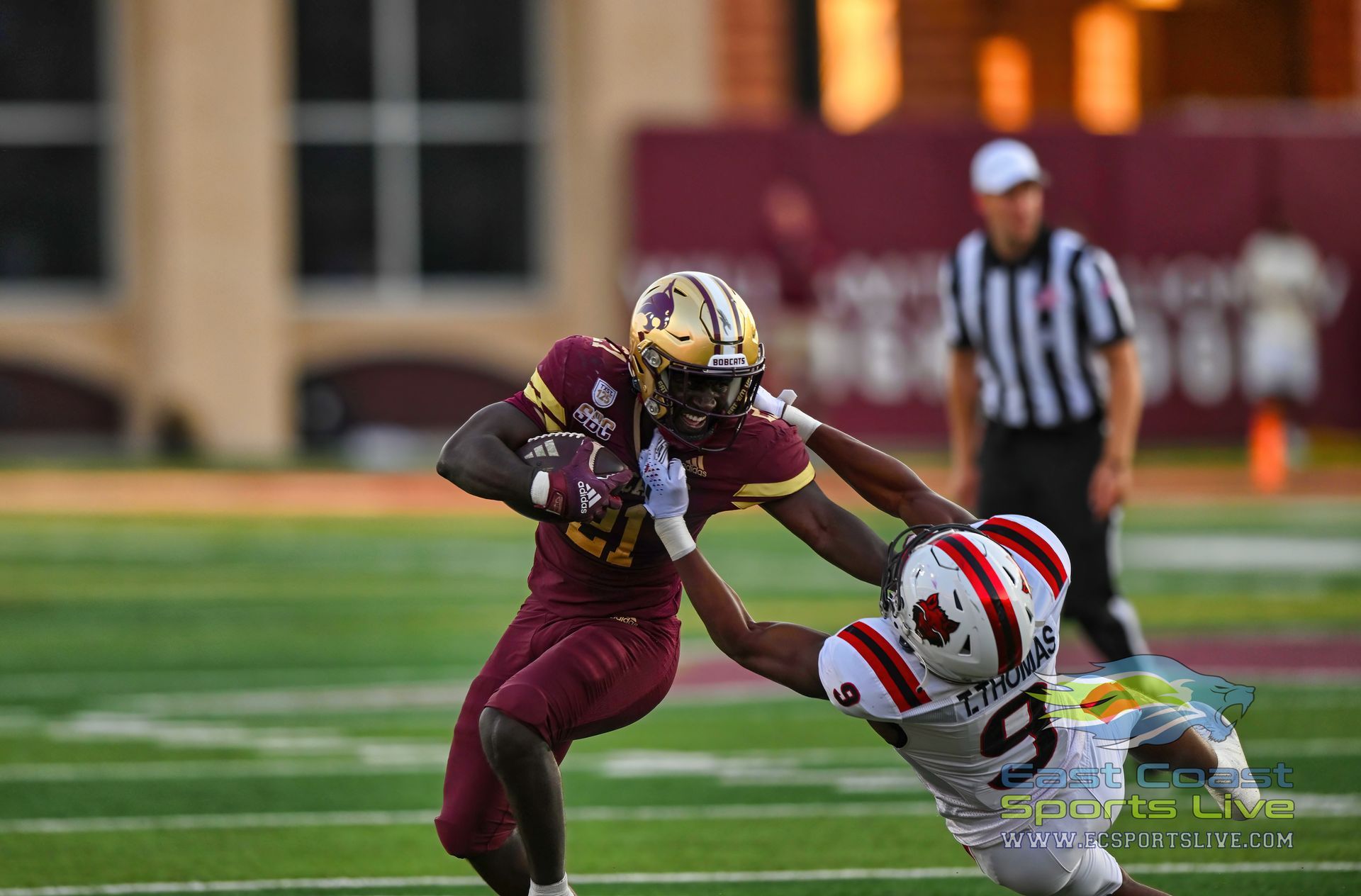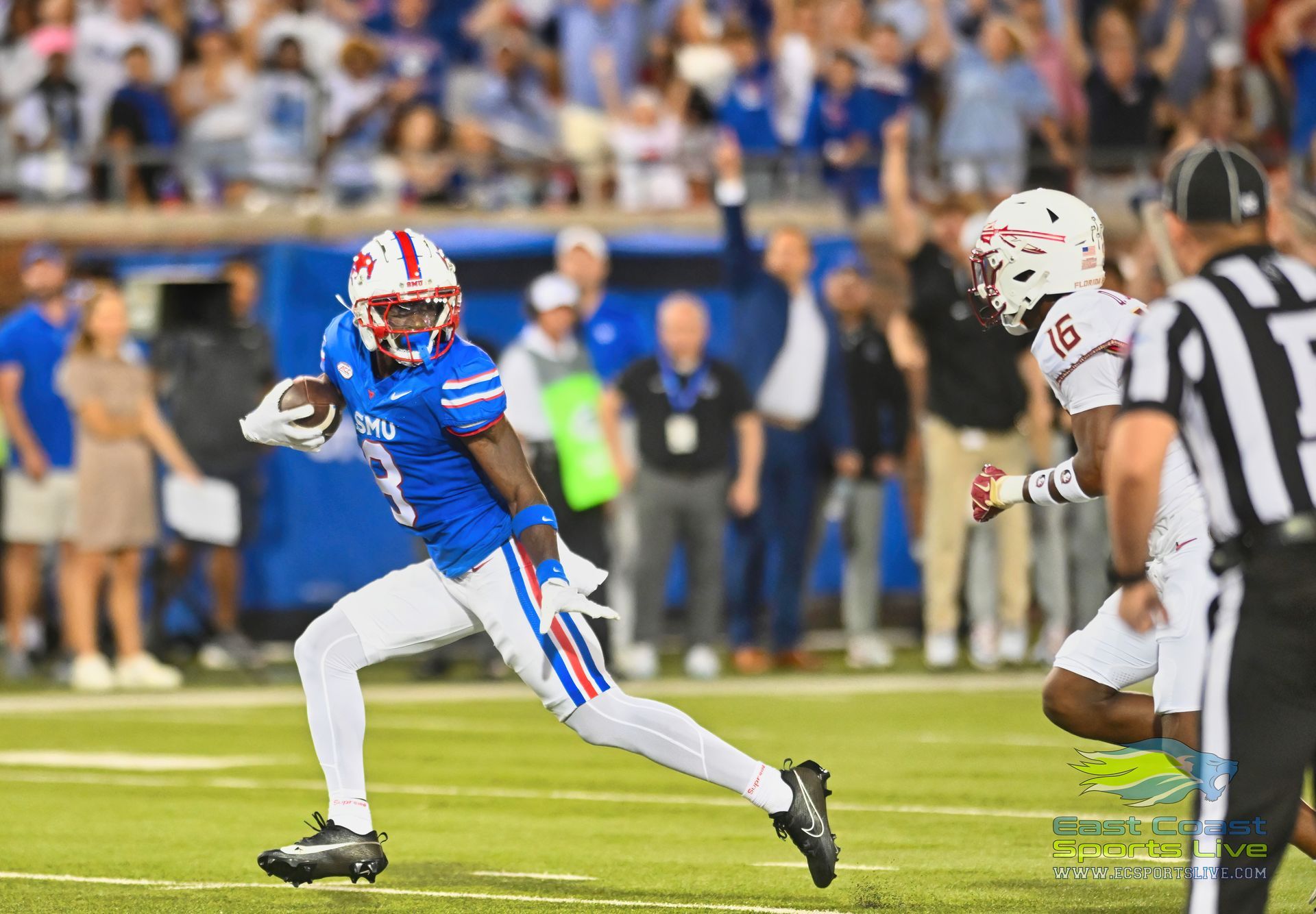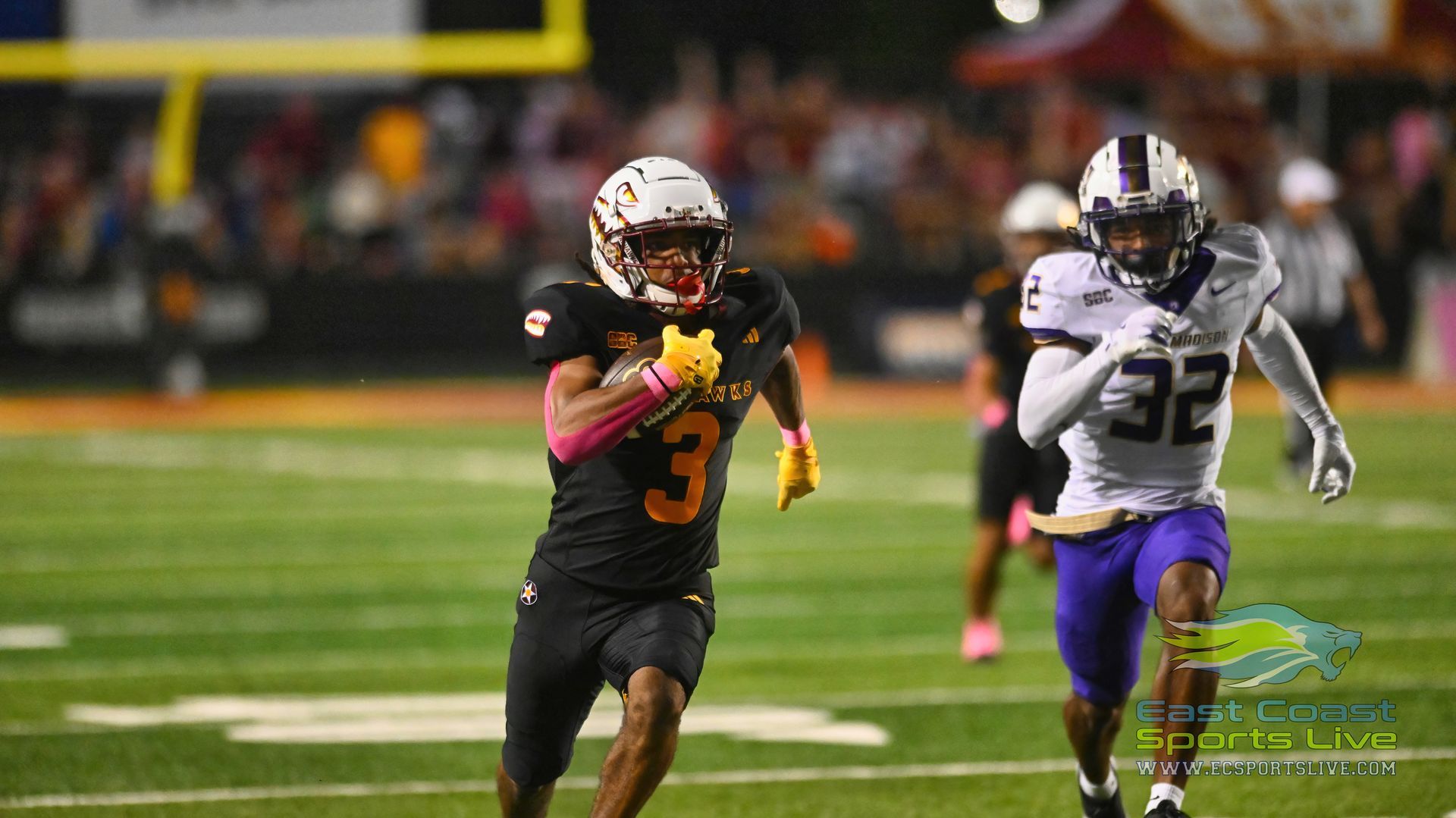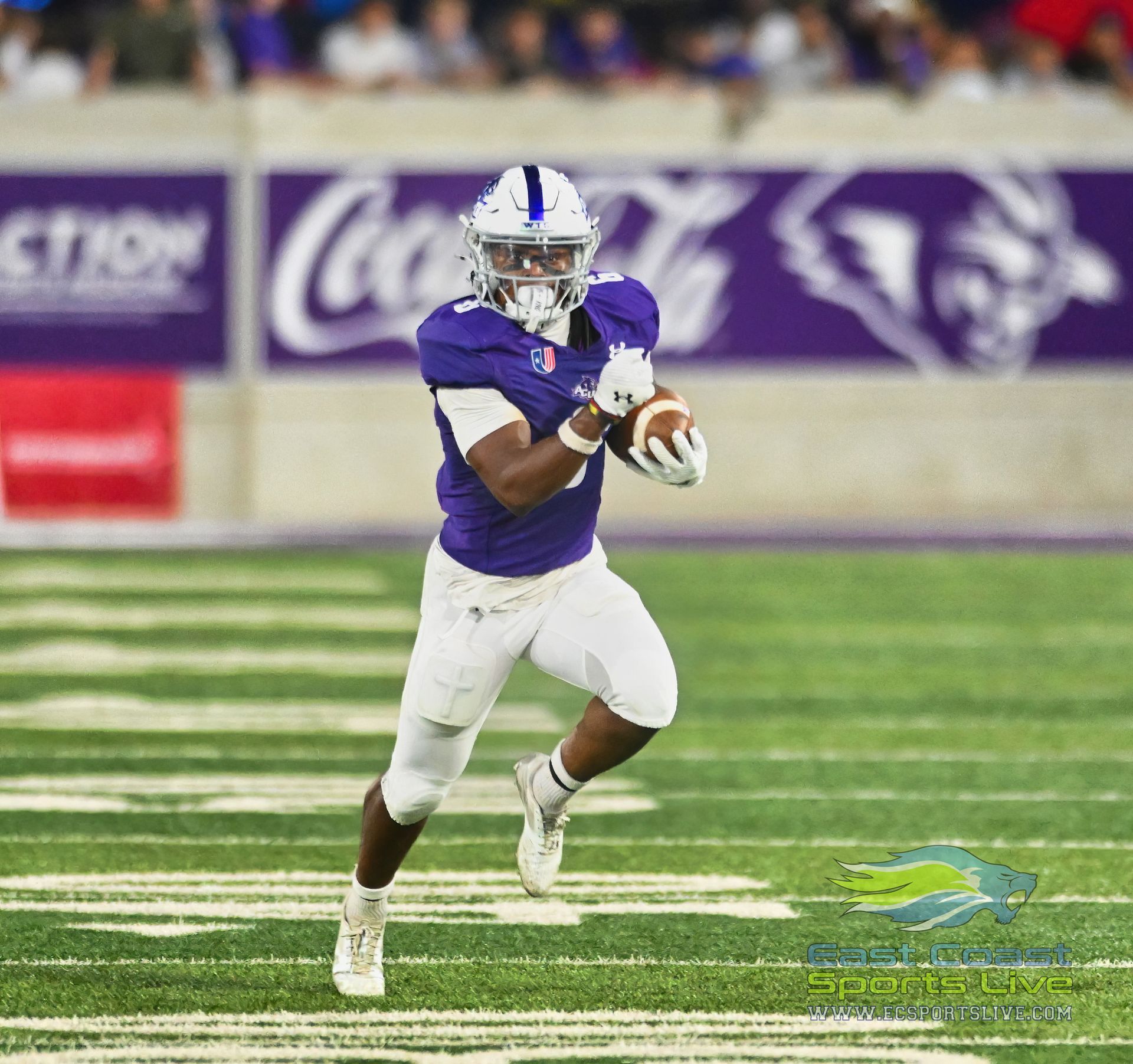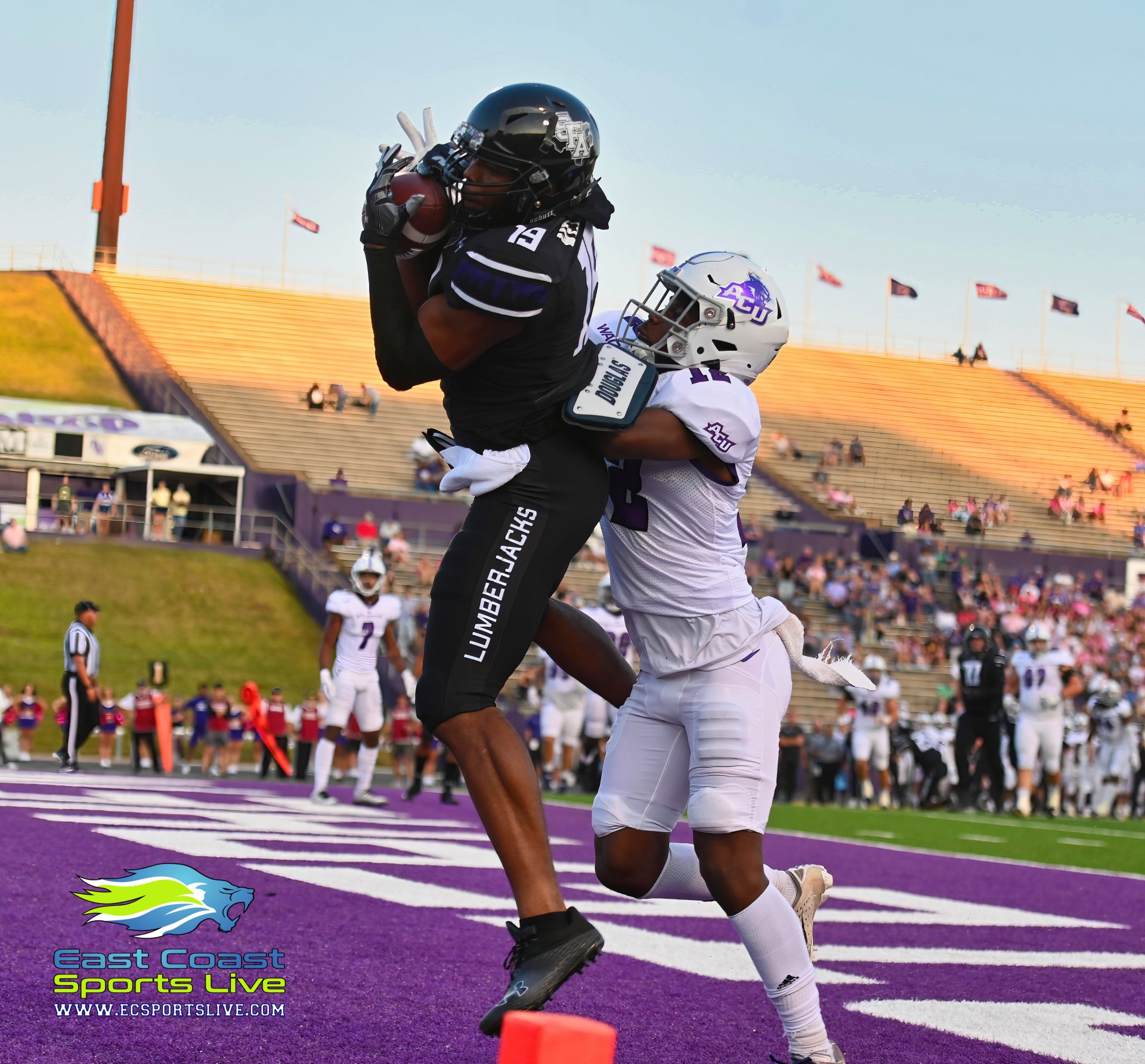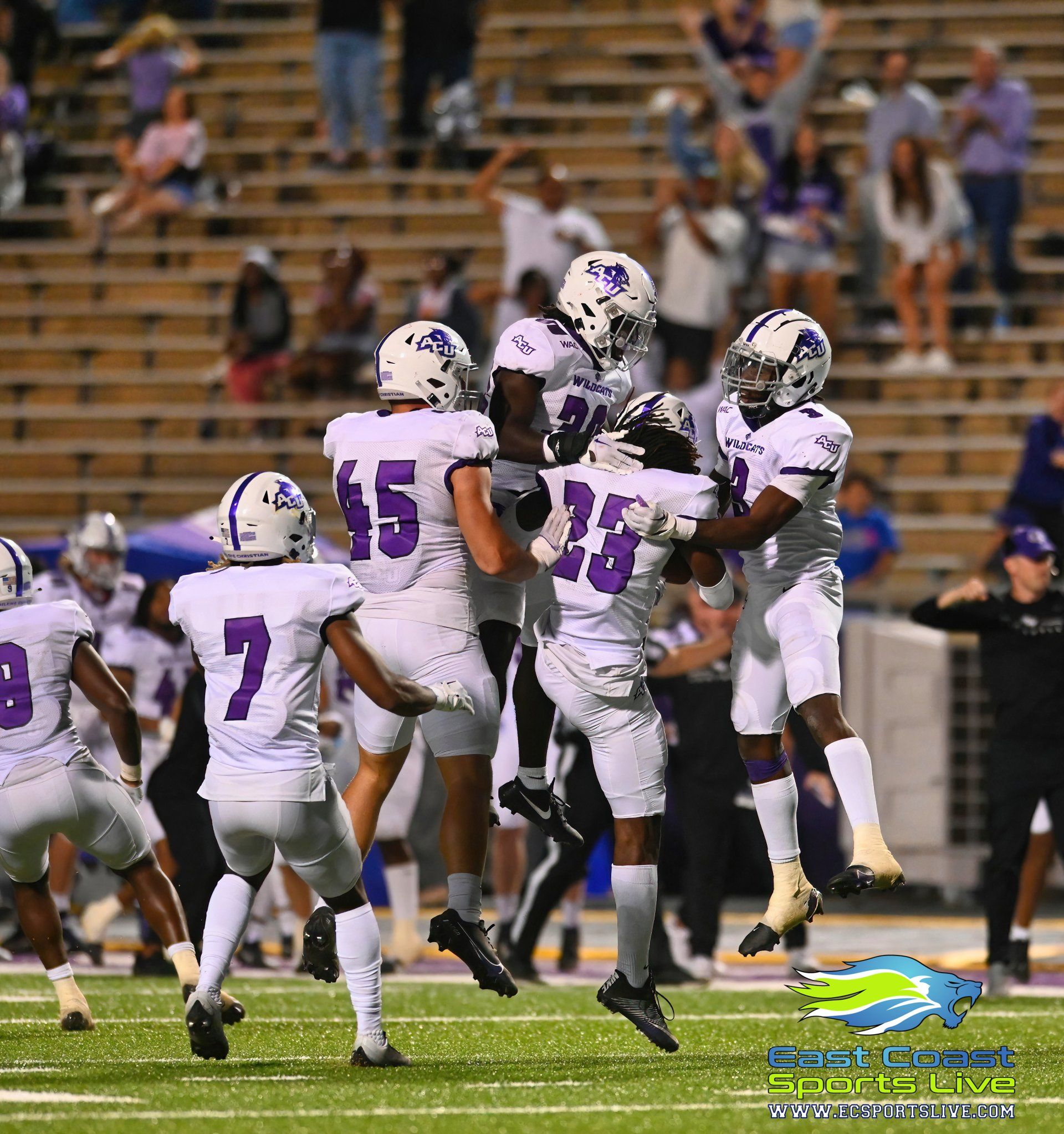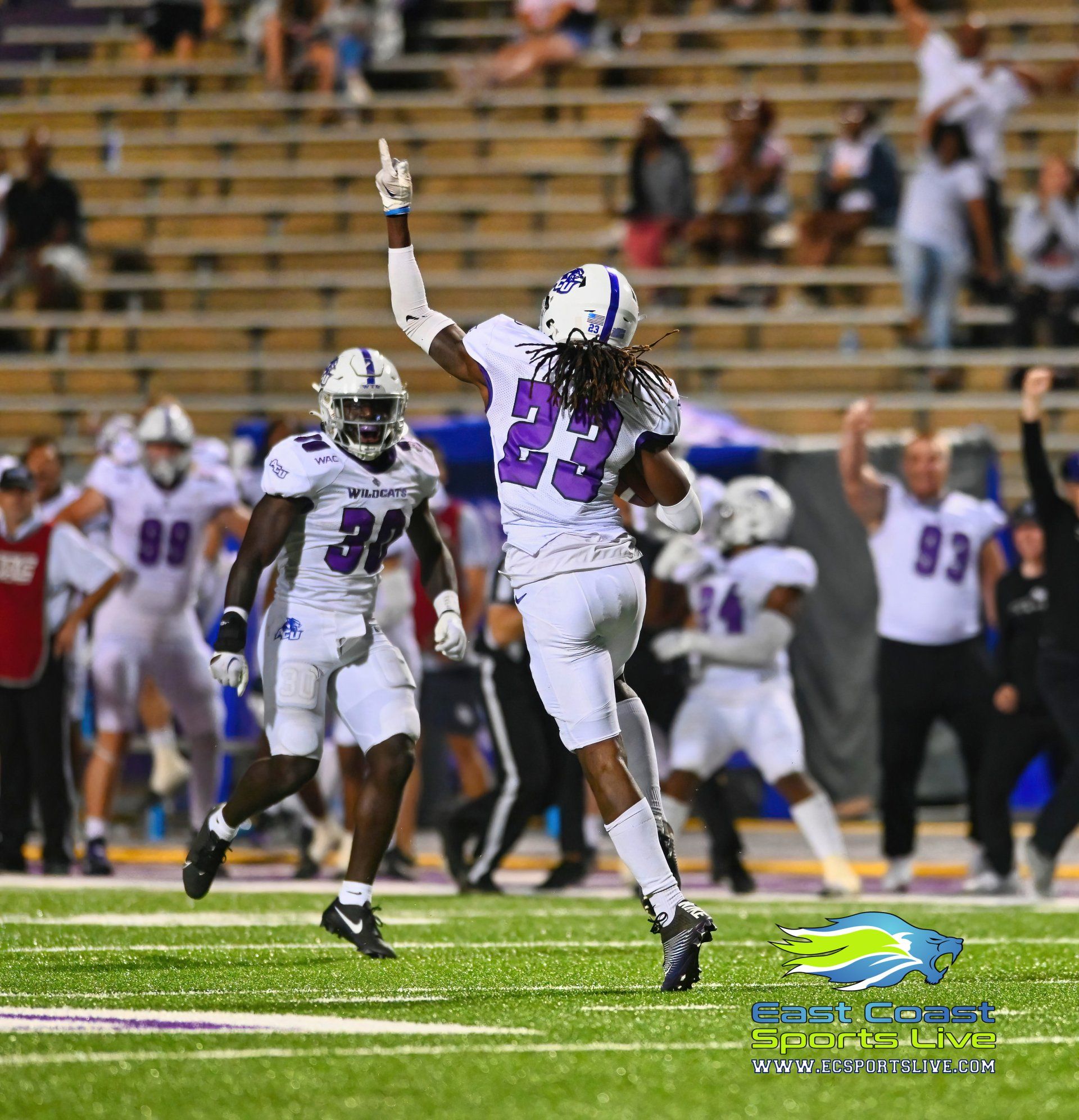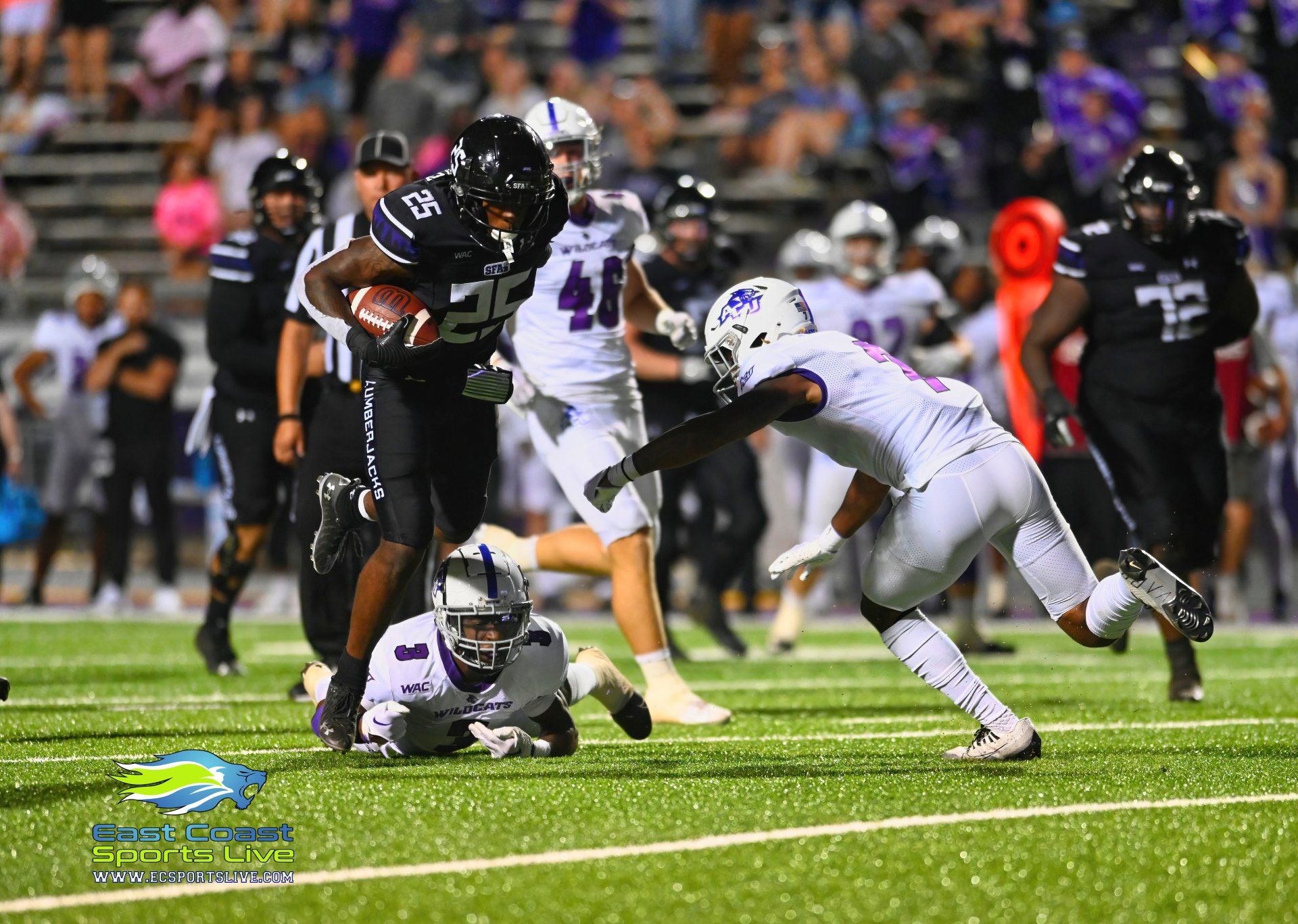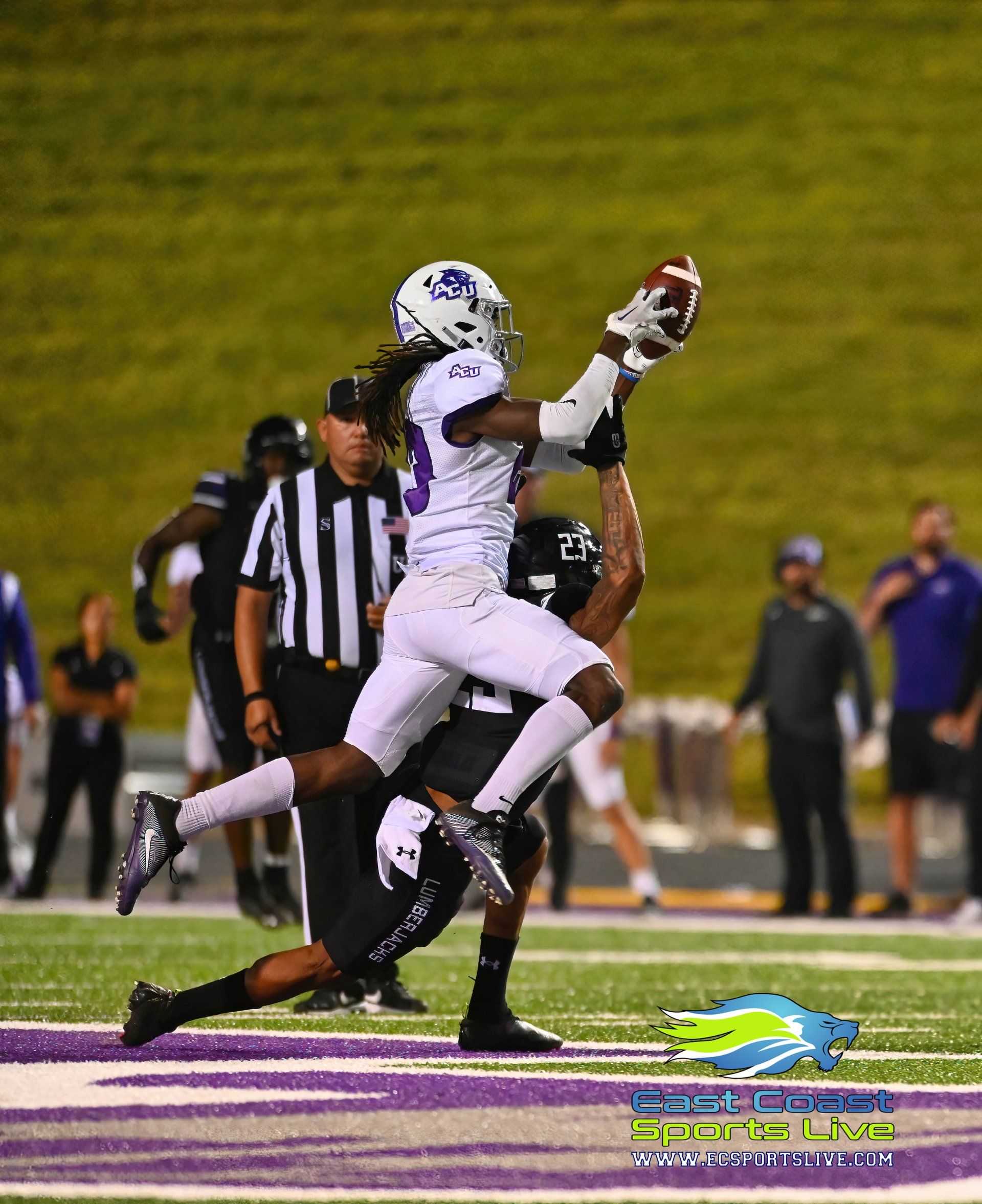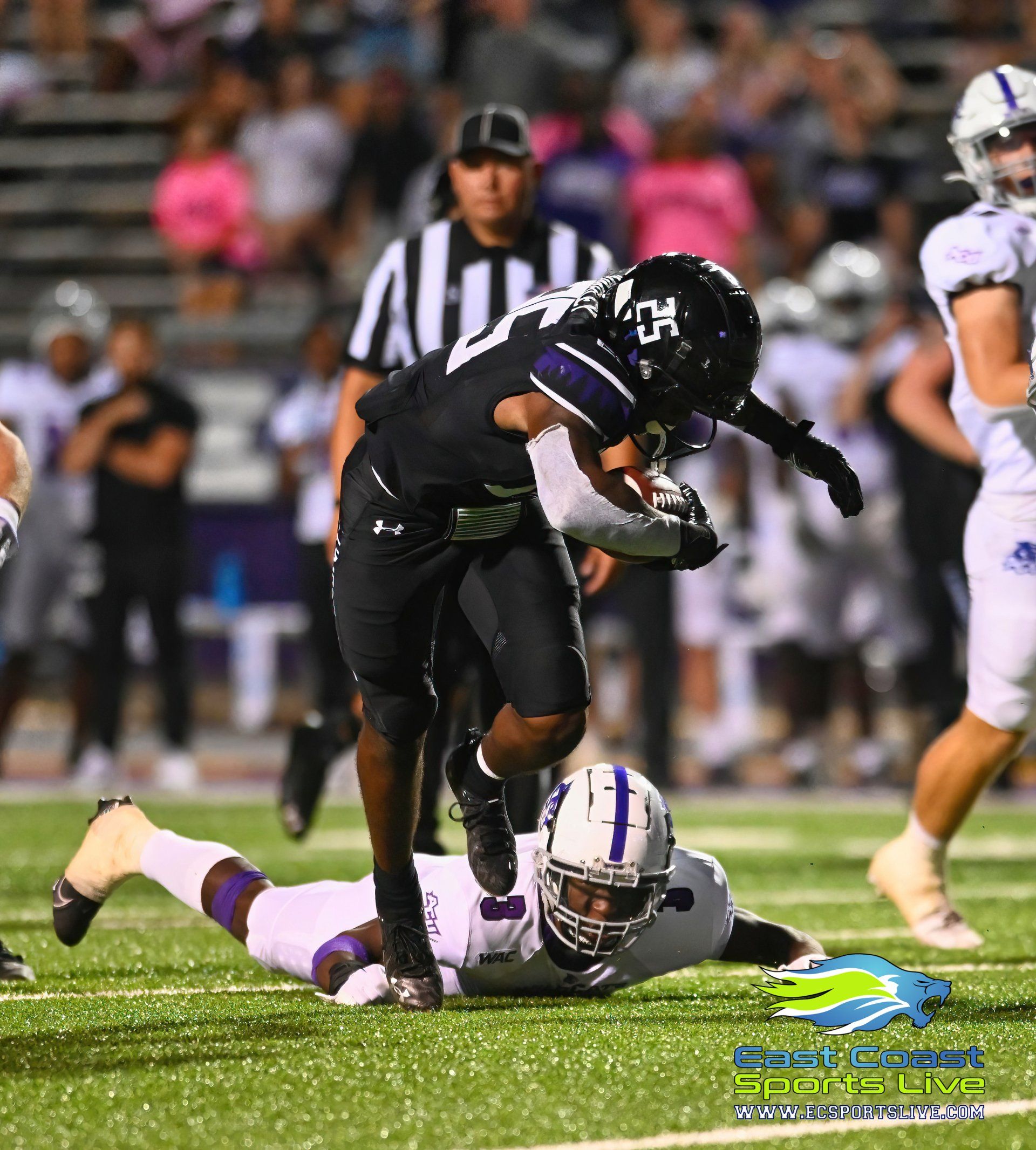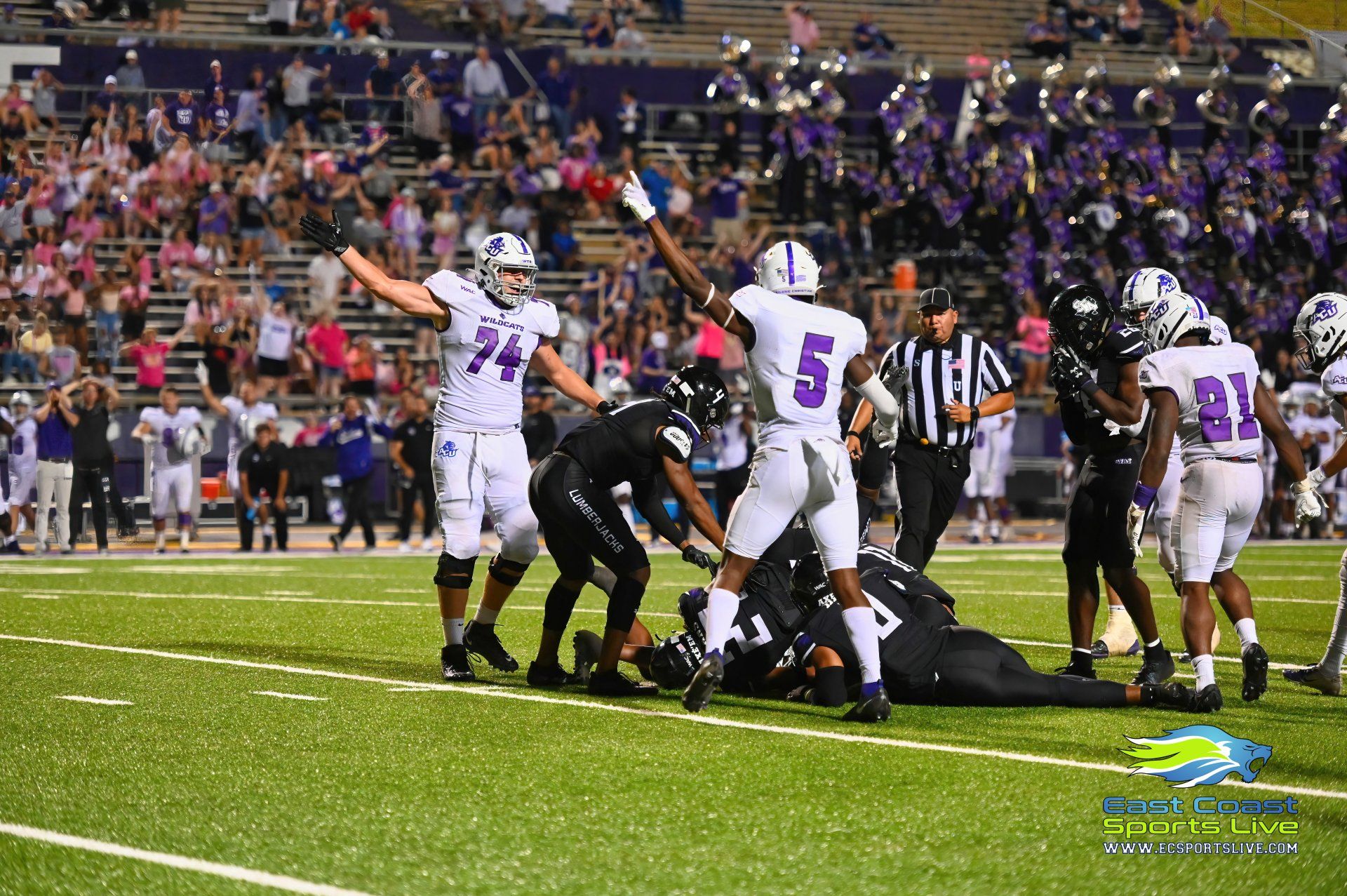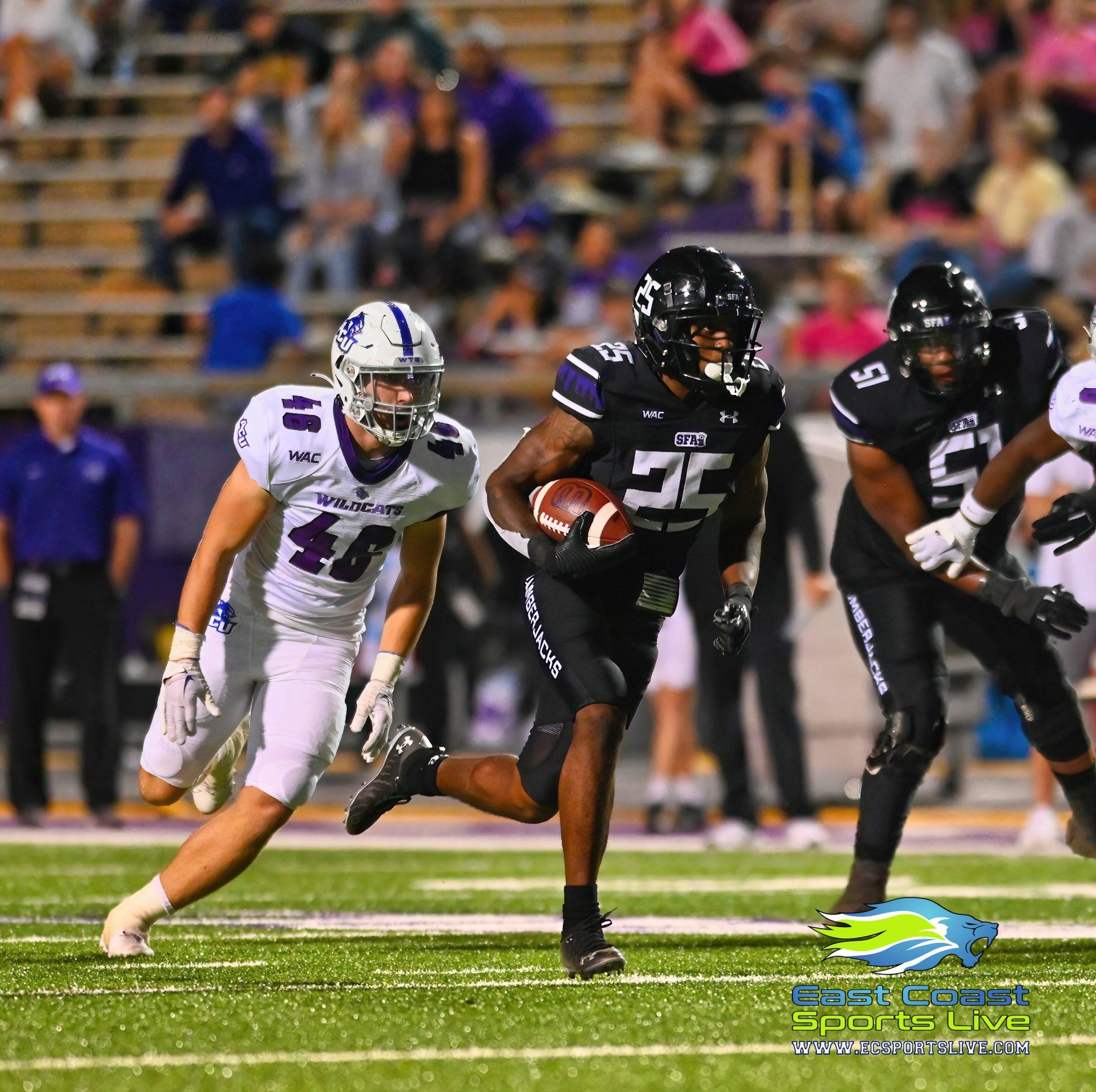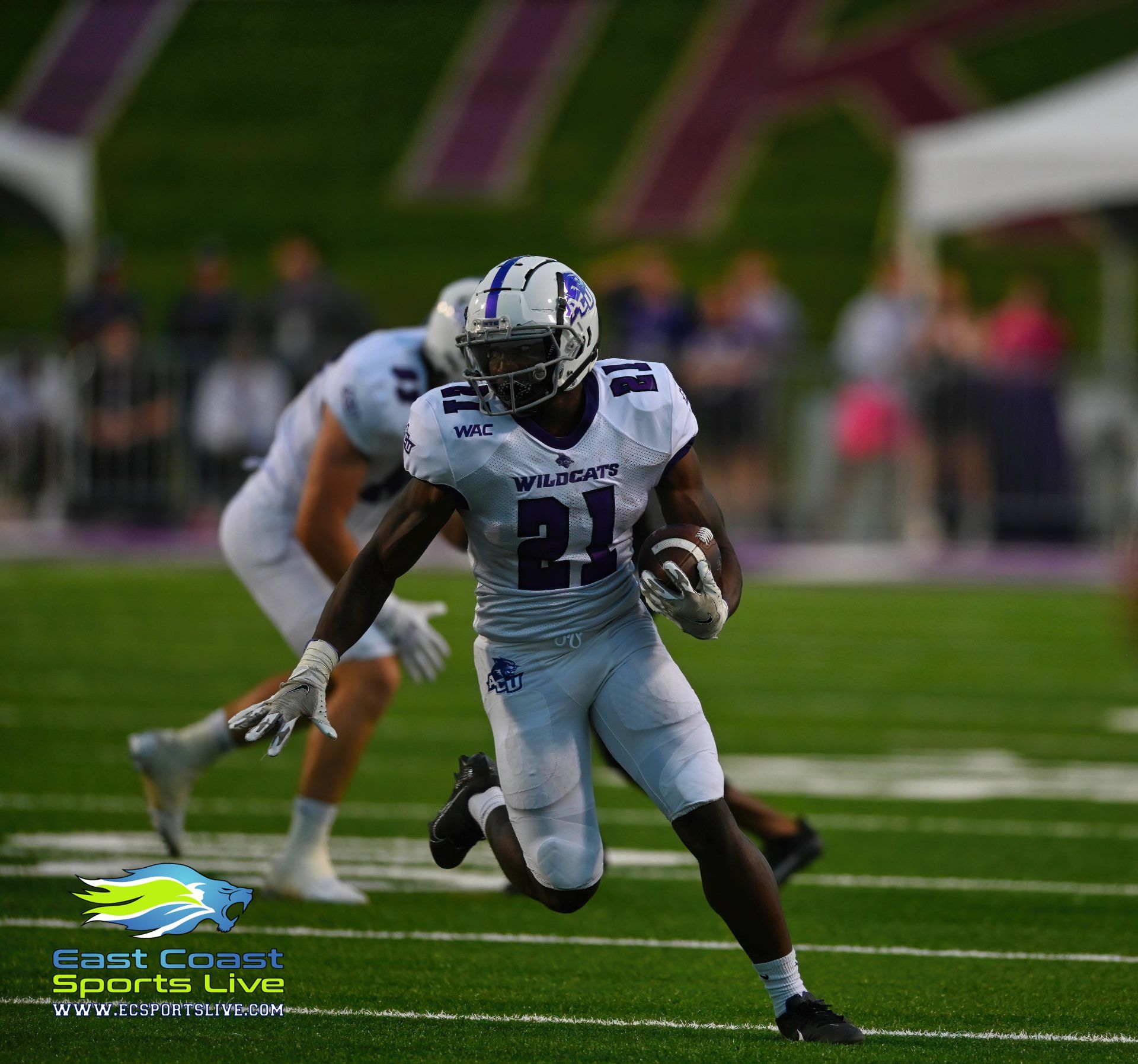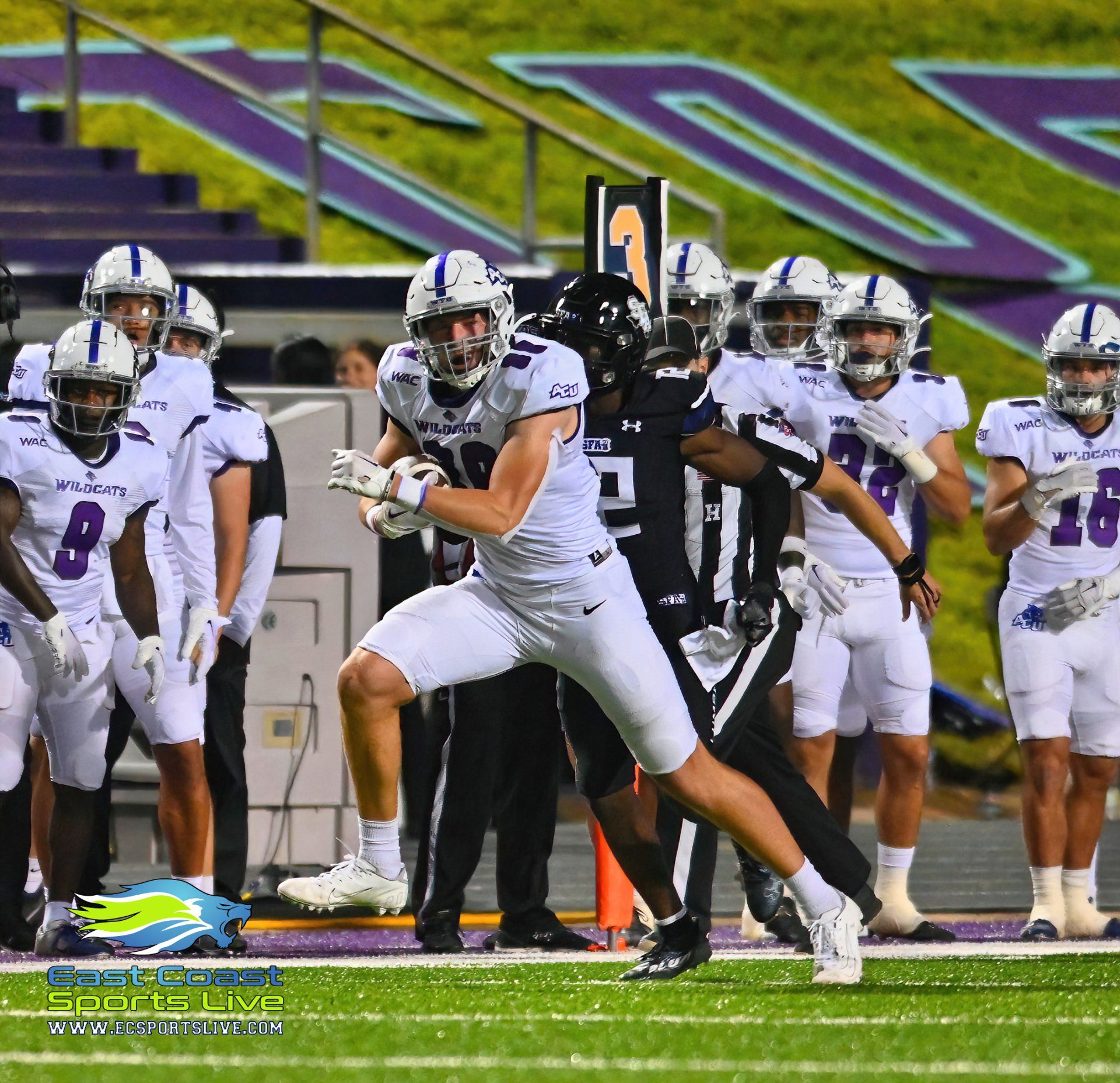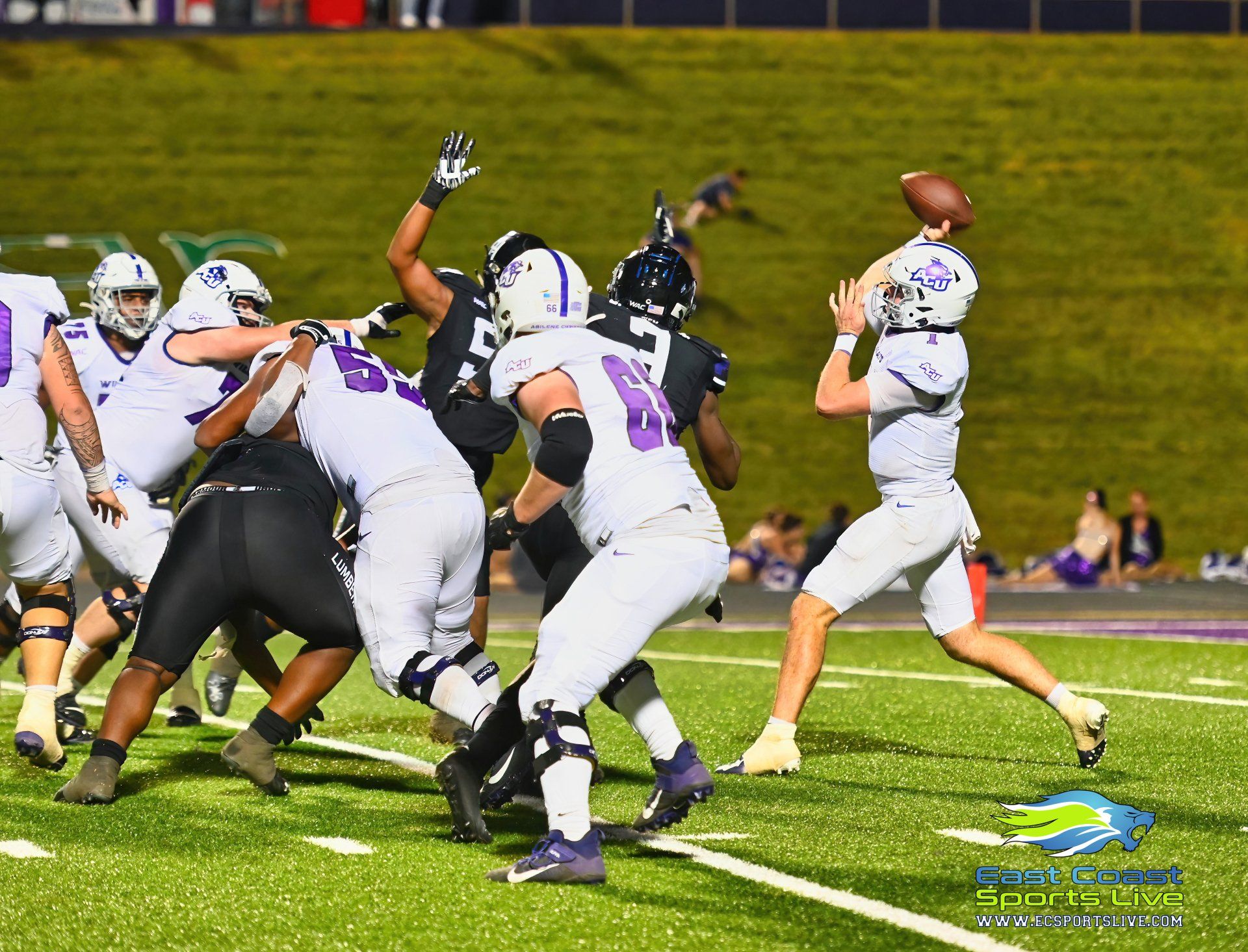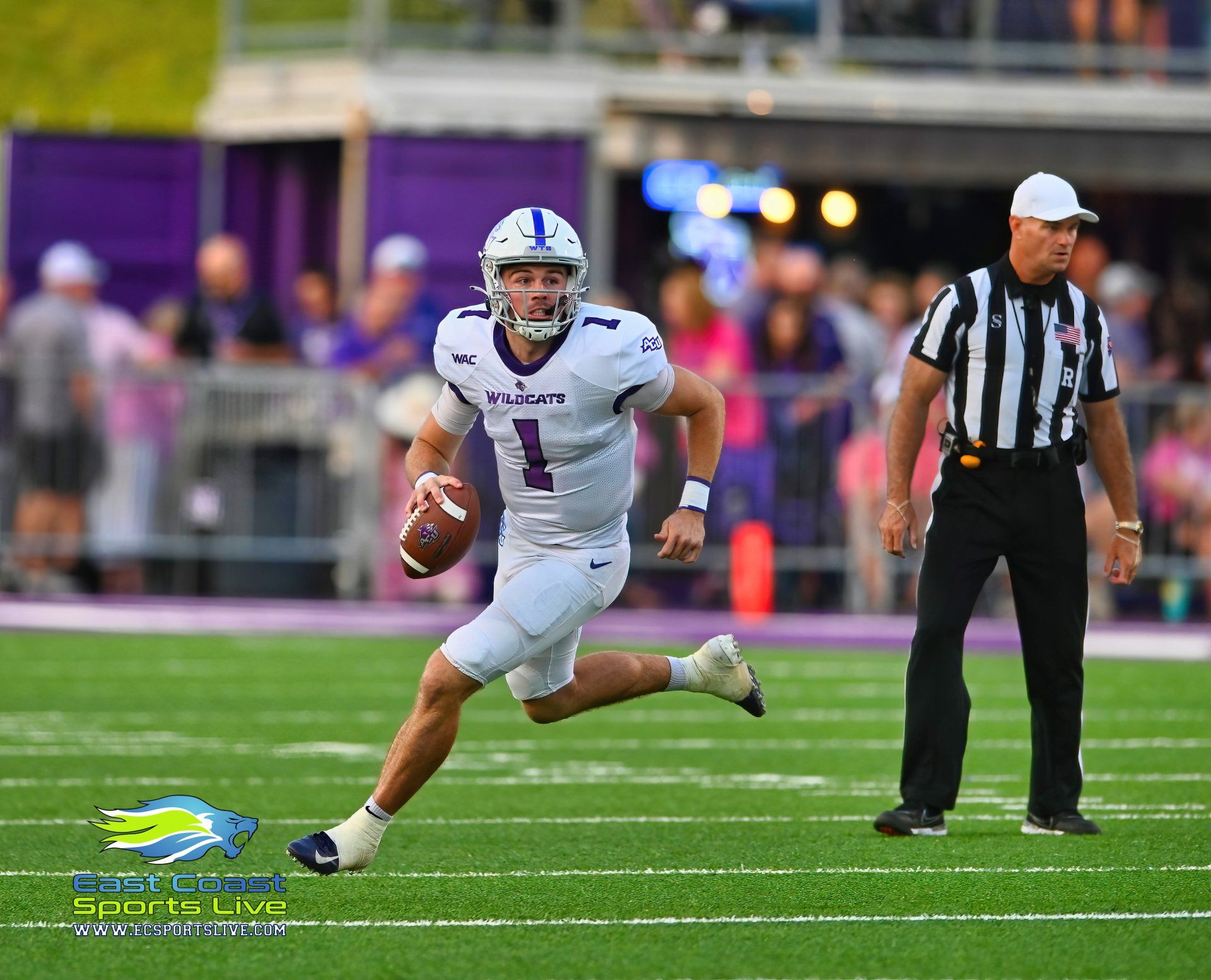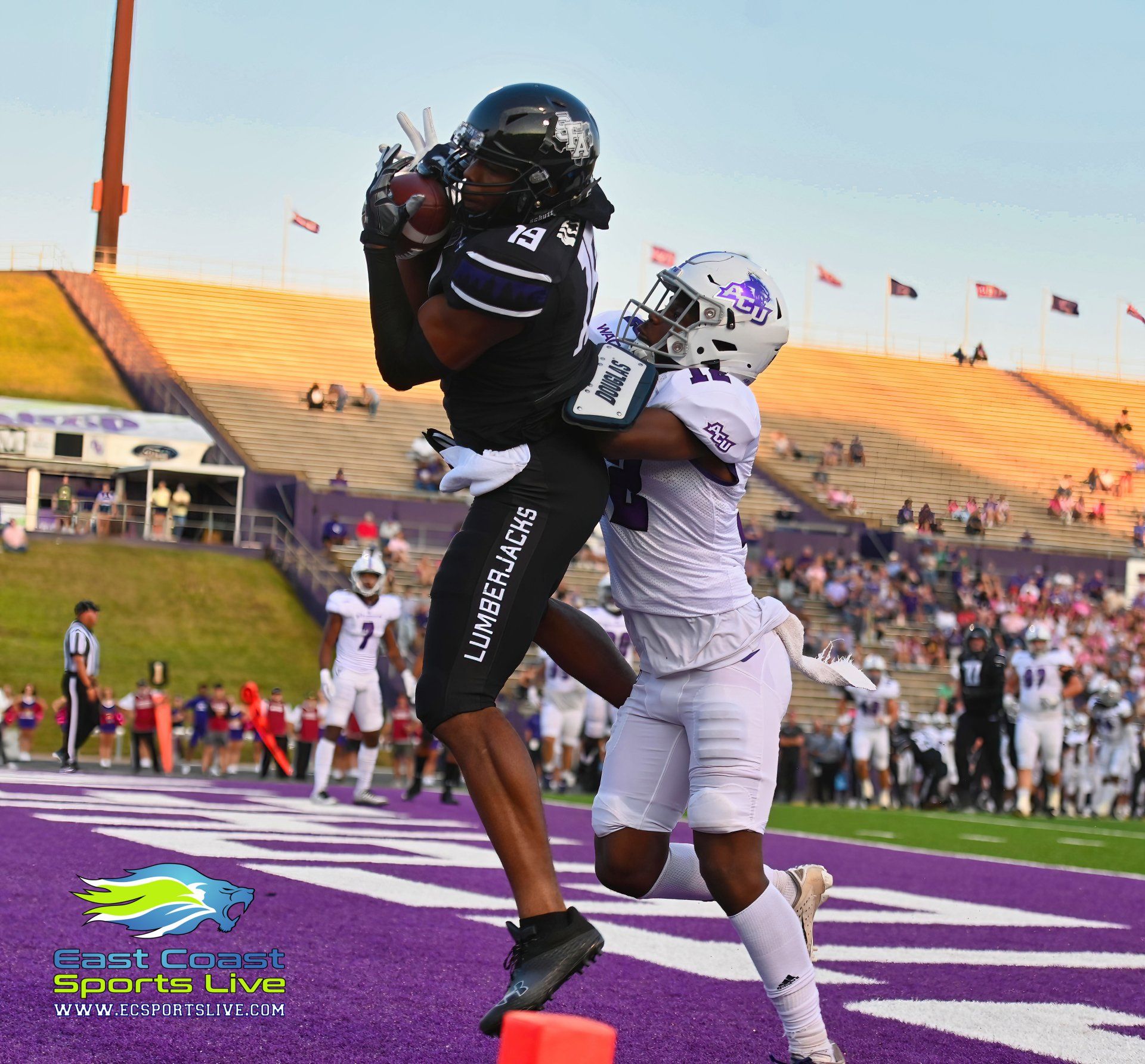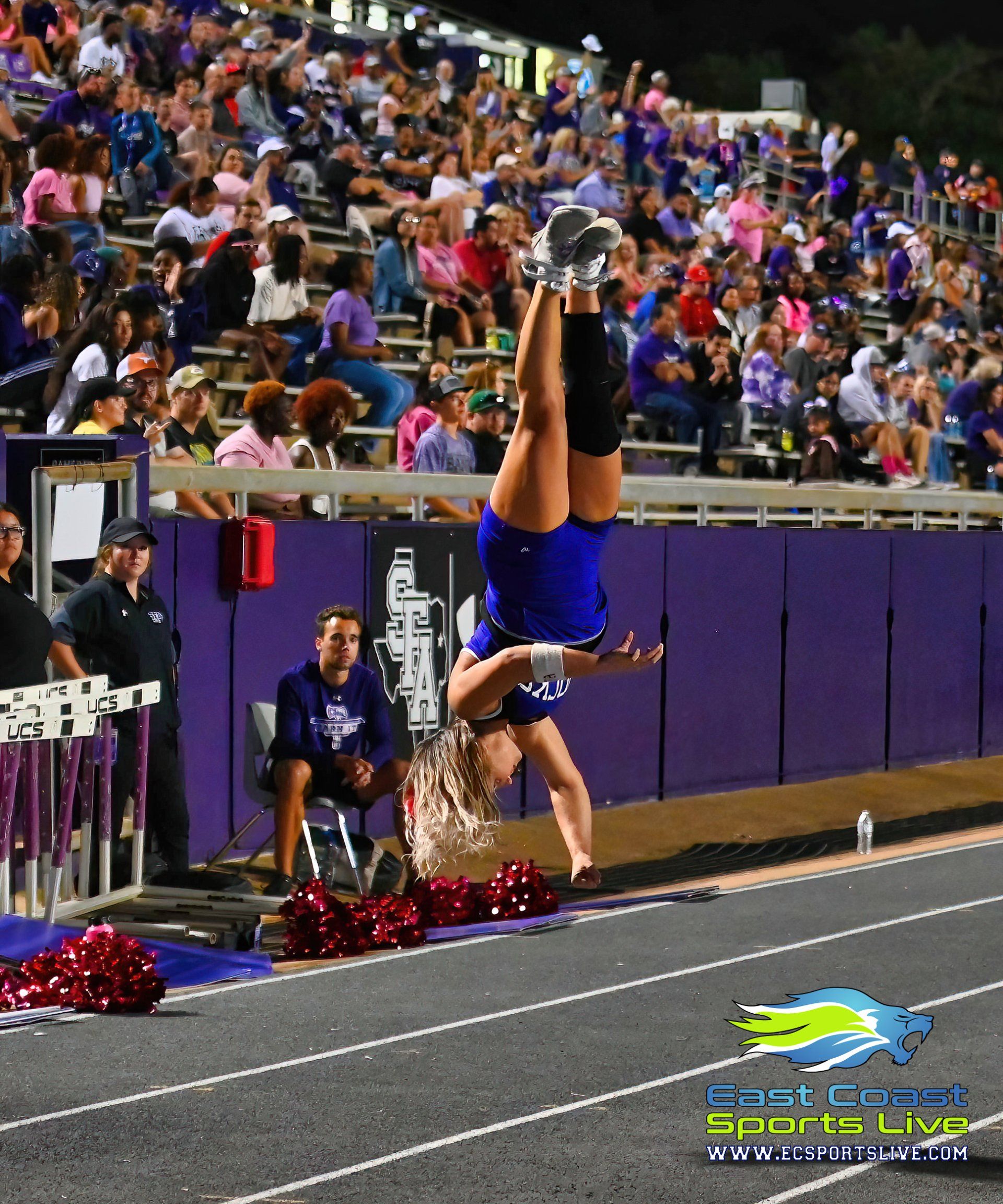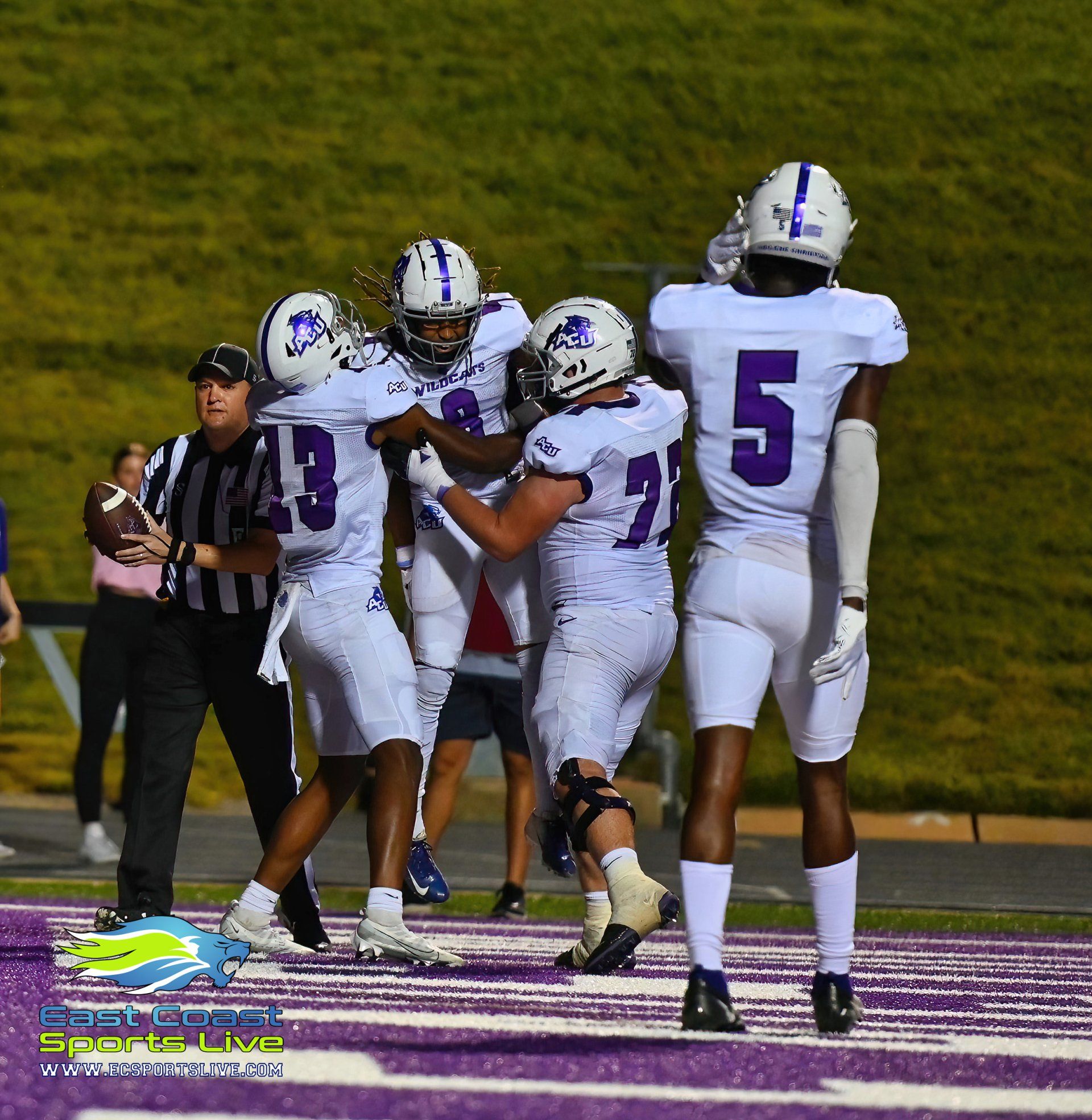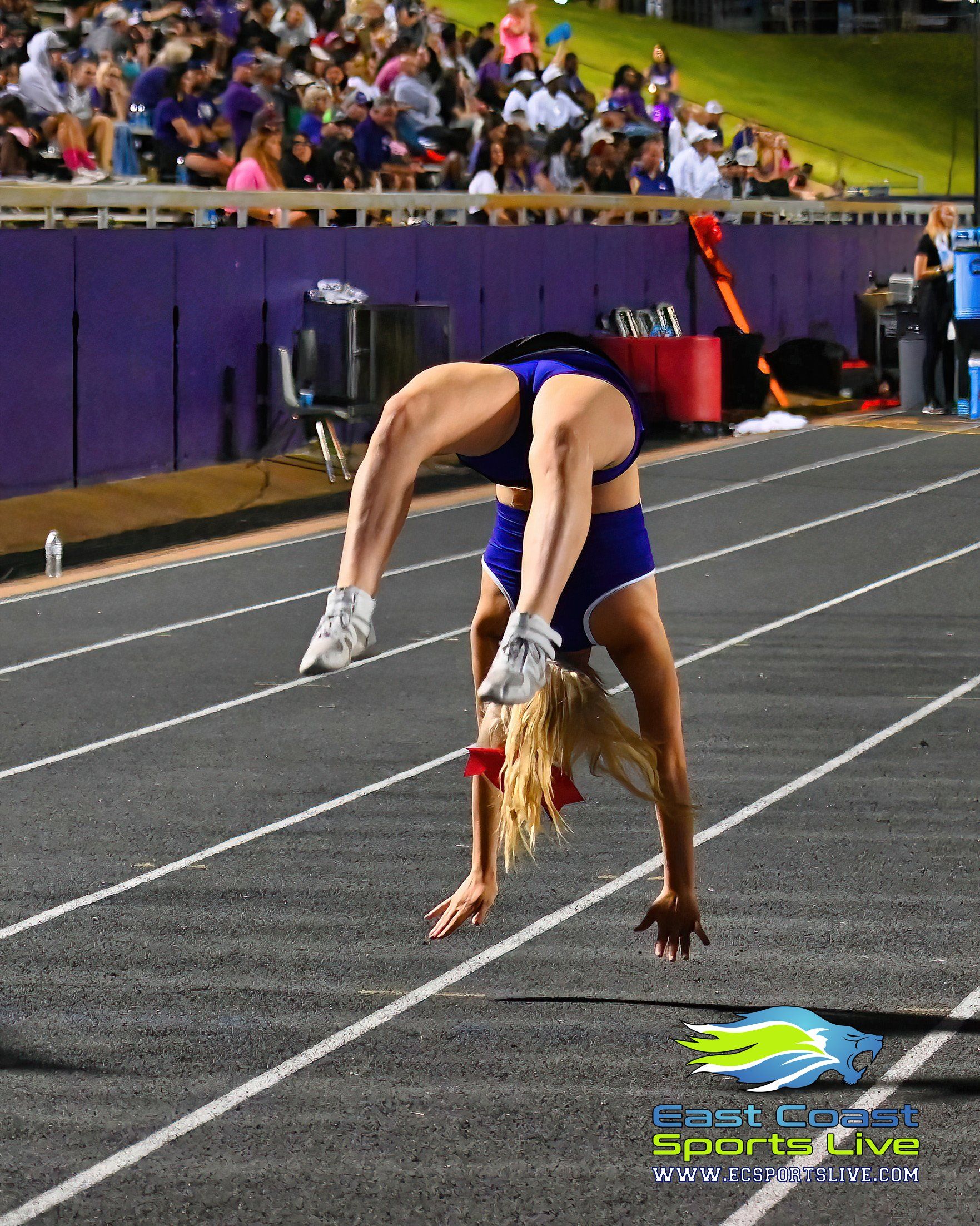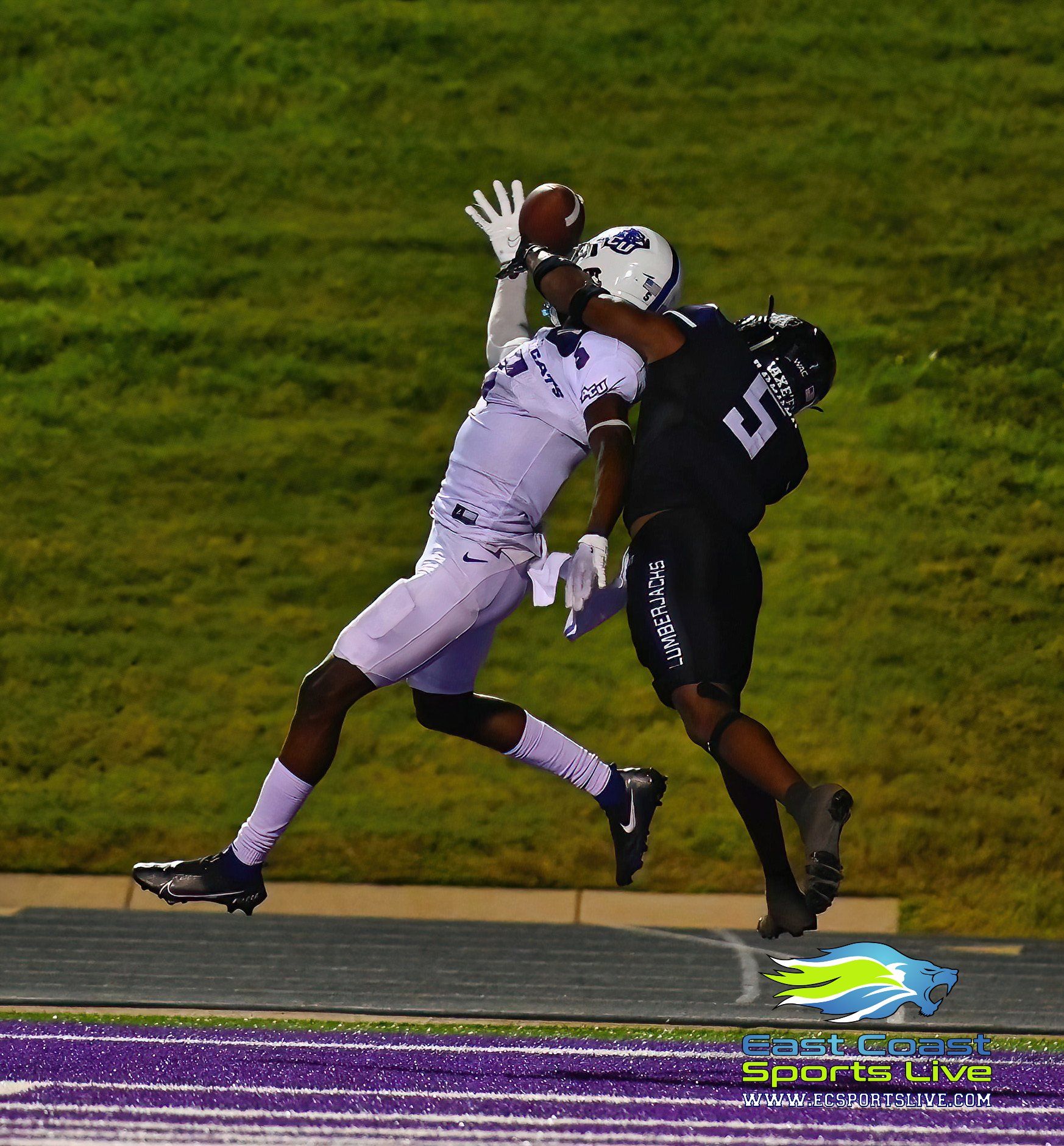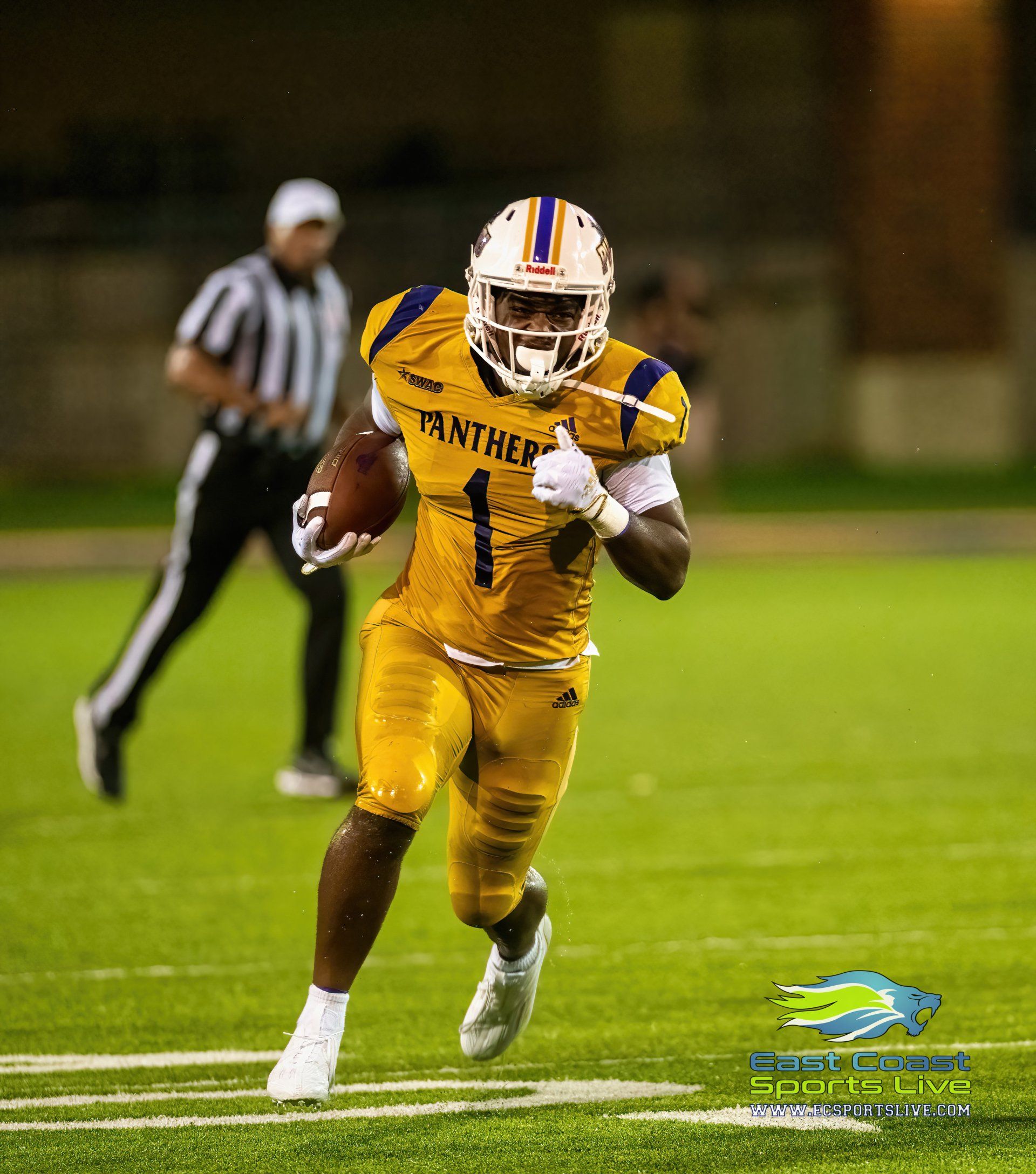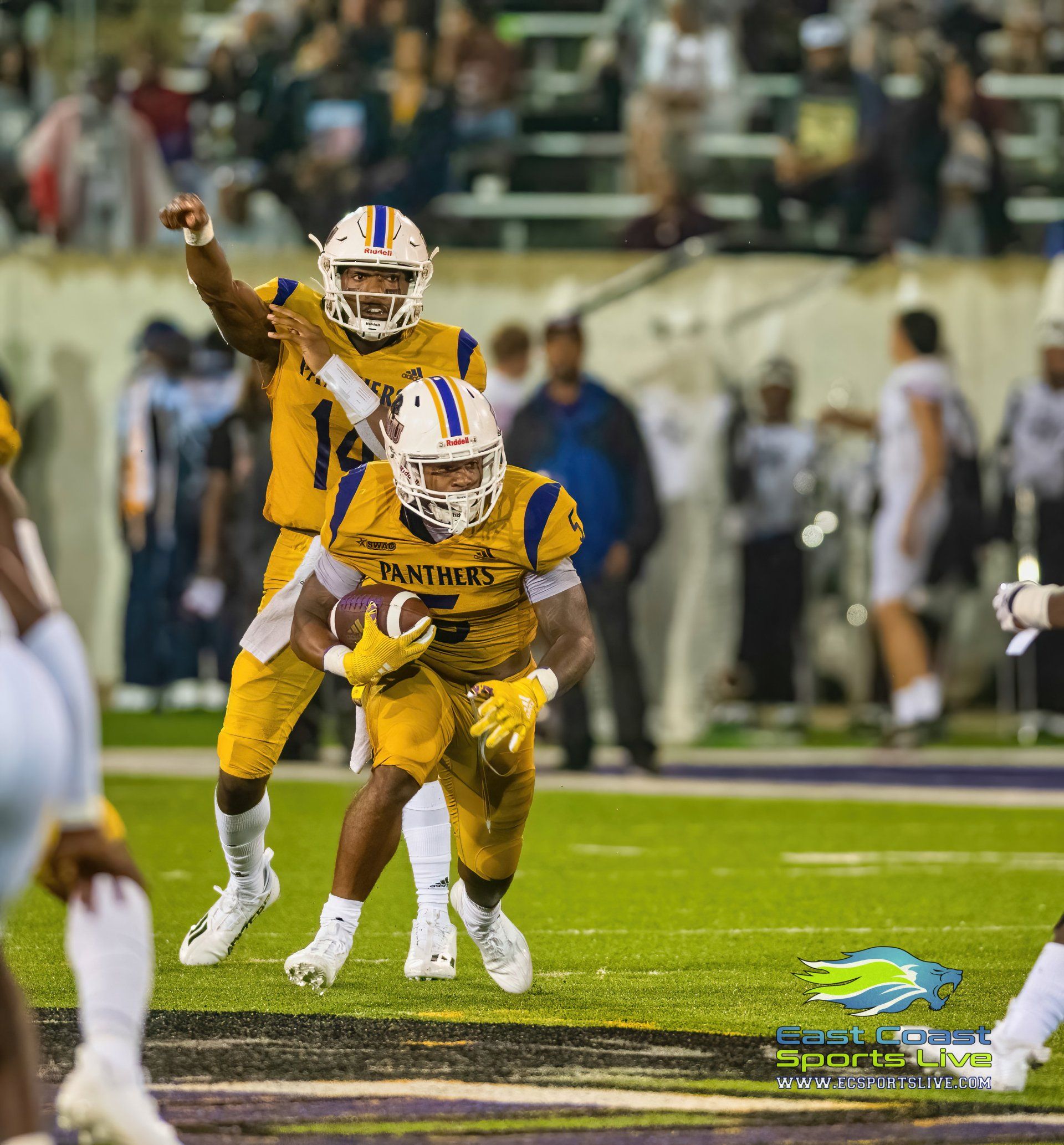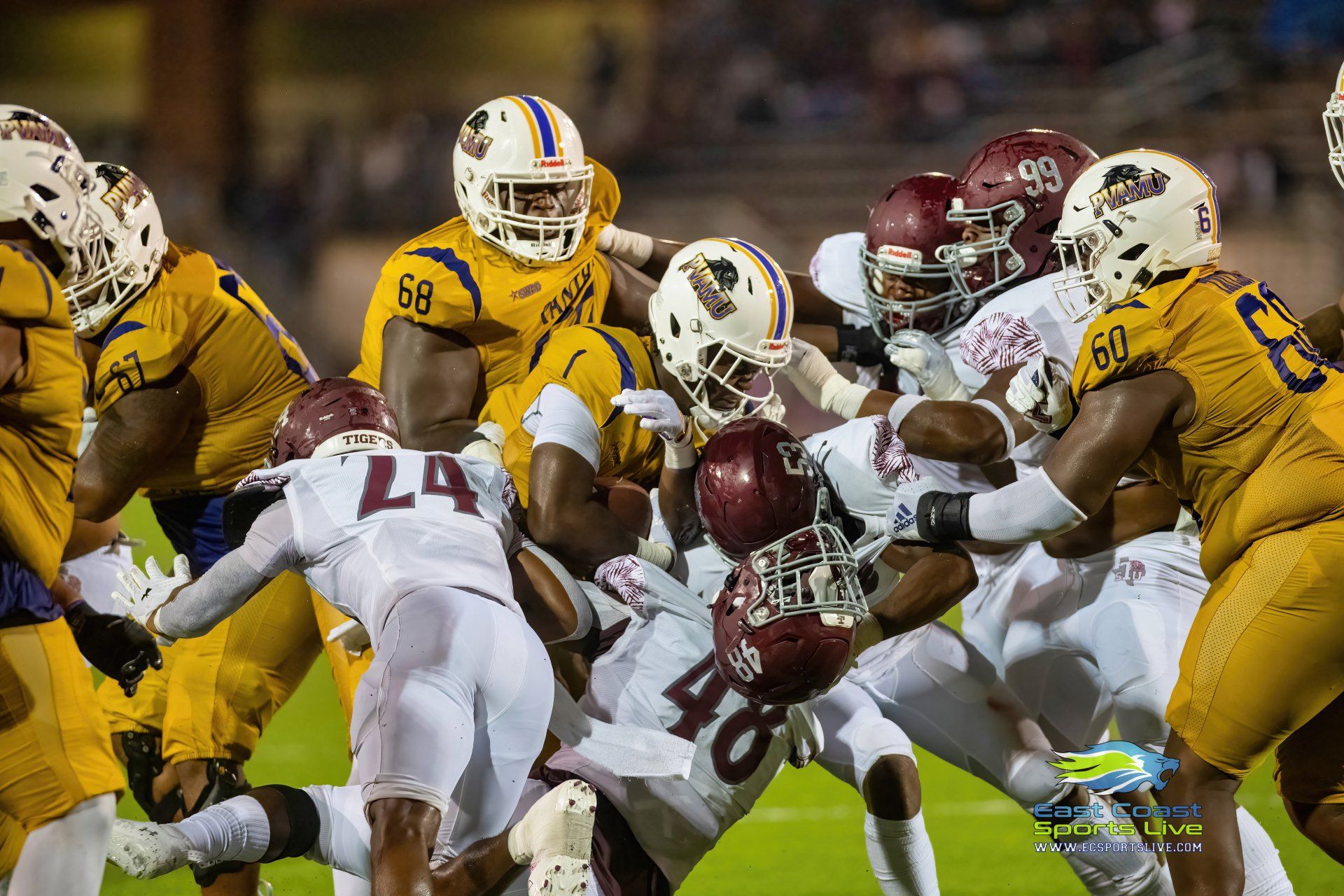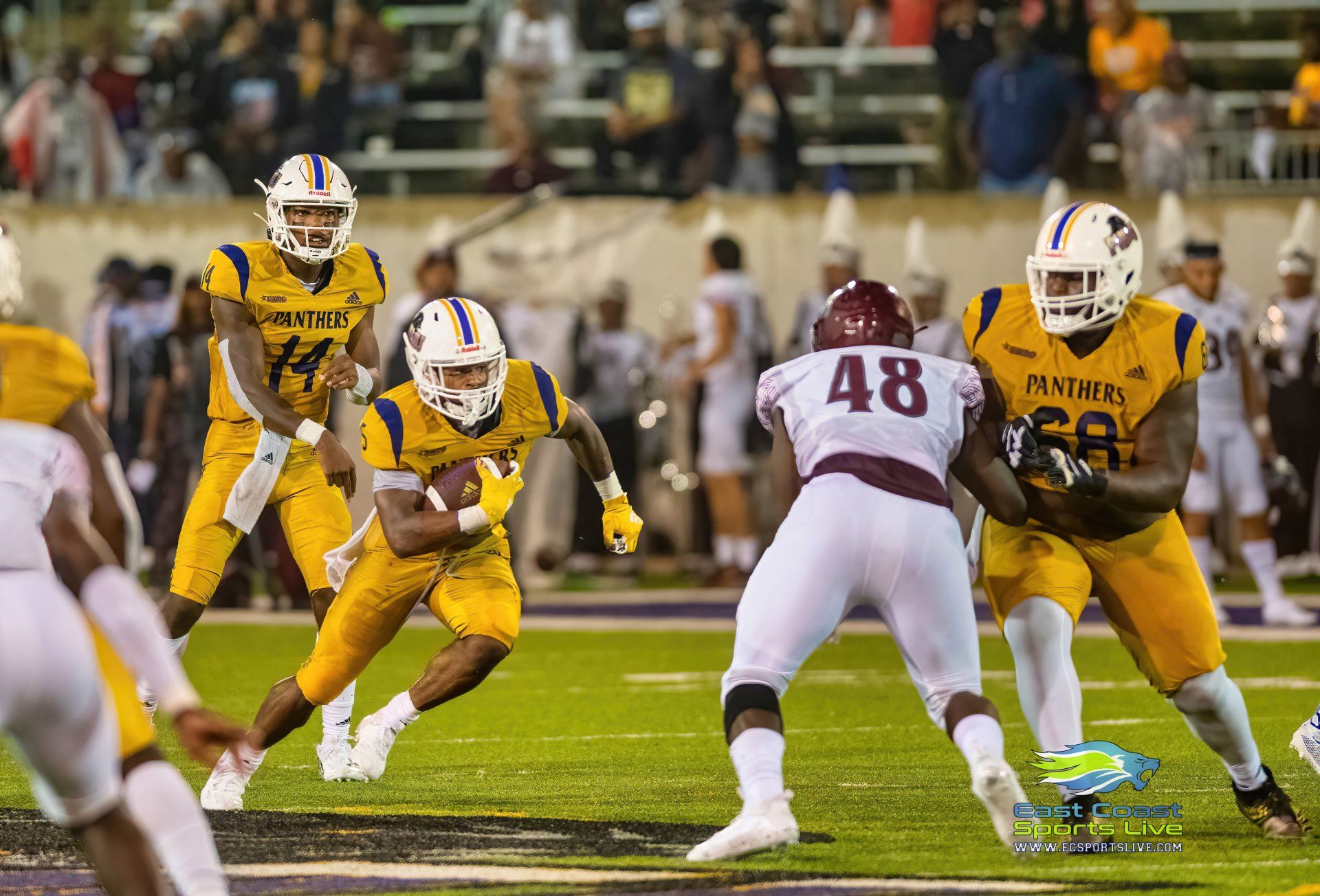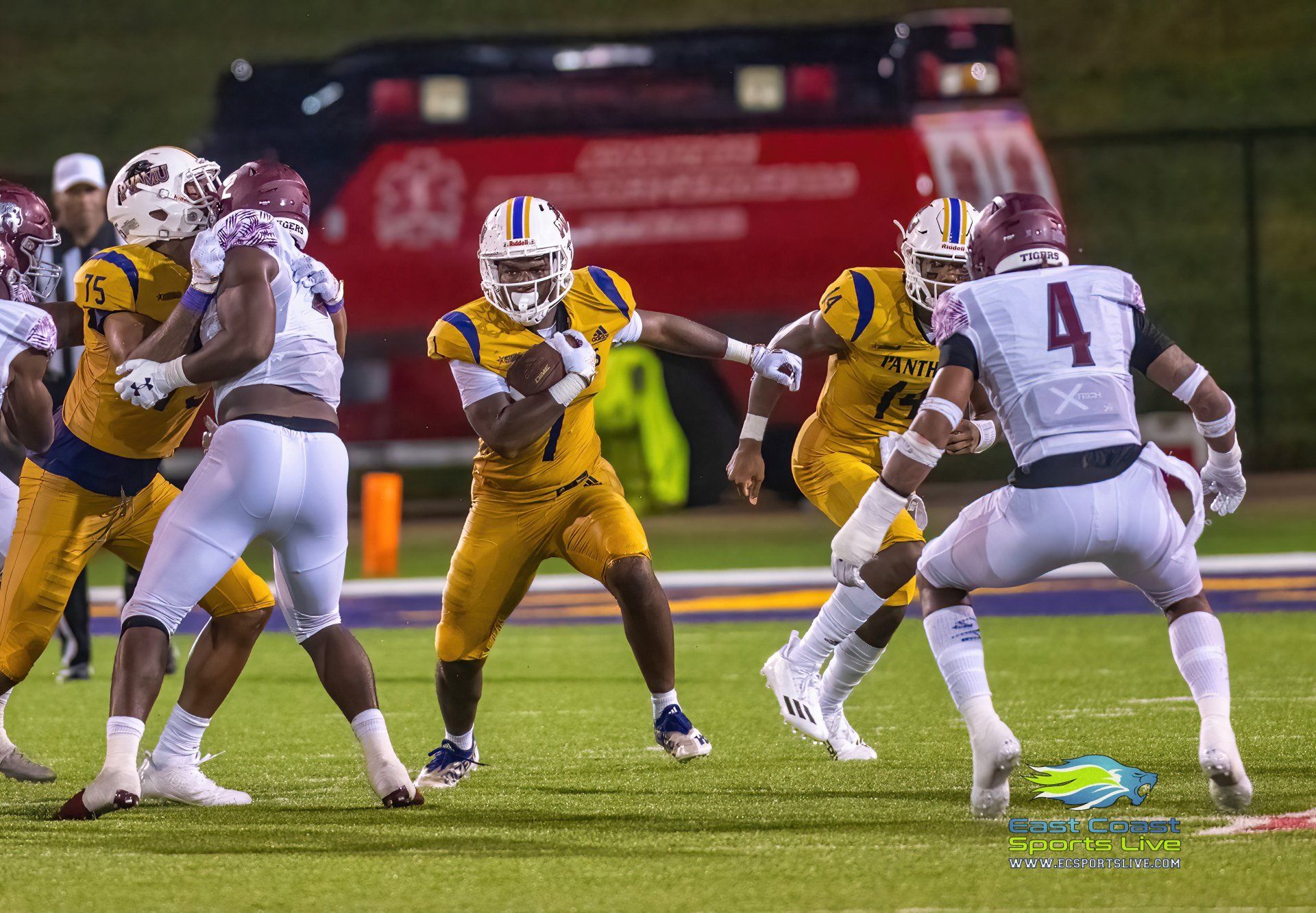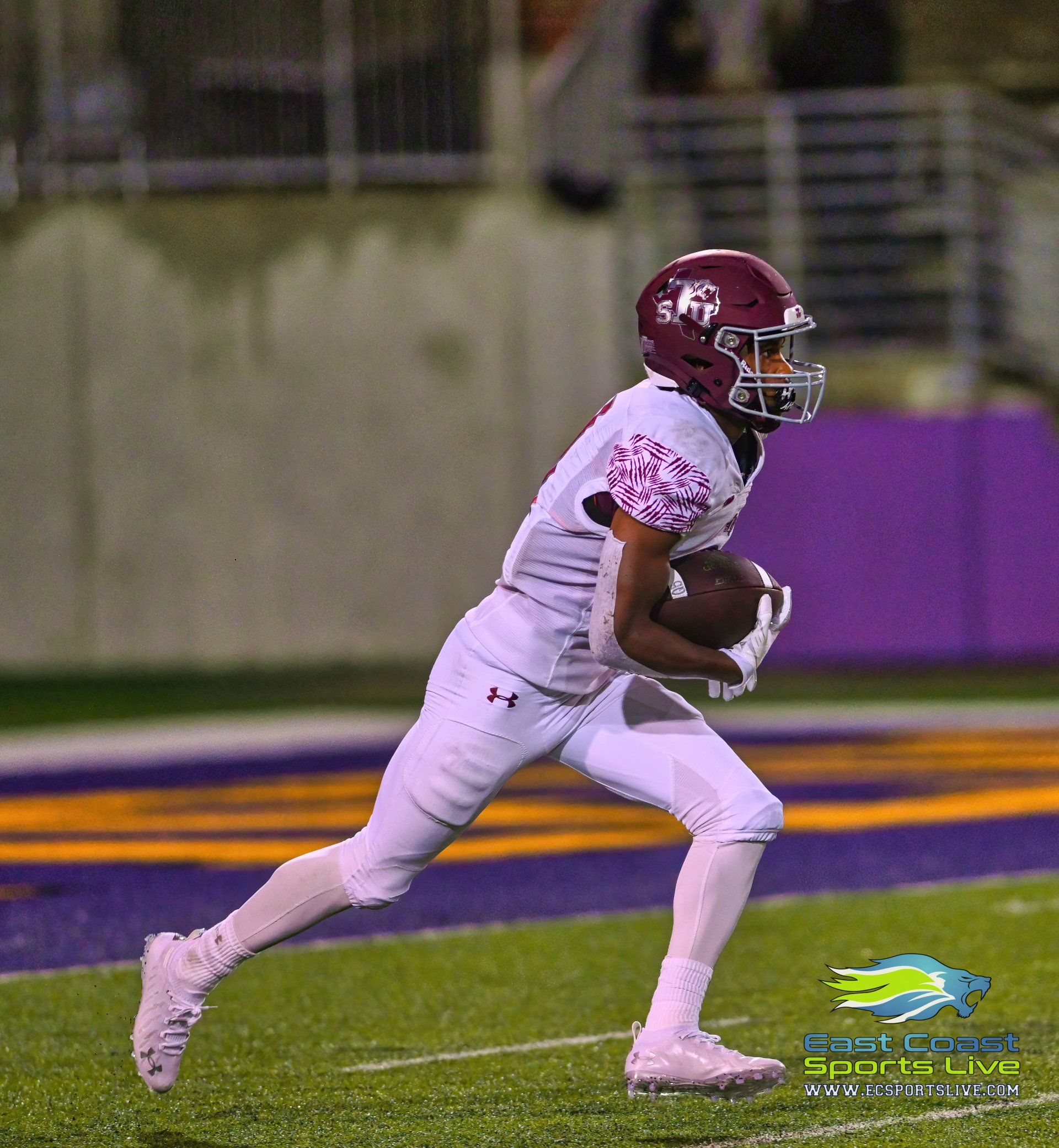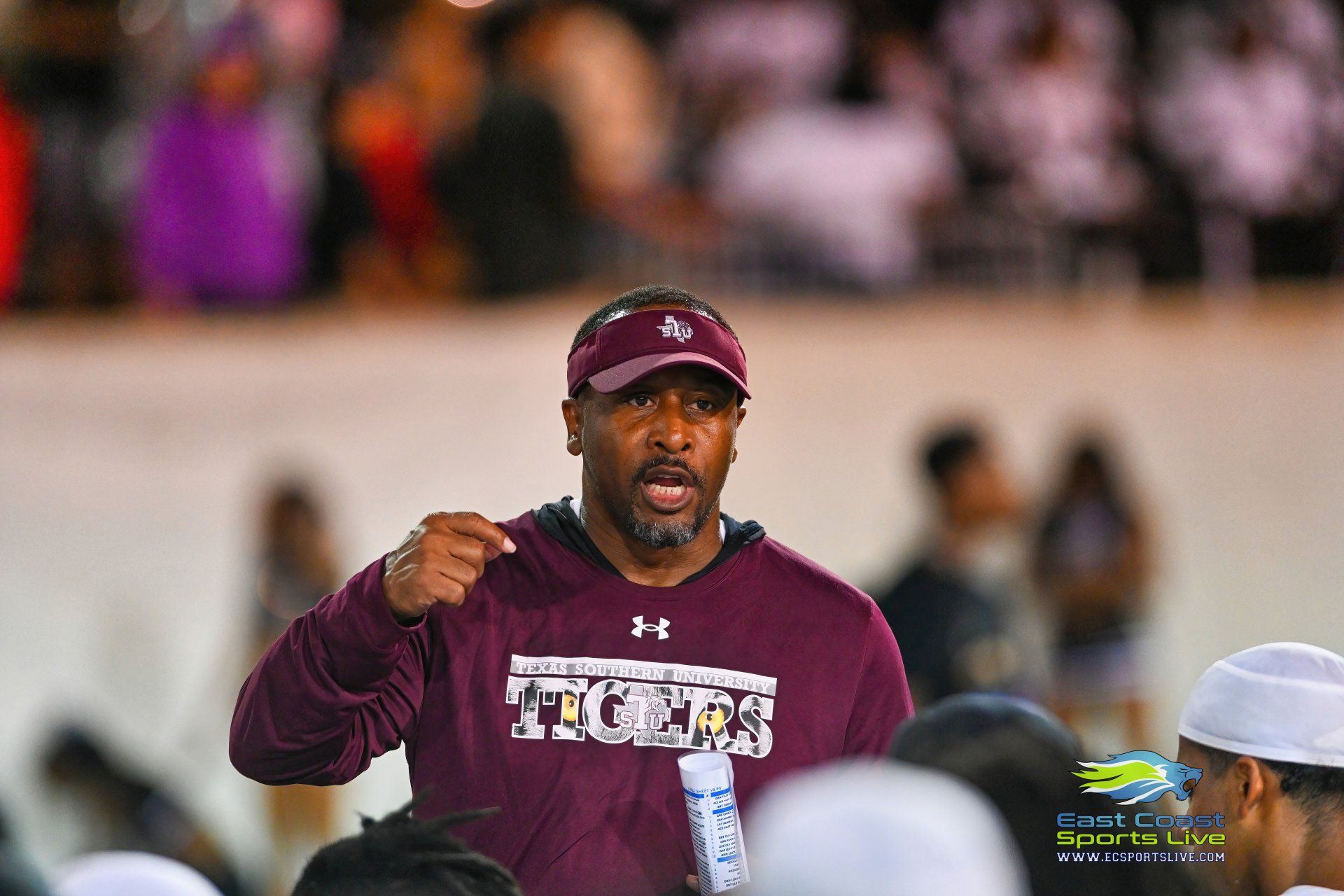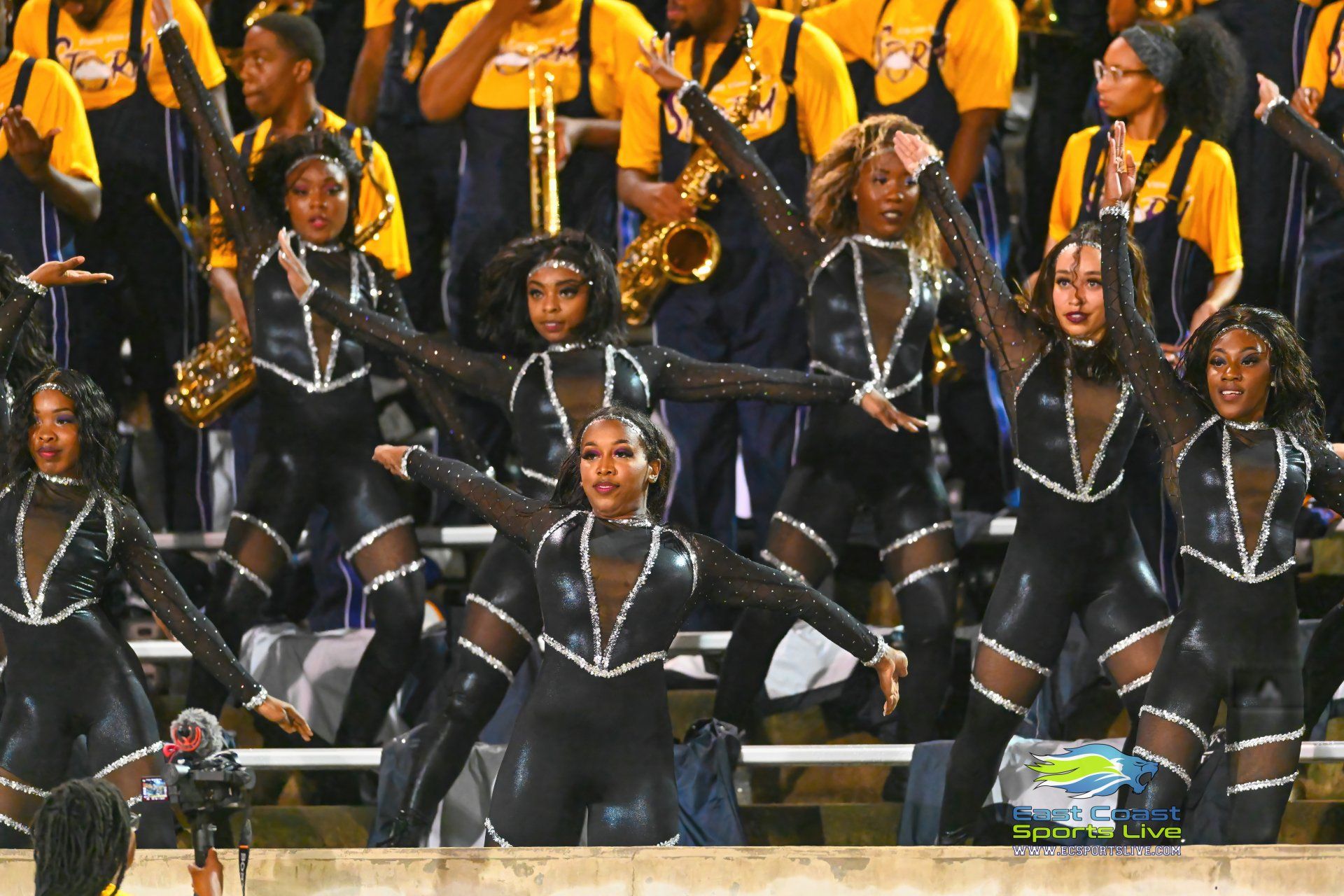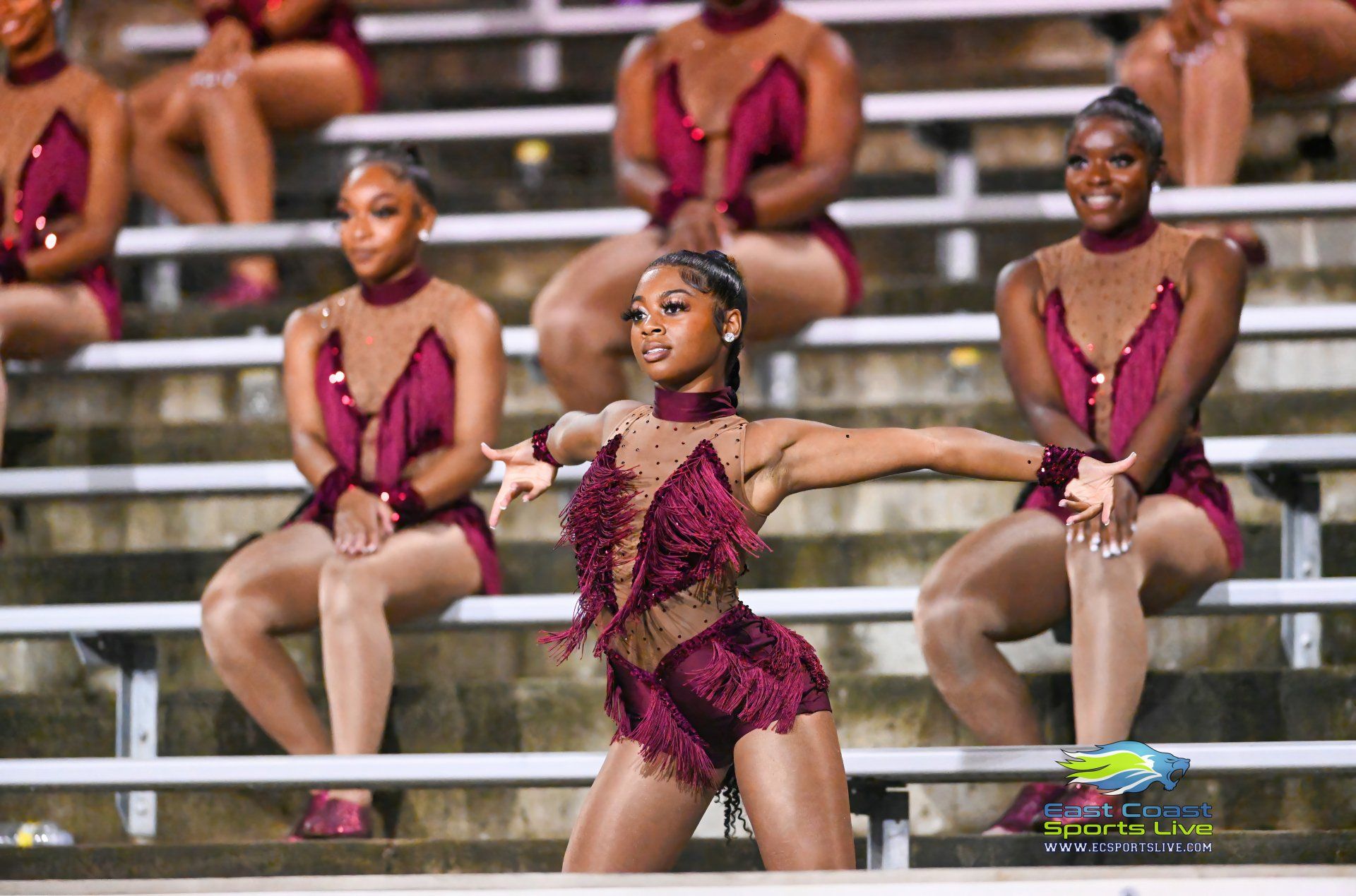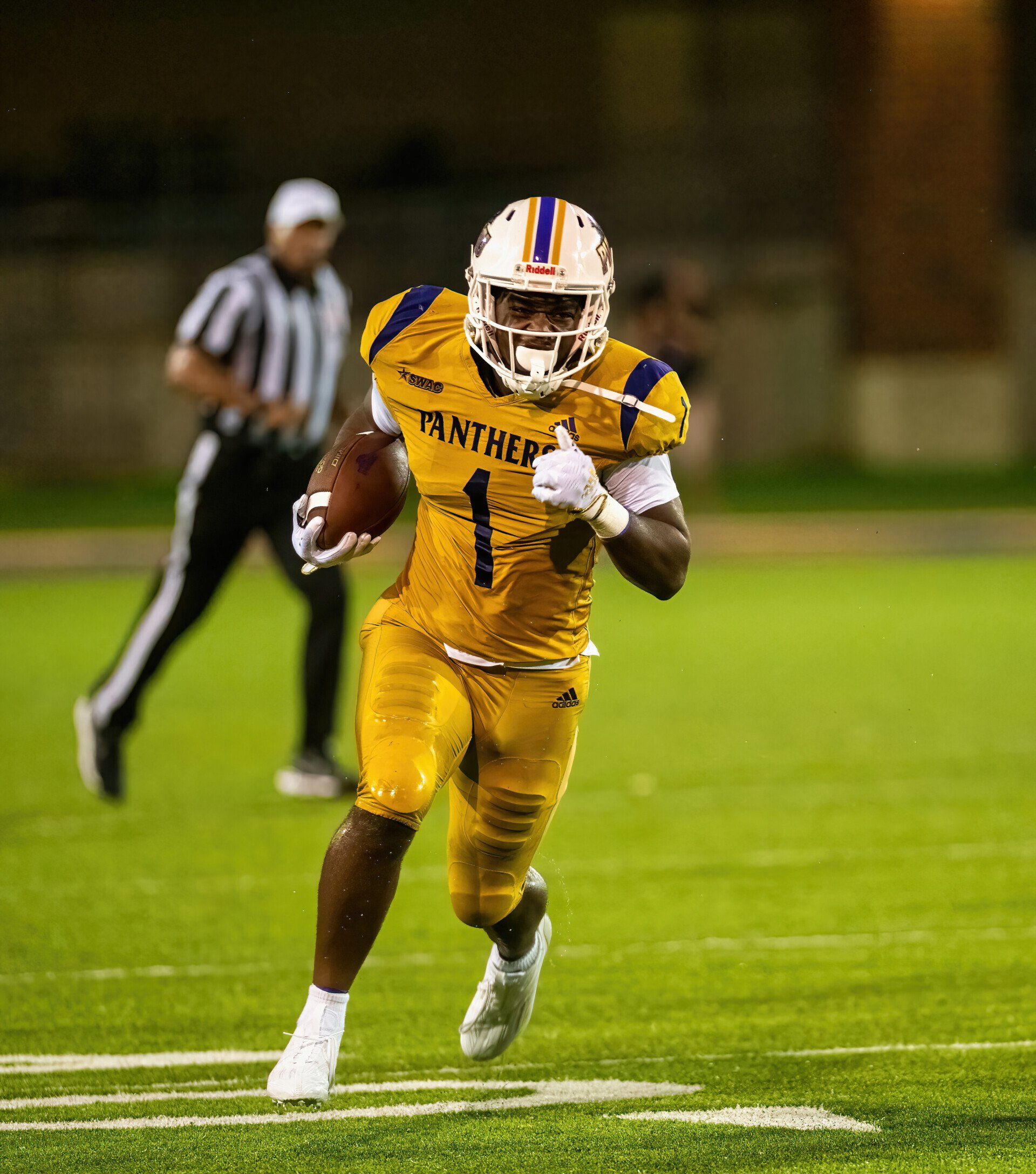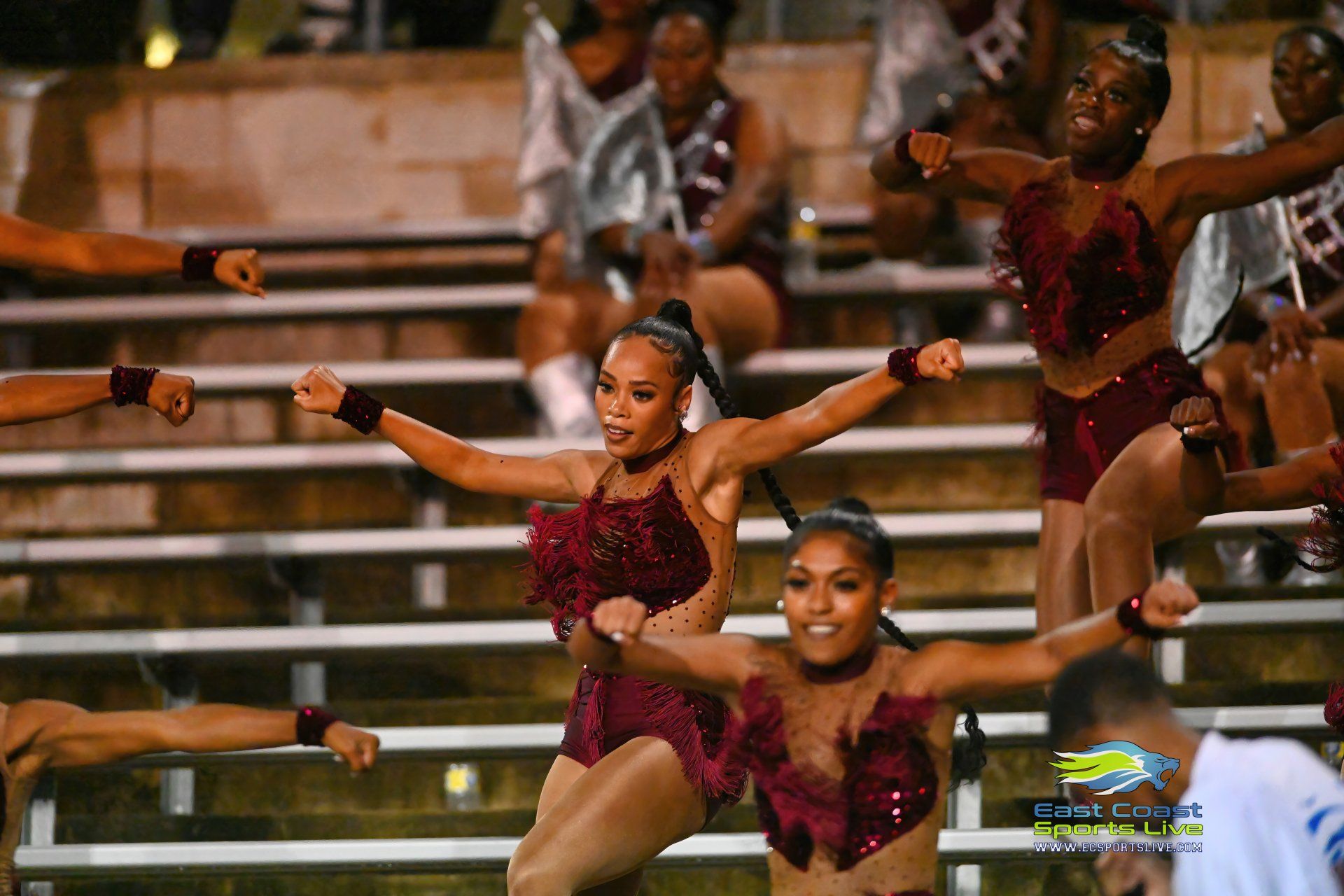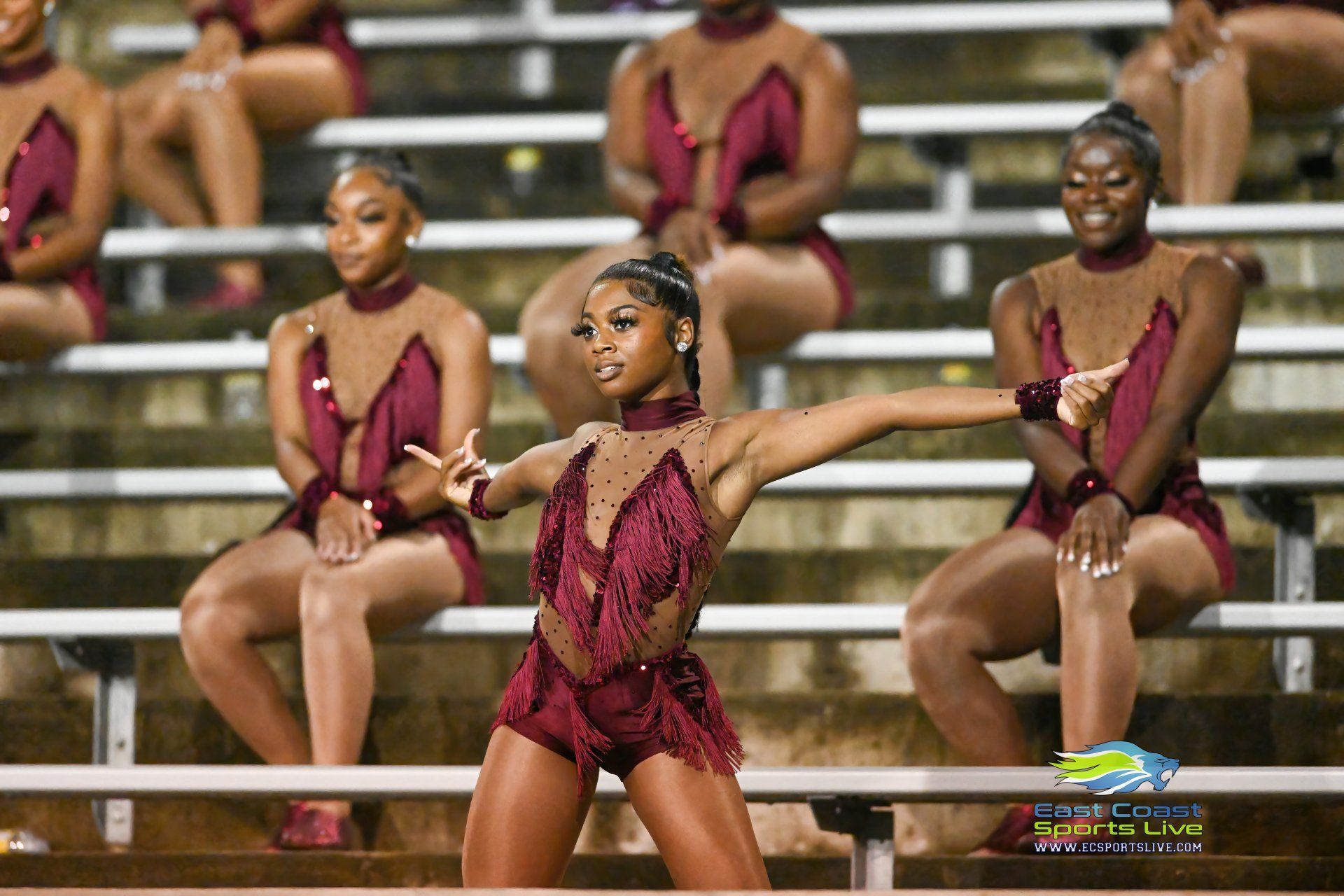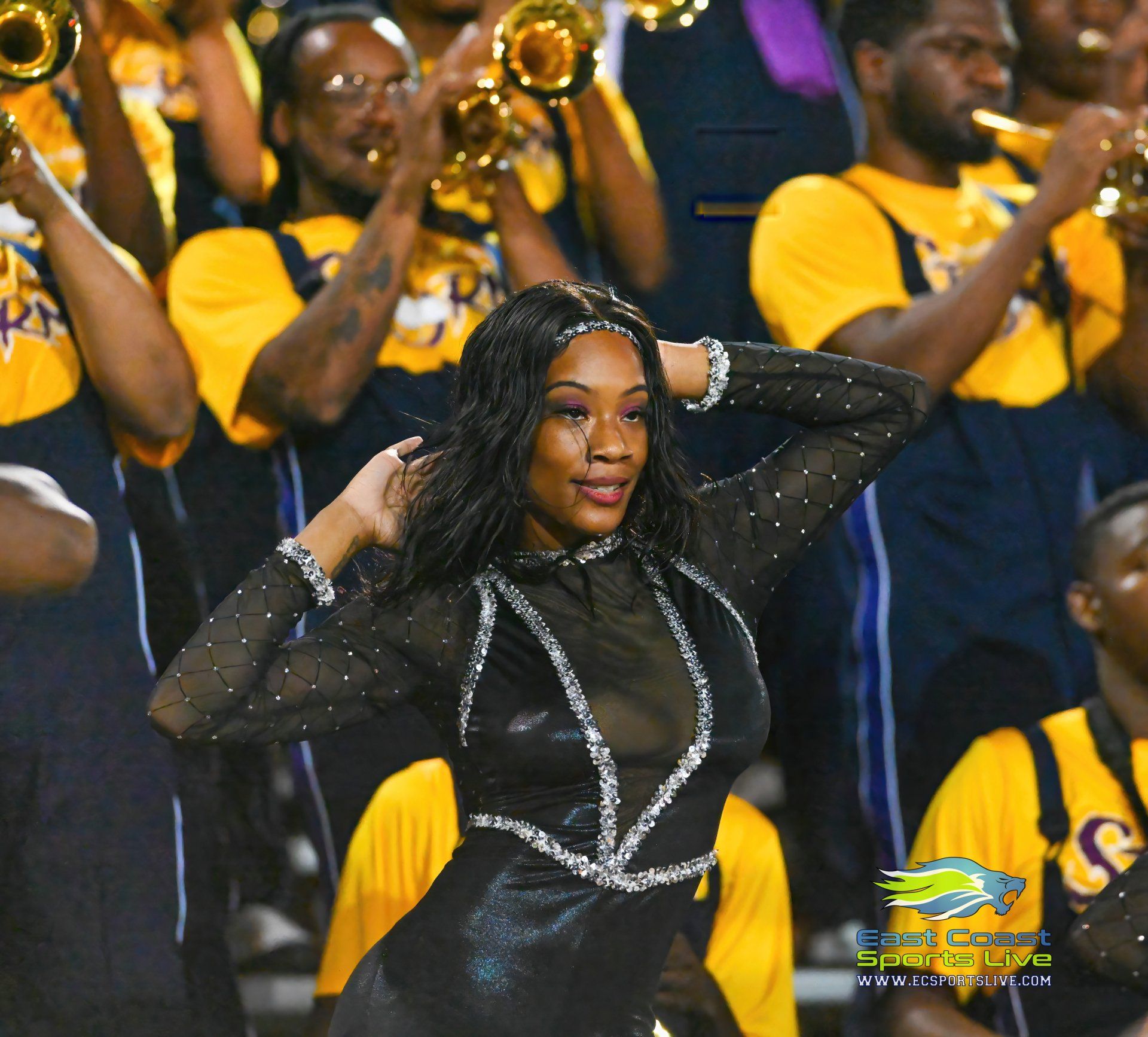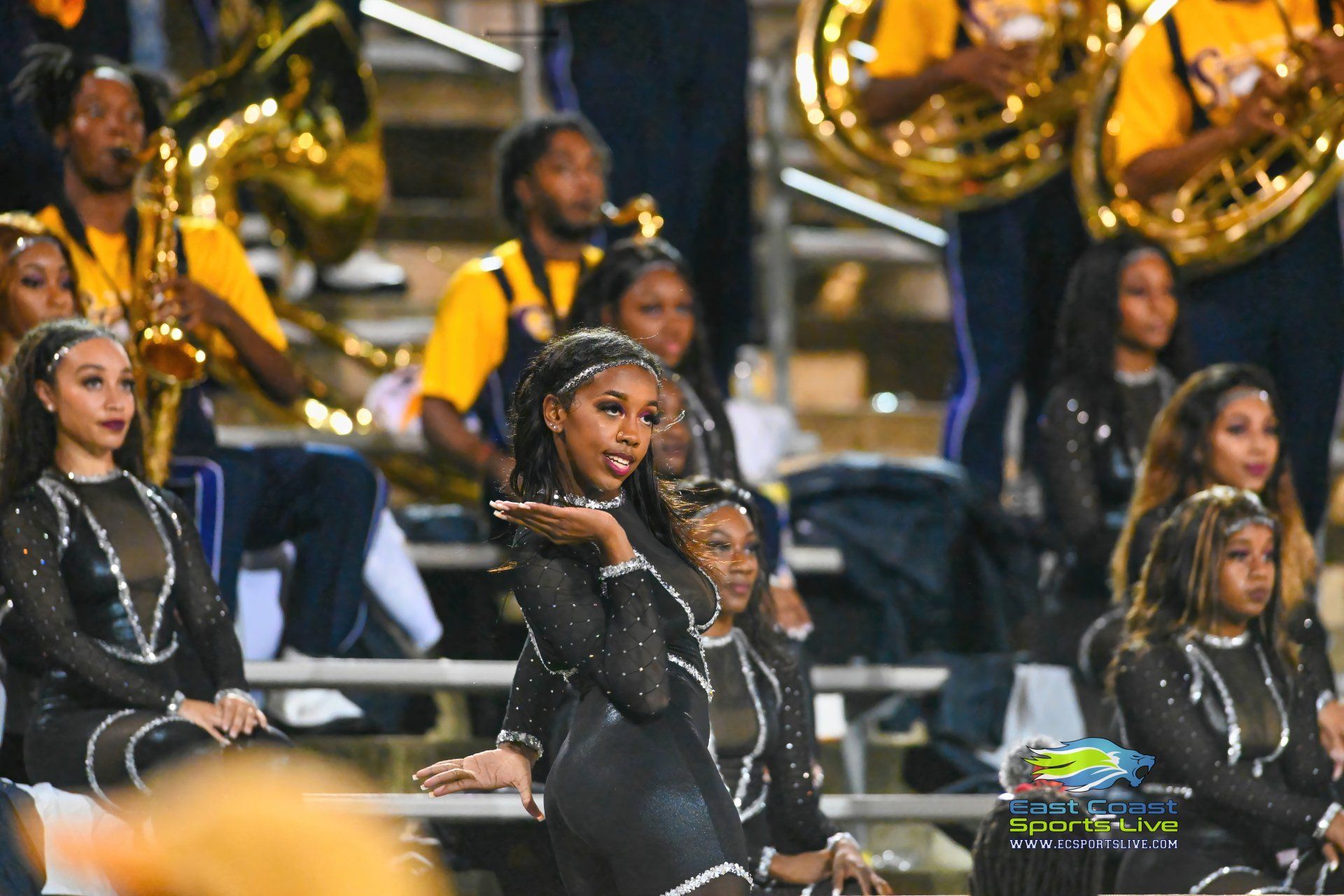East Coast Sports Live
NCAA College Football
College Football News
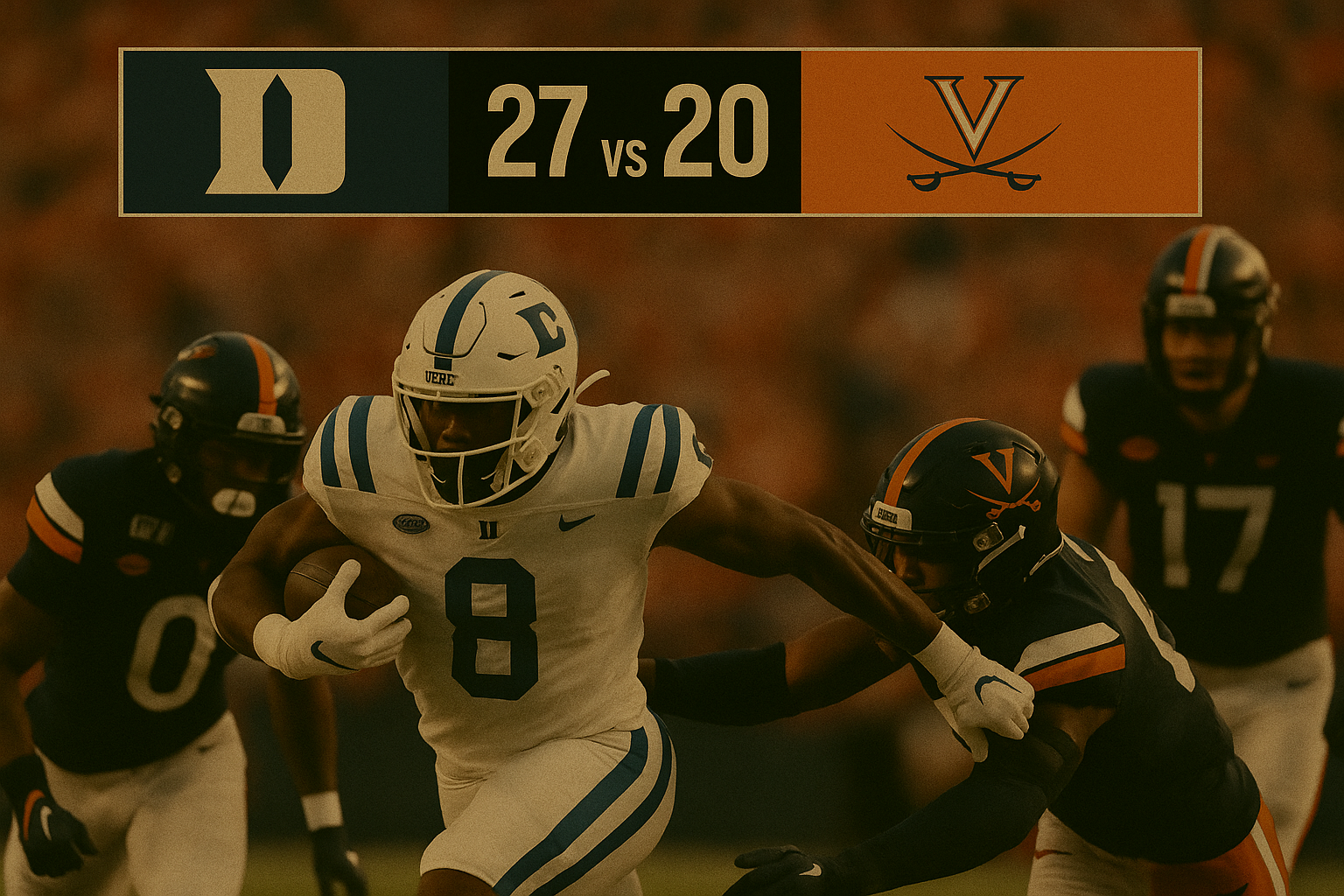
Blue Devils Outlast Cavaliers in Defensive Battle to Secure Historic Title CHARLOTTE, N.C. — In a championship game defined by defensive willpower, timely offense, and an overtime finish befitting two of the ACC’s toughest teams, Duke captured its first conference title in program history by defeating No. 16 Virginia 27–20 on Saturday night at Bank of America Stadium. The victory delivered Duke its first league crown since joining the ACC and capped one of the most complete seasons in program history, while Virginia fell to 10–3 and saw its championship aspirations end in a dramatic final sequence . Duke leaned on steady quarterback play, a resilient ground attack, and a defense that made critical stops in the game’s final minutes. The Blue Devils controlled overtime and refused to let Virginia’s explosive offense seize momentum when it mattered most. The result secured not only a championship but also a milestone moment for a program that had rebuilt its identity around discipline, depth, and situational execution. A Defensive First Half Defines the Championship Atmosphere Both teams entered the matchup with top-tier defensive identities, and the early stages reflected that emphasis. The first quarter unfolded with calculated drives rather than sudden explosive plays, as Duke and Virginia traded short gains and field position while searching for rhythm. Duke struck first with a balanced drive that set up a short rushing score, taking a 7–0 lead and establishing early momentum. Virginia responded with composure, piecing together a drive fueled by short passes and creative backfield movement. The Cavaliers tied the game 7–7 with a methodical finish, showing the poise that had carried them through the regular season as one of the ACC’s top-ranked offenses. From there, both defenses tightened. Duke’s front disrupted Virginia’s timing with persistent pressure, while Virginia’s secondary forced several contested throws and limited Duke’s vertical options. Neither team surrendered easy yards, and each possession became a test of patience and field management. Duke reclaimed the lead late in the first half, capitalizing on a sustained drive that ended in a field goal for a 10–7 advantage. Virginia countered with a focused two-minute drill to tie the game 10–10 at halftime, setting the stage for a tight, physical second half in which every play carried championship weight. Duke Controls the Third Quarter but Virginia Answers Late The Blue Devils opened the third quarter with their most confident offensive series of the game. A mix of downhill rushing and high-percentage throws moved Duke deep into Virginia territory. The Cavaliers held firm inside the red zone but could not prevent Duke from converting another field goal, giving the Blue Devils a 13–10 lead. Duke’s defense followed with a tone-setting stop that produced the biggest momentum shift of the quarter. The Blue Devils forced consecutive negative plays, flipping field position and placing Virginia’s offense on its heels. Duke capitalized once again, using a balanced drive to score a touchdown and build a 20–10 lead heading into the fourth quarter. Virginia refused to fold. The Cavaliers, who had spent much of the second half struggling to create explosive plays, found life late in the fourth quarter. A well-executed drive cut the deficit to 20–17, giving Virginia renewed energy and tightening the pressure on Duke’s closing sequences. The Cavaliers completed the comeback moments later with a field goal to tie the game 20–20, sending the ACC Championship into overtime. Overtime Belongs to the Blue Devils Duke began overtime with the poise of a team determined to seize a historic opportunity. A series of efficient runs and a critical third-down completion moved the Blue Devils inside the five-yard line. On the next play, Duke powered into the end zone to take a 27–20 lead, placing full pressure on Virginia’s final possession. Virginia attempted to match with a quick-strike approach, but Duke’s defense delivered its defining stand of the season. On second down, the Blue Devils forced an incompletion that shifted Virginia into a passing situation. A third-down rush collapsed the pocket, pushing the Cavaliers into fourth-and-long with the championship hanging in the balance. Duke’s secondary tightened its coverage on the final play, and Virginia’s pass fell incomplete, sealing the Blue Devils’ first ACC title and igniting a celebration decades in the making. The defensive stand punctuated a game in which Duke repeatedly executed in the most high-pressure moments. Blue Devils’ Balanced Attack Carries the Championship While the score reflected a defensive struggle, Duke’s offensive consistency made the difference. The Blue Devils controlled time of possession and generated sustainable drives even when Virginia’s front seven stiffened in key moments. The ground game complemented timely throws, helping Duke avoid long-yardage situations and ensuring stability throughout the contest. The offensive line delivered one of its best performances of the season, absorbing Virginia’s pressure and protecting the pocket long enough for Duke to execute its game plan. The Blue Devils did not rely on a single breakout star; instead, they leaned on collective discipline — a hallmark of their path to the championship stage. Virginia Battles but Falls Short in Crucial Moments Virginia entered the title game with one of the ACC’s most productive offenses, but Duke’s defense disrupted the Cavaliers’ rhythm from the opening snap. Although Virginia produced scoring drives in key moments, the Cavaliers struggled to convert on third downs and found themselves repeatedly forced to settle for short gains rather than explosive plays. Their late-game surge highlighted the team’s resilience, but missed opportunities in the red zone and a handful of stalled possessions prevented Virginia from gaining sustained momentum. The Cavaliers’ defense kept them within striking distance, but overtime exposed the narrow gap separating the two teams. The loss dropped Virginia to 10–3, still marking one of the program’s strongest seasons in the past decade, but the final outcome underscored how small differences in execution can determine a championship. Final Takeaway Duke’s 27–20 overtime win over No. 16 Virginia was a defining moment for a program that has steadily built toward national relevance. The Blue Devils showed discipline, defensive toughness, and late-game composure — traits that carried them from preseason uncertainty to conference champions. Virginia fought to the final play and demonstrated the qualities that made them one of the ACC’s most consistent teams this season, but Duke’s balance and clutch execution ultimately proved decisive. For the Blue Devils, the victory signals a new era — one in which the program is not just competitive, but capable of winning championships on the biggest stage.
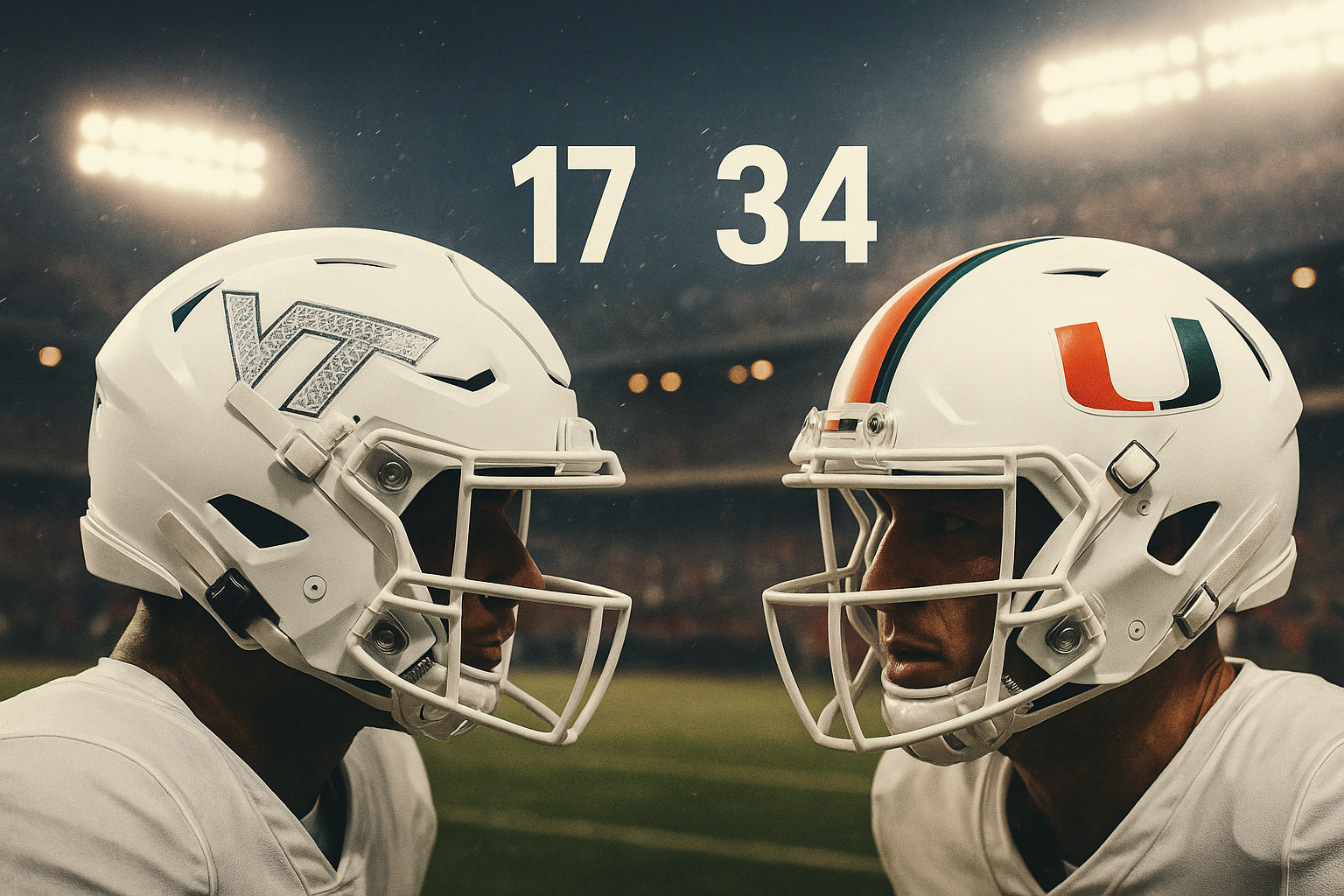
Hokies Show Fight Behind Overton and Watson, but Hurricanes Control Tempo on Senior Day BLACKSBURG, Va. — In the final home game of the 2025 season, Virginia Tech battled but ultimately fell 34–17 to No. 14 Miami on Saturday afternoon at Lane Stadium. The loss dropped the Hokies to 3–8 (2–5 ACC), while the Hurricanes improved to 9–2 (5–2 ACC) and extended their win streak over Tech to five straight meetings. Miami’s balanced offense, led by standout quarterback Carson Beck and a deep receiving corps, dictated the pace early. Despite an inspired performance on the ground and two rushing touchdowns, Virginia Tech couldn’t overcome Miami’s four-touchdown passing attack. Miami Strikes First, Tech Answers Early The Hurricanes opened the game with an eight-play, 75-yard scoring drive, capped by a 20-yard touchdown pass from Beck to tight end Elija Lofton. It was only the beginning of Beck’s highly efficient afternoon, as he finished 27-of-32 for 320 yards and four touchdowns. Virginia Tech answered quickly with its best opening sequence of the season. On the first offensive snap, Marcellous Hawkins broke free for a 33-yard run, instantly putting the Hokies in scoring territory. Freshman kicker Kyle Lowe — wearing the honorary No. 25 jersey — converted a 30-yard field goal, the first of his collegiate career, trimming the deficit to 7–3. Hurricanes Build Momentum Before Halftime Miami responded with poise and control, stringing together consecutive scoring drives built on third-down success and timely throws. A fourth-and-three completion from Beck to Malachi Toney extended one drive, and a three-yard touchdown catch by Mark Fletcher widened the lead to 14–3. A fourth-down stop by Miami’s defense halted a promising Hokies possession, and the Hurricanes turned it into a 17–3 advantage with a field goal. Minutes later, Beck hit Toney for a 56-yard gain, setting up another field goal that stretched the halftime margin to 20–3. Virginia Tech’s defense showed life late in the half, highlighted by pass breakups from Tyson Flowers, Kaleb Spencer, and Thomas Williams, but Miami’s consistency in the passing game maintained control. Hokies Surge Early in the Second Half Virginia Tech’s offense emerged rejuvenated after halftime. A fourth-and-one conversion and a Miami facemask penalty moved the Hokies into scoring range, and freshman running back Jeffrey Overton capitalized by exploding for a 38-yard touchdown — the first of his career — cutting the deficit to 20–10. Overton’s momentum carried into the rest of the half, finishing with 69 yards on nine carries, including a 24-yard burst. Combined with Hawkins’ 72 yards, Tech’s 194 rushing yards were the most Miami has surrendered all season. Miami, however, answered quickly. Beck converted a third-and-long with a 19-yard throw to Daylyn Upshaw, then found running back Girard Pringle on a 16-yard wheel route to push the lead back to 27–10. Watson Takes Over Late, but Comeback Falls Short With the Hokies needing a spark in the fourth quarter, backup quarterback William “Pop” Watson entered the game for the first time since October — and instantly delivered. He hit Ayden Greene for a 39-yard completion, then again for another 39-yard gain on fourth-and-11, setting Tech up at the three-yard line. Watson finished the drive himself with a short rushing touchdown, closing the gap to 27–17 with just over three minutes remaining. On the ensuing kickoff, Virginia Tech recovered an onside kick — its second of the season — reigniting hope throughout Lane Stadium. Watson quickly fired a 38-yard pass to Isaiah Spencer, but the drive ended abruptly when Miami defensive lineman Akheem Mesidor forced a crucial fumble. Four plays later, Beck found Toney again for a 20-yard touchdown, sealing the Hurricanes’ 34–17 win. Key Performers and Statistical Notes Although the Hokies fell short, several players delivered notable performances. Marcellous Hawkins and Jeffrey Overton combined for 141 rushing yards, giving Tech its most explosive rushing tandem of the season. Hawkins finished with 72 yards, while Overton added 69 and a long touchdown that energized the crowd early in the third quarter. In the passing game, Ayden Greene emerged as Tech’s most reliable target, collecting five receptions for 95 yards, including two pivotal fourth-quarter grabs that extended drives during the comeback push. William “Pop” Watson provided a spark late in the game, accounting for 78 total yards and scoring a rushing touchdown in limited action. Defensively, Tyson Flowers and Jaylen Chambers led the Hokies with eight tackles apiece. The secondary contributed three timely pass breakups and held firm during several red-zone situations, despite the pressure created by Miami’s potent passing attack. The defensive front forced the Hurricanes to work methodically throughout the contest, but Beck’s accuracy and timing ultimately carried the day for Miami. On the Miami side, Beck’s 320-yard, four-touchdown performance defined the afternoon. Malachi Toney was his top target, finishing with 146 receiving yards and a late touchdown that sealed the game. Running back Girard Pringle added both rushing and receiving production, contributing to Miami’s 418 total yards. Defensively, Miami recorded three sacks and forced two Tech fumbles, delivering timely plays that halted several potentially game-changing drives. Final Takeaway Virginia Tech’s 34–17 loss to No. 14 Miami reflected both the progress and the growing pains of a young roster. The Hokies ran for more yards against the Hurricanes than any opponent this season, produced two dynamic second-half touchdowns, and executed an onside kick to keep hope alive late. Yet Miami’s passing efficiency and crucial defensive stops separated the teams on Senior Day. With one regular-season game remaining — a rivalry matchup at Virginia on November 29 — the Hokies will look to close the season with a determined effort and build momentum heading into the offseason.
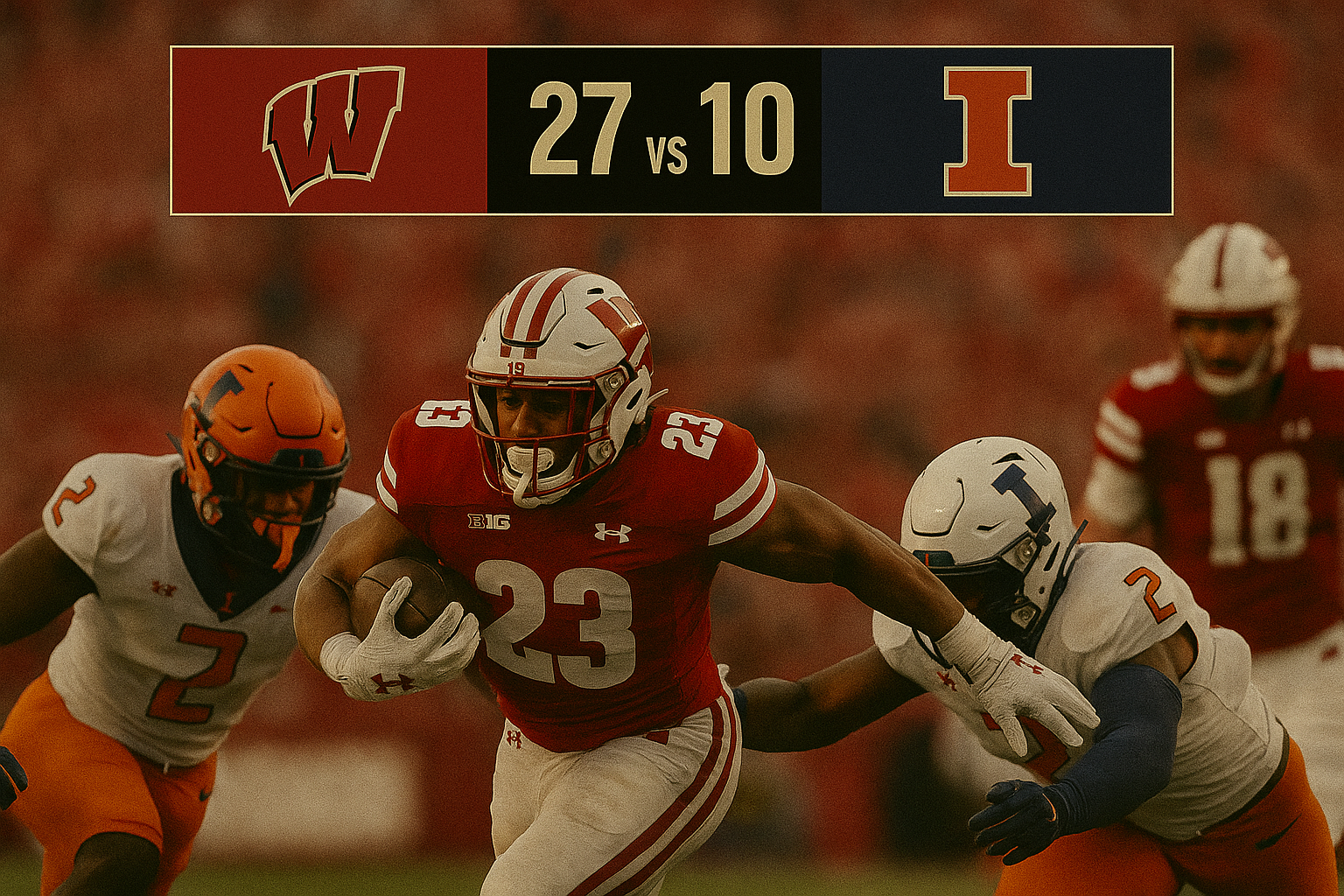
Dupree’s Career Performance and Stifling Defense Fuel Second Straight Ranked Win MADISON, Wis. — Wisconsin delivered its most complete performance of the 2025 season on Senior Day, powering past No. 21 Illinois 27–10 on Saturday evening at Camp Randall Stadium. The victory gave the Badgers back-to-back home wins over ranked opponents for the first time since 2019 and improved their record to 4–7 overall and 2–6 in Big Ten play. Illinois dropped to 7–4 (4–4 Big Ten), losing momentum in a conference matchup defined by Wisconsin’s explosive rushing attack, defensive pressure, and consistent control throughout the second half. Badgers Set the Tone Early With Long Opening Drive Wisconsin opened the afternoon with a statement. The Badgers constructed an 80-yard, 16-play touchdown drive that consumed nearly half the first quarter and immediately established the physical identity that would define the rest of the game. Freshman quarterback Carter Smith was perfect on the possession, completing all four of his passes, while Vinny Anthony II capped the march with a six-yard jet-sweep touchdown. The efficient series not only gave Wisconsin a 7–0 lead but also signaled a renewed offensive rhythm that had been absent for much of the season. Illinois found a response midway through the second quarter. A strong punt return by Hank Beatty set the Illini up with a short field, allowing quarterback Luke Altmyer to finish the drive with a 12-yard touchdown run. The score tied the game at 7–7 and briefly shifted momentum toward the visiting sideline. Wisconsin reclaimed control moments before halftime. Senior kicker Nathanial Vakos drilled a season-long 47-yard field goal to put the Badgers ahead 10–7 entering the break, completing a half where Wisconsin’s defense increasingly asserted itself at the line of scrimmage and began forcing Illinois away from its offensive comfort zone. Dupree’s 84-Yard Touchdown Breaks the Game Open The start of the second half delivered the moment that defined the entire afternoon. On second down near midfield, freshman running back Darrion Dupree burst through a crease, accelerated past the linebackers, and sprinted 84 yards untouched for a touchdown. The electrifying run stretched Wisconsin’s lead to 17–7 and energized the Senior Day crowd. It was the longest play from scrimmage for the Badgers since 2023 and the type of explosive moment Wisconsin had lacked for much of the season. Illinois attempted to respond late in the third quarter with a 47-yard field goal to narrow the deficit to 17–10. Altmyer threw for 248 yards and added meaningful rushing yards as he tried to keep the Illini within striking distance, but Wisconsin’s defensive front disrupted the rhythm of nearly every possession. Illinois struggled to find consistency and was repeatedly forced into long-yardage situations that stalled drives and prevented sustained pressure. Special Teams Spark and Dupree’s Second Touchdown Seal the Win A crucial special-teams sequence early in the fourth quarter allowed the Badgers to take full control. A low snap on an Illinois punt attempt disrupted the timing of the play, and Wisconsin swarmed the punter to create a short-field opportunity at the Illinois 14-yard line. The mistake shifted momentum sharply back to the Badgers and set up another quick scoring chance. Four plays later, Dupree lined up in the Wildcat formation and powered into the end zone from four yards out, securing his second touchdown of the night and extending the lead to 24–10. It capped a breakout performance for the freshman, who finished with 131 rushing yards and became the Badgers’ first 100-yard rusher of the season. Wisconsin added another defensive highlight on the next Illinois possession when Christian Alliegro sacked Altmyer on fourth down, giving the Badgers the ball again on a short field. Vakos connected on his second field goal of the game to push the lead to 27–10, putting the contest firmly out of reach and allowing Wisconsin to close the game with complete control. Badgers’ Defense Delivers Season’s Best Performance Wisconsin’s defense showed dominance reminiscent of its traditional identity. Outside linebacker Darryl Peterson turned in the best performance of his career with three sacks and constant disruption off the edge. The Badgers finished with five total sacks and repeatedly collapsed the pocket, preventing Illinois from establishing any rhythm in the passing game or creating sustained rushing lanes. Illinois saw standout performances from Matthew Bailey, who recorded ten tackles and forced a fumble, and from Gabe Jacas, who produced two sacks and moved into second place on Illinois’ all-time career sack list. Despite these individual efforts, the Illini offense struggled to counter Wisconsin’s physicality and never recovered from the momentum swings generated by Dupree’s touchdown and the fourth-quarter special-teams miscue. Final Takeaway Wisconsin’s 27–10 victory over No. 21 Illinois was its most complete game of the season. Dupree’s explosive breakout, the defense’s relentless pressure, and the special-teams impact all worked in concert to deliver a dominant Senior Day performance and secure a second straight ranked win. With renewed momentum, Wisconsin heads to Minnesota seeking to close the season with three consecutive victories. Illinois returns home to face Northwestern, aiming to regroup and finish its regular season strong.
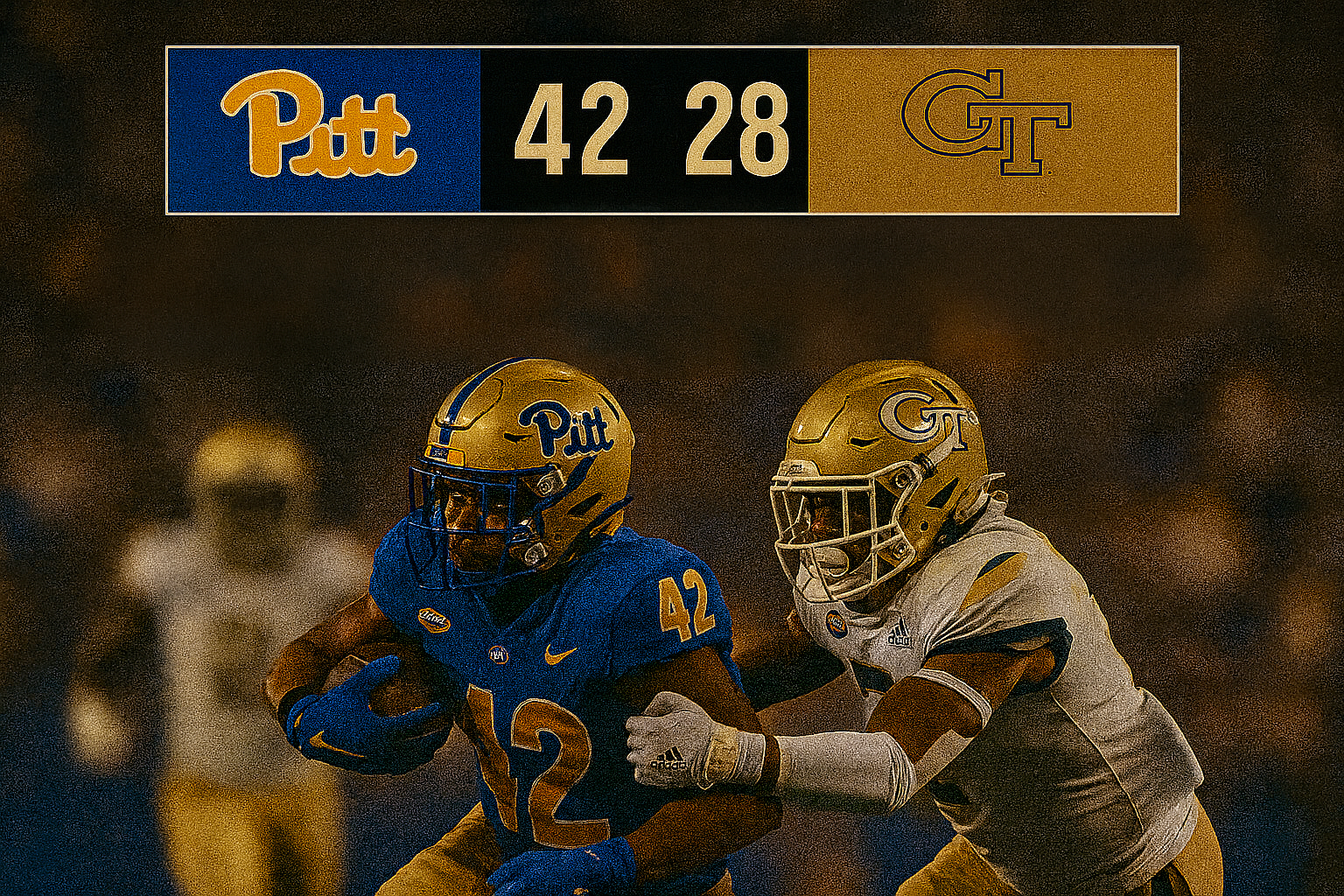
Panthers Deliver Statement Road Win as Turner and Lovelace Power a Season-Defining Victory ATLANTA — In one of the most consequential ACC results of the season, Pittsburgh delivered a dominant yet resilient performance to upset No. 15 Georgia Tech 42–28 on Saturday night at a sold-out Bobby Dodd Stadium. The Panthers exploded to a 28–0 lead, weathered a furious Georgia Tech comeback, and slammed the door late to keep their championship hopes alive. The loss eliminated the Yellow Jackets from ACC title contention and marked their first home defeat since 2023. With the victory, Pitt improved to 8–3 (6–1 ACC) , remaining firmly in the race for a spot in the ACC Championship Game. Georgia Tech fell to 9–2 (6–2 ACC) , surrendering control of a win-and-in scenario that had positioned them on the brink of returning to the league’s title game for the first time since 2014. Panthers’ Explosive Start Silences Bobby Dodd Stadium Pitt wasted no time seizing command. The Panthers scored touchdowns on their first two possessions, operating with precision in both the run and pass game. Their defense contributed an early stop that set up another short-field opportunity, pushing the lead to 21–0 by the end of the first quarter — Georgia Tech’s largest opening-frame deficit in four years. Early in the second quarter, Pitt extended its lead to 28–0 behind the power of running back Ja’Kyrian Turner , who finished with a career-best 201 rushing yards and a late game-clinching touchdown. Quarterback Mason Heintschel added efficient balance, threading passes across the field to guide the Panthers to 28 points in less than 20 minutes. Georgia Tech, which entered the night as the ACC’s highest-scoring offense, was stunned by Pitt’s urgency and execution. The Jackets’ offense stalled early, their defense was unable to contain the run, and their energy lagged as the Panthers dominated every early possession. Georgia Tech Begins the Long Climb Back Just when the game seemed in danger of slipping into blowout territory, Georgia Tech found life. Quarterback Haynes King began extending plays with his legs and connecting on downfield throws, leading the Jackets on back-to-back scoring drives in the final minutes of the second quarter. Those touchdowns cut the deficit to 28–14 and reignited the crowd as halftime approached. The momentum carried into the third quarter. Georgia Tech opened the half with a defensive stop and quickly drove inside the Pitt five-yard line with a chance to make it a one-score game. But the Panthers delivered the decisive moment of the night. Linebacker Braylan Lovelace intercepted King at the goal line and returned it 100 yards for a touchdown , turning a potential 28–21 nail-biter into a 35–14 Pitt advantage. The dramatic 14-point swing flipped the stadium from chaos to silence and effectively halted Georgia Tech’s comeback bid. Jackets Rally Again, but Pitt Closes with Power Georgia Tech refused to concede. King kept pushing the ball downfield and found Isiah Canion for two fourth-quarter touchdowns, pulling the Jackets within 35–28 with under five minutes remaining. The defense then forced Pitt into a crucial third-and-four, creating a final chance to get the ball back and tie the game. Instead, Pitt emphatically sealed the upset. Turner broke through the middle of the Georgia Tech defense for a 56-yard touchdown , restoring a two-score lead and ending the Jackets’ hopes of a miraculous rally. The run underscored the physical dominance of Pitt’s offensive line and reaffirmed the tone the Panthers had established from the opening drive. Although Georgia Tech’s defense tightened after halftime — allowing just 116 yards over the final two quarters — the early deficit and the devastating pick-six proved too large to erase. Statistical Standouts and Turning Points Pitt found a rhythm early and never fully surrendered it. Heintschel completed 20 of 27 passes for 226 yards and two touchdowns , spreading the ball to six different receivers while avoiding turnovers. Turner’s monster performance supplied balance and provided the knockout blow in the closing minutes. Georgia Tech received strong play from King, who totaled 333 yards of offense with two passing touchdowns and a rushing score. His two fourth-quarter touchdown throws to Canion kept the Jackets close, while Malik Rutherford added 68 receiving yards as part of a passing attack that heated up late. Defensively, Georgia Tech generated a season-high six sacks , spearheaded by Cayman Spaulding , who produced the best performance of his career. However, the Jackets’ defensive front could not fully compensate for the early breakdowns that allowed Pitt to build its initial lead. Pitt achieved something no opponent had managed all year: forcing two interceptions from King, who had thrown only two picks in the first 11 games. Both turnovers swung momentum and prevented Georgia Tech from closing the gap when opportunities emerged. ACC Championship and Playoff Picture Shaken Dramatically Pitt’s upset reshaped the ACC title race overnight. Georgia Tech’s loss eliminated the Jackets from contention, ending a bid that had gained national traction in recent weeks. The Panthers remain alive but will need both a victory next week and help from elsewhere in the conference — including a loss from either Virginia or SMU — to reserve a berth in Charlotte. Across the ACC, Week 12 results produced chaos: Miami held serve against Virginia Tech, SMU overpowered Louisville, and Duke stunned North Carolina. Combined with Tulane and James Madison pushing into the national spotlight, the league now finds itself in danger of missing the expanded College Football Playoff unless the title game winner finishes with a strong résumé. Final Takeaway Pitt’s 42–28 victory over No. 15 Georgia Tech was a statement win powered by dominance early, resilience late, and one of the most pivotal defensive plays of the ACC season. Georgia Tech mounted a determined rally but could not fully overcome its slow start or the game-breaking pick-six. With rivalry games approaching and postseason stakes rising, the ACC landscape has been dramatically altered — and Pitt’s upset sits at the center of the chaos.
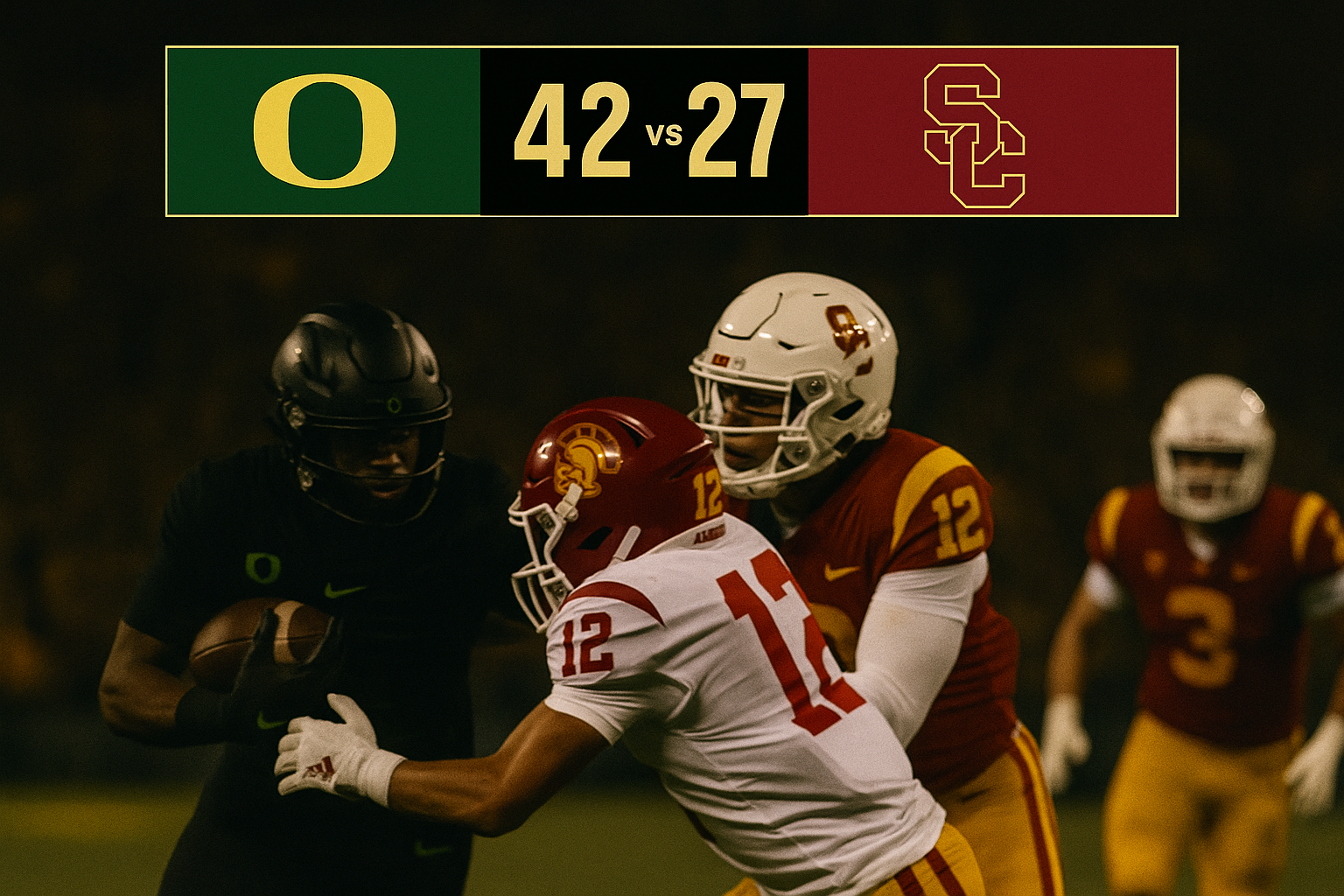
Ducks Strengthen Playoff Push Behind Balanced Offense and Game-Changing Special Teams EUGENE, Ore. — In a game loaded with postseason implications, No. 7 Oregon delivered one of its most complete performances of the season, defeating No. 15 USC 42–27 on Saturday afternoon at Autzen Stadium. The win pushed the Ducks to 10–1 (7–1 Big Ten) and kept them squarely in the College Football Playoff race, while the Trojans fell to 8–3 (6–2 Big Ten) and likely saw their playoff hopes evaporate after another road loss to a ranked opponent. Despite injuries to key offensive starters, Oregon displayed its depth, discipline, and late-game physicality to secure its third win over a ranked team this season. USC Opens Strong Before Oregon Finds Its Rhythm The Trojans struck first with an efficient opening drive. Quarterback Jayden Maiava completed four straight passes before connecting with Makai Lemon on an 8-yard touchdown — the first opening-drive touchdown Oregon’s defense had surrendered all year. USC’s early tempo, mobility at quarterback, and aggressive play-calling briefly silenced the Autzen crowd. The Ducks answered immediately. Freshman running back Jordon Davison capped Oregon’s first possession with an 11-yard touchdown run, punctuating a balanced drive built on quick screens and outside-zone rushing lanes. After Oregon’s defense forced a punt, quarterback Dante Moore found tight end Kenyon Sadiq for an 8-yard touchdown, giving the Ducks their first lead of the afternoon at 14–7 and ushering in the offensive rhythm that defined much of the first half. USC regained momentum early in the second quarter with a trick play. Lemon took a lateral near the sideline and fired a 24-yard touchdown pass to Tanook Hines , tying the game at 14–14 and keeping the Trojans within striking distance. But that tie would last less than two minutes. A Special Teams Explosion Shifts the Entire Game Midway through the second quarter, Oregon delivered the play that swung the game’s momentum decisively. A routine USC punt turned chaotic when returner Malik Benson found a crease, burst into the open field, and sprinted 85 yards for a touchdown — untouched. The return electrified Autzen Stadium and ignited a surge the Trojans could not fully recover from. It also marked Oregon’s longest punt return touchdown since 2018 and transformed a back-and-forth game into one Oregon suddenly controlled. Even after suffering multiple injuries along the offensive line, Oregon maintained its composure. With three reserves stepping in, the Ducks engineered a grinding 13-play drive capped by senior Bryce Boettcher’s one-yard touchdown plunge, sending Oregon into halftime with a 28–14 lead. The Trojans had a chance to keep it closer, but a penalty on a missed Oregon field-goal attempt extended the drive, setting up Boettcher’s score. USC head coach Lincoln Riley immediately expressed frustration on the sideline — a moment that foreshadowed more defensive struggles in the second half. USC Pushes Back, but Oregon Matches Every Punch USC opened the third quarter with renewed urgency. Lemon continued to torment Oregon’s secondary, snagging his second receiving touchdown of the game to trim the Ducks’ lead to 28–21 . Maiava exploited single-coverage opportunities and posted several deep completions that kept the Trojans competitive. But Oregon responded almost instantly. Moore found Sadiq again on a 28-yard touchdown strike down the seam, extending the Ducks’ cushion to 35–21 . The play exemplified Moore’s sharp decision-making: identifying a blitz, shifting protection, and hitting Sadiq on the hot read. The Trojans continued to fight. A pair of pass-interference penalties helped USC reach the red zone, where Maiava hit Lake McRee for a 9-yard touchdown. The failed two-point attempt left USC trailing 35–27 , but the Trojans had cut the margin to one score entering the fourth quarter. Oregon needed a championship-level drive — and delivered one. Ducks Close the Door With a Statement Drive With postseason hopes on the line, Oregon leaned heavily on its ground attack. Running back Noah Whittington , who finished with 104 rushing yards, carried the Ducks through a punishing six-minute drive that broke USC’s defensive front. Oregon converted three crucial third downs, forcing the Trojans into missed tackles, busted assignments, and desperation blitzes. Whittington capped the 75-yard march with a 9-yard touchdown run, pushing the lead to 42–27 and sealing the victory with just under five minutes remaining. The drive showcased Oregon’s depth and physicality — especially notable given the offensive-line injuries earlier in the game. Statistical Overview Oregon’s offense remained efficient and balanced despite adversity. Dante Moore went 22-for-30 for 257 yards and two touchdowns , finding seven different receivers. Kenyon Sadiq stepped up with six receptions for 72 yards and two scores, while Malik Benson added four catches plus his pivotal punt-return touchdown. The Ducks finished with nearly 180 rushing yards , steadily wearing down USC as the game progressed. Defensively, Oregon forced two interceptions and held USC to 52 rushing yards , forcing the Trojans into a pass-heavy attack that struggled late. USC, meanwhile, leaned on Maiava’s arm. He finished with 306 yards and three touchdowns , and Lemon delivered one of his best performances of the season with two scores and a touchdown pass. Yet the Trojans’ inability to run the ball consistently — combined with Oregon’s clutch scoring drives — ultimately determined the outcome. Final Takeaway Oregon’s 42–27 triumph proved why the Ducks remain a legitimate playoff contender. Depth, special-teams explosiveness, red-zone efficiency, and physical fourth-quarter football all played critical roles in a win that required resilience and adaptability. For USC, the loss reflected a season-long theme: explosive offense overshadowed by defensive lapses and struggles in hostile road environments. Oregon now heads into a high-stakes rivalry showdown at Washington with its postseason destiny still within reach — a testament to its growth, maturity, and championship-level poise.
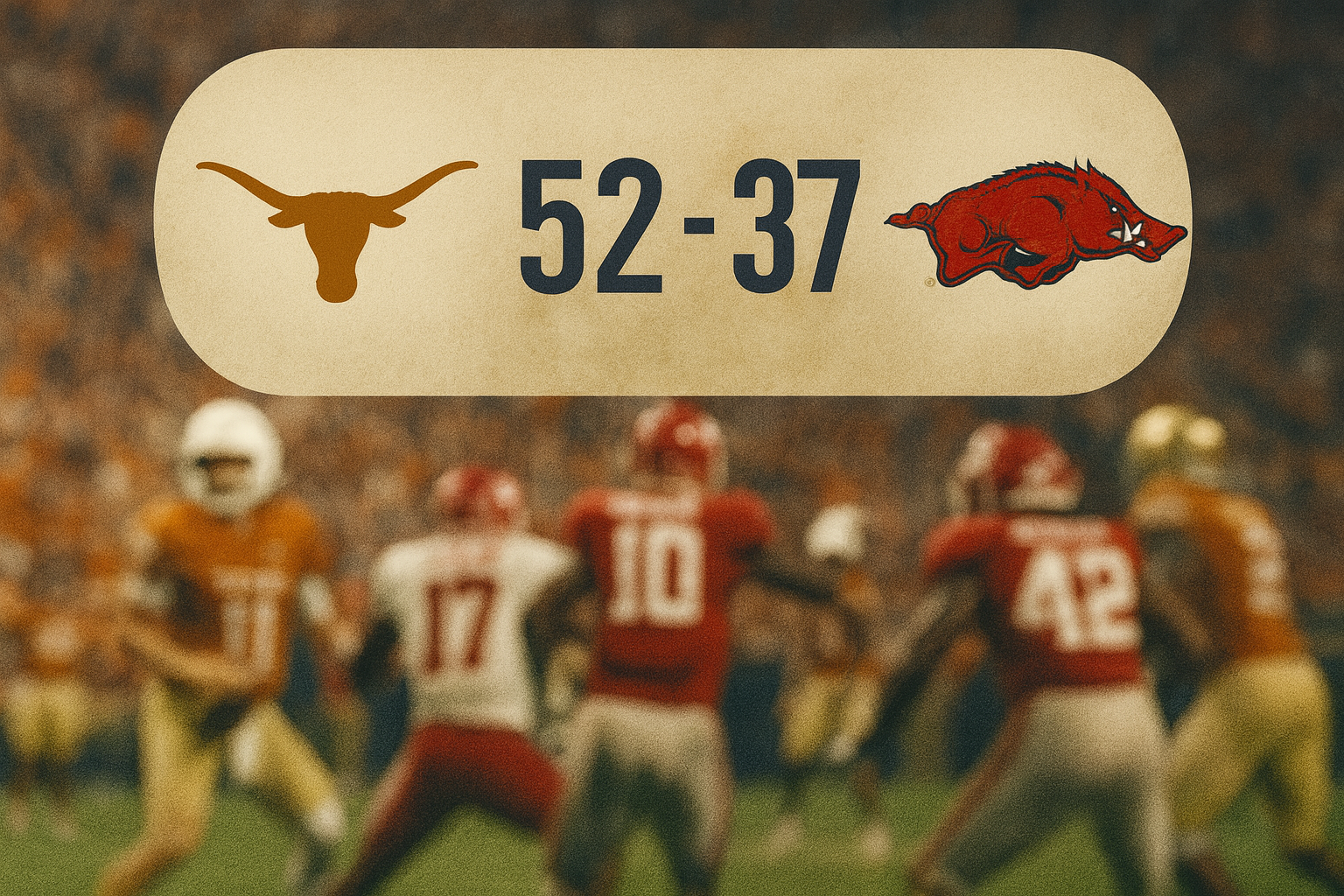
Longhorns Extend Home Winning Streak as Sophomore Quarterback Sets Modern Program Milestones AUSTIN, Texas — No. 17 Texas showcased its most explosive offensive outing of the season on Saturday afternoon, defeating Arkansas 52–37 at Darrell K Royal–Texas Memorial Stadium. The win lifted the Longhorns to 8–3 (5–2 SEC) , while Arkansas fell to 2–9 (0–7 SEC) in a matchup defined by fireworks on both sidelines — but controlled by the brilliance of Arch Manning. The sophomore quarterback delivered a historic six-touchdown performance, becoming the first Texas player since Bobby Layne in 1946 to record a passing, rushing, and receiving touchdown in the same game. Manning threw for a career-high 389 yards , led touchdown drives on seven of Texas’ first nine possessions, and established himself as the centerpiece of the Longhorns’ late-season surge. Texas Starts Fast With Precision and Creativity Texas wasted no time setting the tone. Manning opened the game completing three straight passes before launching a 46-yard touchdown to DeAndre Moore Jr., who finished with a career-best three touchdown receptions — the most by a Longhorn since 2021. The highlight came minutes later: a Philly Special -style trick play capped with a touchdown reception by Manning himself, pushing Texas ahead 14–6 and electrifying the home crowd. Arkansas kept the score tight early behind running back Mike Washington Jr. and quarterback Taylen Green. A Green rushing TD cut the margin to 14–13 midway through the second quarter, but Texas regained momentum before halftime with a 44-yard field goal to take a 24–20 lead into the locker room. Longhorns Break the Game Open in the Third Quarter Texas dominated the third quarter, scoring touchdowns on each of its first three second-half drives. Manning extended the first drive with two long completions before powering in a 3-yard rushing touchdown, becoming the first SEC quarterback in more than a decade to record a passing, rushing, and receiving TD in the same game. Moments later, a Green interception set up another quick Texas score — a strike to Moore Jr. After Arkansas managed a field goal to stop the bleeding, Texas answered immediately with a third Manning-to-Moore Jr. touchdown, stretching the lead to 45–23 . The Longhorns’ offense was nearly flawless in the quarter: explosive plays, quicktempo execution, and constant pressure on the Razorbacks’ secondary. Manning averaged more than 21 yards per completion , connecting with six different receivers on chunk plays of 22+ yards. Arkansas Fights, but Texas Maintains Control Arkansas showed resilience after halftime, especially with KJ Jackson replacing Green at quarterback. Jackson led a late-third-quarter scoring drive, while Washington Jr. surpassed the 1,000-yard mark on the season — the first Razorback running back to do so since 2022. His 105-yard performance also marked the 10th time an Arkansas player has rushed for 100+ yards against Texas. But the Longhorns’ defense delivered the decisive moment early in the fourth quarter. On fourth down, freshman pass rusher Colin Simmons exploded into the backfield for his 10th sack of the season, forcing a fumble that Liona Lefau returned 52 yards for a touchdown to push the score to 52–30 . Arkansas added a late touchdown, but the outcome had long been decided. After allowing 157 rushing yards on 17 attempts in the first half, Texas tightened its run defense significantly, holding Arkansas to just 31 second-half rushing yards. Numbers Behind Texas’ Dominant Win Texas finished with 490 total yards , driven primarily by Manning’s 389-yard passing day and explosive plays from a receiving corps that repeatedly stretched the field. Moore Jr., Parker Livingstone (104 yards), and Emmett Mosley V each notched receptions of 30+ yards. Though Texas rushed for only 97 yards, the passing attack proved overwhelming, scoring quickly and consistently across all four quarters. Arkansas posted 500 total yards , but its early offensive success faltered under Texas’ second-half adjustments. The Razorbacks’ inability to match Texas’ scoring burst — especially during the Longhorns’ 21-point third quarter — proved decisive. Final Takeaway Texas’ 52–37 victory was a showcase of offensive creativity, defensive resilience, and the maturation of Arch Manning as a top national quarterback. His historic six-touchdown performance — paired with a defensive score from Lefau and a second-half lockdown against the Arkansas run game — highlighted the Longhorns’ most complete SEC showing of the season. With the win, Texas extended its dominant home streak to 19 victories in its last 20 games at Darrell K Royal–Texas Memorial Stadium. The Longhorns now look ahead to a high-stakes rivalry showdown with No. 3 Texas A&M , a matchup that will heavily influence both teams’ postseason paths.
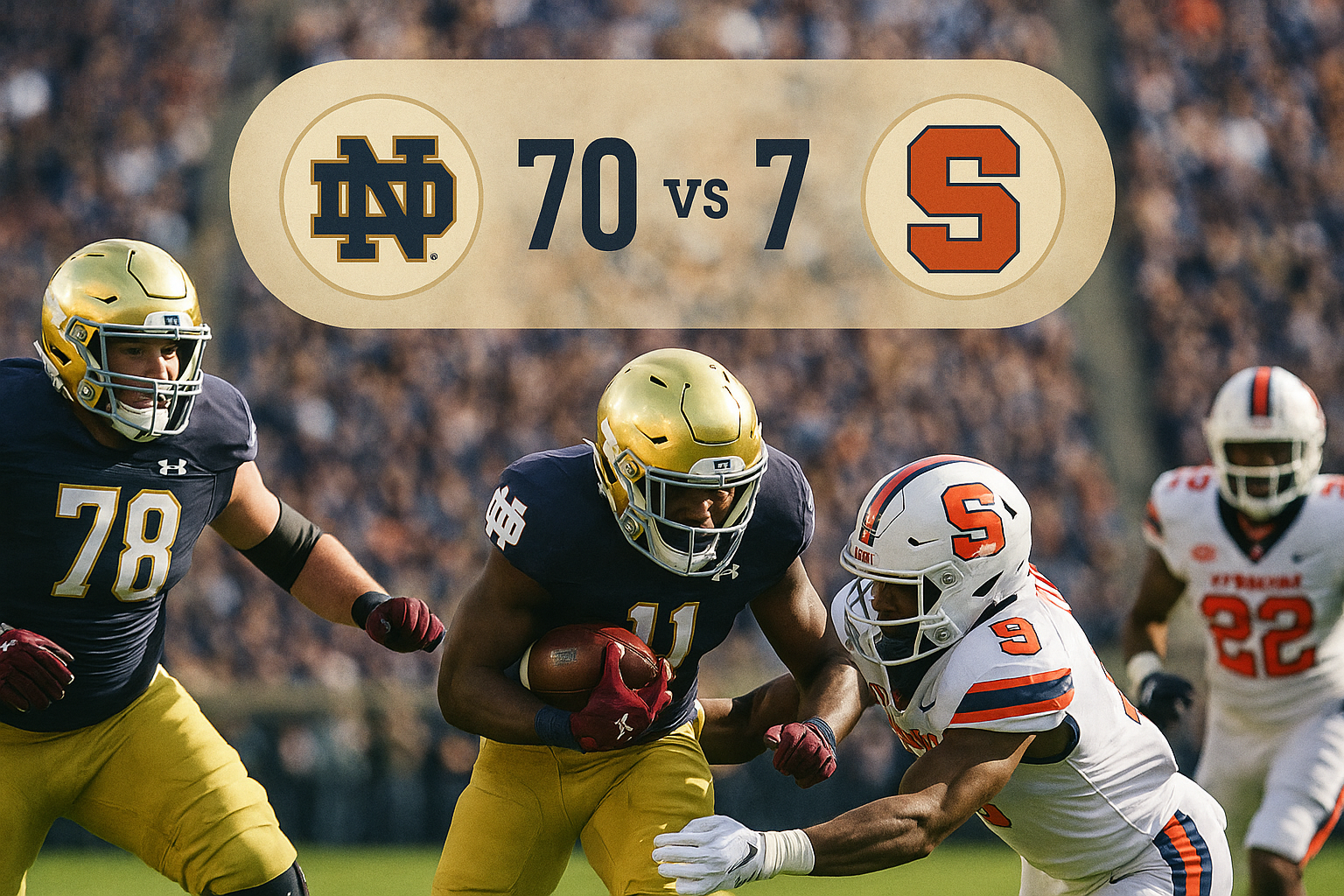
Fighting Irish Dominate All Phases as Orange Drop Seventh Straight SOUTH BEND, Ind. — Syracuse endured one of the most lopsided defeats in its 134-year football history on Saturday afternoon, falling 70–7 to No. 9 Notre Dame at Notre Dame Stadium. The Orange were overwhelmed from the opening seconds, outmatched in all three phases as the Irish surged to their ninth win of the season. The loss was Syracuse’s worst since 1893 , when Union posted a 66–0 shutout. Now 3–8 overall and 1–6 in the ACC , the Orange have dropped seven straight and continue to search for stability after a year defined by quarterback turnover, offensive inconsistency, and a defense stretched beyond its limits. Notre Dame Scores Three Touchdowns Before Its Offense Touches the Ball The game spiraled immediately. Syracuse’s first possession ended in disaster when Jalen Stroman jumped a pass and returned it 44 yards for a touchdown . On the next series, Notre Dame blocked a punt and ran it back for another score. Moments later, freshman quarterback Joseph Filardi threw a second interception, returned by Leonard Moore for Notre Dame’s third non-offensive touchdown of the quarter. Before running a single offensive play, the Irish led 21–0 . When the offense finally took the field, it continued the avalanche. Jeremiyah Love burst through the left side for a 45-yard touchdown , and on the next series Jadarian Price broke a 58-yard scoring run . With four minutes left in the first quarter, Notre Dame had already reached 35–0 , the highest single-quarter point total in program history. Syracuse Searches for Stability, but Notre Dame Pulls Away Trying to stop the bleeding, Syracuse rotated between Filardi and freshman Luke Carney. Filardi eventually settled in and produced career highs with 14 completions and 83 passing yards , adding 33 rushing yards despite constant pressure. Tight end Dan Villari continued his standout season, catching five passes to push his season total to 38 — the fourth-most ever by a Syracuse tight end . The Orange managed 207 total yards, including 112 rushing, but they couldn’t slow Notre Dame’s explosive ground attack. Love finished with 171 yards and three touchdowns on just eight carries , becoming only the third FBS player since 1996 to hit those marks on so few attempts. Price added his long touchdown as the Irish amassed 329 rushing yards . Notre Dame capitalized on every mistake, tacking on two more touchdowns before halftime to lead 49–0 at the break. Irish Keep the Pressure On Any hopes of a second-half reset evaporated quickly. On the Irish’s third play after halftime, Love burst through for a 68-yard touchdown , extending the margin to 56–0 . Notre Dame tacked on two more touchdowns early in the fourth quarter to reach 70–0 , becoming just the third team ever to score 70 points against Syracuse. Syracuse finally avoided a shutout in the final minute when Filardi scrambled in from six yards out, making it 70–7 , which stood as the final score. A Season of Struggles on Full Display The rout highlighted the issues that have plagued Syracuse all year. Quarterback injuries and inconsistency forced both Filardi and Carney into extended action behind an offensive line that struggled to protect or create running lanes. Defensively, the Orange have repeatedly been forced into long, draining stretches on the field. Against Notre Dame’s depth, speed, and physicality, those weaknesses were magnified. Syracuse has now lost all seven games without its Week 1 starting quarterback, underlining the instability at the heart of its offensive struggles. Final Takeaway and What Comes Next Notre Dame played like a playoff contender sharpening its postseason form, scoring via defense, special teams, and explosive offense to take complete control of a game that was never in doubt. Syracuse, now 3–8 , returns home next Saturday to host Boston College in its season finale, trying to avoid an eight-game losing streak and finish with something positive as it turns the page toward 2026.

Vols Score on First Four Drives, Overpower Gators to End Gainesville Nightmare GAINESVILLE, Fla. — Tennessee ended one of college football’s most notorious streaks on Saturday night, defeating Florida 31–11 inside Ben Hill Griffin Stadium and earning its first road victory in The Swamp since 2003. The No. 20 Volunteers delivered their most dominant first half of the season, surging to a 31–0 halftime lead that extinguished the crowd energy long before the final whistle and pushed Tennessee to 8–3 overall and 4–3 in the SEC. Florida fell to 3–8 and 2–6 in conference play, marking the program’s first eight-loss season in more than a decade. Tennessee’s Historic First Half Sets the Stage From the opening possession, Tennessee played with an urgency that suggested it intended to rewrite two decades of frustration. The Vols marched 75 yards in nine plays on their first drive, ending with a 23-yard touchdown from Joey Aguilar to Ethan Davis. Florida’s offense stalled on its first series, and Tennessee immediately struck again, capping another efficient drive with a one-yard touchdown run by DeSean Bishop. The second quarter only magnified the momentum shift. Bishop scored again to polish off a 12-play, 67-yard drive, and moments later, Star Thomas broke free for a 52-yard run that set up a fourth consecutive Tennessee touchdown. With more than nine minutes still remaining before halftime, the Volunteers had built a 28–0 lead and silenced the sellout crowd. The dominance was nearly absolute. Midway through the second quarter, Tennessee had outgained Florida 189–1. The Gators’ lone highlight — a long reception by Jadan Baugh — was erased by a penalty, symbolizing a half where nothing came easily. Tennessee added a late field goal to stretch the margin to 31–0, marking its largest halftime lead in an SEC road game in more than ten years and effectively deciding the game before the break. Florida Finds Late Rhythm but Never Threatens Florida carried the nation’s longest active scoring streak into the matchup, having scored in 471 consecutive games. That streak appeared in serious jeopardy deep into the third quarter as Tennessee continued to smother the Gator offense. Only after a sustained 13-play, 71-yard drive did Florida finally break through, settling for a 46-yard field goal that extended its streak and cut the deficit to 31–3. DJ Lagway showed signs of poise in the second half, completing short and intermediate throws that kept drives alive. He finished 11-of-17 for 116 yards and added a late touchdown pass, but Tennessee consistently dictated the pace by collapsing the pocket and forcing Florida into predictable situations. Baugh was Florida’s brightest offensive presence, rushing for 96 yards on 18 carries and providing several of the team’s few explosive moments. Florida reached the end zone with just over seven minutes remaining, when Lagway connected with Baugh for a 33-yard touchdown before converting the two-point try. The score narrowed the margin to 31–11, but the Gators never mounted another serious push, as Tennessee’s defense quickly regained control. Tennessee’s Defense Complements Early Offensive Firepower While Tennessee’s offense stole the spotlight in the first half, its defense played with relentless discipline during the final two quarters. Linebacker Jeremiah Telander anchored the unit with ten tackles, helping the Vols consistently win battles at the line of scrimmage. Tennessee recorded six tackles for loss and disrupted any attempt Florida made to stretch the field vertically. The Volunteers also controlled the clock, limiting Florida to only a handful of meaningful possessions after halftime. With Tennessee’s run game repeatedly moving the chains — finishing with a season-high 248 rushing yards — the Gators had little ability to accelerate the tempo or build the momentum needed to spark a comeback. Joey Aguilar played efficiently throughout the night, throwing for 204 yards while guiding an attack that spread the field early before leaning on the ground game late. The combination of controlled passing and explosive rushing allowed Tennessee to maintain field position and prevent Florida from gaining confidence. A Night of History for Tennessee’s Offense Tennessee’s win marked one of the program’s signature moments under its current trajectory, snapping a two-decade drought in Gainesville and showcasing the depth and versatility of its offense. The game also delivered a historic milestone: for the first time in program history, three Volunteer receivers surpassed 700 receiving yards in a single season — Chris Brazzell, Braylon Staley, and Mike Matthews. The achievement underscored the transformation of Tennessee’s offensive identity, built on spacing, timing, and relentless vertical pressure. Even as the Vols shifted to a run-heavy approach in the second half, their early execution revealed a level of balance that created constant conflict for the Florida defense. Florida’s Difficult Season Hits a New Mark For the Gators, the loss brought more unwanted history. Florida suffered its first eight-loss season since 2013 and saw its decade-long home dominance over Tennessee come to a definitive end. The Swamp, which had long served as one of college football’s most intimidating venues, could not rescue a team plagued by slow starts, stalled drives, and defensive inconsistencies. Yet despite the lopsided score, Florida’s home fans filled the stadium for the seventeenth straight sellout, holding out hope for a late-season rally that never materialized. Final Takeaway Tennessee’s 31–11 victory was more than a rivalry win — it was a statement of progress and resilience. The Vols delivered their most commanding first half of the season, complemented it with disciplined defense, and snapped one of the nation’s most persistent road droughts. Florida showed resolve in the second half but was unable to overcome a disastrous opening 30 minutes that defined the game. With momentum building, Tennessee returns home to face Vanderbilt, aiming to finish the season on a three-game winning streak. Florida heads to Tallahassee to face Florida State, seeking to end a challenging season with a final measure of improvement.
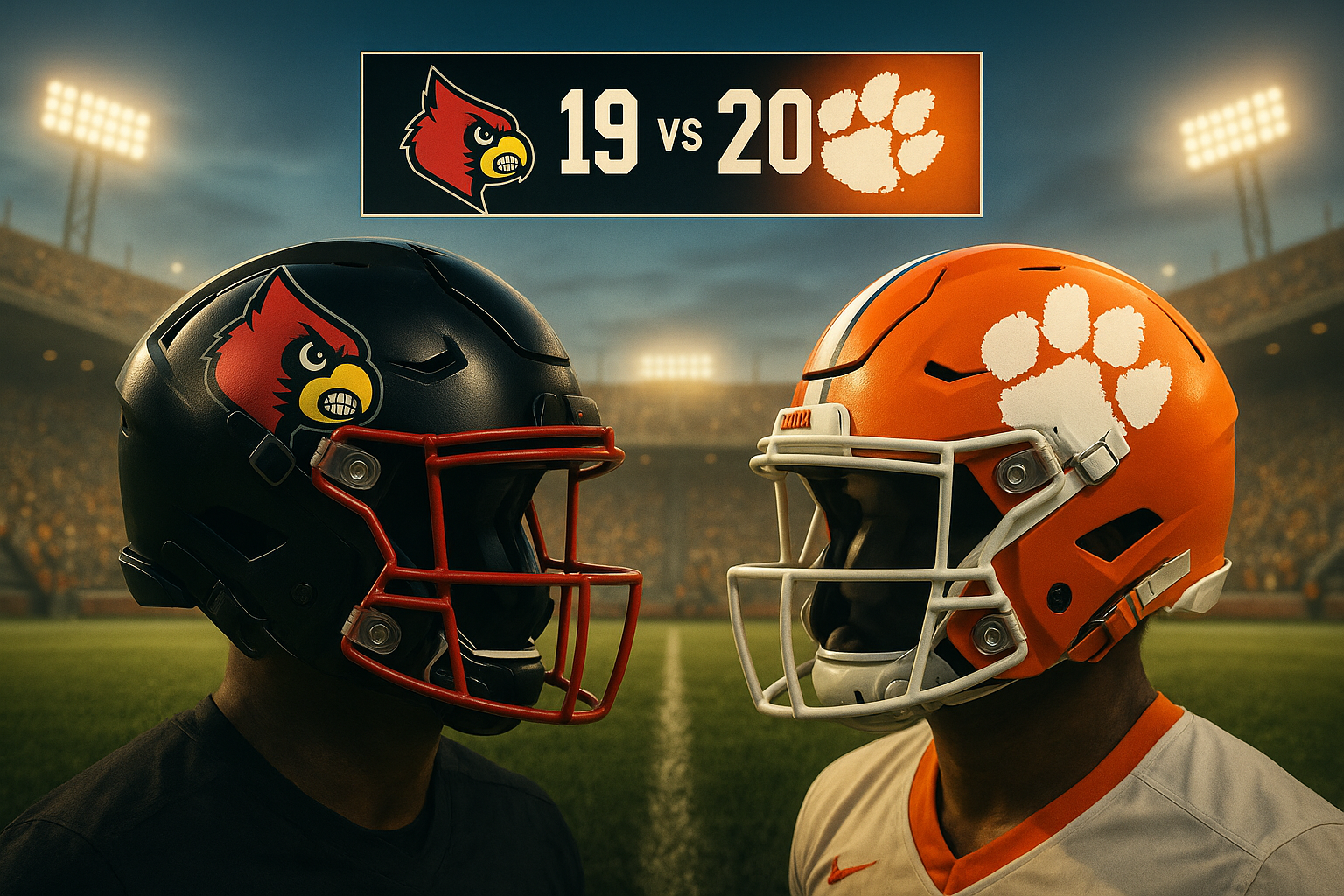
Cardinals Drop Third ACC Game by One Score in Hard-Fought Home Finale LOUISVILLE, Ky. — The University of Louisville football team suffered another heartbreaking defeat on Friday night, falling 20–19 to Clemson at L&N Stadium in a matchup defined by momentum swings, defensive stands, and missed scoring chances. The loss marked Louisville’s third ACC setback of the season decided by three points or fewer, halting the Cardinals’ push to climb the conference standings. Louisville had multiple chances to retake the lead in the final minutes — including two field goal attempts and a short-field possession following a Clemson mistake — but stalled drives, penalties, and two missed kicks ultimately sealed the one-point loss. Strong Start and Tight First Half Clemson opened the scoring with a steady 12-play, 65-yard drive capped by a 27-yard field goal. Louisville answered late in the first quarter when kicker Cooper Ranvier drilled a career-long 51-yard field goal to tie the game at 3–3. Louisville’s defense produced the first major swing early in the second quarter, forcing a punt and giving the Cardinals excellent field position. Three plays later, quarterback Miller Moss finished the drive with a one-yard touchdown run. A missed PAT kept the lead at 9–3. Momentum shifted moments later when Clemson cornerback Avieon Terrell forced and recovered a fumble at the Louisville 25-yard line. On the next snap, running back Adam Randall sprinted 25 yards for a touchdown, sending the Tigers into halftime ahead 10–9. Louisville Regains Control in the Third Quarter The Cardinals opened the second half with one of their most creative drives of the season. After moving 75 yards in seven plays, wide receiver Caullin Lacy took a flip from Moss and lofted a two-yard touchdown pass to tight end Nate Kurisky, putting Louisville ahead 16–10. Clemson responded with a 48-yard field goal from Nolan Hauser before Ranvier added a 39-yard field goal to push the Louisville lead to 19–13. Louisville’s offense continued to move efficiently. Running back Keyjuan Brown delivered his second straight dominant performance, rushing for 135 yards on 14 carries. Moss added 212 yards through the air, and Lacy contributed four catches for 60 yards along with his touchdown throw. Clemson’s Late Push Turns the Tide Clemson seized control in the fourth quarter with the game’s defining drive. Randall broke free for a 46-yard run, setting up a six-play, 56-yard march that he capped with a one-yard touchdown plunge on fourth-and-goal. The Tigers reclaimed the lead 20–19 with 7:16 remaining. Louisville came inches from answering back. After crossing midfield with a well-executed trick play, the Cardinals faced a drive-stalling sack that forced a 50-yard field goal attempt. Ranvier’s kick missed wide left. A muffed Clemson punt moments later gave Louisville a golden chance at the Tigers’ 23-yard line. But penalties pushed the Cardinals backward, and backup kicker Nick Keller’s 46-yard attempt also missed, leaving Clemson clinging to its one-point lead. Louisville had one final possession with 30 seconds left but failed to reach midfield before turning the ball over on downs. Clemson’s defense — opportunistic all game — delivered the closing stand. Defensive Standouts and Key Performances Louisville’s defense kept the team within striking distance throughout the night. Antonio Watts and Stanquan Clark each finished with seven tackles, and Watts added a key forced fumble in the second quarter. Defensive lineman Clev Lubin recorded Louisville’s lone sack. On offense, Moss played efficiently under pressure, Brown ran with authority for his second straight 130-yard effort, and Lacy continued his emergence as a versatile weapon. Kurisky’s short touchdown grab also highlighted one of Louisville’s most creative scoring plays of the season. For Clemson, Randall posted a career night with 132 total yards and both Tiger touchdowns. Quarterback Cade Klubnik threw for 187 yards without committing a turnover, and the Clemson defense delivered multiple pivotal plays — including a late third-down sack that prevented a potential Louisville scoring drive. Final Takeaway Louisville’s 20–19 loss was defined by missed opportunities, costly penalties, and two critical missed field goals in the final minutes. Despite strong individual performances and consistent offensive movement, the Cardinals were unable to convert when it mattered most. Louisville now turns its attention to a challenging road matchup at SMU, aiming to rebound from another narrow defeat and close out ACC play with renewed urgency and focus.
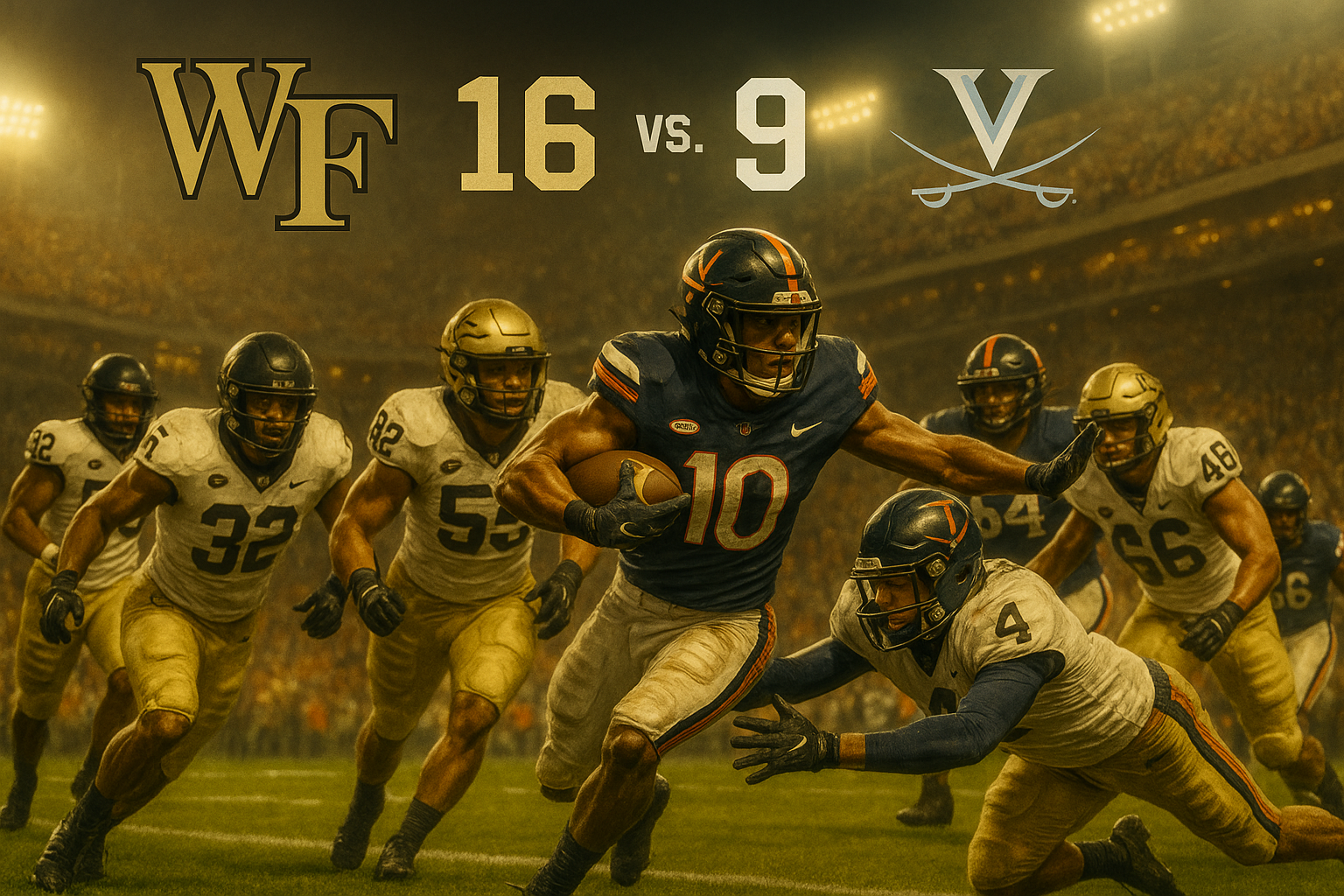
Demon Deacons Clinch Bowl Eligibility Behind Dominant Defense and Historic Special Teams Play CHARLOTTESVILLE, Va. — The Wake Forest Demon Deacons stunned No. 12 Virginia on Saturday night with a 16–9 victory at Scott Stadium, snapping the Cavaliers’ seven-game win streak and handing them their first Atlantic Coast Conference loss of the season. The win marked Wake Forest’s 18th all-time victory over a top-20 opponent and secured bowl eligibility for the eighth time in the last ten years . The game was defined by defense and special teams. Wake Forest scored the only touchdown on an 88-yard punt return by Carlos Hernandez , while kicker Connor Calvert drilled three field goals — two from beyond 49 yards. The Deacons held Virginia without a touchdown for the first time since 2022, limiting the Cavaliers to 327 total yards and forcing three costly turnovers that flipped the game’s momentum. A Defensive Struggle from the Start Virginia began the night with confidence, backed by its largest home crowd of the season — 55,568 fans under the lights at Scott Stadium. The Cavaliers struck first after Kam Robinson blocked a punt on Wake Forest’s opening drive, giving UVA possession inside the red zone. However, the Deacons’ defense immediately set the tone, holding Virginia to a short Will Bettridge field goal instead of a touchdown. That defensive stand previewed what would become the night’s theme: field goals, missed opportunities, and momentum swings . Virginia added another Bettridge kick midway through the second quarter after quarterback Chandler Morris exited with a head and neck injury sustained while sliding on a scramble. Morris’ departure sidelined him for the rest of the game and changed the tone of Virginia’s offense. With backup Daniel Kaelin under center, the Cavaliers continued to move the ball effectively between the 20s but failed to capitalize. Wake Forest’s defense held strong and flipped the script late in the half with a game-changing moment. Hernandez’s Return Sparks the Deacons Trailing 6–0 with less than two minutes before halftime, Wake Forest finally broke through. After forcing a Virginia punt, Carlos Hernandez fielded a bouncing ball and sliced through defenders for an 88-yard touchdown return — the second-longest punt return in school history. The explosive play stunned the home crowd and gave the Deacons a 7–6 lead, marking their first punt-return touchdown since 2023. Moments later, Connor Calvert added a 40-yard field goal before halftime, extending Wake’s lead to 10–6. The sequence highlighted the Deacons’ opportunistic play on defense and special teams, which forced two fumbles and limited Virginia to just 64 passing yards in the first half. Wake Forest Extends Its Lead Virginia opened the third quarter with another Bettridge field goal, narrowing the gap to 10–9. But the Cavaliers’ turnover woes continued. On the next series, Wake Forest’s front — led by Nuer Gatkuoth and Dallas Afalava — stripped Kaelin near midfield, setting up a short field for the Deacons. Calvert converted the takeaway into points with a 50-yard field goal , pushing Wake ahead 13–9. Early in the fourth quarter, he struck again from 49 yards , giving the Deacons a 16–9 advantage that would hold to the final whistle. Wake’s defense delivered the knockout blow in the closing minutes. With Virginia threatening near midfield, linebacker Dylan Hazen forced and recovered his second fumble of the game, ending another Cavalier drive. On Virginia’s final possession, Kaelin’s fourth-down pass into the end zone fell incomplete — sealing Wake Forest’s signature win. Virginia’s Missed Chances Virginia’s offense, averaging over 28 points per game entering the night, struggled to find rhythm after Morris’ injury. Backup Daniel Kaelin performed admirably in relief, completing 18 of 28 passes for 145 yards , but two costly fumbles derailed promising drives. Running back J’Mari Taylor added 98 rushing yards on 16 carries , including a 43-yard burst, but his late-game fumble was Virginia’s third turnover of the night — a rare lapse for a team that had gone the entire season without losing a fumble until this game. Despite posting 327 total yards and explosive plays from Kaelin and Taylor, Virginia failed to convert in the red zone and was held without a touchdown for the first time since 2022 . The Cavaliers outgained Wake Forest by more than 120 yards but could not overcome self-inflicted mistakes and special teams breakdowns. On defense, Kam Robinson led the Cavaliers with 10 tackles and a blocked punt , while Devin Neal added eight stops. Still, the pivotal lapse came on special teams — Hernandez’s game-breaking return that shifted control for good. Wake Forest’s Statement Win For Wake Forest, the victory represented more than an upset — it was a defining moment under first-year head coach Jake Dickert , who became the first in program history to clinch bowl eligibility in his debut season. The Deacons improved to 6–3 overall and 3–3 in ACC play , bouncing back from a 42–7 defeat at Florida State the previous week. Defensively, the Deacons’ effort was historic. They held Virginia to just 64 passing yards , the fewest allowed by the program since 2018, and forced three turnovers , recovering all of them. Hazen’s two recoveries and seven tackles anchored a front that disrupted Virginia’s rhythm all night. Special teams were equally pivotal. Hernandez’s punt-return touchdown changed the game’s complexion, while Calvert’s 3-for-3 field goal performance — from 39, 50, and 49 yards — provided the margin of victory. The Deacons also improved to 4–1 in one-score games , underscoring their ability to execute under pressure. Looking Ahead Virginia (8–2, 5–1 ACC) remains alive in the conference title race but will need help to reach the championship game. The Cavaliers travel to Duke next Saturday for a pivotal matchup against another one-loss ACC contender. Wake Forest returns home for its Military Appreciation Game against North Carolina on Nov. 15, aiming to build on the momentum from its highest-ranked road win since 1979 , when the Deacons last defeated a top-12 opponent away from home. Final Takeaway Wake Forest’s 16–9 win at No. 12 Virginia was a masterclass in discipline, field position, and opportunistic play. The Demon Deacons’ defense and special teams executed flawlessly, transforming a defensive slugfest into a statement win that sealed bowl eligibility and redefined their ACC trajectory. For Virginia, the loss exposed the thin line between dominance and defeat. Turnovers, red-zone inefficiency, and the absence of their starting quarterback proved insurmountable. Wake Forest, however, left Charlottesville with validation — and another chance to chase a memorable postseason run.
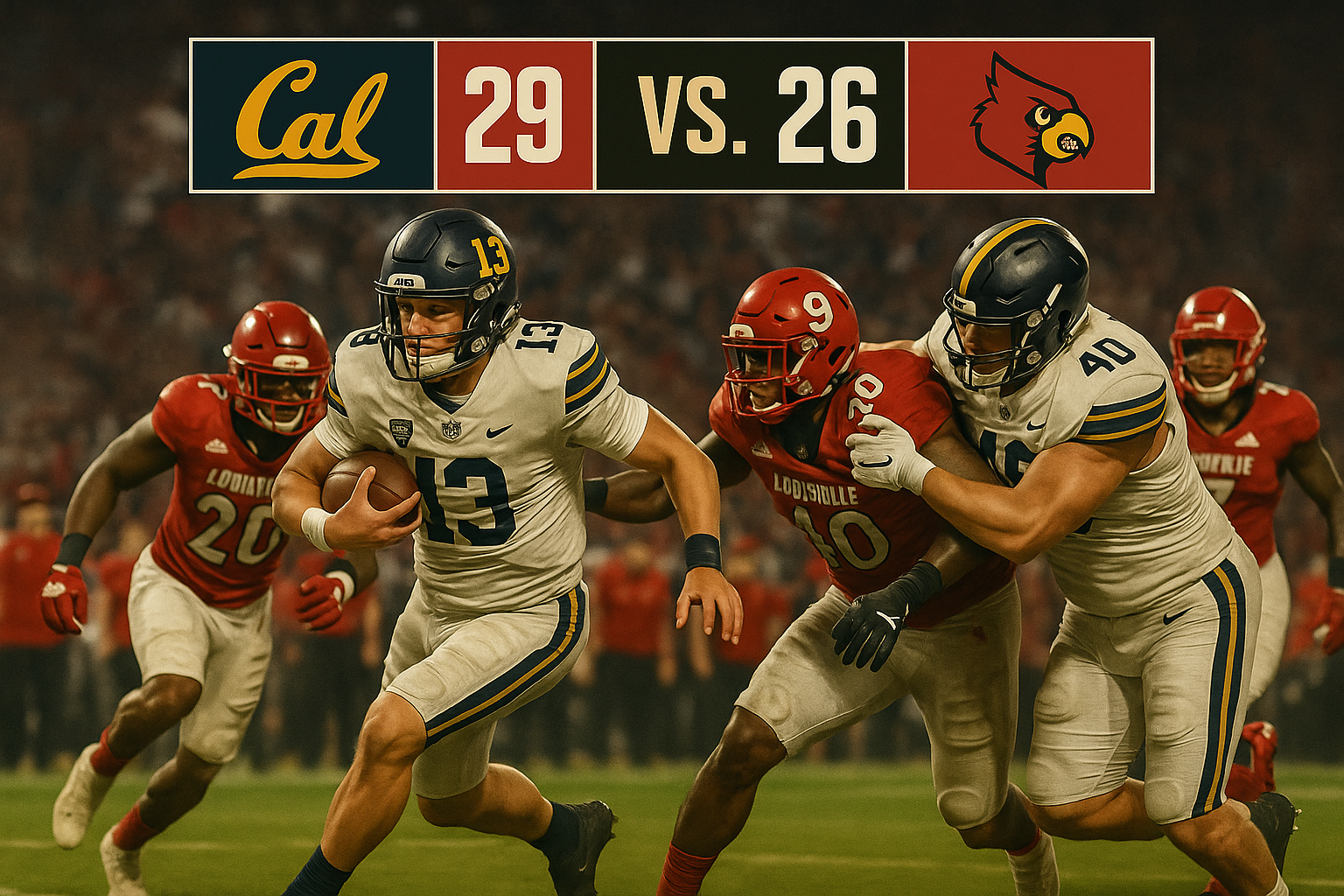
Bears Stun Cardinals with Fourth-Down Touchdown to Secure Bowl Eligibility LOUISVILLE, Ky. — In one of the season’s most dramatic finishes, the California Golden Bears stunned No. 14 Louisville 29–26 in overtime on Saturday night at L&N Stadium. The victory marked Cal’s first win over a ranked opponent since 2020 and clinched bowl eligibility for the third consecutive year , their longest streak since the early 2000s. Quarterback Jaron-Keawe Sagapolutele delivered a career performance, throwing for 323 yards and two touchdowns , while wide receiver Jacob De Jesus tied a school record with 16 receptions for 158 yards , including the game-winning catch in overtime. Louisville’s loss dropped the Cardinals to 7–2 overall and 4–2 in the ACC , both defeats coming in overtime. Cal improved to 6–4 (3–3 ACC) in its debut conference season. Louisville Controls Early, Cal Answers Back Louisville opened the game with precision, marching 78 yards in 10 plays on the opening drive. Running back Duke Watson finished the possession with a 1-yard touchdown run to give the Cardinals a 7–0 lead midway through the first quarter. Cal responded quickly. Sagapolutele engineered a six-play, 74-yard drive capped by a 20-yard touchdown pass to tight end Landon Morris , evening the score at 7–7 as the first quarter came to a close. In the second quarter, Louisville regained momentum behind kicker Cooper Ranvier , who connected on a 30-yard field goal to push the Cardinals ahead 10–7. Cal answered with a 27-yard kick by Chase Meyer , knotting the score again at 10–10. As the half wound down, both teams traded scores in the final minutes. Ranvier’s 49-yard field goal gave Louisville a brief 13–10 advantage before Cal closed the half with a nine-play, 75-yard drive capped by Kendrick Raphael’s 1-yard touchdown run . The Bears took a 17–13 lead into halftime , having outgained Louisville through the air and controlled tempo despite the Cardinals’ strong rushing start. A Tight Second Half Cal extended its advantage early in the third quarter as Meyer hit a 45-yard field goal , stretching the lead to 20–13. Louisville quickly answered behind quarterback Miller Moss , who completed several intermediate throws and capped an eight-play, 75-yard drive with a 1-yard quarterback sneak to tie the game 20–20. Moss, who finished 20-of-38 for 203 yards , also added a rushing touchdown in one of his most complete efforts of the year. Running back Keyjuan Brown paced the ground attack with 136 yards on 14 carries , marking his first career 100-yard performance. Cal regained the lead late in the third quarter when Meyer’s 26-yard field goal concluded a 13-play, 67-yard drive to make it 23–20 . Louisville’s defense held strong on consecutive red-zone stops to keep the game within reach heading into the fourth quarter. In the final period, the Cardinals tied the contest once more as Ranvier drilled his third field goal of the evening — this one from 39 yards — to even the score at 23–23. Both defenses tightened, forcing punts and missed opportunities over the final 10 minutes. Cal’s attempt at a go-ahead drive stalled at midfield, while Louisville’s last possession ended with a penalty before the clock expired, sending the game into overtime. Overtime Drama Louisville won the toss and chose to take the ball first. After a short run and two incomplete passes, the Cardinals relied again on Ranvier, who delivered his fourth field goal of the night , this one from 49 yards , to put Louisville ahead 26–23. Needing a touchdown to win, Cal maintained composure. Sagapolutele completed two short passes to De Jesus and Raphael to move the chains. After a brief rush, the Bears faced fourth-and-3 from the Louisville 8-yard line . Instead of settling for a tie, the offense stayed on the field. Sagapolutele took the snap, rolled to his left, and found De Jesus just inside the end zone for the decisive 3-yard touchdown . The play sealed the 29–26 win and sent the Cal sideline into celebration, marking the program’s first overtime victory since 2016. Key Performances and Records Sagapolutele’s poise stood out throughout the contest. The redshirt freshman completed 30 of 47 passes , setting new career highs across every category while extending his streak to 10 consecutive games with at least 200 passing yards , the longest such start by any Power Four quarterback in recent memory. De Jesus’ 16 receptions matched the Cal single-game record held by Geoff McArthur , set against Stanford in 2003. His 158 yards and game-winning score punctuated a breakout performance that showcased both durability and precision in route running. Cal’s kicking game also proved critical. Chase Meyer went 3-for-3 on field goals , connecting from 27, 45, and 26 yards, and consistently pinned Louisville deep with accurate kickoffs. Defensively, linebacker Dru Polidore Jr. posted 10 tackles , while lineman Derek Wilkins batted down two passes at the line, bringing his season total to six deflections — the most by a Cal lineman since 2018. Hezekiah Masses added a key pass breakup that stopped a Louisville scoring threat in the third quarter. For Louisville, Clev Lubin led the defense with 10 tackles , including one for loss, while T.J. Quinn added eight. Cornerback Jabari Mack contributed six tackles and helped limit Cal’s vertical passing game for much of the evening. Momentum Shift and Aftermath For Louisville, the loss was particularly painful. Both of the Cardinals’ defeats this season have come in overtime, derailing their path toward an ACC Championship berth. Penalties and missed defensive assignments again proved costly, including several infractions that extended Cal’s second-half drives. Despite outgaining the Bears on the ground and controlling time of possession, Louisville failed to capitalize on scoring opportunities, particularly in the red zone. Their four field goals reflected efficiency from Ranvier but highlighted the offense’s inability to convert key third downs. Cal, meanwhile, displayed the discipline and adaptability of a team maturing under head coach Justin Wilcox . The Bears have now won three of their past four road games against ranked teams and continue to build credibility in their first ACC campaign. What’s Next The Cardinals remain at home to host Clemson on Friday night, with kickoff scheduled for 7:30 p.m. ET on ESPN. Cal enters its bye week before heading north to face Stanford in the 128th Big Game on Nov. 22, where the Bears will seek to extend their momentum and close out the regular season on a high note. Final Takeaway Cal’s 29–26 overtime victory at Louisville was a testament to execution under pressure and confidence in critical moments. With Sagapolutele’s steady leadership, De Jesus’ record-tying performance, and Meyer’s precision in the kicking game, the Bears demonstrated a complete team effort that turned potential heartbreak into a signature win. For Louisville, the defeat underscored how slim the margins are at the top of the ACC — a few penalties, a missed assignment, or a single red-zone lapse can change everything. As Cal celebrates its milestone road win and bowl eligibility, the program also sends a clear message: under the lights, in any stadium, this team can finish.
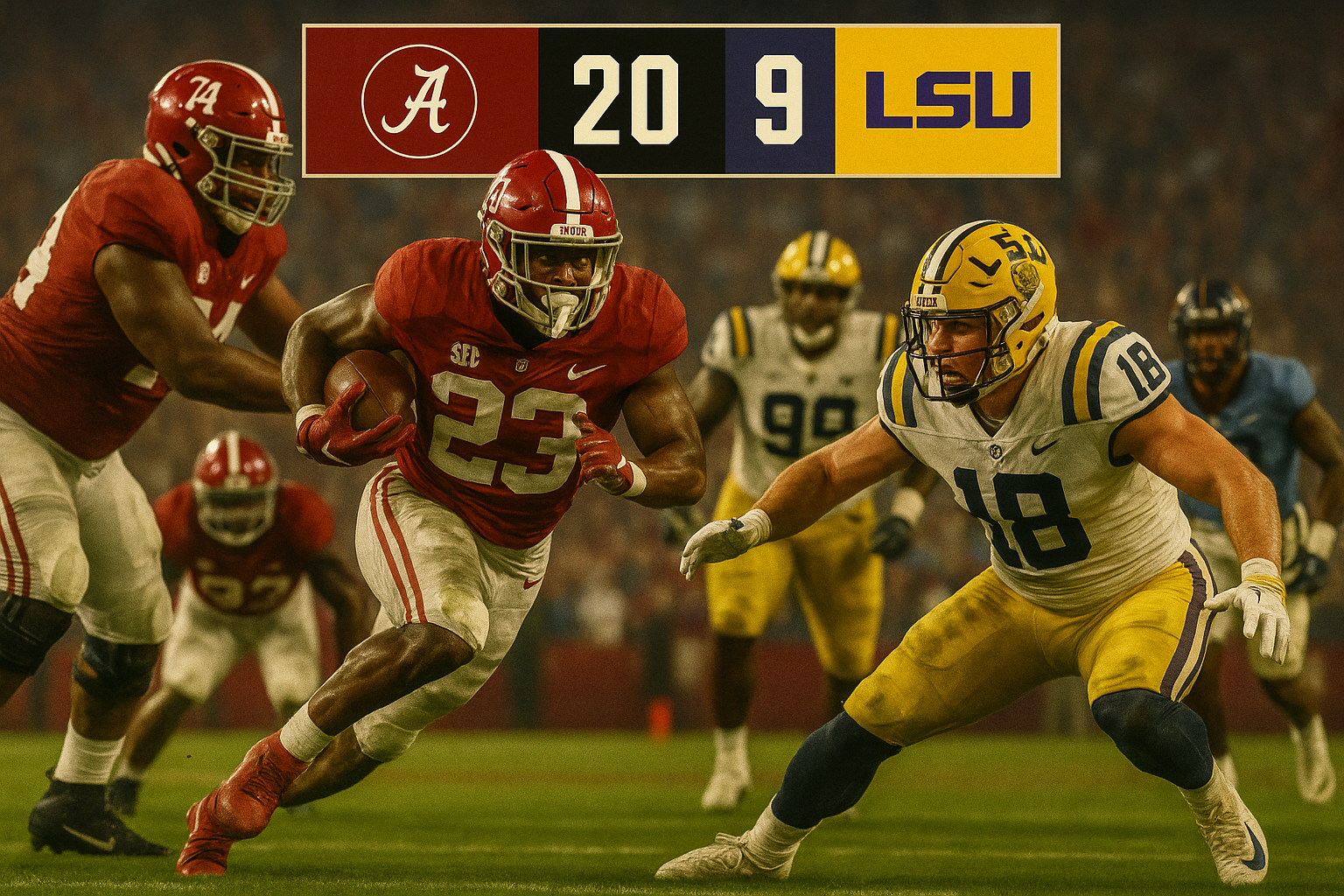
Crimson Tide Stay Perfect in SEC Play as Defense Dominates Under the Lights in Tuscaloosa TUSCALOOSA, Ala. — The No. 4 Alabama Crimson Tide leaned on a suffocating defensive performance and timely offensive strikes to defeat LSU 20–9 on Saturday night inside a packed Bryant-Denny Stadium. The victory marked Alabama’s eighth consecutive win and extended its home winning streak to 17 games , the longest active run in the nation. The Crimson Tide improved to 8–1 overall and 6–0 in SEC play , maintaining their path toward the SEC Championship Game and a potential College Football Playoff berth. LSU, meanwhile, dropped to 5–4 (2–4 SEC) and has now lost four of its last five, struggling to regain consistency amid midseason coaching changes. Tide Defense Steals the Show Alabama’s defense delivered its most dominant showing of the season, holding LSU without a touchdown for the first time since the 2012 national championship. The Tigers managed just 232 total yards and 13 first downs , repeatedly stalling inside the red zone and settling for three field goals. Linebacker Deontae Lawson led all defenders with nine tackles , while Yhonzae Pierre wreaked havoc in the backfield with two sacks and a forced fumble . LT Overton added another sack, and Bray Hubbard contributed five tackles, a pass breakup, and a forced fumble as Alabama’s front seven dictated the tempo throughout the game. The Tide’s defensive dominance was most apparent on third down, limiting LSU to a 3-of-13 conversion rate . Each time the Tigers crossed midfield, Alabama’s coverage tightened, forcing field goals rather than conceding touchdowns. Simpson’s Efficiency Leads the Offense Quarterback Ty Simpson turned in a steady performance, completing 21 of 35 passes for 277 yards and one touchdown . While the Crimson Tide offense wasn’t flashy, it was opportunistic — capitalizing on key LSU mistakes and converting turnovers into points. Simpson’s top targets were Germie Bernard , who hauled in three passes for 79 yards, and Lotzeir Brooks , who notched a career-best 67 yards on four receptions. Brooks’ highlight came late in the second quarter when he reeled in a 53-yard pass to set up Alabama’s only passing touchdown — a 14-yard strike to Ryan Williams just before halftime. Running back Daniel Hill provided balance on the ground, scoring from four yards out in the second quarter to give Alabama a 10–3 lead. Though the Tide managed just 56 rushing yards, their timely execution in short-yardage situations proved pivotal. First Half: Alabama Finds Its Rhythm The game began as a defensive battle. LSU’s first possession ended with a missed 30-yard field goal after a 10-play drive, and Alabama’s opening series also came up empty on a fourth-down stop near midfield. The Tide eventually broke through late in the first quarter when Connor Talty converted a 45-yard field goal following a fumble forced by Nikhai Hill-Green . LSU answered midway through the second quarter with a 37-yard kick by Damian Ramos , tying the game 3–3 after a balanced drive led by freshman running back Harlem Berry . From that point, Alabama’s offense took control. Hill’s four-yard touchdown run capped a seven-play, 75-yard march, giving the Tide a 10–3 advantage. Moments before halftime, Simpson’s precision passing set up a quick-strike touchdown as Alabama extended its lead to 17–3 . At the break, the Crimson Tide had outgained LSU 244–131 and controlled time of possession, while the Tigers struggled to convert opportunities inside Alabama territory. LSU’s Missed Chances The Tigers’ inability to finish drives proved costly. Quarterback Garrett Nussmeier completed 18 of 21 passes for 121 yards but failed to generate explosive plays against Alabama’s disciplined secondary. LSU moved the ball effectively between the 20s but faltered under pressure, settling for field goals instead of touchdowns. When Nussmeier was replaced by sophomore Michael Van Buren in the third quarter, the Tigers briefly found momentum after a forced fumble by Harold Perkins Jr. set them up deep in Alabama territory. However, a false start and a sack derailed the drive, forcing another field goal to make it 17–9. Penalties further hindered LSU’s rhythm. The Tigers committed 10 infractions , including multiple false starts and unnecessary roughness calls that nullified key gains. Their offensive inefficiency, combined with Alabama’s relentless front, kept them chasing the game. Fourth Quarter: Tide Closes the Door Clinging to an eight-point lead early in the fourth quarter, Alabama’s defense made another crucial stand inside its own 30-yard line. The Tide forced a third straight LSU field goal attempt, preserving their two-score margin. Later, with just over four minutes remaining, Talty drilled a 44-yard field goal — his second of the night — to extend the lead to 20–9 . That kick effectively sealed the victory, as LSU’s final possessions ended in punts and incompletions under Alabama’s constant pressure. The Tide finished with 344 total yards , including four plays of 30 yards or more — a stark contrast to LSU’s conservative approach that yielded no completions longer than 20 yards. Statistical Notes and Milestones The win pushed head coach Kalen DeBoer’s November record to 36–3 , including a 12–1 mark since 2022 , continuing his reputation for late-season dominance. Alabama also remained undefeated at home under DeBoer (12–0) and extended its streak to 87 consecutive home wins against unranked opponents , dating back to 2007. Yhonzae Pierre’s two sacks gave him a team-leading total of six for the year, while Lotzeir Brooks’ 53-yard reception was the longest of his career. Freshman kicker Connor Talty improved to 9-for-11 on field goals this season, including perfect accuracy from 40–49 yards. Despite managing just 2.3 yards per carry, Alabama’s defense held LSU to an identical 2.3 yards per rush , limiting the Tigers to 59 rushing yards on 26 attempts — their second-lowest output of the season. What’s Next The Crimson Tide will remain home next week to host No. 11 Oklahoma , a matchup that could further shape the College Football Playoff landscape. Kickoff is set for 2:30 p.m. CT on ABC . LSU will return to Baton Rouge to face Arkansas , hoping to rebound and secure bowl eligibility as their regular season enters its final stretch. Final Takeaway Alabama’s 20–9 victory over LSU was not an offensive spectacle, but rather a statement of discipline and defensive control . The Crimson Tide demonstrated the patience and precision required to sustain championship-level success. For LSU, the game underscored ongoing offensive struggles — stalled drives, costly penalties, and missed opportunities. Meanwhile, Alabama’s consistency and attention to detail once again separated them from their conference rivals, solidifying their position among the nation’s elite.

Wolverines Survive Turnovers and Late Surge to Earn Seventh Straight Win Over Boilermakers ANN ARBOR, Mich. — The No. 21 Michigan Wolverines relied on the power and precision of their running game to outlast a gritty Purdue team, 21–16 , on Saturday night at Michigan Stadium. Sophomore running back Jordan Marshall carried the Wolverines with a career-high 185 rushing yards and three touchdowns , helping his team overcome offensive miscues and a persistent Boilermaker rally. The win improved Michigan to 7–2 overall and 5–1 in the Big Ten , maintaining their position in the conference race despite an uneven offensive showing. Purdue dropped to 2–7 (0–6 Big Ten) yet delivered one of its most complete efforts of the season against a ranked opponent. Marshall Leads Michigan’s Ground Game Marshall’s breakout performance proved decisive. Filling in for the injured Justice Haynes , the sophomore dominated from the start, scoring all three of Michigan’s touchdowns and surpassing 100 rushing yards for the third consecutive game. His first touchdown came midway through the opening quarter on a 54-yard sprint up the middle following a short screen pass that had already netted 25 yards on the drive. The burst showcased both his vision and top-end speed, giving Michigan a 7–0 lead. It marked his third touchdown run of 50 or more yards this season. Marshall’s second touchdown came with just 17 seconds remaining in the first half — a three-yard plunge that broke a 7–7 tie and sent Michigan to the locker room ahead 14–7. His third, a nine-yard run early in the fourth quarter, proved to be the decisive score, pushing Michigan’s lead to 21–10 before Purdue closed the gap late. In total, Michigan rushed for 253 yards , surpassing its season average of 220 per game. The Wolverines finished with 398 total yards , relying heavily on the ground attack as freshman quarterback Bryce Underwood continued to search for consistency in the passing game. Purdue’s Balanced Attack Keeps Game Tight Despite entering the matchup winless in conference play, Purdue showed poise and discipline. Quarterback Ryan Browne completed 19 of 24 passes for 133 yards and one touchdown , while the running game — led by Malachi Thomas and Antonio Harris — helped control time of possession for much of the night. Thomas carried the ball 15 times for 68 yards and added a receiving touchdown, his second in as many games. Harris provided a spark from the wildcat formation, capping a 16-play, 75-yard drive with a two-yard rushing score that tied the game at 7–7 midway through the second quarter. That drive, which lasted nine and a half minutes, was Purdue’s longest scoring sequence in three seasons and demonstrated its ability to sustain offensive rhythm against an elite defense. The Boilermakers trailed just 14–7 at halftime but cut into the deficit early in the third quarter when Spencer Porath drilled a career-long 50-yard field goal , trimming the lead to four. Purdue continued to threaten throughout the second half, capitalizing on Michigan mistakes and forcing pressure situations. Defensive Resilience Defines the Game Michigan’s defense, though tested, made key stops in crucial moments. Linebackers Ernest Hausmann and Troy Bowles filled the void left by injured starters, combining for 17 tackles. Hausmann led the team with 11 stops, including one tackle for loss, while Bowles added a career-best six tackles. Defensive end Derrick Moore was instrumental early, posting two first-half sacks — one that pushed Purdue out of field goal range and another that forced a fumble recovered by Rayshaun Benny . Those plays halted promising Boilermaker drives and allowed Michigan to maintain its narrow halftime edge. Purdue’s defense was equally resilient. Safety Hudauri Hines intercepted Underwood in the red zone late in the first half — the first of his collegiate career — preventing Michigan from extending its lead. Linebacker Tahj Ra-El recorded 13 tackles, his third double-digit performance this season, while Mani Powell anchored the pass rush with 1.5 sacks. In the third quarter, Purdue appeared poised to shift momentum entirely. After forcing a fumble by Underwood near the goal line, the ball rolled through the end zone for a touchback — Michigan’s second red-zone turnover of the game. However, the Wolverines’ defense held firm, forcing punts and protecting the slim advantage. Key Moments and Turning Points The game’s turning point came early in the fourth quarter when Marshall capped a methodical Michigan drive with his third touchdown, giving the Wolverines a 21–10 lead. Purdue responded six minutes later, as Browne connected with Thomas on a five-yard touchdown pass to make it 21–16, but the Boilermakers’ two-point conversion attempt failed. From there, Michigan’s offense shifted into clock-control mode. The Wolverines’ final drive chewed up more than four minutes and advanced inside Purdue’s 10-yard line before kneeling to seal the victory. Despite Michigan’s mistakes — two red-zone turnovers and inconsistent passing — its ground dominance and timely defensive stops made the difference. Purdue, meanwhile, executed efficiently between the 20s but struggled to finish drives, a recurring issue throughout its season. Underwood’s Learning Curve Continues Underwood , the nation’s top-ranked recruit in the 2024 class, showed flashes of talent but also growing pains. He completed 13 of 22 passes for 145 yards and rushed seven times for 44 yards, including several chain-moving scrambles. However, his red-zone fumble and interception underscored the need for greater consistency and composure against high-pressure defenses. Michigan head coach Sherrone Moore and offensive coordinator Kirk Campbell continued to rely on the run-first approach that has defined the team’s identity all season. With Haynes sidelined and Underwood still developing, the Wolverines leaned heavily on Marshall’s physicality and big-play ability — a formula that proved effective once again Saturday night. By the Numbers Michigan held Purdue to 276 total yards , the Boilermakers’ third-lowest output of the season, and forced two turnovers. The Wolverines’ defense has now held five opponents under 20 points this year, reaffirming its reputation as one of the Big Ten’s most disciplined units. Purdue actually controlled time of possession for much of the night, owning the ball for more than 32 minutes — a testament to its short passing game and third-down efficiency. Yet, Michigan’s explosive rushing plays repeatedly shifted momentum. The Wolverines have now won seven straight games against Purdue , extending a streak that dates back to 2011. Saturday’s victory also marked Michigan’s fifth game this season holding an opponent under 20 points, highlighting its defensive consistency even in close contests. Looking Ahead Michigan enters its bye week before facing Northwestern at Wrigley Field on November 15 . With two conference games remaining, the Wolverines remain within striking distance of a Big Ten Championship berth. Purdue returns home to Ross-Ade Stadium to host top-ranked Ohio State . Despite the loss, the Boilermakers’ determined effort against a ranked opponent could serve as a building block for head coach Barry Odom’s first-year program. Final Takeaway Michigan’s 21–16 win over Purdue showcased both the team’s strength and vulnerability. Behind Jordan Marshall’s career-best performance and a defense that tightened when it mattered, the Wolverines survived a dangerous opponent and kept their postseason hopes intact. For Purdue, the night offered frustration and validation in equal measure — a reminder that progress is often measured in performance, not just wins. Against one of the nation’s top programs, the Boilermakers proved they could compete — just not quite finish.
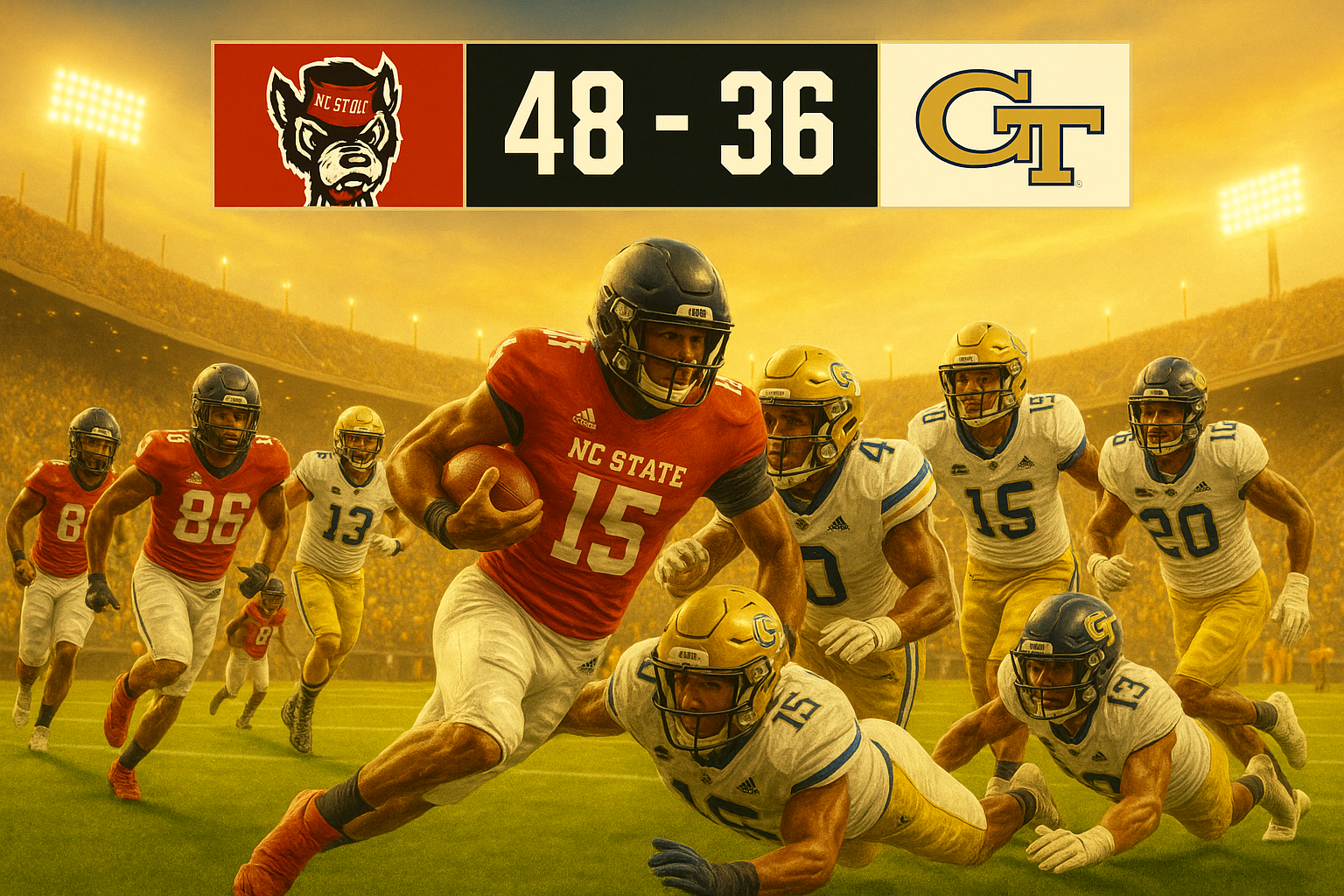
Wolfpack’s Balanced Attack Snaps Jackets’ Unbeaten Season RALEIGH, N.C. — A raucous Carter-Finley Stadium crowd witnessed one of the most electrifying performances of the season as NC State stunned No. 8 Georgia Tech, 48–36 , on Saturday night. Behind 583 total yards of offense, the Wolfpack ended the Yellow Jackets’ unbeaten run and dashed their hopes of a perfect season. For Georgia Tech, it was a night of historic individual performances overshadowed by missed opportunities. Quarterback Haynes King set a school record with 511 yards of total offense — 408 passing and 103 rushing — but red-zone struggles and defensive lapses cost the Jackets their first loss of the year. Explosive Start for Both Offenses From the opening drive, it was clear neither defense would control the tempo. NC State struck first when Cody Hardy hauled in a five-yard touchdown pass to cap a methodical 75-yard drive. Georgia Tech responded immediately, as King scrambled 12 yards into the end zone to tie the game 7–7. The Wolfpack kept the pressure on when quarterback C.J. Bailey capped an 11-play drive with an 11-yard touchdown run, his fourth of the season. Georgia Tech then seized its only lead of the night midway through the second quarter, as King found tight end J.T. Byrne on a short two-yard pass and kicker Aidan Birr added a 43-yard field goal, putting the Jackets ahead 17–14. That advantage, however, was fleeting. On the ensuing possession, NC State running back Will Wilson appeared to fumble near the goal line, but Hardy recovered the loose ball in the end zone for his second touchdown. The Wolfpack then added a 34-yard field goal from Kanoah Vinesett just before halftime to take a 24–17 lead into the break. Third Quarter: Wolfpack Take Control Georgia Tech opened the second half determined to swing momentum. King drove the Jackets to the NC State one-yard line, but the offense stalled. Three consecutive short runs netted little, and a false start on fourth down forced another short field goal instead of a potential touchdown. That miscue proved costly. On the next snap, freshman running back Duke Scott broke free for a 69-yard run , the longest of his career, setting up Wilson’s one-yard touchdown plunge to extend the Wolfpack’s lead to 31–20. King and the Jackets again moved into scoring range on their following drive, this time connecting on a 68-yard strike that set up another red-zone chance. But once again, the drive ended with a field goal rather than six points. The difference in red-zone efficiency began to separate the teams — Georgia Tech repeatedly settling for three while NC State continued to punch the ball into the end zone. The Wolfpack offense kept rolling. On a third-and-six play, Bailey hit Teddy Hoffmann for a 55-yard touchdown , widening the margin to 38–26. Though King answered with a three-yard touchdown run to bring Tech within eight, NC State’s offense would not be denied. Fourth Quarter: Scott Seals the Upset With momentum still up for grabs entering the final period, Scott delivered the dagger. The redshirt freshman found a crease on the left side and sprinted 30 yards untouched for a touchdown that pushed the Wolfpack lead to 45–30. Georgia Tech managed one final scoring drive, capped by King’s 16-yard touchdown pass to Zion Taylor , but a failed two-point conversion left the Jackets trailing by 12. Any hopes of a comeback ended when Caden Fordham intercepted King’s deep pass into the end zone on the game’s final play, sparking a jubilant on-field celebration at Carter-Finley Stadium. The Wolfpack improved to 5–4 overall and 2–3 in ACC play , notching their first win over a top-10 opponent since 2021 and their highest-ranked victory since beating No. 3 Florida State in 2012. Record-Setting Night for Haynes King Despite the loss, King delivered one of the greatest performances in Georgia Tech history. His 511 total yards shattered the program’s previous record of 477, set by George Godsey in 2001. King’s 408 passing yards were the fourth-most ever by a Yellow Jacket, and he became the school’s all-time leader in touchdowns responsible for, surpassing Joe Hamilton’s mark of 83 with 85 career scores . King’s four touchdowns — two passing, two rushing — highlighted his dual-threat ability, but they couldn’t offset Tech’s inability to finish drives. The Jackets punted just once all evening yet came away empty on several promising possessions, a rare inefficiency for an offense that had averaged over 36 points per game entering the contest. Freshman wide receiver Jordan Allen caught five passes for a career-high 110 yards , while Eric Rivers added 97 yards. Byrne’s second-quarter touchdown reception was the first of his collegiate career. Tight end Brett Seither also posted a career-best 73 yards , showcasing the depth of Tech’s passing attack. NC State’s Offensive Surge Bailey directed NC State’s offense with remarkable poise, completing 24 of 32 passes for 340 yards and two touchdowns . He also ran for a score, accounting for three total touchdowns on the night. Scott was the difference-maker, rushing for 196 yards on 24 carries , the most by a Wolfpack player since Nyheim Hines accomplished the feat in 2017. His combination of vision and acceleration repeatedly gashed a Georgia Tech defense that entered the game ranked among the top in the nation against the run. Wilson added two touchdowns, and Hardy finished with a career-high two scores, giving the Wolfpack a multi-dimensional attack that kept the Jackets off balance throughout. NC State’s offense converted 7 of 11 third downs and was a perfect 6-for-6 in red-zone opportunities , a level of execution that ultimately determined the outcome. Defensive Adjustments and Key Plays While both defenses surrendered big plays, NC State’s timely stops proved decisive. The Wolfpack’s red-zone stands — including two drives held to field goals and one ending in a missed 54-yard attempt — kept Georgia Tech chasing the scoreboard all night. Fordham led the defense with 15 tackles , a half-sack, and the game-clinching interception, while Kenny Soars Jr. added 14 tackles , marking back-to-back career highs for the duo. Their pressure and tackling in space prevented King from extending drives with his legs as often as he had in previous games. For Georgia Tech, linebacker Kyle Efford led with 10 tackles , and safety Ahmari Harvey contributed eight. However, the defense struggled to contain Scott’s bursts and Bailey’s composure on third down. The Jackets allowed their most yards in two seasons — 589 — and more than 24 points in regulation for the first time in 2025. What the Loss Means The defeat snapped Georgia Tech’s eight-game winning streak , its longest since 2009, and dropped the Jackets to 8–1 overall and 5–1 in ACC play . They now sit just behind Virginia in the conference standings but remain in strong position to reach the ACC Championship Game. The Wolfpack, meanwhile, improved to 4–4 all-time under head coach Dave Doeren against top-10 opponents and gained momentum heading into their bye week before facing No. 10 Miami on November 15 . Final Takeaway Saturday night’s thriller in Raleigh delivered a reminder of how quickly the landscape in the ACC can shift. Georgia Tech’s offensive fireworks weren’t enough to overcome red-zone inefficiency and defensive fatigue, while NC State’s balanced, opportunistic performance showcased its resilience and depth. For the Wolfpack, it was a season-defining win. For the Yellow Jackets, it was a humbling first loss — one that underscored how thin the margin for error can be at the top of college football.
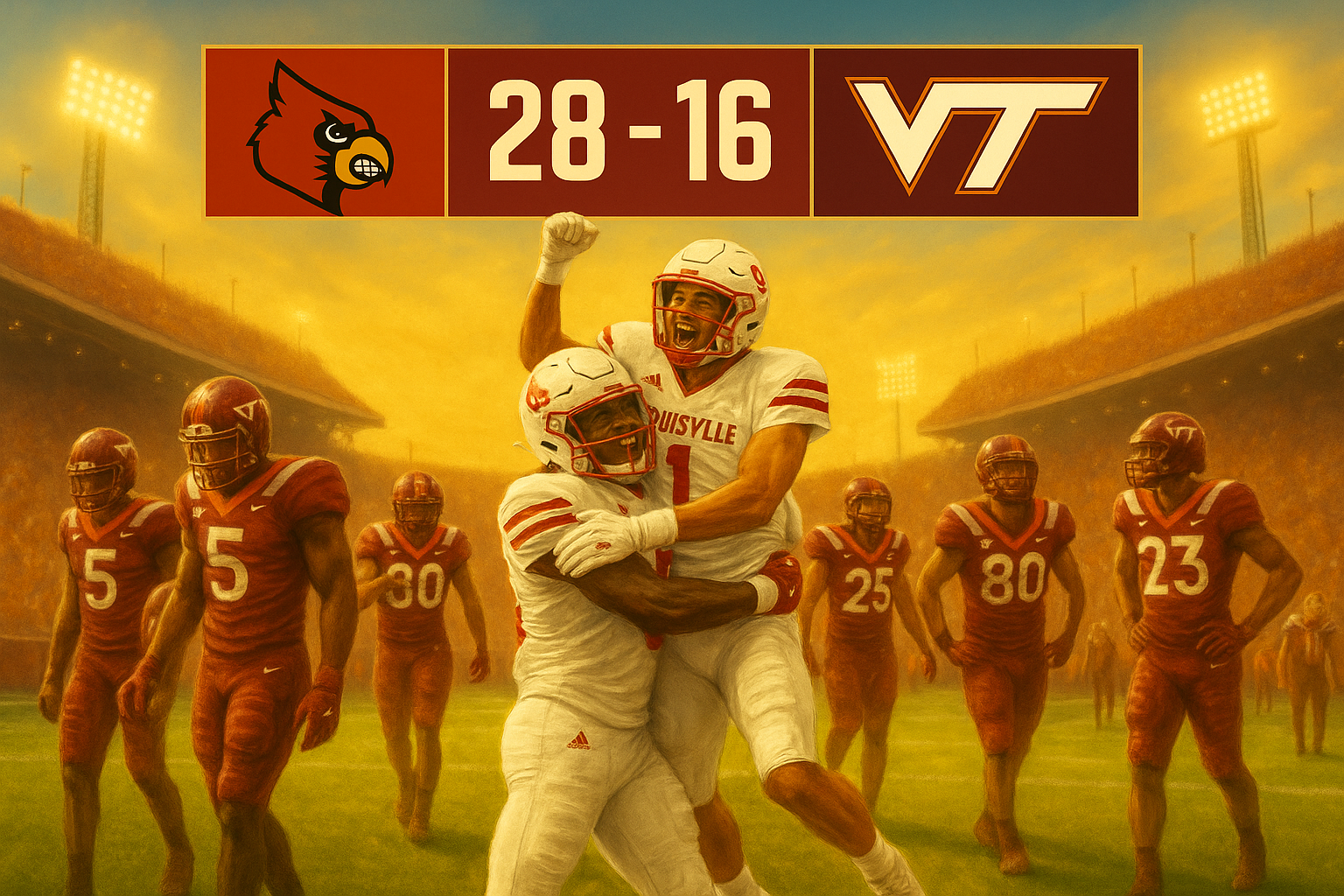
Cardinals Rally Behind Balanced Offense to Stay in ACC Title Contention BLACKSBURG, Va. — The No. 16 Louisville Cardinals overcame a sluggish first half and stormed back to defeat Virginia Tech 28–16 on Saturday at Lane Stadium. Trailing by nine points at halftime, the Cardinals erupted for 21 unanswered points in the second half to secure their seventh victory of the season and stay within striking distance in the ACC race. Louisville improved to 7–1 overall and 4–1 in the ACC , while the Hokies fell to 3–6 (2–3 ACC) as their offense faltered down the stretch. First Half: Hokies Build Momentum The game began with early fireworks as Louisville struck first. On the second play from scrimmage, running back Isaac Brown broke through the middle for a 52-yard touchdown run, giving the Cardinals an early 7–0 lead. Virginia Tech responded immediately. Quarterback Kyron Drones guided the Hokies on a nine-play, 37-yard drive capped by his own three-yard rushing touchdown to tie the score at 7–7. On the ensuing possession, Virginia Tech’s special teams created a game-changing moment when P.J. Prioleau broke through to block a Louisville punt out of the end zone, resulting in a safety that put the Hokies ahead 9–7. Midway through the second quarter, Drones connected with Cameron Seldon on a five-yard touchdown pass to stretch Virginia Tech’s advantage to 16–7. It was Seldon’s second receiving touchdown of the season and marked one of the Hokies’ most complete offensive drives of the year. Louisville’s offense, which had moved the ball well early, sputtered as the first half continued. Quarterback Miller Moss was limited to 62 passing yards in the opening two quarters, and the Cardinals’ receivers struggled to find separation against a disciplined Virginia Tech secondary. The Hokies’ defense fed off the crowd energy, keeping Louisville scoreless after the opening drive and forcing three punts. At halftime, Virginia Tech appeared in control, having outgained the Cardinals 164–124 and built a nine-point lead. But the second half would tell a completely different story. Third Quarter: Cardinals Storm Back Louisville came out of the locker room with renewed energy and urgency. The adjustments were immediate and effective. On their first drive of the second half, Moss completed four passes on a six-play, 53-yard march, finishing with a 24-yard strike to Caullin Lacy to cut the Hokies’ lead to 16–14. Momentum quickly swung in the Cardinals’ favor. Louisville’s defense forced a three-and-out on Virginia Tech’s next possession, and Lacy once again made his presence felt — this time on special teams. His 63-yard punt return gave the Cardinals prime field position at the Virginia Tech five-yard line. Two plays later, running back Keyjuan Brown powered into the end zone from two yards out to give Louisville its first lead of the afternoon at 21–16. The Cardinals’ defense, which struggled with Virginia Tech’s RPO schemes in the first half, tightened up significantly after the break. They held the Hokies to just 23 total yards in the third quarter and forced three consecutive punts. Linebacker T.J. Quinn anchored the defensive effort with 10 tackles, helping contain Drones’ mobility and shutting down the interior run game. Fourth Quarter: Brown Seals the Win As the fourth quarter began, Louisville maintained full control. Their offensive line, bolstered by the return of Trevonte Sylvester , continued to open running lanes for Brown, who began to wear down Virginia Tech’s defense. With just under six minutes remaining, Brown capped another efficient drive by breaking free for a 24-yard touchdown run , extending the Cardinals’ lead to 28–16. The scoring play marked Brown’s second touchdown of the day and his fifth of the season. Virginia Tech tried to rally but found little success. Drones faced consistent pressure from Louisville’s front seven, including Wesley Bailey and Rene Konga , who combined for multiple quarterback hurries. The Hokies’ final three drives ended in two punts and a turnover on downs as the Cardinals completed their comeback with authority. Louisville outgained Virginia Tech 248–72 in the second half and held the Hokies scoreless after halftime — a testament to the adjustments made by both coordinators. Balanced Offensive Attack Leads the Way Despite a sluggish start, Louisville’s offense found its rhythm behind the steady play of Moss and the explosive running back tandem of Isaac Brown and Keyjuan Brown . The pair combined for 220 rushing yards and three touchdowns , marking the second straight week the duo surpassed 200 total yards. Moss, though limited to 136 passing yards, managed the game effectively, finishing 19-of-28 with one touchdown and one interception . Lacy emerged as the offensive catalyst, contributing a touchdown reception, a 63-yard punt return, and several key receptions in the second half. The Cardinals’ offensive line played a pivotal role in the turnaround. After struggling early against Virginia Tech’s blitz packages, the unit found its footing, allowing Moss more time in the pocket and creating consistent push up front. Defensive Adjustment Defines the Outcome Louisville’s defensive transformation after halftime was the story of the game. The Cardinals completely neutralized the Hokies’ rushing attack, which had been their primary weapon early. After allowing 121 rushing yards in the first half, Louisville held Virginia Tech to just 43 after the break. The defensive front, led by Quinn and T.J. Capers , consistently won battles at the line of scrimmage, closing running lanes and forcing Drones to throw under pressure. The secondary, while occasionally vulnerable in the first half, tightened its coverage and benefited from several key overthrows by Drones, who finished 11-of-23 for 76 yards and one touchdown . The Hokies’ offensive execution, so sharp in the first two quarters, unraveled completely as Louisville dictated tempo and field position. Special Teams Impact Special teams proved decisive in shifting momentum. While the Hokies benefited early from a blocked punt and safety, the Cardinals’ own special teams made the game’s turning-point play with Lacy’s punt return in the third quarter. The return directly set up Louisville’s go-ahead touchdown and flipped control of the contest. Kicker Brock Travelstead converted all four extra points, and punter David Chapeau recovered from a shaky first half to average 45 yards per punt in the second. The Bigger Picture For Louisville, the comeback win reflected both resilience and championship potential. Despite another slow start — an issue that has surfaced multiple times this season — the Cardinals once again found ways to win behind second-half dominance. The victory kept them firmly in contention for a return to the ACC Championship Game , with upcoming matchups against Cal and Duke on the horizon. Virginia Tech, meanwhile, will use its open week to regroup before traveling to Florida State on November 15 . The Hokies’ defense showed flashes of improvement, but the lack of offensive consistency continues to plague their season. Final Takeaway Louisville’s 28–16 win over Virginia Tech showcased the Cardinals’ depth, adaptability, and growing confidence. Behind the dual-threat backfield of Isaac and Keyjuan Brown and a defense that clamped down when it mattered most, the Cardinals proved once again that they can overcome adversity and win on the road. For Virginia Tech, the loss was another example of a promising start undone by missed opportunities. Despite forcing turnovers and building an early lead, the Hokies’ inability to sustain drives in the second half allowed Louisville to control the game’s final 30 minutes. As the Cardinals celebrate another ACC road win, their focus now turns to maintaining momentum — and correcting slow starts — as they continue their pursuit of a conference title.
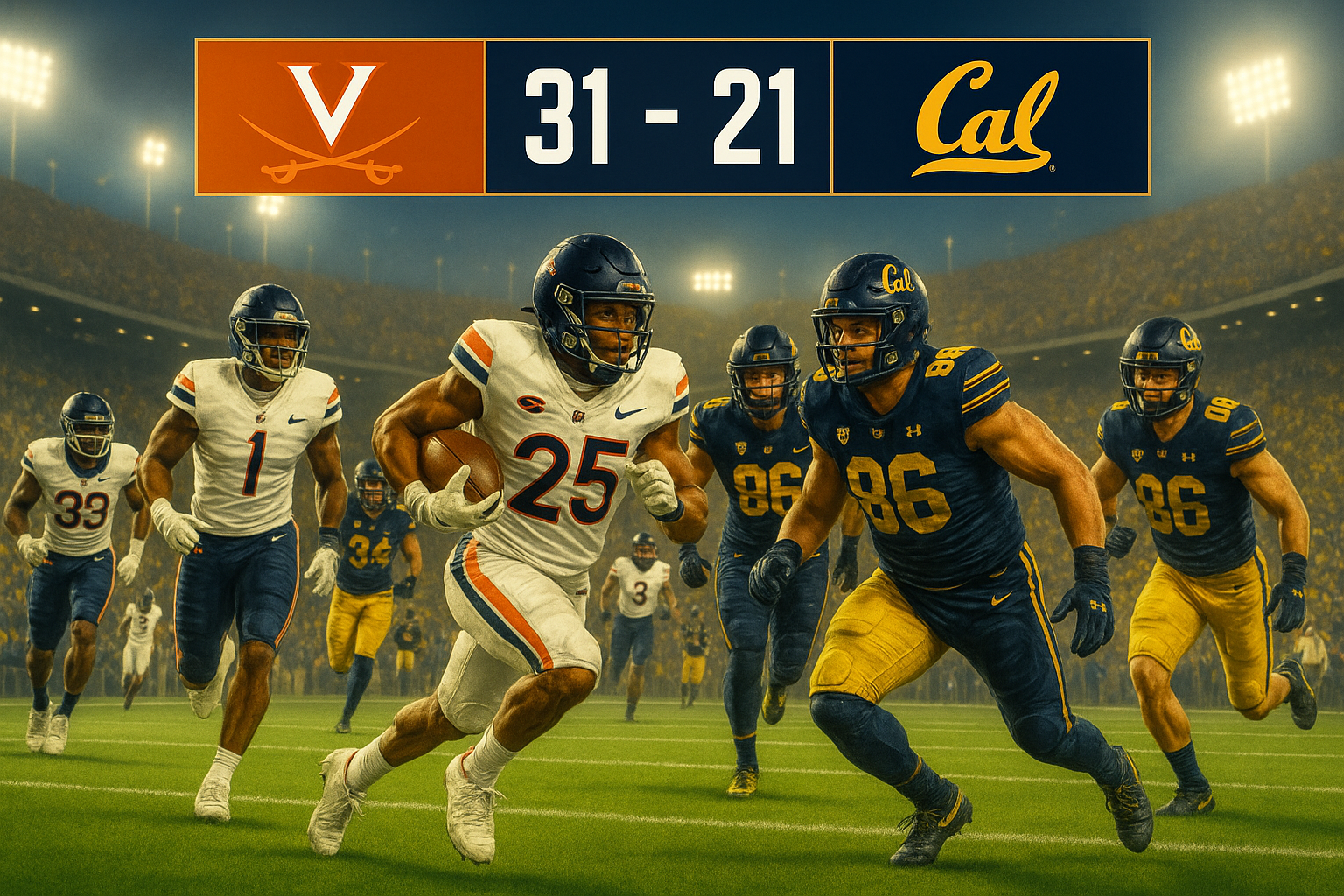
Robinson’s Late Pick-Six Seals Cavaliers’ First Road Win on the West Coast BERKELEY, Calif. — No. 15 Virginia extended its winning streak to seven straight games and improved to 8–1 overall (5–0 ACC) with a hard-fought 31–21 victory over California on Saturday at California Memorial Stadium. The Cavaliers never trailed in the contest, but it took a late defensive touchdown from linebacker Kam Robinson to finally put the game away and preserve Virginia’s best start to a season since 1990. For California (5–4, 2–3 ACC), the loss marked a missed opportunity to notch its first win over a ranked opponent in five years. Running back Kendrick Raphael accounted for all three of the Bears’ touchdowns, including a highlight-reel trick-play reception, but Virginia’s balance and resilience proved too much down the stretch. First Quarter: Taylor’s Early Touchdowns Set the Tone Virginia opened the game with an explosive first drive. Quarterback Chandler Morris led a quick, efficient series that culminated in a short rushing touchdown by J’Mari Taylor , giving the Cavaliers a 7–0 lead before many fans had settled into their seats. After forcing a three-and-out on California’s first possession, the Cavaliers struck again. A 29-yard run by Taylor set up another short-yardage score, his second touchdown of the quarter, to extend the lead to 14–0. California eventually responded with a 10-play drive that ended in a two-yard touchdown run from Raphael, cutting the deficit to 14–7 early in the second quarter. The Golden Bears’ offensive line began finding rhythm at the line of scrimmage, but Virginia’s front seven remained aggressive, forcing quick throws and limiting chunk plays. Second Quarter: Defenses Trade Stops Midway through the second quarter, both defenses tightened up. Virginia’s offense moved methodically but failed to capitalize on a red-zone opportunity when a 48-yard field goal attempt sailed wide as time expired in the half. California’s defense, anchored by Aaron Hampton and Aidan Keanaaina , repeatedly disrupted the Cavaliers’ rhythm on third downs. Despite those efforts, the Bears trailed 14–7 at halftime as Virginia’s offensive efficiency — and Taylor’s early scoring — kept them in front. Third Quarter: Trick Play Sparks Cal Comeback The second half opened with renewed energy from California. Midway through the third quarter, head coach Justin Wilcox’s squad dug into its playbook and executed its best sequence of the day. Quarterback Jaron-Keawe Sagapolutele tossed a lateral to tight end Mason Mini , who then fired a deep pass to a wide-open Raphael streaking downfield. The 42-yard touchdown completion stunned the Virginia defense and cut the Cavaliers’ lead to 17–14. Virginia responded immediately, demonstrating the composure of a battle-tested team. Morris led a 75-yard drive capped by a three-yard touchdown run from wide receiver Eli Wood , who powered through defenders to stretch the ball across the goal line. The score pushed the Cavaliers ahead 24–14, restoring a sense of control late in the quarter. Still, California refused to fade. After a shanked punt set them up deep in Virginia territory, Raphael punched in another short touchdown run to make it 24–21 early in the fourth quarter. The Memorial Stadium crowd roared to life as the Bears closed within a field goal of one of the ACC’s top teams. Fourth Quarter: Virginia’s Defense Closes the Door With the game tightening, Virginia’s defense delivered when it mattered most. Defensive coordinator John Rudzinski’s unit, which had been inconsistent through much of the third quarter, locked in down the stretch. The Cavaliers held California to just 39 total yards across their final three possessions, forcing two punts and a game-sealing interception. That decisive moment came with just 34 seconds remaining. Facing first down at their own 14-yard line, the Bears looked to mount a late drive, but Robinson anticipated Sagapolutele’s throw perfectly, intercepting the pass and sprinting 35 yards to the end zone. The pick-six — Robinson’s second of the season — secured Virginia’s 31–21 victory and tied a single-season school record for interception returns for touchdowns. The defensive touchdown also capped a milestone night for Virginia’s defense, which recorded four sacks and two interceptions , limiting the Bears to 263 total yards . Linebackers Robinson and Christian Charles each posted six tackles, while safety Devin Neal surpassed the 200-career-tackle mark with five stops. Offensive Consistency and Efficiency Virginia’s offense showed its best balance in weeks, posting 456 total yards and converting 10 third downs — the seventh time this season the team has recorded seven or more third-down conversions, the most among FBS programs in 2025. Morris was sharp throughout, completing 24 of 36 passes for 262 yards with no interceptions. His precision kept California’s defense guessing and allowed the Cavaliers to control the tempo. Taylor led the rushing attack with 105 yards and two touchdowns on 21 carries, marking his second 100-yard performance of the season and sixth of his career. Wide receivers Cam Ross and Trell Harris were steady, combining for 10 receptions and several key third-down conversions. Wood , whose first career rushing touchdown came on the lateral from Morris, also contributed a 38-yard reception that set up Virginia’s third-quarter score. Kicker Will Bettridge added seven points on the night, becoming the fourth-leading scorer in program history with 274 career points , passing Rafael Garcia (1993–96). Defensive Strength and Discipline While the offense handled time of possession, Virginia’s defense played with physicality and depth. The Cavaliers limited Cal’s top receiver Trond Grizzell to short gains and bottled up most of the passing game after halftime. Freshman defensive back Corey Costner recorded his first career interception late in the third quarter, breaking a streak of 10 quarters without a turnover by California. Defensive tackle Jacob Holmes tallied two tackles for loss, while edge rushers Mitchell Melton and Cazeem Moore each notched a sack in the win. The Cavaliers also maintained one of the nation’s best ball-security streaks, finishing their fifth turnover-free game of the season and extending their record as one of only three FBS programs yet to lose a fumble in 2025. California’s Key Performances For the Bears, Raphael continued his breakout season with three total touchdowns — two rushing and one receiving — bringing his season total to 11 scores. His versatility kept Cal competitive throughout, as he became the first Bear in over a decade to record back-to-back games with three touchdowns. Linebacker Aaron Hampton set a career high with 15 tackles , stepping up after starting linebacker Cade Uluave exited early due to injury. Defensive lineman Aidan Keanaaina added 10 stops, and defensive back Cam Sidney contributed nine tackles to round out a gritty performance for Cal’s defense. Despite the loss, the Bears showed flashes of resilience, particularly during their third-quarter rally. The defeat, however, marked their 14th straight loss to a ranked opponent since 2020 . Historical Context and What’s Next Virginia’s victory marked several significant milestones. The Cavaliers earned their first-ever win in the Pacific Time Zone and their first road win over a Power Five opponent outside the East Coast. The program’s seven-game winning streak is its longest since 2007, and its 8–1 start is the best since 1990 — the same year Virginia last climbed into the national top five. With the win, head coach Tony Elliott’s team remains unbeaten in ACC play for the first time in program history, sitting at 5–0 entering November . Virginia also became the first team in school history to win five consecutive ACC games in a single season. The Cavaliers will return home next Saturday to face Wake Forest under the lights at Scott Stadium. California, meanwhile, heads to Louisville for a crucial matchup as the Bears look to rebound and reach bowl eligibility. Final Takeaway Virginia’s 31–21 win over California was a showcase of balance, discipline, and composure. Behind J’Mari Taylor’s early touchdowns, Chandler Morris’s efficiency, and Kam Robinson’s game-sealing interception, the Cavaliers continued their climb toward ACC Championship contention. For California, it was another case of battling hard against elite competition but coming up just short. Raphael’s three-touchdown night and a resilient defense kept the Bears in it, but Virginia’s late execution underscored the difference between a contender and a challenger. As the Cavaliers head back east, they do so with history on their side — and momentum firmly intact.
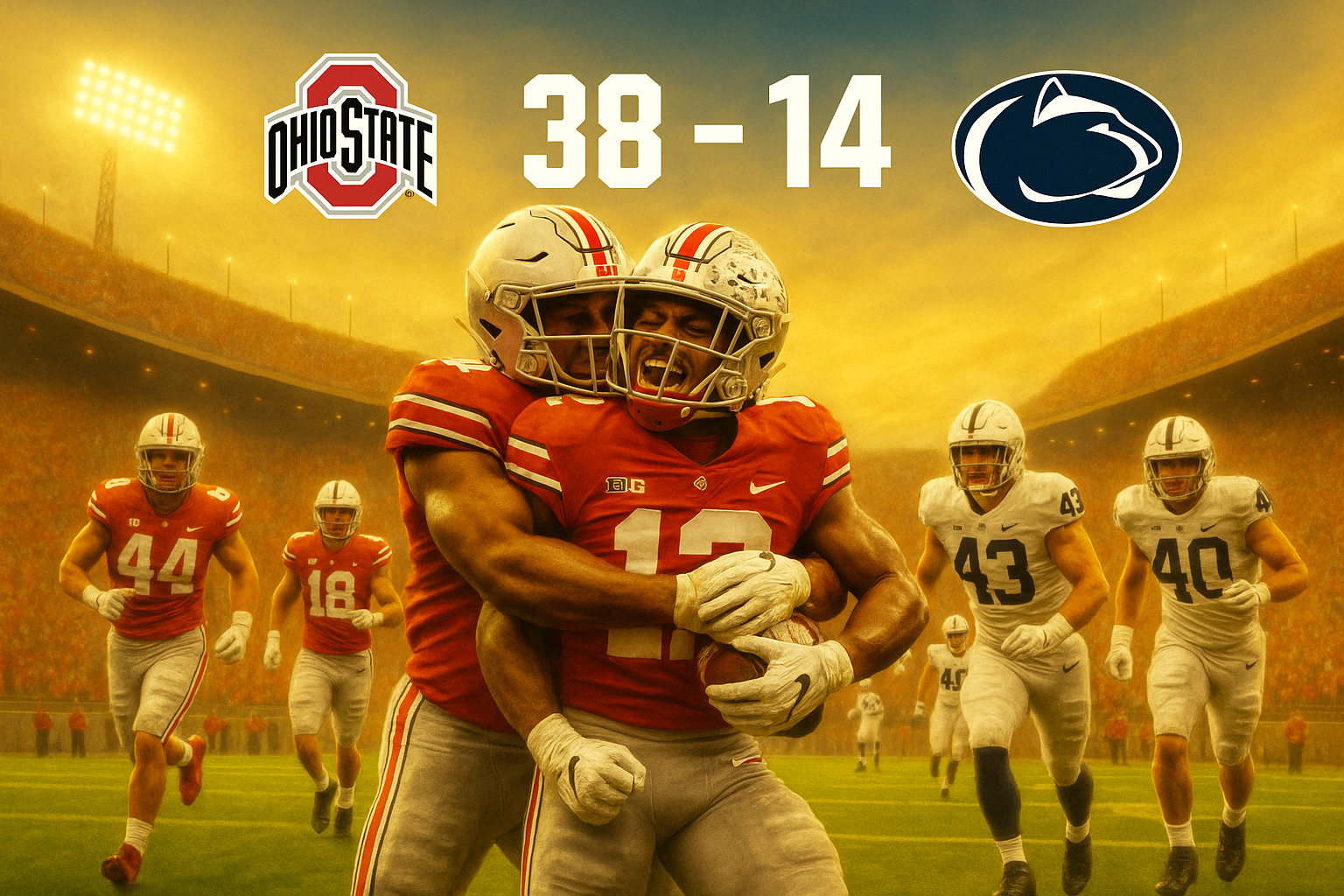
Julian Sayin Throws Four Touchdowns as Buckeyes Stay Perfect COLUMBUS, Ohio — In front of a packed crowd at Ohio Stadium, top-ranked Ohio State continued its undefeated season with a commanding 38–14 victory over Penn State on Saturday afternoon. Quarterback Julian Sayin delivered another near-flawless performance, throwing for 316 yards and four touchdowns , while the Buckeye defense overwhelmed the Nittany Lions in the second half to secure their eighth straight win of the season. With the victory, Ohio State improved to 8–0 overall and 5–0 in the Big Ten , maintaining firm control of the conference race. Penn State fell to 3–5 (0–5 Big Ten) , extending its losing streak to five games. Buckeyes Establish Early Rhythm The Buckeyes wasted no time setting the tone. After deferring the opening kickoff, Ohio State’s defense forced a punt, and Sayin engineered an 89-yard opening drive capped by a 14-yard touchdown to Jeremiah Smith , giving the home team a quick 7–0 lead. On their next series, the Buckeyes marched 71 yards on 12 plays before Jayden Fielding connected on a 22-yard field goal to make it 10–0 early in the second quarter. Penn State responded with a sustained 15-play drive of its own, converting multiple third downs before Nicholas Singleton scored from two yards out, trimming the deficit to 10–7. Ohio State answered almost immediately. Sayin connected with Carnell Tate on a perfectly timed deep pass down the middle for a 45-yard touchdown, restoring a 10-point cushion at 17–7 with just over two minutes left in the half. However, Penn State capitalized on a fumble by the Buckeyes moments later. Defensive end Dani Dennis-Sutton forced the turnover, and Chaz Coleman recovered it at the Ohio State 14-yard line. Four plays later, Kaytron Allen plunged into the end zone from one yard out, bringing Penn State within three at 17–14 heading into halftime. Sayin, Smith, and Tate Lead Explosive Second Half If the first half showcased balance, the second half was all dominance from the Buckeyes. On the opening drive after intermission, Sayin completed three passes — including a 57-yard strike to Tate — setting up CJ Donaldson Jr. for a one-yard rushing touchdown. The drive spanned 75 yards in under three minutes, extending the lead to 24–14. After the Ohio State defense forced another Penn State punt, Sayin engineered another long march. Completions to Brandon Inniss and Smith advanced the Buckeyes deep into Nittany Lion territory, and Sayin capped the possession with a one-yard touchdown pass to Bennett Christian , his third scoring toss of the day. The Buckeyes’ lead swelled to 31–14, and from that point, they never looked back. Ohio State continued its surge early in the fourth quarter. Running back Bo Jackson , who paced the ground game with 105 rushing yards, broke loose for a 51-yard run to the Penn State 11-yard line. On the next snap, Sayin delivered a perfectly placed pass to Smith, who made a stunning one-handed catch for an 11-yard touchdown, sealing the 38–14 result. Defensive Dominance and Complete Team Effort The Buckeye defense complemented Sayin’s precision passing with a relentless second-half effort. The unit recorded seven tackles for loss , including four sacks that stalled Penn State’s drives and forced multiple punts. Linebacker Arvell Reece led the team with 12 tackles, while Caleb Downs added an interception late in the fourth quarter to close the door on Penn State’s final possession. Penn State quarterback Ethan Grunkemeyer , a redshirt freshman starting in his second game, showed flashes early but struggled under pressure as the Buckeyes’ defensive front intensified. He completed 19 of 28 passes for 148 yards , with no touchdowns and one interception. The Nittany Lions’ ground attack, led by Allen and Singleton , combined for 94 yards and two touchdowns, but it wasn’t enough to offset Ohio State’s second-half explosion. Statistical Breakdown Ohio State’s offensive precision was on full display. The Buckeyes amassed 480 total yards — 316 through the air and 164 on the ground — while averaging over seven yards per play. Sayin completed 20 of 23 passes , achieving an 87% completion rate , and became just the second FBS player since 1985 (alongside Geno Smith) to post three games in a single season with 300+ passing yards, three or more touchdowns, no interceptions, and a completion rate above 85%. Smith and Tate were unstoppable in the passing game. Tate led all receivers with 124 yards on five catches , while Smith added 123 yards and two touchdowns on six receptions . The duo accounted for nearly 80% of Ohio State’s aerial production, consistently finding gaps in Penn State’s secondary. On defense, Ohio State’s front seven dominated with seven tackles for loss and four sacks totaling 39 lost yards. The secondary, anchored by Downs and Kenyatta Jackson Jr. , disrupted passing lanes and limited explosive plays throughout the second half. For Penn State, Allen rushed 21 times for 76 yards and one touchdown , extending his streak of games with a rushing score to eight. Singleton added 18 yards and a touchdown , while the receiving corps, led by Devonte Ross and Nicholas Singleton , struggled to generate big plays against Ohio State’s disciplined coverage. Turning Point The defining moment came early in the third quarter. After a competitive first half, Sayin’s 57-yard completion to Tate — followed by Donaldson’s goal-line score — shifted momentum firmly in Ohio State’s favor. From that sequence onward, the Buckeyes outscored Penn State 21–0 , demonstrating complete control on both sides of the ball. Penn State’s defense appeared worn down by Ohio State’s tempo and offensive versatility. The Buckeyes’ mix of quick passes, deep shots, and balanced rushing kept the Nittany Lions guessing and prevented them from establishing consistent pressure. The Bigger Picture With the win, Ohio State remained unbeaten and extended its Big Ten dominance. The Buckeyes have now won 14 straight conference games and are positioned to maintain their No. 1 national ranking heading into November. Head coach Ryan Day’s program continues to display both offensive firepower and defensive depth — a combination that solidifies their status as national title contenders. For Penn State, the loss marked its fifth consecutive defeat, the program’s longest losing streak in over two decades. Interim head coach Terry Smith , who took over after the midseason firing of James Franklin , emphasized rebuilding confidence as the Nittany Lions prepare for their next challenge against No. 2 Indiana. What’s Next Ohio State will travel to West Lafayette, Indiana , to face Purdue next Saturday. The Buckeyes will look to extend their unbeaten streak and sharpen their playoff credentials as the regular season enters its decisive stretch. Penn State returns home to host Indiana , seeking to end its skid and salvage momentum for the latter half of the season. Final Takeaway Ohio State’s 38–14 win over Penn State reaffirmed the Buckeyes’ dominance and showcased Julian Sayin’s rising stardom . His poise, accuracy, and command of the offense — combined with elite performances from Jeremiah Smith and Carnell Tate — underscored why the Buckeyes remain the team to beat in college football. For Penn State, the afternoon was a mix of early promise and second-half frustration. Despite a competitive first half, the Nittany Lions couldn’t withstand Ohio State’s precision and physicality after halftime. As the Buckeyes celebrate another statement win, their focus now turns to maintaining perfection with the postseason in sight.
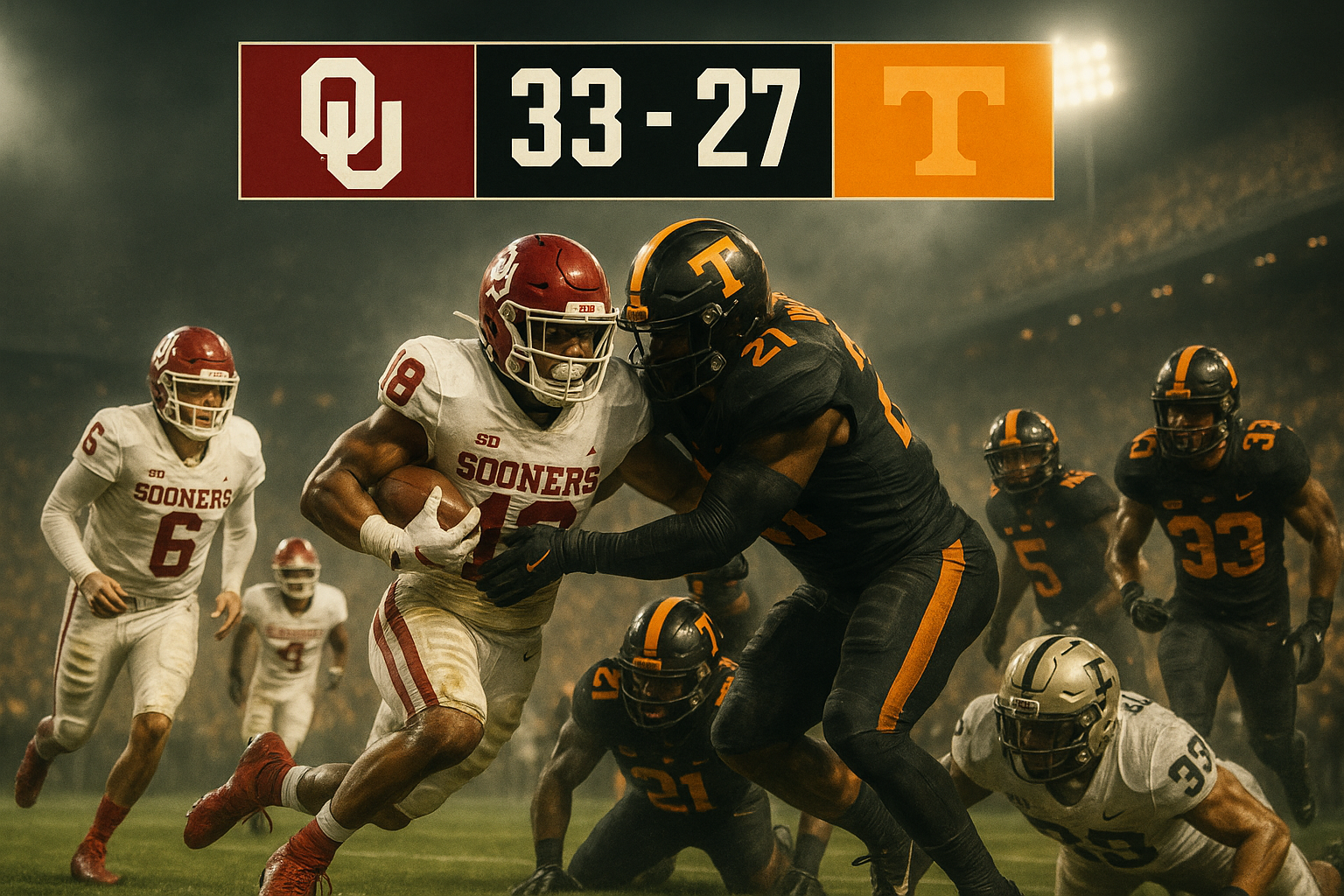
Mateer and Sandell Lead Sooners to First Ranked Road Win Since 2019 KNOXVILLE, Tenn. — Under the lights of Neyland Stadium, No. 18 Oklahoma earned a statement victory with a 33–27 win over No. 14 Tennessee on Saturday night. Quarterback John Mateer combined for 239 total yards and a game-clinching touchdown, while kicker Tate Sandell tied a stadium record with two 55-yard field goals as the Sooners survived a furious fourth-quarter rally. The win improved Oklahoma to 7–2 overall and 3–2 in the SEC , marking its first road win over a ranked opponent since 2019. Tennessee fell to 6–3 (3–3 SEC) , ending its hopes for a repeat College Football Playoff push after a costly night of turnovers and missed chances. Vols Strike First, But Sooners Answer Quickly The game began with an offensive surge from Tennessee. Quarterback Joey Aguilar guided a sharp opening drive capped by a five-yard touchdown pass to Braylon Staley , giving the Vols a 7–0 lead less than four minutes in. Oklahoma’s response came just minutes later — not from its offense, but from its defense. Linebacker Owen Heinecke broke through the Tennessee line, sacked Aguilar, and forced a fumble that R. Mason Thomas scooped up and returned 71 yards for a touchdown , tying the game at 7–7. The return set a new Oklahoma program record for the longest fumble return in school history. The Vols briefly regained control with a 45-yard field goal by Max Gilbert , moving ahead 10–7 with 3:30 left in the first quarter. But the Sooners dominated the remainder of the half through a mix of defensive pressure and Sandell’s clutch kicking. Oklahoma’s Defense Turns the Tide The second quarter belonged entirely to the Sooners. Oklahoma intercepted Aguilar twice — once by Peyton Bowen and once by Robert Spears-Jennings — and capitalized on both turnovers. Sandell drilled field goals from 55 , 51 , and 40 yards , propelling the Sooners to a 16–10 halftime lead despite being outgained 255–99 in total yards. Tennessee’s high-powered offense struggled to sustain drives against Oklahoma’s disguised blitzes and coverage schemes. Aguilar was sacked four times and pressured on multiple occasions as the Sooners’ front seven repeatedly collapsed the pocket. Oklahoma’s defensive line limited the Vols to just 63 rushing yards for the game, neutralizing their normally explosive ground attack. Back-and-Forth Battle in the Second Half Coming out of halftime, Tennessee quickly regained momentum. On their first possession of the third quarter, Aguilar connected with Staley again — this time on a 54-yard touchdown — to put the Vols back in front 17–16. The home crowd of 101,915 erupted as Tennessee looked poised to take control. Oklahoma, however, answered immediately. A 52-yard drive led by Mateer and running back Xavier Robinson ended with a four-yard touchdown run from Robinson, restoring the Sooners’ lead at 23–17 late in the third quarter. Tennessee’s defense appeared to swing momentum back in its favor on the following drive when Edrees Farooq forced and recovered a fumble at the 10-yard line, halting Oklahoma’s red-zone threat. But the Vols couldn’t capitalize, and their ensuing drive stalled near midfield. Early in the fourth quarter, Sandell connected once more from 55 yards , his fourth made field goal of the game, extending Oklahoma’s lead to 26–17 . His pair of 55-yarders tied the Neyland Stadium record for longest successful kicks, a feat last accomplished in 2006. Tennessee’s Late Rally Falls Short Facing a nine-point deficit, Tennessee rallied with urgency. With 4:18 remaining, Edwin Spillman intercepted Mateer and returned the ball to Oklahoma territory, setting up a short field. Six plays later, Aguilar found Mike Matthews for a 15-yard touchdown, trimming the Sooners’ lead to 26–24 with under two minutes to play. The Vols attempted an onside kick, but Oklahoma recovered. On the very next play, Robinson sprinted 43 yards downfield before sliding intentionally at the one-yard line to keep the clock running. Mateer then finished the drive with a one-yard quarterback sneak, sealing the victory at 33–24 . Tennessee managed one final field goal by Gilbert from 48 yards , narrowing the score to 33–27 with 47 seconds left, but it wasn’t enough. Oklahoma ran out the clock to escape with its biggest win of the season. Historic Performances Mateer showcased dual-threat ability throughout, finishing with 159 passing yards and 80 rushing yards , including the decisive touchdown. While the Sooners’ offense never fully found rhythm through the air, its ability to convert turnovers into points and control tempo proved crucial. Robinson contributed 86 rushing yards and a touchdown, while wideout Nic Anderson led Oklahoma’s receivers with 62 yards on five catches . Defensively, Thomas’ record-setting 71-yard fumble return and the team’s three takeaways defined the game’s outcome. Sandell’s performance was one for the record books. His four made field goals — from 40, 51, and two from 55 yards — accounted for nearly half of Oklahoma’s points. He became the first player in program history to make two 55-yard field goals in the same game. For Tennessee, Aguilar posted an impressive 393 passing yards and three touchdowns, but his two interceptions and one lost fumble proved costly. Staley finished with five receptions for 75 yards and two touchdowns, while Matthews added 76 yards and one score. Defensive and Special Teams Notes Oklahoma’s defensive unit thrived on aggression and discipline. The Sooners’ front line, anchored by R. Mason Thomas and Ethan Downs , consistently disrupted Aguilar’s timing, forcing hurried throws and preventing Tennessee from establishing a rhythm. Linebacker Kip Lewis added eight tackles, including a key stop on a third-and-short that stalled a Vol drive late in the third quarter. Tennessee’s defense, led by Farooq’s 10 tackles and two forced fumbles, kept the Vols in the game despite the turnovers. Spillman’s interception highlighted a unit that refused to quit, while safety Jalen McCullough contributed nine tackles and a pass breakup in coverage. Special teams play loomed large for both sides. In addition to Sandell’s record-setting performance, Tennessee’s Max Gilbert converted field goals from 45 and 48 yards, showcasing his consistency under pressure. The Bigger Picture For Oklahoma, the victory was not just another win — it was a turning point. The Sooners earned their first ranked road victory in six years and reignited their postseason aspirations. The team improved to 7–2 and remains in contention for a New Year’s Six bowl , with upcoming games against Alabama and Texas A&M looming. Tennessee’s loss was both emotional and costly. The Vols outgained Oklahoma 456–351 in total offense but were undone by three turnovers inside Sooner territory. The defeat effectively ended their hopes for a return to the College Football Playoff, though they remain positioned for a strong bowl bid with two conference games left. Final Takeaway In a clash between ranked SEC powers, Oklahoma’s opportunistic defense and Sandell’s historic leg made the difference. The Sooners capitalized on every Tennessee mistake and executed under pressure to leave Knoxville with a 33–27 statement victory . For Tennessee, it was a night of what-ifs — too many turnovers, too few defensive stops, and one opponent that refused to yield. As the Sooners head into a bye week before facing No. 4 Alabama , their message to the rest of the conference is clear: they’re not out of the playoff conversation yet.
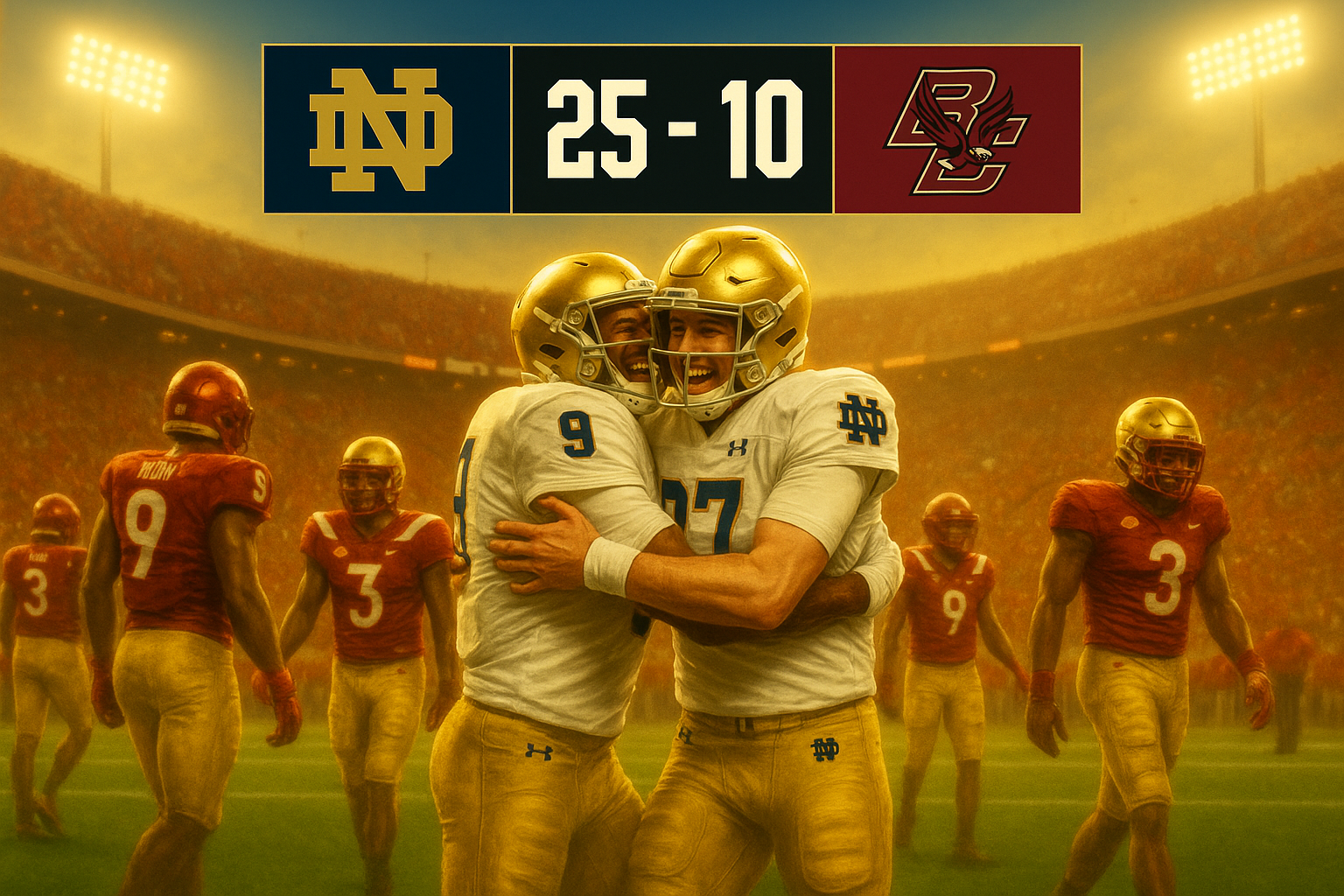
Love’s 94-Yard Touchdown Run Seals Sixth Straight Win for the Fighting Irish CHESTNUT HILL, Mass. — No. 12 Notre Dame weathered early offensive struggles and a determined Boston College defense before finally breaking through in the second half to secure a 25–10 victory on Saturday evening at a sold-out Alumni Stadium. Running back Jeremiyah Love provided the knockout blow with a 94-yard touchdown run in the fourth quarter, helping the Irish record their sixth consecutive win and tenth straight in the series since 2008. The Fighting Irish improved to 6–2 overall , while Boston College fell to 1–8 , despite one of its strongest defensive showings of the season. Early Defensive Standoff Both teams traded punts in a scoreless first quarter as defenses dominated the opening 15 minutes. Notre Dame’s front seven, led by Drayk Bowen and Joshua Burnham , stuffed multiple run plays and limited Boston College quarterback Dylan Lonergan to short throws. The Eagles’ defense matched that energy, forcing back-to-back Notre Dame three-and-outs and maintaining tight coverage on every route. The first big play came on the opening snap of the second quarter. Facing fourth-and-six at the Boston College 40-yard line, Notre Dame quarterback CJ Carr dropped back and fired deep over the middle to Malachi Fields for a 40-yard touchdown, giving the Irish a 6–0 lead after the extra point struck the upright. Boston College’s response came on defense. Safety Omar Thornton stripped the ball from Jadarian Price at the goal line on the following Irish possession, with Favor Bate recovering to keep the Eagles within reach. The turnover ignited the home crowd and set the tone for what would become one of the most competitive halves of the Eagles’ season. A Back-and-Forth First Half After switching quarterbacks to Grayson James , Boston College found offensive rhythm late in the second quarter. James led a 75-yard drive capped by a 25-yard touchdown pass to Reed Harris , cutting Notre Dame’s lead to 12–7 just before halftime. Earlier in the quarter, Carr had connected with Will Pauling on a 44-yard strike for Notre Dame’s second touchdown, extending the Irish advantage to 12–0 after a failed two-point try. But James’ quick-strike drive gave Boston College new life heading into the locker room. Notre Dame’s special teams missteps prevented the margin from being larger. The Irish missed a field goal as time expired in the half, marking the second of three missed kicks on the evening. Head coach Marcus Freeman later noted that the team rotated multiple kickers throughout the game while searching for consistency. At the break, the Irish held just a 12–7 lead, and Boston College had momentum after keeping one of the nation’s top offenses under control for most of two quarters. Third Quarter: Eagles Fight Back Boston College opened the second half with its most impressive drive of the night — a 21-play, 74-yard march that consumed more than 11 minutes of clock. Despite two fourth-down conversions and several short-yardage runs by Turbo Richard , the Eagles settled for a 25-yard field goal by Luca Lombardo , narrowing the deficit to 12–10. Notre Dame quickly answered. Carr completed short passes to Jordan Faison and Eli Raridon before Love punched in a three-yard touchdown to push the lead back to 18–10 late in the third quarter. The extra point attempt missed wide right, continuing the Irish’s unusual kicking struggles. Boston College appeared poised to respond again, driving into Irish territory early in the fourth quarter. But on a third-and-seven play, James’ pass sailed high and was intercepted by Adon Shuler near the goal line. On the very next snap, Love broke free through a massive hole opened by the left side of Notre Dame’s line — led by Aamil Wagner and Sullivan Absher — and outran the entire Boston College defense for a 94-yard touchdown , extending the lead to 25–10 and silencing the home crowd. Late Defense Clamps Down Notre Dame’s defense controlled the remainder of the contest. Linebacker Kyngstonn Viliamu-Asa delivered multiple tackles behind the line of scrimmage, including a late sack that effectively ended Boston College’s comeback hopes. Bowen capped his breakout night with a career-high 14 tackles , a sack, and two tackles for loss, anchoring an Irish defense that forced three turnovers and sacked the Eagles’ quarterbacks five times . Boston College’s offense, which had shown promise through two quarters, faltered late. James finished 25 of 37 for 240 yards with one touchdown and two interceptions, while Lonergan, who started the game, went 1-for-4 with one interception before being replaced. Wide receivers Lewis Bond and Jaedn Skeete provided bright spots for the Eagles, combining for 16 receptions and 165 yards . Thornton led the defense with nine tackles and a forced fumble, helping keep the Irish within reach for most of the game. Key Performances and Turning Points Love’s second-half surge defined the contest. The sophomore running back totaled 136 yards and two touchdowns , marking his second career game with multiple scores and his second 90-plus-yard run as a member of the Irish. Carr efficiently directed the offense, completing 18 of 25 passes for 299 yards and two touchdowns , both on deep throws to Fields and Pauling. The defining sequence — Shuler’s interception followed immediately by Love’s 94-yard sprint — turned what had been a tense two-point game into a decisive double-digit lead. From that moment forward, the Irish defense never allowed Boston College another serious scoring opportunity. Takeaways and Outlook While the final score suggested control, Notre Dame’s victory was anything but routine. The Irish committed multiple special teams miscues, including three missed kicks, and endured long stretches of offensive inconsistency. Yet, the team’s ability to make game-changing plays at critical moments reflected the resilience and depth that have defined its season. Defensively, Notre Dame again proved dominant in crunch time, forcing turnovers on back-to-back Boston College possessions late in the fourth quarter. The unit has now held opponents to 10 points or fewer in three straight games , continuing its rise among the nation’s top defensive groups. For Boston College, the performance offered encouragement despite the result. The Eagles’ defense limited Notre Dame to one offensive touchdown in the first half and forced multiple red-zone stops. However, offensive miscues and missed opportunities — particularly on the 11-minute drive that ended in a field goal — prevented them from capitalizing on early momentum. What’s Next Notre Dame will return home to face Navy next week before closing the regular season with matchups against Pittsburgh, Syracuse, and Stanford . With no ranked opponents left on the schedule, the Irish will aim to avoid a late-season stumble as they pursue a spot in the expanded College Football Playoff . Boston College remains at home to host SMU in its annual Red Bandanna Game , honoring 9/11 hero Welles Crowther . Despite the loss, the Eagles’ effort against one of the nation’s elite programs gives them reason to believe they can finish the season strong. Final Takeaway Notre Dame’s 25–10 win over Boston College was a showcase of persistence and playmaking. Behind Jeremiyah Love’s explosive touchdown runs and a defense that rose to the moment, the Fighting Irish found a way to pull away from a scrappy opponent and extend their winning streak. For Boston College, it was a valiant effort that fell short — a night where toughness met talent, but one big play made all the difference.
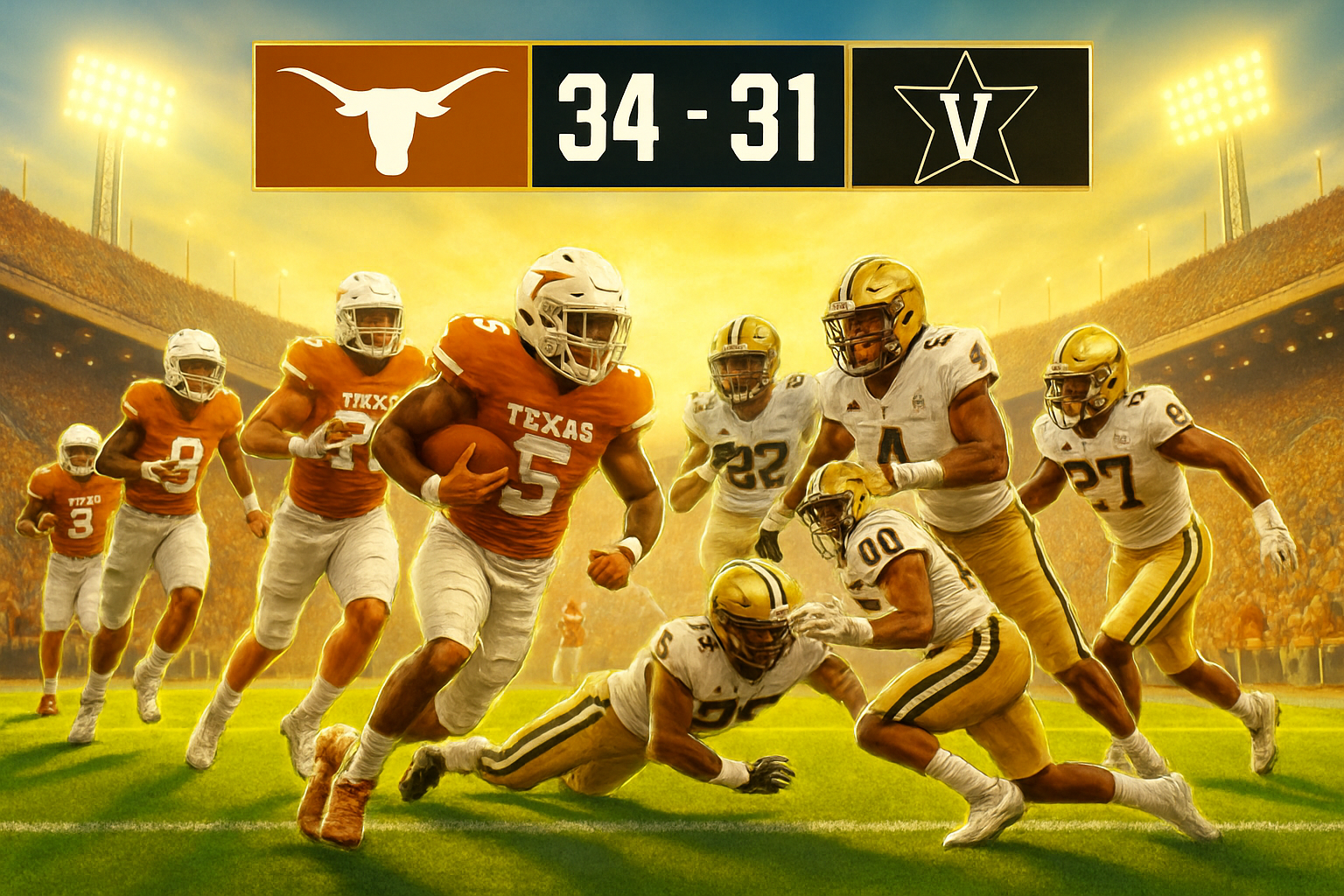
Arch Manning’s Three-Touchdown Performance Highlights Longhorns’ Second Top-10 Win of the Season AUSTIN — The crowd of 102,338 at Darrell K Royal–Texas Memorial Stadium witnessed a dramatic finish Saturday night as No. 20 Texas held off a furious fourth-quarter rally from No. 9 Vanderbilt, escaping with a 34–31 victory in a pivotal SEC matchup. Quarterback Arch Manning threw for 328 yards and three touchdowns in his return from injury, guiding the Longhorns to their second win over a top-10 opponent this season. The win improved Texas to 7–2 overall and 4–1 in conference play , keeping them within reach of an SEC title game berth. Vanderbilt dropped to 7–2 (3–2 SEC) after seeing its comeback fall just short on the road. Texas Starts Fast Behind Manning’s Precision Texas wasted no time electrifying the home crowd. On the first play from scrimmage, Manning hit Ryan Wingo in stride on a short route that turned into a 75-yard touchdown, matching the freshman receiver’s career-long reception. It was a statement start that set the tone for a Texas offense firing on all cylinders early. The Longhorns’ defense immediately capitalized on the momentum. Edge rusher Colin Simmons recorded a strip-sack on Vanderbilt’s opening drive, giving Texas possession deep in Commodore territory. Kicker Mason Shipley converted a 39-yard field goal to extend the lead to 10–0. Texas continued its first-quarter dominance with another touchdown, this time from CJ Baxter , who caught a six-yard pass from Manning for his first receiving touchdown of the season. Baxter’s score capped a 70-yard drive that pushed the lead to 17–0 before Vanderbilt could find its footing. The Commodores finally got on the board early in the second quarter with a 44-yard field goal from Brock Taylor , cutting the deficit to 17–3. But the Longhorns’ offense kept pressing. Running back Quintrevion Wisner finished off an 11-play drive with a four-yard touchdown run, marking his ninth career rushing score and giving Texas a commanding 24–3 advantage midway through the quarter. Longhorns Maintain Control into Halftime Late in the second quarter, Vanderbilt found a spark. Quarterback Diego Pavia orchestrated an efficient two-minute drive, converting a fourth-and-five and capping the series with an 18-yard touchdown to tight end Eli Stowers , cutting the Longhorns’ lead to 24–10 heading into halftime. Despite the late score, Texas’ first-half dominance was evident. Manning completed 15 of 18 passes for 224 yards and two touchdowns , while the Longhorns’ defense registered three sacks and held the Commodores to just 10 points across six possessions. Manning’s Third Touchdown Extends the Lead The Longhorns opened the third quarter determined to put the game away. Manning connected with Emmett Mosley V for a six-yard touchdown — his third passing score of the afternoon — finishing an 11-play, 93-yard drive that showcased both poise and balance. Vanderbilt’s next drive stalled when Pavia was sacked by Ethan Burke , forcing a long field goal attempt. Taylor’s 48-yard try sailed wide right, ending his streak of 19 consecutive made field goals, which had ranked among the nation’s longest active streaks. Texas added to its cushion with another field goal from Shipley, this time from 37 yards, pushing the margin to 34–10 late in the third quarter. At that point, the Longhorns appeared to have the game fully under control, having scored on six of their first eight drives. Vanderbilt’s Fourth-Quarter Comeback Just when Texas seemed ready to cruise, Vanderbilt mounted one of the most impressive comeback efforts of the SEC season. Pavia sparked the rally early in the fourth quarter with a 25-yard touchdown run, his longest rushing score of the season. The Commodores’ defense followed by forcing a turnover on downs, setting up another possession at their own 33-yard line. On the very next play, Pavia connected again with Stowers, this time for a 67-yard touchdown, trimming the deficit to 34–24 and silencing the Texas crowd momentarily. Momentum swung further when the Commodores forced a Texas three-and-out and got the ball back with just under three minutes remaining. Pavia led one final charge, completing five passes for first downs before hitting Richie Hoskins on an eight-yard touchdown with 33 seconds left, bringing Vanderbilt within three at 34–31 . The comeback attempt nearly reached completion, but Vanderbilt’s onside kick attempt rolled out of bounds after a brief scramble, allowing Texas to kneel out the remaining seconds for the narrow win. Statistical Leaders and Key Performances Manning’s 328-yard, three-touchdown effort marked his fifth game this season with three or more passing touchdowns, and his return from concussion protocol showed no lingering effects. He completed 25 of 33 passes with a 76 percent completion rate, demonstrating control and accuracy throughout. Wisner led the ground attack with 75 rushing yards and one touchdown , his third 75-plus-yard performance of the season. Baxter added 22 rushing yards and 18 receiving yards to complement the passing game. Wingo was the big-play threat, finishing with two receptions for 89 yards , while Mosley led the team with seven catches for 69 yards. DeAndre Moore Jr. contributed 49 yards on three receptions, giving Manning a reliable trio of targets. On defense, Derek Williams Jr. led the Longhorns with a career-best eight tackles, while Simmons and Jaylon Guilbeau combined for seven tackles and two tackles for loss. Burke’s third-quarter sack was one of six total by the Texas defense, a performance that disrupted Vanderbilt’s rhythm through most of the game. For Vanderbilt, Pavia turned in a career-best 408 total yards , including 365 passing and 43 rushing. Stowers caught seven passes for 146 yards and two touchdowns, marking one of the top receiving performances by a tight end in the nation this season. The Commodores’ defensive effort was anchored by Nick Rinaldi and Marlen Sewell , who each recorded eight tackles. The Bigger Picture For Texas, the victory represented a significant step forward. It marked the first time since 2016 that the Longhorns have defeated multiple top-10 teams in the same regular season. It also extended their streak of forcing at least one turnover in 21 consecutive home games , the longest active run in the FBS. Head coach Steve Sarkisian’s team continues to build momentum after a midseason slump that briefly knocked them out of the rankings. With four straight wins and an offense regaining its early-season form, Texas remains firmly in the conversation for a College Football Playoff berth if they can finish strong in November. For Vanderbilt, the loss stings but doesn’t erase their progress. Pavia’s career night pushed him to seventh all-time in program passing yards, and the late rally demonstrated the team’s resilience even in defeat. The Commodores’ three-touchdown surge in the final quarter will stand as one of their most determined efforts of the year. What’s Next Texas will travel to Athens, Georgia , on November 15 to face No. 5 Georgia in what could be a defining matchup for the SEC standings. Vanderbilt returns home to host Auburn for its homecoming game on November 8 , seeking to rebound and remain in contention for a New Year’s Six bowl appearance. Final Takeaway Texas’ 34–31 win over Vanderbilt was a showcase of early dominance, late composure, and timely resilience. Arch Manning’s precision passing and the defense’s early pressure built an insurmountable lead — one that barely held under Vanderbilt’s late surge. For the Longhorns, it was another November test passed, one that keeps their postseason hopes alive and their confidence soaring.
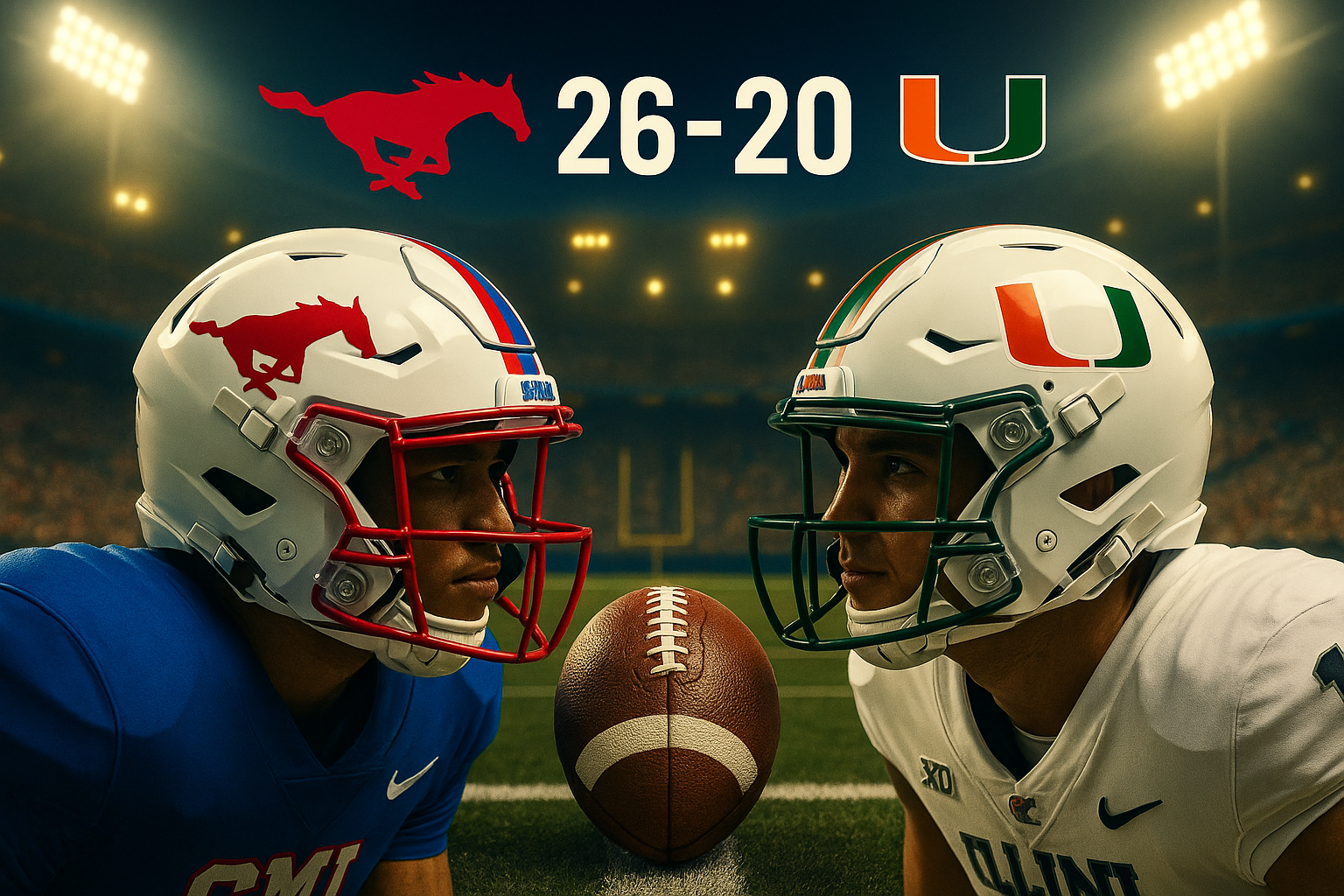
Mustangs Earn First Win Over a Top-10 Opponent Since 1974 DALLAS — In one of the most dramatic upsets of the college football season, SMU outlasted No. 10 Miami in overtime, 26–20, on Saturday afternoon at Gerald J. Ford Stadium. The Mustangs’ victory not only spoiled the Hurricanes’ playoff ambitions but also marked SMU’s first home win over an AP top-10 team in more than five decades, dating back to 1974. Behind the leadership of quarterback Kevin Jennings , who threw for 365 yards , the Mustangs battled through adversity, penalties, and a late deficit before sealing the win on T.J. Harden’s one-yard touchdown run in the extra session. The victory sent SMU fans pouring onto the field in jubilation, toppling the goalposts in celebration of a signature win that reaffirmed their standing in the ACC. With the result, SMU improved to 6–3 overall and 4–1 in ACC play , while Miami fell to 6–2 (2–2 ACC) and likely slipped out of playoff contention. A Physical First Half Defined by Missed Chances The opening half was a grind for both offenses, marked by penalties and defensive stands. Miami struck first midway through the first quarter when quarterback Carson Beck connected with receiver Joshisa Trader on a 36-yard touchdown strike, giving the Hurricanes a 7–0 lead. SMU responded on its next possession. After a Miami turnover on downs, Jennings hit receiver Yamir Knight in the corner of the end zone from 28 yards out, capping off a quick scoring drive and tying the game 7–7. The defenses controlled much of the first half thereafter. Miami’s front seven harassed Jennings, forcing several punts and limiting SMU’s running game to negative yardage at intermission. However, the Hurricanes failed to fully capitalize on their advantage. After a 47-yard punt return by Malachi Toney set up Miami at the SMU nine-yard line, the Mustangs’ defense held firm, forcing the visitors to settle for a 22-yard field goal and a 10–7 halftime lead. Miami dominated time of possession in the opening half — more than 20 minutes to SMU’s 10 — and outgained the Mustangs 227–121, but their inability to finish drives would prove costly. SMU Finds Its Rhythm After Halftime Whatever adjustments head coach Rhett Lashlee made in the locker room worked immediately. On the opening drive of the second half, Jennings completed five of six passes for 74 yards and finished it himself with a three-yard touchdown run, giving the Mustangs their first lead of the game at 14–10. Miami answered on the following possession with a 75-yard march of its own. Beck hit Alex Bauman for a four-yard touchdown, briefly reclaiming a 17–14 advantage. But SMU continued to fight, even as its quarterback battled through an apparent lower-leg injury. Jennings remained composed, spreading the ball to multiple receivers while targeting Jordan Hudson , who finished with 11 receptions for 136 yards . Late in the third quarter, kicker Sam Keltner converted a 43-yard field goal to tie the game 17–17 as the Mustangs regained momentum entering the final frame. Fourth Quarter: Penalties, Missed Opportunities, and Resilience The fourth quarter saw both teams trade field goals and costly mistakes. Miami struck first with a 45-yard field goal by Carter Davis to regain a 20–17 lead early in the quarter. Moments later, SMU attempted to tie the game with another Keltner kick, but his 42-yarder drifted just wide right. The Mustangs argued the ball had sailed directly over the upright, but the call was not reviewable. As time wound down, Miami appeared poised to run out the clock. However, a critical sequence shifted the tide. On a 4th-and-9 with just over a minute remaining, a roughing-the-passer penalty against Miami’s Marquise Lightfoot gave SMU a fresh set of downs. Jennings capitalized, engineering a drive that set up Keltner for redemption. This time, the junior kicker drilled a 38-yard field goal with 25 seconds remaining to send the game to overtime, tying the score at 20–20 and igniting the home crowd. Overtime Drama: Moses and Harden Deliver Miami opened the overtime period on offense and quickly moved inside the 10-yard line behind short runs from Mark Fletcher Jr. Facing a 3rd-and-6 from the SMU seven-yard line, Beck dropped back to pass but was intercepted by Ahmaad Moses , who made a leaping grab at the goal line and returned it deep into Mustang territory. Moses’ interception — his second of the game — set up the decisive drive. Despite entering overtime with negative rushing yards, SMU turned to Harden, who carried the ball four consecutive times. On the final play, Harden burst through a gap on the left side of the line, crossing the goal line untouched for the game-winning score. As the ball crossed the plane, chaos erupted. Thousands of SMU fans stormed the field, celebrating their biggest win in decades as the goalposts came down at Gerald J. Ford Stadium. The Mustangs had earned their 13th consecutive home conference victory , extending one of the nation’s longest active streaks. Statistical Breakdown Despite being outgained 433–388 in total offense, SMU found ways to win with efficiency and timely execution. The Mustangs mustered only 23 rushing yards but offset that with Jennings’ 365-yard passing performance , which included a touchdown and a rushing score. Knight contributed 47 receiving yards and a touchdown, while McFall added key receptions on third down to sustain drives. Defensively, Ahmaad Moses was the standout, finishing with 15 tackles and both of SMU’s interceptions. The Mustangs’ defense forced two turnovers, blocked a fourth-down run, and limited Miami to just 3-of-12 on third down conversions in the second half. For Miami, Carson Beck completed 26 of 38 passes for 274 yards with two touchdowns but also threw two costly interceptions. Fletcher led all rushers with 84 yards on 16 carries, while Trader and Marion combined for 10 receptions and 158 yards. Miami’s defense held SMU to a season-low in rushing but couldn’t overcome 12 penalties for 96 yards , including several drive-killing mistakes. A Night to Remember for the Mustangs The victory carried emotional weight beyond the scoreboard. Just hours before kickoff, SMU announced a two-year contract extension for head coach Rhett Lashlee , rewarding his leadership in guiding the program’s transition back into a power conference. The extension underscored the school’s commitment to long-term success — a message amplified by the night’s result. It was also a moment of redemption for Sam Keltner , who had missed a potential tying field goal earlier in the fourth quarter. His late-game accuracy, coupled with Moses’ defensive heroics, transformed what could have been a heartbreaking loss into a defining moment for the program. For Miami, the defeat was a painful setback after entering the week as a playoff dark horse. The Hurricanes’ inability to execute late and their self-inflicted mistakes derailed an otherwise solid road performance. Looking Ahead SMU will look to sustain its momentum when it travels to Boston College next weekend for an ACC matchup in Chestnut Hill. The Mustangs remain in contention for a conference title appearance, with their remaining schedule offering opportunities to climb further in the standings. Miami, meanwhile, returns home to face Syracuse at Hard Rock Stadium, aiming to regroup after back-to-back close contests. Final Takeaway On Homecoming weekend in Dallas, SMU delivered a statement win that resonated beyond the ACC standings. Against a top-10 opponent and a team favored by double digits, the Mustangs showcased resilience, defensive tenacity, and the kind of big-play composure that defines championship-caliber football. For SMU fans, the sight of Harden crossing the goal line and the ensuing field storm will be remembered as a moment of triumph — one that rekindled memories of the program’s storied past and hinted at a bright future ahead.
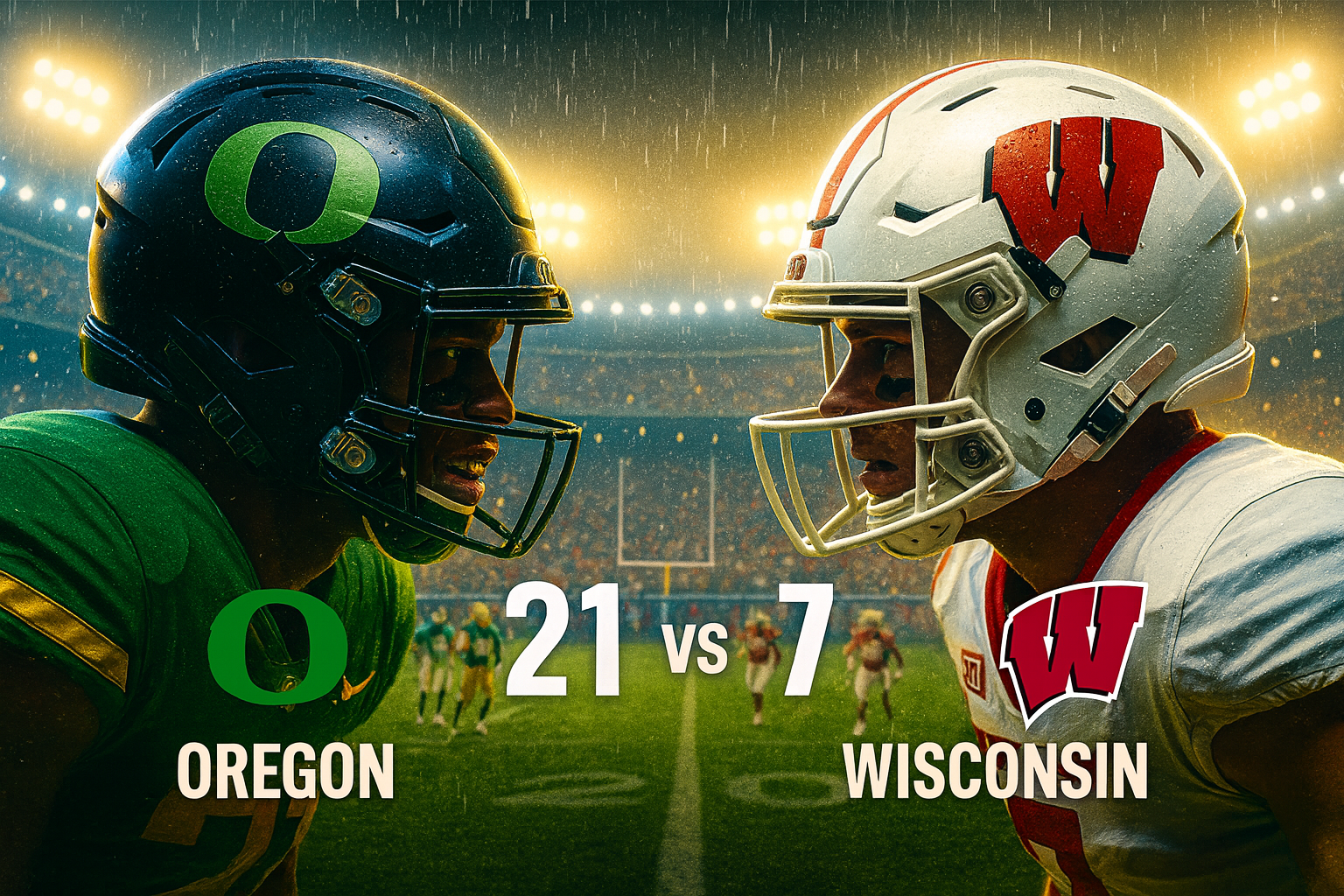
Ducks Grind Out Hard-Fought Win Behind Davison’s Dual Touchdowns EUGENE, Ore. — On a night defined by driving rain, swirling wind, and physical football, the No. 6 Oregon Ducks battled through adversity to earn a 21–7 victory over Wisconsin on Saturday at Autzen Stadium. Freshman running back Jordon Davison carried the offense, rushing for 102 yards and two touchdowns , while backup quarterback Brock Thomas stepped in after Dante Moore’s injury to guide the Ducks to a crucial insurance score in the fourth quarter. The win lifted Oregon to 7–1 overall and 4–1 in Big Ten play , keeping their postseason goals alive. For Wisconsin, the defeat marked its sixth straight loss , dropping the Badgers to 2–6 (0–5 Big Ten) . Despite strong defensive play, the offense struggled again before finally ending a lengthy scoring drought late in the game. Slow Start in Soaked Conditions Autzen Stadium lived up to its reputation as an unpredictable, rain-soaked fortress. Heavy rain and gusting winds turned the first quarter into a defensive standoff, as both teams fought to control the slick ball. Oregon managed only 21 yards and two first downs, while Wisconsin’s defense repeatedly forced punts. The Ducks opened aggressively, attempting an onside kick on the opening play to seize momentum. Although Wisconsin recovered, the bold call hinted at Oregon’s readiness to adapt to the elements. Wisconsin’s young defense impressed early, led by freshman linebackers Mason Posa and Cooper Catalano , both making their first career starts. Posa led all tacklers with 13 stops , the most by a Badger freshman since 2015, and anchored a front that contained Oregon’s run game early. The deadlock finally broke late in the second quarter when Oregon pieced together a 16-play, 99-yard drive that consumed more than eight minutes. Davison capped it with a two-yard touchdown run , putting the Ducks ahead 7–0 just before halftime. Adjustments Spark Second-Half Surge At halftime, Oregon’s focus was clear — commit to the run and control possession. The strategy paid off immediately. On the opening drive of the third quarter, Davison burst through a gap for a 20-yard touchdown , extending the lead to 14–0 and giving the Ducks breathing room amid the rainstorm. Moments later, the Ducks faced a scare when Dante Moore exited with a bloody nose following a collision. Although cleared to return, coaches chose to rest him, turning the offense over to Brock Thomas , a local product from Eugene making his first meaningful appearance. Thomas responded with poise, converting a critical third down on his first series and guiding a five-play, 54-yard drive capped by a one-yard touchdown pass to offensive lineman Gernorris Wilson , who lined up as an eligible receiver. The creative play call stretched the margin to 21–0 early in the fourth quarter. Oregon’s adjustments — short passes, misdirection runs, and deliberate tempo — showcased their adaptability and discipline under pressure. Wisconsin’s Late Push Down three scores, Wisconsin refused to quit. Quarterback Hunter Simmons , who had struggled for most of the night, finally found rhythm in the fourth quarter. Simmons directed a 12-play, 78-yard drive , featuring a 42-yard completion to Eugene Hilton Jr. that brought the Badgers to Oregon’s one-yard line. Two plays later, he hit tight end Lance Mason for a two-yard touchdown , trimming the deficit to 21–7 and ending Wisconsin’s 174-minute scoring drought across three games. Though the late touchdown offered a spark, it came too late to threaten Oregon’s control of the game. Defensive Toughness Defines the Night Defense dominated from start to finish on both sides. Oregon’s secondary, led by Dillon Thieneman and Bryce Boettcher , broke up six passes and limited Wisconsin to just 86 passing yards through three quarters. The Ducks’ front seven controlled the line of scrimmage, holding the Badgers under 100 rushing yards before the final drive. Consistent pressure forced Wisconsin into third-and-long situations and disrupted their offensive rhythm throughout the night. Wisconsin’s defense also showed determination despite extended time on the field. Posa’s 13 tackles led all players, while Matthew Jung and Ben Barten each added double-digit stops. The Badgers notched seven tackles for loss , their most in conference play this year, but eventually wore down under Oregon’s relentless ground game. Davison’s Breakout Season Continues Jordon Davison continued his ascent as one of the nation’s most exciting young running backs. Coming off a 100-yard performance at Rutgers, he once again surpassed the century mark against Wisconsin’s physical defense. His 49 rushing yards on Oregon’s 99-yard scoring drive highlighted his endurance and vision in the wet conditions. Through eight games, Davison has solidified himself as the focal point of Oregon’s offense, blending patience, balance, and power. His success in adverse weather underscored his value to the Ducks’ Big Ten title aspirations. With several offensive injuries, Davison’s consistency has provided the stability and leadership Oregon’s young offense has needed down the stretch. Quarterback Depth Proves Crucial The emergence of Brock Thomas was another bright spot for Oregon. The hometown freshman displayed composure beyond his experience, managing the playbook efficiently and keeping the offense mistake-free. His first career touchdown pass — to Wilson — energized teammates and fans alike. Thomas’s ability to control tempo and make accurate short throws helped Oregon maintain possession and drain the clock in the final quarter. Before his exit, Dante Moore performed effectively, throwing for 86 yards and managing several extended drives that kept Wisconsin’s defense guessing. The combination of both quarterbacks demonstrated Oregon’s depth and readiness to adjust when adversity struck. Wisconsin’s Struggles Continue Wisconsin’s frustrating season extended with another loss characterized by inconsistency and injuries. Missing several starters, including both top running backs and leading tackler Christian Alliegro , the Badgers relied heavily on young players to step into key roles. Freshman running back Gideon Ituka provided a rare offensive highlight, finishing with 85 rushing yards on 21 carries and displaying toughness against one of the Big Ten’s top defensive fronts. Despite flashes of promise, Wisconsin’s fifth straight conference defeat left the team searching for answers ahead of a much-needed bye week. Oregon’s Resilience and Path Ahead The Ducks’ victory was a testament to resilience, preparation, and mental toughness. Despite battling injuries, nine penalties, and relentless rain, Oregon imposed its will on both sides of the ball. At 7–1 , Oregon remains firmly in the College Football Playoff conversation . The defense continues to grow in confidence, and the running game has emerged as a reliable force capable of dictating tempo in any environment. Oregon enters its second bye week with momentum before a critical November stretch that includes a road trip to Iowa , while Wisconsin heads home to face Washington following its bye week. Final Takeaway Oregon’s 21–7 win over Wisconsin showcased grit, adaptability, and depth in the face of adversity. Davison’s two touchdowns , Thomas’s poised debut , and a dominant defensive performance defined a night where fundamentals mattered more than flash. For Wisconsin, the late touchdown provided signs of development among younger players, but offensive consistency remains elusive. For Oregon, this was more than a weather-tested victory — it was another step toward championship contention and proof that the nation’s toughest teams thrive in the harshest conditions.
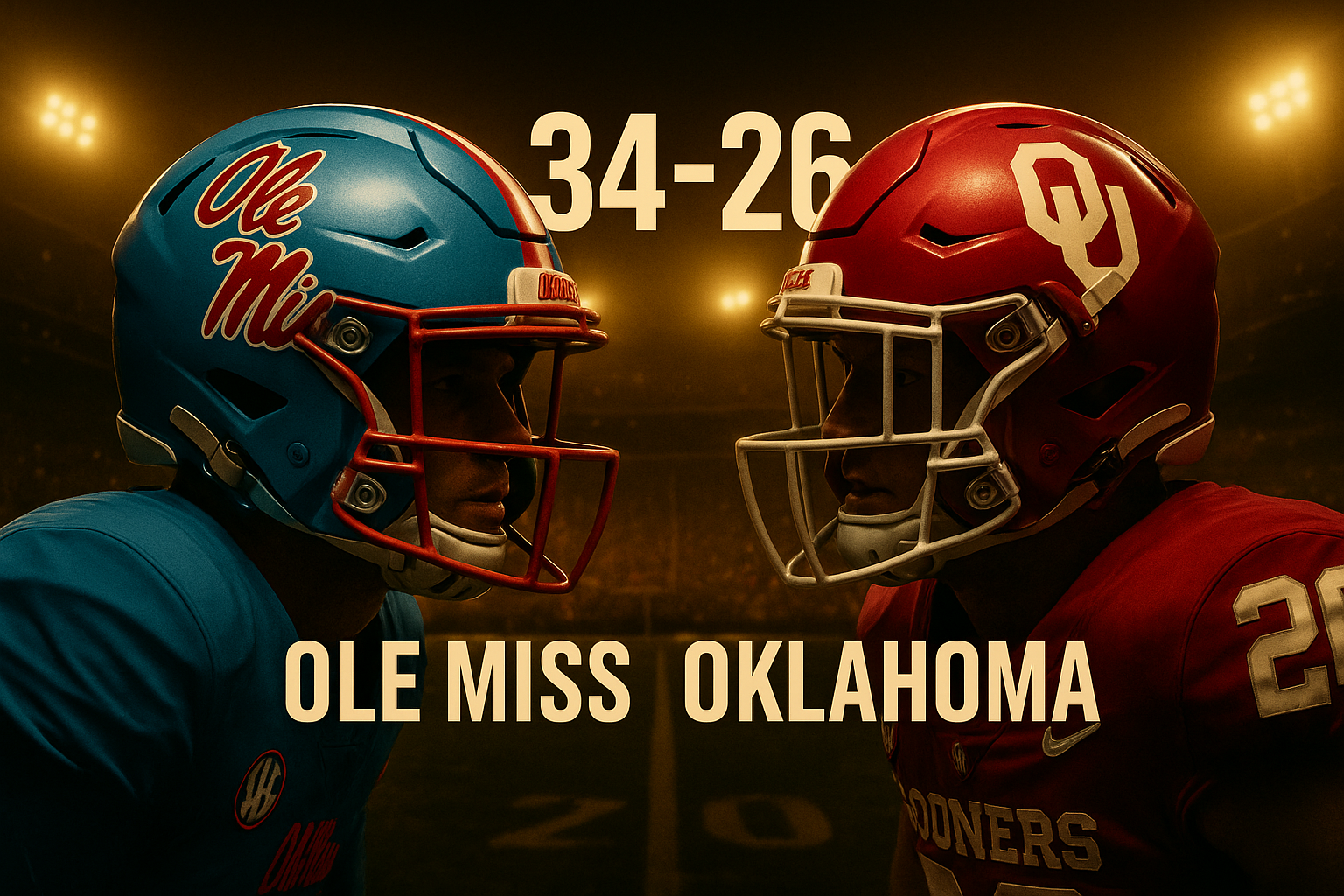
Rebels Survive Late Sooner Rally Behind Chambliss and Lacy NORMAN, Okla. — In a matchup defined by momentum swings and physical play, the No. 8 Ole Miss Rebels held off a furious second-half rally from No. 13 Oklahoma to secure a 34–26 road victory on Saturday night at Gaylord Family – Oklahoma Memorial Stadium. Quarterback Trinidad Chambliss led the Rebels with 315 passing yards, 53 rushing yards, and one touchdown , while running back Kewan Lacy added 78 yards and two scores on the ground. Freshman wide receiver Winston Watkins recorded a breakout game with 111 receiving yards , helping Ole Miss earn its seventh win of the season and remain firmly in the SEC title race . For Oklahoma, the loss halted a strong midseason surge. Xavier Robinson rushed for 109 yards and two touchdowns , and Isaiah Sategna III set a new career high with 131 receiving yards . Despite outscoring the Rebels 16–3 during one third-quarter stretch, the Sooners couldn’t match Ole Miss’s closing execution. Early Momentum Shifts Both teams started fast, trading early field goals. Ole Miss struck first with a 45-yard kick from Lucas Carneiro , and Oklahoma’s Tate Sandell matched it with a 42-yarder on the following drive. The Rebels regained the lead later in the quarter as Chambliss found Harrison Wallace III for a 25-yard strike that set up Lacy’s two-yard touchdown run, making it 10–3 . Oklahoma answered early in the second quarter when John Mateer hit Sategna for a 76-yard touchdown , tying the game 10–10 and sparking the home crowd. Moments later, Ole Miss’s defense changed the tone. Princewill Umanmielen and Will Echoles combined for a sack and a safety, giving the Rebels a 12–10 advantage. The Rebels then added a Carneiro field goal to make it 15–10 , before Lacy struck again late in the half — a two-yard touchdown following a 31-yard pass from Chambliss to Cayden Lee — extending the margin to 22–10 at halftime. Sooners Storm Back Oklahoma came alive in the third quarter. A mishandled fourth-down snap by Ole Miss gave the Sooners a short field, leading to a Sandell field goal to cut the lead to 22–13 . Moments later, Robinson broke loose for a 65-yard touchdown run , and on the next possession, powered in from nine yards out to give Oklahoma its first lead of the game, 26–25 , late in the third. The Sooners’ defense dominated the quarter, with Kip Lewis , Robert Spears-Jennings , and Kendal Daniels delivering several tackles for loss while containing Ole Miss’s rushing attack. But just as momentum swung toward the home team, the Rebels regrouped with composure. Rebels Regain Control Early in the fourth quarter, Chambliss orchestrated a poised, methodical drive capped by an eight-yard touchdown pass to Trace Bruckler , reclaiming the lead at 31–26 . The Rebels’ defense responded immediately. Kam Franklin and Suntarine Perkins anchored key stops, while the secondary disrupted Mateer’s timing and limited big plays downfield. Ole Miss then capitalized on special teams, as Bruckler forced a fumble on a punt return by Sategna , recovered by lineman Ethan Fields near midfield. Two plays later, Watkins hauled in a 43-yard reception to set up Carneiro’s 37-yard field goal , extending the lead to 34–26 with just over four minutes remaining. Defensive Finish Seals the Win Oklahoma mounted one final push behind completions to Deion Burks and Jaren Kanak , but Ole Miss’s defense refused to yield. On fourth down, Umanmielen pressured Mateer into an incompletion, forcing a turnover on downs. After one more defensive stop, the Sooners regained possession with just over a minute left, but their final drive fell short. Wydett Williams Jr. batted down Mateer’s last-second pass, clinching the Rebels’ seventh win of the season. Statistical Breakdown Ole Miss tallied 436 total yards , including 315 passing from Chambliss, who surpassed the 300-yard mark for the fourth time in six starts . Lacy’s 12th rushing touchdown of the season tied him for eighth on the program’s all-time single-season list. Watkins’s 111-yard outing marked the first 100-yard receiving game by a Rebel freshman since 2018, showcasing his explosive speed and precise route running. Defensively, Umanmielen led with six tackles, 2.0 for loss, and 1.5 sacks , while TJ Dottery and Kapena Gushiken added six tackles each. The Rebels’ defense produced five second-half stops on third down and limited Oklahoma to 16 rushing yards in the first half . Ole Miss controlled time of possession for over 35 minutes , including more than eight minutes in the fourth quarter — a critical factor in sealing the victory. For Oklahoma, Mateer finished 17-of-31 for 223 yards and one touchdown , while Robinson averaged over 12 yards per carry. Despite their second-half surge, the Sooners were unable to sustain drives late against the Rebels’ disciplined defense. What the Win Means The victory reinforced Ole Miss’s resilience following a narrow loss to Georgia the week prior. At 7–1 overall and 4–1 in SEC play , the Rebels remain squarely in contention for the SEC West title . Head coach Lane Kiffin’s squad has now won five of its last six one-score games , reflecting a growing confidence and ability to finish under pressure. For Oklahoma, the loss dropped the Sooners to 6–2 (2–2 SEC) and snapped their three-game home winning streak . Despite the defeat, their third-quarter surge showcased their competitiveness against top-tier programs. The Sooners’ defense recorded 14 tackles for loss , the longest active streak of double-digit TFL performances in program history. Looking Ahead Ole Miss returns to Oxford next weekend to host South Carolina , looking to strengthen its postseason positioning and remain in the playoff conversation. Oklahoma travels to Knoxville to face Tennessee , where both teams will battle for bowl positioning. The Sooners’ focus will be on starting faster offensively and closing games with greater consistency. Final Takeaway The 34–26 victory over Oklahoma showcased Ole Miss’s toughness, adaptability, and composure under pressure. With Chambliss’s leadership , Lacy’s steady production , and Watkins’s breakout performance , the Rebels displayed the balance and grit of a true contender. Meanwhile, Oklahoma’s late surge and defensive effort proved the Sooners’ potential remains strong despite the setback. In a clash of ranked powers, it was Ole Miss’s discipline in the closing minutes that made the difference — reaffirming its place among the SEC’s elite.
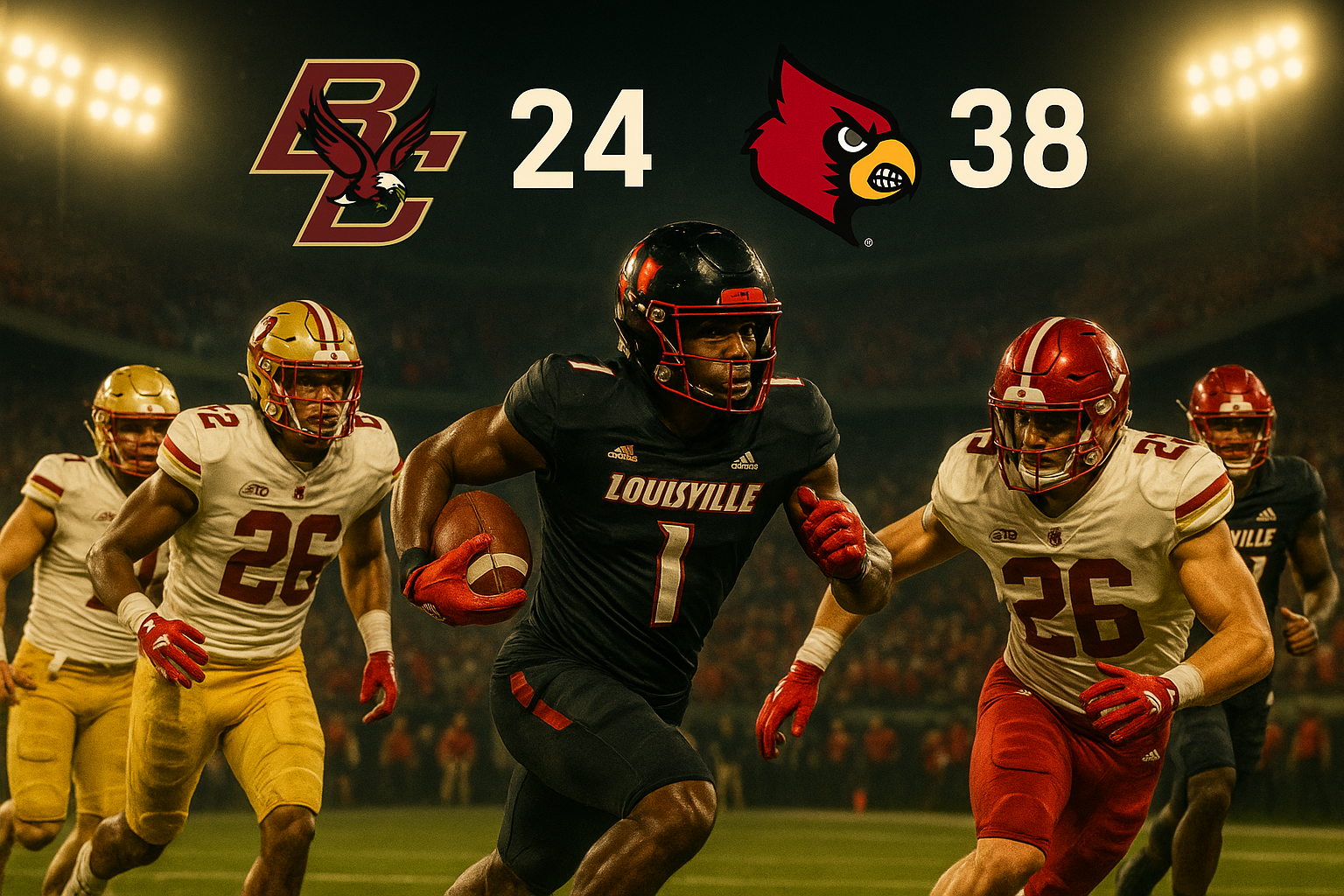
Cardinals Ride Explosive Ground Game to 38–24 Victory at Home LOUISVILLE, Ky. — The No. 19 Louisville Cardinals powered past Boston College on Saturday night, earning a 38–24 victory at L&N Federal Credit Union Stadium. Running back Isaac Brown delivered a career performance, rushing for 205 yards and a touchdown on just 14 carries , while quarterback Miller Moss accounted for three total scores as the Cardinals improved to 6–1 overall and 3–1 in ACC play . Louisville’s 317 rushing yards defined the night, as explosive runs and second-half adjustments offset three turnovers and early inconsistency. Despite occasional miscues, the Cardinals’ big-play offense and defensive grit carried them to a third straight home win . For Boston College , the loss dropped the Eagles to 1–7 (0–5 ACC) , extending their losing streak to seven — their longest since 2016. Quarterback Grayson James threw for 244 yards and three touchdowns, but turnovers and defensive breakdowns derailed their upset hopes. Eagles Strike First Boston College set the tone early with a methodical 15-play, 55-yard drive that chewed up more than eight minutes of clock. Mixing quick passes with inside runs, the Eagles controlled tempo before settling for a 38-yard field goal from Luca Lombardo to take a 3–0 lead . Louisville’s response was immediate — and explosive. On the Cardinals’ first offensive snap, Isaac Brown burst through the middle for a 73-yard gain , setting up Moss for a one-yard quarterback sneak to give Louisville a 7–3 advantage . Boston College stayed composed, answering with another extended drive. James converted multiple third downs before connecting with Lewis Bond on a six-yard touchdown , capping a 75-yard march to reclaim the lead 10–7 . Cardinals Close the Half with Fireworks The second quarter began with both defenses asserting control, forcing punts and turnovers. Louisville’s offense struggled to find consistency until late in the half — then exploded. With under two minutes to play, Moss scrambled nine yards into the end zone, giving the Cardinals a 14–10 lead . Only 40 seconds later, Brown delivered another game-changing play, racing 62 yards down the sideline for his first touchdown of the night. The long run sent the home crowd into a frenzy and pushed Louisville’s advantage to 21–10 at halftime. By the break, Brown had already piled up 151 yards on just five carries , averaging an incredible 30.2 yards per rush — singlehandedly sparking the Cardinals’ offense. Boston College Claws Back The Eagles opened the second half with renewed energy. On Louisville’s first play of the half, Brown fumbled while fighting for extra yardage, and Boston College quickly capitalized. Two plays later, James found Kaelan Chudzinski for a 23-yard touchdown , trimming the deficit to 21–17 and momentarily swinging momentum back to the visitors. Louisville’s defense responded with composure, forcing two punts before the offense struck again. After Antonio Watts recovered a fumble at the Boston College 27, Moss hit Caullin Lacy on a 22-yard touchdown strike, rebuilding the Cardinals’ lead to 28–17 . Moss settled into a rhythm from there, finishing 15-of-27 for 187 yards , one passing touchdown, and two rushing scores . Behind him, the tandem of Isaac Brown and Keyjuan Brown provided balance — combining for 300 yards on the ground, with Keyjuan adding 95 yards on 10 carries . Defense Closes the Door Louisville’s defense turned dominant in the second half, forcing three turnovers and pressuring James into hurried throws. Wesley Bailey anchored the front with two sacks, while linebackers TJ Quinn and Cam’Ron Kelly clogged running lanes, limiting Boston College to fewer than 100 rushing yards . Despite being on the field for much of the first half, the defense found another gear after intermission. Two critical interceptions from James halted potential scoring drives and preserved the Cardinals’ control of the game. Still, Boston College refused to fade quietly. With six minutes remaining, James led a 68-yard drive , ending in a 21-yard touchdown to Jeremiah Franklin , narrowing the gap to 31–24 . But the comeback hopes ended there. Facing fourth-and-8 near midfield, Boston College opted to punt — a conservative decision that quickly backfired. Brown Finishes the Job With less than two minutes to play, Keyjuan Brown sealed the victory in style. On second down, the sophomore burst through a lane on the right side and sprinted 67 yards to the end zone , pushing the lead to 38–24 and sending the Louisville faithful into celebration. Between Isaac Brown’s early fireworks and Keyjuan Brown’s late dagger, Louisville’s rushing attack proved unstoppable. The team’s 317 rushing yards marked its highest total in a conference game this season — and its third straight outing with over 200 yards on the ground. Boston College’s Missed Chances For Boston College, the loss reflected a familiar story: long drives that failed to end in points. The Eagles dominated possession in the first half but couldn’t convert opportunities into touchdowns. Grayson James completed 23 of 46 passes for 244 yards , three touchdowns, and two interceptions. Chudzinski led the team with 80 receiving yards , while Bond and Franklin each added scoring grabs. Jordan McDonald contributed 80 rushing yards on 19 carries , giving the offense balance but not enough explosiveness to keep pace. Defensively, the Eagles showed flashes of improvement. Omar Thornton recorded nine tackles, while KP Price notched his second interception of the season and recovered a fumble. Freshman TJ Green added a strip-sack in the third quarter, giving Boston College one final chance — but turnovers erased any momentum. The loss officially ended Boston College’s two-year bowl streak and cemented its longest losing skid in nearly a decade. Statistical Snapshot Louisville outgained Boston College 504–381 in total yardage, averaging 7.6 yards per play . The Cardinals converted just 3-of-11 third downs , but their explosive scoring plays more than compensated, including three touchdowns of 20+ yards . Isaac Brown’s 205-yard performance marked Louisville’s first 200-yard rushing game since 2019. His 73-yard and 62-yard runs were the two longest plays of the night, accounting for more than half of the team’s rushing total. Despite committing three turnovers, Louisville’s defense created three of its own — turning two directly into touchdowns. The Cardinals have now scored 21 points off turnovers in their last two games, underscoring a growing opportunistic streak. What’s Next Louisville, now officially bowl-eligible , will travel to Virginia Tech next Saturday for a pivotal ACC clash. With their offense surging and defense among the league’s top five in yards allowed, the Cardinals remain squarely in contention for an ACC Championship Game berth . Boston College returns home to face No. 12 Notre Dame in its final non-conference game, seeking to halt its skid and regain confidence before the season’s closing stretch. Final Takeaway Louisville’s 38–24 victory over Boston College showcased both resilience and explosiveness. Despite uneven moments and turnovers, the Cardinals leaned on their dynamic rushing duo and timely defensive stops to deliver another conference statement. Isaac Brown’s breakout night , combined with Moss’s steady leadership and a defense that thrived on takeaways, reinforced Louisville’s identity as a fast, physical, and adaptive team capable of beating opponents in multiple ways. For Boston College , the fight was there — but execution and depth remain hurdles. For Louisville , the win was another stride toward something bigger: a season defined by toughness, balance, and belief.
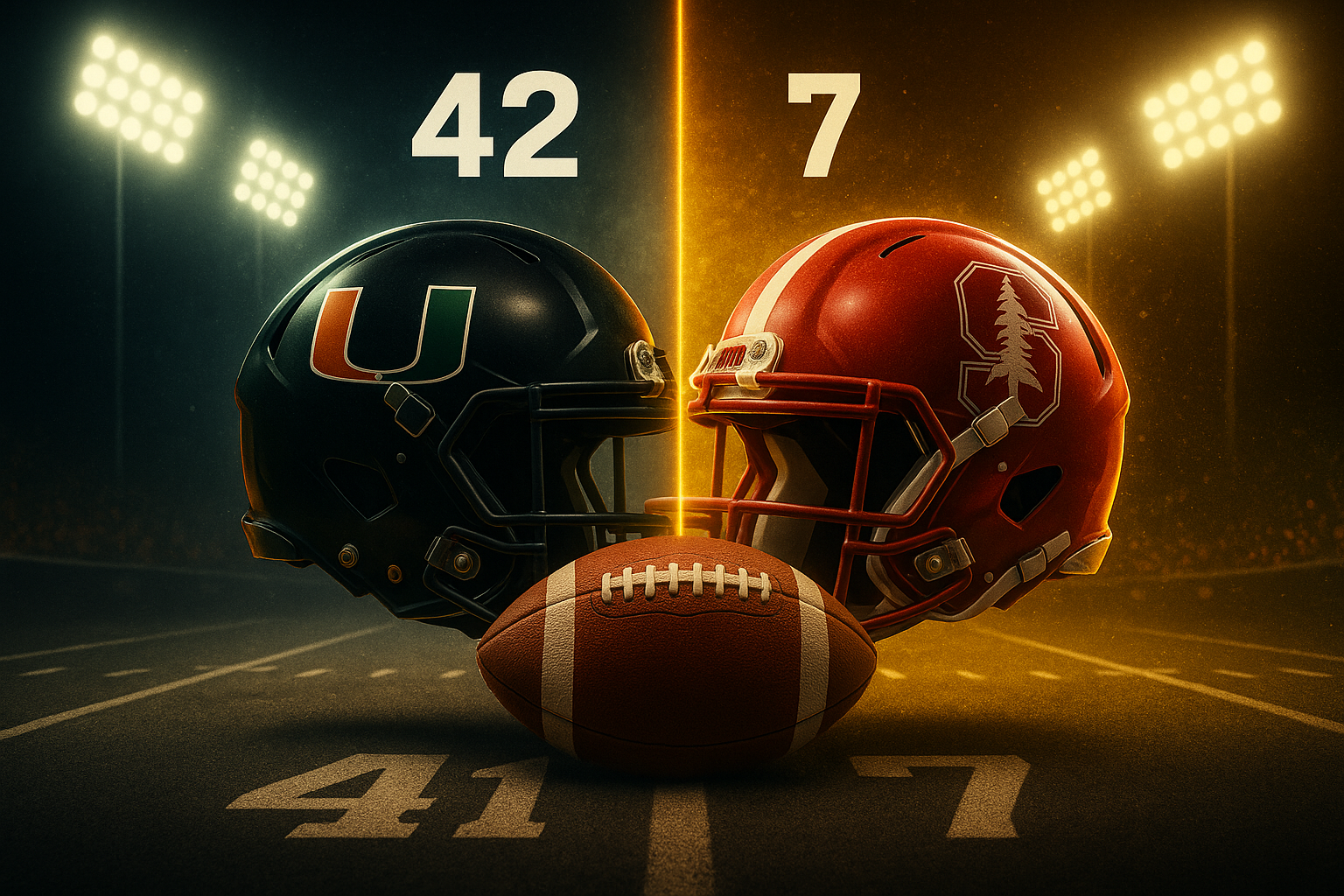
Hurricanes Turn a Halftime Tie into a Statement Victory MIAMI GARDENS, Fla. — The ninth-ranked Miami Hurricanes shook off a sluggish first half to dominate Stanford 42–7 on Saturday night at Hard Rock Stadium. Behind a career-best performance from running back Mark Fletcher Jr. , Miami scored touchdowns on six of its final seven possessions to turn a 7–7 halftime tie into a decisive rout. Fletcher led the charge with 106 rushing yards and three touchdowns , setting a new career high while powering an offense that rediscovered its rhythm. Quarterback Carson Beck bounced back from last week’s struggles, completing 21 of 28 passes for 189 yards and one touchdown , as Miami outgained Stanford 404–144 . The victory improved Miami’s record to 6–1 overall and 2–1 in ACC play , while Stanford fell to 3–5 (2–3 ACC) after being outscored 35–0 in the second half. A Flat Start for the Hurricanes The first 30 minutes were far from the dominance Miami fans expected. The Hurricanes missed an early scoring chance when kicker Carter Davis pushed a 43-yard field goal wide, ending his streak of consecutive makes. Stanford capitalized, marching 74 yards on its opening drive to take a 7–0 lead . Running back Cole Tabb kept the drive alive with a fourth-down conversion and later broke free for a 28-yard run to set up the Cardinal deep in Miami territory. Quarterback Ben Gulbranson capped the series with a nine-yard touchdown pass to Caden High , giving Stanford its first-ever lead over Miami in the programs’ inaugural meeting. Miami’s offense sputtered through much of the half, plagued by penalties and missed assignments. But the Hurricanes’ defense found its footing, forcing multiple three-and-outs while neutralizing Stanford’s ground attack. Late in the second quarter, Miami finally broke through — Beck connected with CJ Daniels on a third-down fade for a six-yard touchdown to tie the game 7–7 heading into halftime. Hurricanes Flip the Script After the break, Miami looked like a completely different team. The defense forced a quick punt on Stanford’s first possession, and Malachi Toney delivered a 31-yard punt return to set up prime field position. Two plays later, Beck found Tony Johnson on a 22-yard crossing route, and Fletcher finished the drive with back-to-back short-yardage runs, including a one-yard plunge that gave Miami its first lead at 14–7 . From that moment forward, the Hurricanes dominated every phase. Their defense smothered Stanford, holding the Cardinal to just 25 total yards across their next eight possessions. Miami’s defensive front — led by Armando Blount and Wesley Bissainthe — relentlessly pressured Gulbranson into hurried throws and costly mistakes. Midway through the third quarter, Bissainthe intercepted a deflected pass and returned it to the Stanford three-yard line. Fletcher scored one play later for his second touchdown, extending the lead to 21–7 . On Stanford’s next series, Xavier Lucas picked off another pass and returned it to the 45-yard line. Four plays — all Fletcher runs — later, the sophomore tailback powered into the end zone again to make it 28–7 and put the game firmly out of reach. Total Control in the Fourth Quarter By the start of the fourth quarter, Miami had completely taken command. The Hurricanes controlled the ball for nearly 37 minutes , wearing down Stanford’s defense and dictating the tempo. Beck continued to find his rhythm, going 4-for-4 through the air on an eight-play, 76-yard drive capped by a 17-yard touchdown run from Jordan Lyle , stretching the lead to 35–7 . Backup quarterback Emory Williams entered late and guided one final scoring march, ending with a short touchdown by Girard Pringle Jr. to seal the 42–7 victory — Miami’s largest ACC win since 2021. Defensive Masterclass While the offense exploded in the second half, it was Miami’s defense that set the tone for the turnaround. After allowing 74 yards on Stanford’s opening drive, the Hurricanes surrendered just 70 total yards the rest of the game. Linebacker Bissainthe and cornerback Lucas each recorded interceptions that directly led to touchdowns. Blount anchored the defensive front with a key sack early in the third quarter, helping Miami finish with six tackles for loss , two sacks , and a suffocating 2.7 yards per play allowed . Gulbranson managed just 50 passing yards after the opening drive and finished with two interceptions. The Hurricanes’ secondary blanketed receivers, while the front seven stuffed Tabb , holding him to 64 yards on 13 carries . Cornerback Keionte Scott led Miami’s defense with five tackles, and the unit’s discipline and speed frustrated Stanford throughout the second half. Special Teams Spark Special teams provided the spark that shifted momentum. Malachi Toney totaled 73 punt return yards on just two attempts, including a 42-yard return that set up one of Fletcher’s touchdowns. Toney’s field-flipping returns energized the crowd of 63,892 and consistently gave Miami short fields. He also led the Hurricanes with five receptions for 52 yards , showcasing his growing impact on both offense and special teams. Historical Context and Momentum The 42–7 victory marked the first-ever meeting between Miami and Stanford and stood as one of the Hurricanes’ most complete performances in recent memory. Miami has now outscored opponents 118–27 in the second half over its last four wins, highlighting the team’s ability to adjust and finish strong. It was also a breakout game for Fletcher , who entered the night averaging just over four yards per carry but erupted for multiple long gains against one of the Pac-12’s more physical defenses. His three-touchdown effort tied Miami’s single-game high for the season and cemented his role as the team’s offensive centerpiece. For Beck , the outing served as redemption after a four-interception performance against Louisville. His accuracy and composure restored confidence in the passing attack, while the offense’s balance — 205 passing yards and 199 rushing yards — underscored Miami’s versatility. Stanford’s Struggles Continue Stanford’s early promise quickly faded as Miami tightened its grip. After their opening touchdown, the Cardinal managed just two first downs the rest of the night. Penalties, poor pass protection, and inconsistent execution left the offense stagnant. The loss dropped Stanford to 3–5 (2–3 ACC) with three of its last four games at home. Despite flashes of potential from Tabb and High , the Cardinal continue to struggle generating offense on the road, where they remain winless in conference play this season. Looking Ahead Miami now turns its attention to a road matchup against SMU in Dallas — its first out-of-state game this season. The Mustangs enter on a three-game winning streak and are undefeated at home, setting up a key test for the Hurricanes’ renewed momentum. If Miami can replicate the balance and intensity it displayed against Stanford, the Hurricanes’ path toward national contention will remain wide open. Final Takeaway After a sluggish first half, the Miami Hurricanes unleashed a second-half masterpiece — a blend of aggression, execution, and dominance. The 42–7 win over Stanford showcased everything this team can be when firing on all cylinders. With Fletcher leading the ground attack, Beck regaining his confidence, and a defense that refused to bend , Miami reasserted itself as a legitimate ACC and national contender . The second half wasn’t just dominant — it was a statement of how high this team’s ceiling truly is.
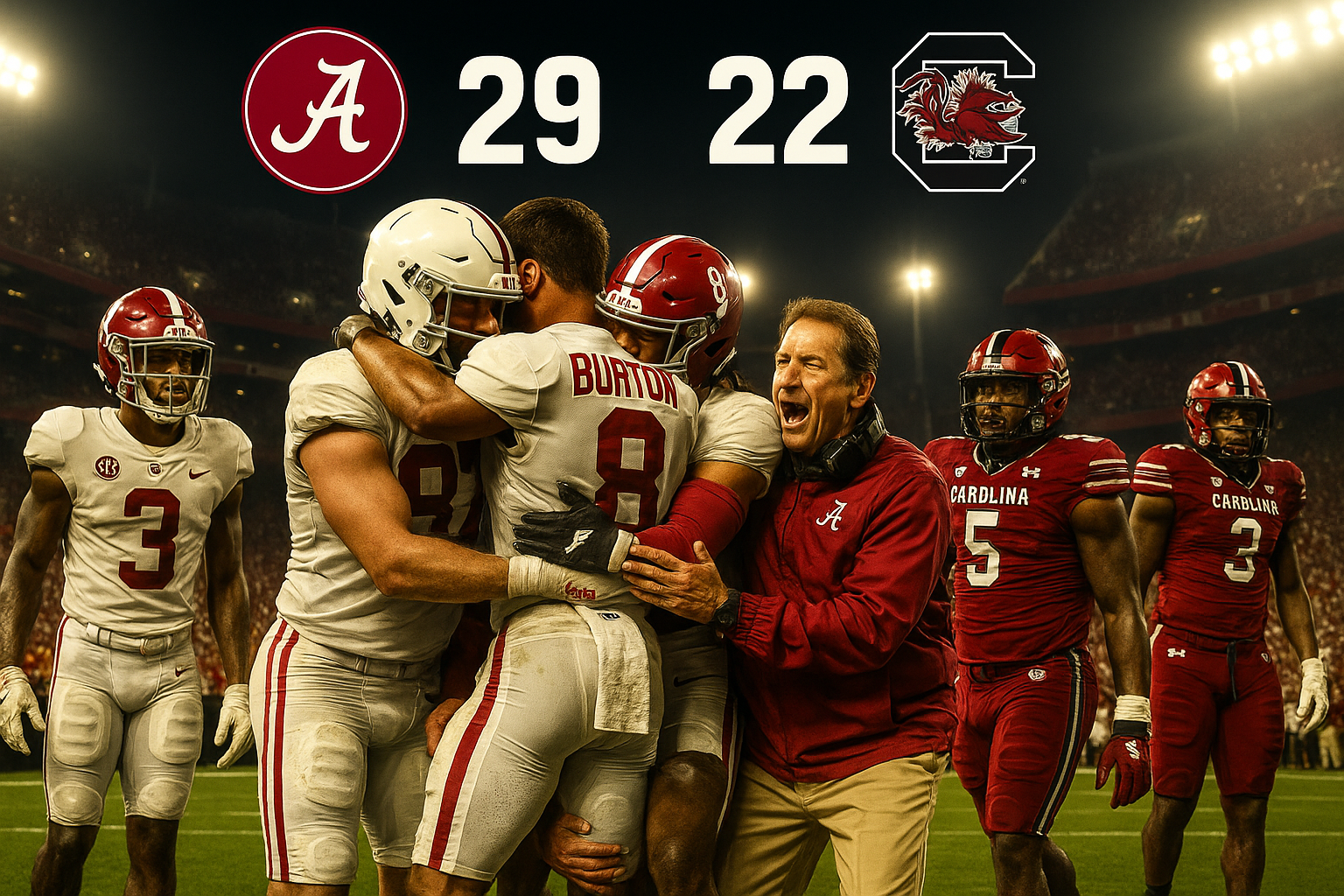
Crimson Tide Overcome Eight-Point Fourth-Quarter Deficit to Earn Seventh Straight Win COLUMBIA, S.C. — The No. 4 Alabama Crimson Tide kept their championship hopes alive Saturday afternoon with a 29–22 comeback victory over South Carolina at Williams-Brice Stadium. Behind a late surge from quarterback Ty Simpson and wide receiver Germie Bernard , Alabama scored 15 unanswered points in the final two and a half minutes to secure its seventh consecutive win. The victory improved Alabama’s record to 7–1 overall and 5–0 in the Southeastern Conference (SEC) , maintaining control of the SEC West standings . South Carolina fell to 3–5 (1–5 SEC) despite leading for much of the second half. Early Defensive Statement The opening quarter set the tone for a defensive battle as both teams traded punts before South Carolina struck first. A 15-play, 74-yard drive that drained more than seven minutes off the clock ended with a 24-yard field goal by William Joyce , giving the Gamecocks a 3–0 advantage. Alabama responded on defense. On South Carolina’s next possession, linebacker DaShawn Jones intercepted quarterback LaNorris Sellers on a tipped pass and returned it 18 yards for a touchdown , giving the Tide a 7–3 lead. The play marked Alabama’s second straight game with a defensive touchdown, continuing its streak of opportunistic defensive play. Midway through the second quarter, the Gamecocks cut the deficit to 7–6 on another Joyce field goal following a 14-play, 42-yard drive. But Alabama’s offense finally found its rhythm late in the half. Simpson engineered a nine-play, 81-yard drive capped by a three-yard touchdown pass to Josh Cuevas , extending Alabama’s lead to 14–6 at halftime . South Carolina Surges Ahead The second half swung dramatically in South Carolina’s favor. On the first play from scrimmage, Sellers connected with freshman Nyck Harbor for a 54-yard touchdown , cutting Alabama’s lead to 14–12 after a failed two-point try. The explosive play reignited the crowd and gave South Carolina momentum. The Gamecocks’ defense kept that energy going, holding Alabama scoreless on its next three drives and forcing consecutive punts. Taking advantage of field position, South Carolina took its first lead of the game on a 47-yard field goal by Joyce late in the third quarter, moving ahead 15–14 . Moments later, Alabama suffered a major special teams miscue. A punt deflected off a Crimson Tide player, gifting South Carolina possession at the 30-yard line. Six plays later, Sellers scrambled into the end zone from ten yards out to extend the lead to 22–14 with 10 minutes remaining. Williams-Brice Stadium erupted as the Gamecocks appeared poised for an upset — but Alabama, true to form, refused to fold. Tide Rally in the Final Minutes Trailing by eight, Alabama mounted a season-defining drive. Simpson led a 14-play, 79-yard march that chewed up more than six minutes of game time. On third-and-goal, he found Bernard in the corner of the end zone for a four-yard touchdown . The Tide then executed a flawless two-point conversion, with Simpson hitting Cuevas to tie the game 22–22 with just 2:16 remaining . On South Carolina’s ensuing possession, Alabama’s defense came up big again. Linebacker Deontae Lawson stripped Sellers near midfield, and the Tide recovered the fumble at the Gamecocks’ 38-yard line. Five plays later, Bernard took a direct snap and sprinted 25 yards down the sideline for the go-ahead touchdown with only 34 seconds left . His second score of the day capped Alabama’s furious rally — the program’s largest comeback since 2021 — and silenced the home crowd. South Carolina’s final drive stalled at midfield as Alabama’s pass rush closed out the win. Key Performances Ty Simpson completed 24 of 43 passes for 253 yards and two touchdowns , marking his eighth straight game with multiple touchdown passes. His poise under pressure was crucial, converting four third downs on the tying drive and distributing the ball to five different receivers. Germie Bernard continued his breakout campaign, finishing with five receptions for 54 yards and a receiving touchdown, plus three carries for 23 yards and the game-winning rushing score. His versatility has made him one of Alabama’s most dynamic playmakers this season. Freshman Daniel Hill posted a career-high 76 receiving yards on four catches, including a 41-yard grab that sparked a key second-quarter drive. Ryan Williams added seven receptions for 72 yards to lead the team in catches. Defensively, Lawson’s forced fumble sealed the win, while Jones’ pick-six provided an early spark. Alabama’s defense registered seven tackles for loss , four quarterback hurries , and five pass breakups . Special teams also delivered, as punter Blake Doud averaged 55.4 yards on five punts , including a 60-yarder that flipped field position in the third quarter. South Carolina’s Missed Opportunities Despite flashes of brilliance, South Carolina’s mistakes proved costly. The Gamecocks committed two holding penalties that wiped out touchdowns and missed an early 35-yard field goal. LaNorris Sellers passed for 222 yards and one touchdown while adding 67 rushing yards and another score , but his late fumble sealed the team’s fate. Freshman receiver Nyck Harbor stood out with a career-long 54-yard touchdown, though South Carolina’s offense struggled to sustain drives in the second half. The Gamecocks ultimately could not capitalize on opportunities, allowing Alabama’s late surge to turn the game around. A Statement of Resilience Alabama’s 15-point burst in the closing minutes underscored the team’s mental toughness and balance. The Crimson Tide outgained South Carolina 117–2 in total yardage over the final 10 minutes, completely controlling both lines of scrimmage down the stretch. The comeback was Alabama’s largest since overcoming a 10-point deficit in 2021 and reflected the maturity and cohesion of a team built to withstand adversity. For head coach Kalen DeBoer , the victory reinforced the Tide’s identity — a blend of discipline, depth, and confidence under pressure . Each of Alabama’s last three road wins has come after trailing in the second half, a testament to the program’s resilience and championship DNA. Looking Ahead Alabama enters a much-needed bye week before hosting No. 20 LSU on November 8 in Tuscaloosa. The matchup will have major implications for the SEC West race , with both teams still in contention for a spot in the conference championship game. South Carolina will travel to No. 8 Ole Miss next weekend, looking to bounce back after consecutive heartbreaking defeats. The Gamecocks will need cleaner execution and improved consistency to keep their postseason hopes alive. Final Takeaway Alabama’s 29–22 victory over South Carolina served as another reminder of why the Crimson Tide remain among college football’s elite. Facing adversity on the road, they delivered a textbook display of poise and execution when it mattered most. With Simpson’s leadership , Bernard’s explosiveness , and a defense that thrives in crunch time, Alabama continues to prove its “ unbreakable ” mantra is more than just a slogan — it’s a standard. As the Tide head into November atop the SEC West, their comeback in Columbia wasn’t just another win — it was a statement of championship resolve .
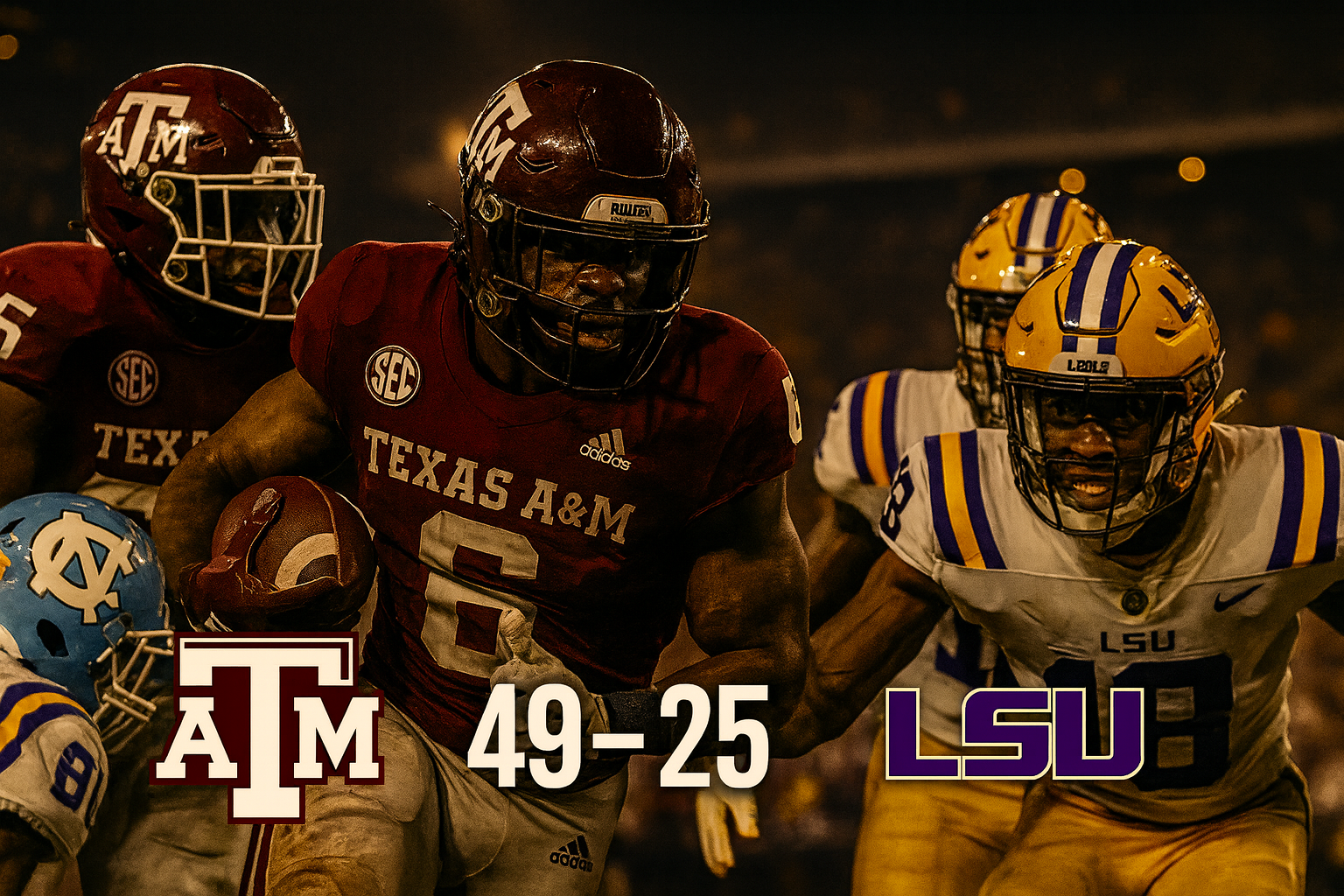
Marcel Reed and KC Concepcion Lead the Aggies’ Second-Half Surge BATON ROUGE, La. — The No. 3 Texas A&M Aggies continued their unbeaten run through the SEC with a commanding 49–25 victory over No. 20 LSU on Saturday night at Tiger Stadium. Quarterback Marcel Reed accounted for four touchdowns — two rushing and two passing — while KC Concepcion totaled 177 all-purpose yards and two scores as the Aggies turned a halftime deficit into a dominant second-half performance. The win improved Texas A&M to 8–0 overall and 5–0 in SEC play , marking the program’s best start since 1992 and its first victory in Baton Rouge in over 30 years. Early Fireworks in Death Valley The opening half featured highlight plays, special teams drama, and momentum swings that energized the packed Tiger Stadium crowd. Texas A&M struck first when Reed burst through the LSU defense for a 41-yard touchdown run , giving the Aggies an early 7–0 lead. LSU quickly countered with a 74-yard scoring drive , capped by Garrett Nussmeier’s five-yard touchdown pass to Trey’Dez Green to even the score at 7–7 . Late in the first quarter, Reed found Concepcion on a 15-yard touchdown pass , putting A&M ahead 14–7 and capping a crisp 75-yard drive. The Tigers responded with big plays on defense and special teams in the second quarter to regain control. Jhase Thomas blocked a punt through the end zone for a safety, narrowing the gap to 14–9 , before A.J. Haulcy intercepted Reed in the end zone to halt another Aggie drive. LSU capitalized on the turnover with Harlem Berry’s seven-yard touchdown run , taking a 15–14 lead after a missed extra point. Moments later, linebacker Harold Perkins Jr. intercepted a tipped pass, setting up a 30-yard field goal by Damian Ramos to extend LSU’s lead to 18–14 . The Tigers carried that advantage into halftime, appearing poised for an upset. Aggies Take Control After the Break Texas A&M came out of the locker room with renewed focus and fire. On the first possession of the second half, Reed led a nine-play, 56-yard drive , finishing it himself with a five-yard touchdown run to put the Aggies back in front 21–18 . The defense immediately followed with a three-and-out, setting up a game-changing special teams play. Concepcion fielded a punt near his own 20-yard line, weaved through defenders, and sprinted 79 yards down the sideline for a punt return touchdown that stunned the LSU crowd and gave A&M a 28–18 lead. Midway through the third quarter, Reed found Jamarion Morrow for a 24-yard touchdown , extending the Aggies’ advantage to 35–18 . The offense, which had sputtered early, found rhythm and explosiveness as the Tigers’ defense began to tire. Defense Dominates the Second Half While the Aggies’ offense came alive, their defense completely shut down LSU after halftime. Texas A&M sacked Nussmeier seven times and logged 11 tackles for loss , suffocating LSU’s attack and seizing control of the line of scrimmage. Defensive end Cashius Howell continued his breakout season with two sacks , raising his total to 9.5 on the year — the most by an Aggie since 2017. Safety Dalton Brooks recorded six tackles and helped anchor the secondary, while linebacker Chris Russell Jr. stuffed multiple rushing attempts on early downs. The relentless pressure forced LSU into long-yardage situations throughout the half. Early in the fourth quarter, Nate Boerkircher powered in for a one-yard touchdown run , stretching the lead to 42–18 . Five minutes later, Morrow scored again — this time on an 11-yard run , his first career rushing touchdown — to make it 49–18 and effectively end the contest. LSU added a late score when Kyle Parker caught an 11-yard pass from Rickie Collins , closing the gap to 49–25 . Reed’s Historic Night Marcel Reed turned in one of the most complete performances of his young career. He became the first Aggie since Johnny Manziel in 2012 to record at least two passing and two rushing touchdowns in a true road game. Reed completed 12 of 21 passes for 202 yards and rushed for 108 yards on 12 carries , averaging more than nine yards per attempt. His ability to extend plays, evade pressure, and make throws on the move kept LSU’s defense off balance. The sophomore’s dual-threat command has transformed A&M into one of the most dynamic offenses in the SEC. Saturday marked the seventh straight game in which the Aggies surpassed 400 total yards , continuing a streak that underscores their offensive balance and efficiency. Concepcion’s Breakout and Special Teams Impact KC Concepcion delivered a complete performance that showcased his versatility. He finished with 177 all-purpose yards , including a 15-yard touchdown reception and a 79-yard punt return score that shifted the game’s momentum. Concepcion’s return marked Texas A&M’s first special teams touchdown of the season and reflected the Aggies’ renewed focus on field position and execution. Morrow contributed 35 receiving yards and two touchdowns, while Boerkircher added a short-yardage score. The Aggies averaged seven yards per play on 61 offensive snaps , demonstrating both precision and explosiveness. LSU’s Missed Opportunities For LSU, the loss was a frustrating example of squandered momentum. The Tigers produced 18 first-half points with strong defensive play and special teams but were overwhelmed after halftime. Nussmeier finished with 168 passing yards and one touchdown , but constant pressure limited his effectiveness. Harlem Berry rushed for 66 yards and a score , while Green and Parker added touchdown receptions. The defense intercepted Reed twice in the first half but failed to force any turnovers in the second. LSU fell to 5–3 overall (2–3 SEC) , suffering its third conference loss of the year. Historical Context and Significance The 49 points were the most ever scored by Texas A&M at Tiger Stadium, breaking a program record that had stood for over 50 years. The victory marked A&M’s second straight win over LSU and the second consecutive year in which the Aggies scored more than 40 points against the Tigers. Under head coach Mike Elko , the Aggies have won back-to-back road games against ranked opponents , including recent triumphs over Notre Dame (41–40) and Arkansas (45–42) . Defensively, the team has allowed just 13 second-half points across its last two meetings with LSU, underscoring its growth into one of the nation’s most complete units. What’s Next Texas A&M enters its second bye week before closing its three-game road stretch with a trip to Missouri on November 8 . The Tigers, currently 6–2 , will be looking to rebound from a 17–10 loss to Vanderbilt. LSU will have a week off before traveling to Alabama , aiming to regroup and reignite its postseason hopes. Final Takeaway The 49–25 victory over LSU was more than just another win — it was a display of depth, resilience, and dominance. Marcel Reed’s four-touchdown effort , KC Concepcion’s explosive impact , and a relentless defensive front defined a performance that solidified Texas A&M’s place among the elite of college football. From start to finish, the Aggies showcased why the road to the SEC title may now run directly through College Station — and why this team continues to look every bit the national contender it was built to be.

Haynes King Accounts for Five Touchdowns as Yellow Jackets Improve to 8–0 ATLANTA — The seventh-ranked Georgia Tech Yellow Jackets continued their remarkable 2025 campaign with a dominant 41–16 victory over Syracuse on Saturday afternoon at Bobby Dodd Stadium. Quarterback Haynes King accounted for five total touchdowns and nearly 400 yards of offense as Georgia Tech remained undefeated through eight games for the first time since 1966 . The victory improved the Yellow Jackets to 8–0 overall and 5–0 in ACC play , their best start in nearly six decades. Syracuse fell to 3–5 overall and 1–4 in conference play after dropping its fourth straight game since the injury to quarterback Steve Angeli . King delivered another stellar performance, completing 25 of 31 passes for 304 yards and three touchdowns , while rushing for 91 yards and two scores . His command of the offense was evident from start to finish, leading scoring drives on seven of Georgia Tech’s ten possessions. His 80.6% completion rate set a new school record for a passer with at least 30 attempts. A Slow Start Before the Storm Syracuse began the afternoon with energy, forcing a turnover on Georgia Tech’s opening possession and turning it into an early field goal for a 3–0 lead . The Orange had first-and-goal at the one-yard line, but back-to-back penalties and a sack stalled the drive, forcing them to settle for three points — a missed opportunity that foreshadowed the rest of the day. From that point forward, Georgia Tech seized control. The Yellow Jackets scored the next 20 points, beginning with a pair of field goals from Aidan Birr and back-to-back touchdown passes from King to tight end Josh Beetham , who rebounded from an early drop to score his first two touchdowns of the season. Beetham’s receptions — from 21 and 13 yards out — capped off long, efficient drives that stretched the lead to 20–3 by halftime . The Yellow Jackets outgained the Orange 322–118 in the first half , dominating time of possession and limiting Syracuse to just five first downs . Despite missing two starters in the secondary, Georgia Tech’s defense forced multiple three-and-outs and stifled Syracuse’s running game before intermission. Syracuse Shows Life After the Break The Orange opened the third quarter with their best drive of the game. Quarterback Rickie Collins , starting his third consecutive contest, connected with Darrell Gill Jr. on a 34-yard touchdown down the sideline to cut the deficit to 20–10. The drive lasted just 41 seconds and briefly energized the visiting sideline. But the momentum didn’t last long. On the next possession, King responded with a 37-yard touchdown pass to Dean Patterson , reestablishing a two-score lead and silencing the Orange’s rally. From that point on, Georgia Tech controlled the game, scoring 21 of the final 27 points . Syracuse managed one final touchdown in the fourth quarter when Will Nixon scored from close range, but by then the outcome was all but decided. Georgia Tech’s defensive front sealed the win with two sacks and a key fumble recovery by Jordan Boyd midway through the second half. King’s Historic Day Saturday’s performance was another milestone in Haynes King’s breakout season. His 395 yards of total offense were a season high, and his five-touchdown outing matched his previous career best. The senior quarterback has now accounted for both a passing and rushing touchdown in 15 career games , extending his own school record . King’s balance of efficiency and explosiveness has transformed Georgia Tech’s offense into one of the ACC’s most dynamic units. His sixth career 300-yard passing game moved him into a tie for second in program history, behind only 1999 Heisman runner-up Joe Hamilton . Dean Patterson’s 37-yard score was his second of the season, while freshman Jordan Allen set career highs with six receptions for 64 yards in an expanded role due to injuries at receiver. Georgia Tech finished with 543 total yards of offense , its highest output in an ACC game in two years. Beetham’s Redemption Tight end Josh Beetham’s afternoon told a story of resilience. After dropping a potential touchdown in the first quarter, he responded with two scoring receptions in the second , giving the Yellow Jackets a 17-point cushion at halftime. The senior tight end entered the game with just three career catches but finished with the first multi-touchdown performance by a Georgia Tech tight end since 2023. Beetham’s emergence added another layer to Georgia Tech’s offensive versatility. His ability to block effectively and operate in multiple formations kept Syracuse’s defense guessing and opened space for King’s scrambles and red-zone success. Defensive Strength Despite Injuries Georgia Tech’s defense entered the game shorthanded, missing Jy Gilmore and Ahmari Harvey , and losing Zachary Tobe early to injury. Even so, the unit delivered one of its most complete performances of the season. The Yellow Jackets limited Syracuse to just 118 first-half yards and three points — the Orange’s lowest total in ACC play this year. Safety Clayton Powell-Lee led the secondary with consistent tackling and disciplined coverage, while linebacker Kyle Efford anchored the front seven with a team-high eight tackles. The defensive line controlled the trenches, highlighted by Jason Moore’s forced fumble recovered by Jordan Boyd — the first takeaway of Boyd’s career. The defense embodied the “ next man up ” mentality that has driven Georgia Tech’s unbeaten run. Despite multiple backups in the lineup, communication and physicality remained sharp from start to finish. Statistical Dominance Georgia Tech outgained Syracuse 543–381 , including a 322–118 advantage in the first half. The Yellow Jackets scored on seven of ten possessions and averaged 7.5 yards per play , their most efficient outing against an FBS opponent this season. Defensively, Tech limited Syracuse to just five third-down conversions on 14 attempts and allowed points on only three of ten drives. The victory extended Georgia Tech’s Homecoming winning streak to four straight and marked the program’s first sellout crowd for an ACC opponent in ten years , drawing 51,193 fans to Bobby Dodd Stadium. Program Milestones The Yellow Jackets’ 8–0 start is their best since the legendary 1966 season , when the program opened 9–0. It marks just the sixth 8–0 start in Georgia Tech’s 133-year football history . The team’s 5–0 ACC record is a first in program history, reflecting the steady rise under head coach Brent Key . Georgia Tech has now won seven straight ACC games , dating back to last season, and improved to 5–2 all-time against Syracuse , including 3–0 at home . The 41 points scored were their most in conference play this season. What’s Next Georgia Tech will travel to Raleigh next weekend to face NC State in a pivotal ACC matchup before entering its second bye week. The Wolfpack enter at 6–2 overall and unbeaten at home, setting up one of the toughest remaining challenges for the Yellow Jackets’ perfect record. Syracuse, meanwhile, will return home for a short turnaround to host North Carolina on Friday night, aiming to end its four-game skid and regain momentum in the ACC standings. Final Takeaway Georgia Tech’s 41–16 victory over Syracuse wasn’t just another step toward a potential ACC title run — it was a statement of balance, discipline, and maturity. Behind Haynes King’s record-setting efficiency and a defense that continues to deliver despite adversity, the Yellow Jackets proved again why they belong among college football’s elite. From start to finish, Georgia Tech displayed the poise of a team learning not just to win, but to dominate . As the Jackets head into November undefeated , one thing is clear: history isn’t just within reach — it’s being rewritten on The Flats.
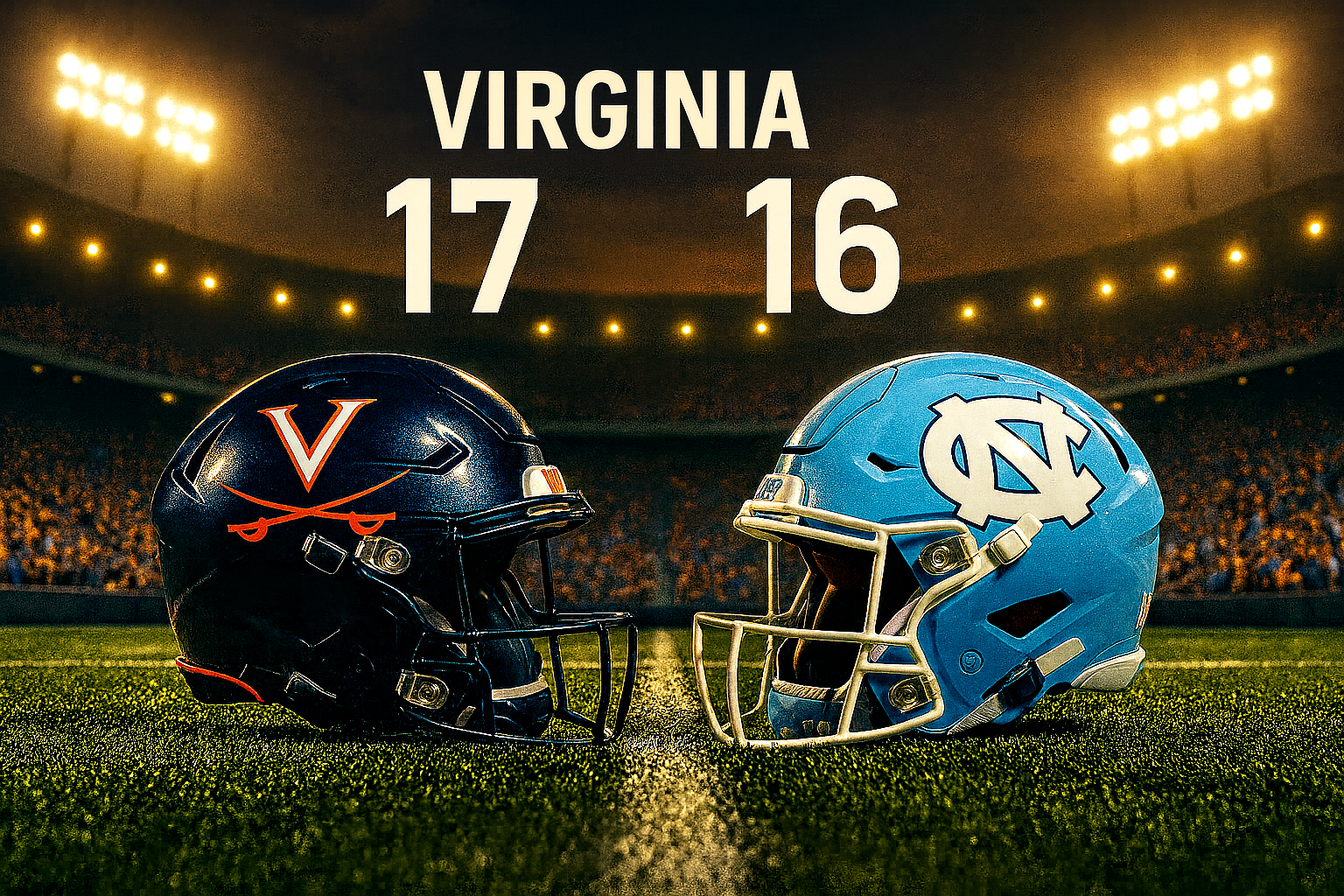
Cavaliers Extend Win Streak to Six with Another Overtime Classic CHAPEL HILL, N.C. — For the third time this season, No. 16 Virginia found itself in overtime. And for the third time, the Cavaliers came out on top. On a crisp fall afternoon at Kenan Stadium, Virginia outlasted North Carolina 17–16 after stopping a two-point conversion attempt just short of the goal line, securing its sixth straight victory and remaining unbeaten in ACC play . The Cavaliers improved to 7–1 overall and 4–0 in conference play — their best start since 2007 — and extended their dominance in the South’s Oldest Rivalry with a fourth win in their last five visits to Chapel Hill. Running back J’Mari Taylor powered across the goal line for the go-ahead score in overtime, capping a resilient day for an offense that battled through an aggressive Tar Heel pass rush. Quarterback Chandler Morris threw for 200 yards and one touchdown, while Virginia’s defense once again proved decisive, forcing two key interceptions and shutting down North Carolina’s late surge. A Defensive Struggle from the Start Neither team found much rhythm early, with field position and turnovers shaping the flow of the game. Virginia struck first on a 34-yard field goal by Will Bettridge , following a red-zone fumble by UNC wide receiver Kobe Paysour that resulted in a touchback. The Cavaliers’ early lead held until the second quarter, when both offenses began to find momentum. Morris connected with Trell Harris on a 30-yard touchdown midway through the second quarter, giving Virginia a 10–3 advantage. Harris, one of the ACC’s most reliable deep threats, led the team with four catches for 72 yards. North Carolina quickly responded with a one-yard quarterback keeper by Gio Lopez to tie the score at 10–10 heading into halftime. From there, both defenses tightened. Neither team scored in the third or fourth quarters. North Carolina’s front, led by Melkart Abou Jaoude , recorded six sacks , while Virginia’s defense countered with three sacks and two takeaways to keep the game deadlocked. Virginia’s Defense Holds the Line The Cavaliers’ defensive front stood tall throughout the afternoon, limiting big plays and forcing crucial mistakes. Linebacker Kam Robinson recorded a career-high 13 tackles , while edge rusher Mitchell Melton made one of the game’s biggest plays late in the third quarter — intercepting Lopez near the goal line after deflecting his own pass. Melton’s interception prevented what could have been a go-ahead North Carolina score, marking the second straight week he recorded a takeaway. Safety Antonio Clary added another interception at the end of regulation, ensuring the game would head to overtime. Virginia’s defense forced six three-and-outs and held North Carolina to 353 total yards despite long stretches of possession. The Cavaliers have now forced at least one turnover in five consecutive games , all of which have resulted in victories. Taylor Finishes the Job in Overtime After winning the coin toss, North Carolina elected to play defense first. Virginia wasted little time capitalizing. Starting at the 25-yard line, Morris found Sage Ennis for a nine-yard completion, followed by short runs from Taylor that set up first-and-goal from the three. On a direct snap, Taylor powered through the middle for a one-yard touchdown — his ninth rushing score of the season and his second overtime game-winner of the year. Bettridge’s extra point put the Cavaliers ahead 17–10. North Carolina answered immediately as Lopez connected with Davion Gause for a nine-yard touchdown, trimming the margin to 17–16. Rather than attempt the extra point to extend the game, the Tar Heels opted for a two-point conversion and the win. On the decisive play, Lopez rolled right and threw to running back Benjamin Hall in the flat. Cornerback Emmanuel Karnley delivered the initial hit near the sideline, and nickelback Ja’son Prevard finished the tackle inches short of the goal line. The Virginia sideline erupted as the officials signaled the stop, sealing another overtime win for the Cavaliers. Complementary Football Defines Virginia’s Season Head coach Tony Elliott’s Cavaliers have developed a reputation for thriving under pressure. All three of Virginia’s overtime wins this season — against Florida State, Louisville, and now North Carolina — have come by a combined margin of just six points. Saturday’s win showcased the team’s commitment to complementary football . The offense did just enough behind Morris’s leadership, while the defense and special teams delivered game-saving plays. Punter Daniel Sparks had one of his best performances of the year, averaging nearly 49 yards per punt across eight attempts and repeatedly flipping field position. Freshman returner Jayden Thomas , filling in for the injured Cam Ross , contributed 58 return yards , including a 31-yard burst that sparked the Cavaliers’ sideline. North Carolina’s Missed Chances The Tar Heels controlled time of possession and outgained Virginia in total yards, but red-zone inefficiency proved costly. UNC turned the ball over twice inside the 10-yard line and came away empty on two other scoring opportunities. Quarterback Gio Lopez finished with 208 passing yards and one touchdown, but two interceptions and a late fumble reversal undermined the team’s consistency. Despite a strong showing from freshman receiver Madrid Tucker , who caught eight passes in his collegiate debut, North Carolina’s inability to finish drives ultimately defined the game. The loss dropped the Tar Heels to 2–5 overall and 0–3 in the ACC , extending their losing streak to four games — three of which have come by a single score. Historical and Program Context Virginia’s win carried significant historical weight. The Cavaliers have now won six straight games for the first time since 2007 and are off to their best ACC start under Elliott . The program’s 60th all-time victory over North Carolina also marked its most against any opponent in school history. The matchup was the 130th meeting in the South’s Oldest Rivalry , tying Georgia–Auburn for the second-most played series in FBS history. Virginia’s success in Chapel Hill continued an impressive run, with the Cavaliers now winning four of their last five at Kenan Stadium — including last season’s upset of then-No. 10 North Carolina, their first road win over a top-10 team in program history. Virginia’s defense has been particularly dominant late in games. The Cavaliers have not allowed a fourth-quarter touchdown in their last three contests and have outscored opponents 38–19 in that span, extending to 62–31 when including overtime periods. Looking Ahead The Cavaliers’ remarkable season now heads west for another first-time meeting. Next weekend, Virginia travels to Berkeley, California , to face the California Golden Bears in a matchup between two of the nation’s top public universities. Cal enters the contest 5–3 after a double-overtime loss to Virginia Tech. With Virginia and Georgia Tech standing as the ACC’s only unbeaten teams in conference play, the Cavaliers’ showdown in Berkeley could shape their pursuit of a berth in the ACC Championship Game and national recognition inside the top 15. Final Takeaway Saturday’s 17–16 overtime victory was another chapter in Virginia’s season of resilience and composure . The Cavaliers once again found themselves pushed to the brink — and once again, they responded with poise and toughness. From Taylor’s determined touchdown run to Prevard’s goal-line tackle , every inch mattered. In a year defined by narrow margins and high-pressure finishes, Virginia has built an identity on finding ways to win — no matter how long it takes.

Pavia’s Dual-Threat Brilliance Lifts Commodores to Historic Victory NASHVILLE, Tenn. — No. 17 Vanderbilt continued its stunning 2025 season with a 31–24 win over No. 10 LSU on Saturday afternoon at FirstBank Stadium. Quarterback Diego Pavia accounted for three touchdowns and 246 total yards, guiding the Commodores to their first victory over LSU in 35 years and matching their best start since 1950 . The victory moved Vanderbilt to 6–1 overall and 3–1 in SEC play , clinching bowl eligibility for a second straight season — the program’s first back-to-back postseason appearance since 2013. The Commodores also earned their second win over a top-15 opponent this year, marking a milestone in school history. Pavia completed 14 of 22 passes for 160 yards and one touchdown while rushing for 86 yards and two more scores. Running back Sedrick Alexander added a goal-line touchdown, and tight end Cole Spence recorded his first career touchdown reception to cap a balanced Vanderbilt offensive effort. First Quarter: Trading Blows Early LSU opened the afternoon with an efficient first drive led by quarterback Garrett Nussmeier , moving into Vanderbilt territory behind quick passes to Kyle Parker and Barion Brown . The Tigers settled for a 48-yard field goal from Damian Ramos , taking an early 3–0 lead. Vanderbilt responded immediately. Pavia ignited the offense with a 20-yard scramble before plunging into the end zone from the one-yard line, capping a 57-yard drive to give the Commodores a 7–3 advantage late in the opening quarter. The drive featured a steady rhythm of designed quarterback runs and short passes, establishing Vanderbilt’s physical tone early. Second Quarter: Momentum Swings Back and Forth LSU regained the lead seconds into the second quarter when Nussmeier hit freshman tight end Trey’Dez Green on a 24-yard strike over the middle, putting the Tigers up 10–7 . But Vanderbilt’s response was methodical and relentless — a 14-play, 75-yard drive that consumed nearly nine minutes of clock. Alexander finished the marathon possession with a one-yard touchdown run on fourth down, restoring Vanderbilt’s lead at 14–10 with 5:52 left in the half. LSU’s offense continued to move the ball efficiently but failed to convert in key moments. Ramos hit a 42-yard field goal just before halftime, trimming the deficit to 14–13 . However, the Commodores regained control with a late 46-yard field goal from Brock Taylor , who extended his streak to 17 consecutive makes, sending Vanderbilt into the locker room up 17–13 . Third Quarter: Pavia Takes Over Vanderbilt opened the second half with another statement drive. Pavia orchestrated a 75-yard march capped by a one-yard touchdown pass to Spence — the sophomore tight end’s first career score — to extend the lead to 24–13 . LSU struck back quickly. On the very next series, Nussmeier connected with Zavion Thomas for a 62-yard touchdown catch, trimming the margin to 24–21 after converting a two-point try to Green. But Vanderbilt’s quarterback answered in emphatic fashion. With under a minute left in the quarter, Pavia broke free for a 21-yard touchdown run , racing into the end zone and striking a Heisman pose as the crowd erupted. His second rushing score gave the Commodores a 31–21 advantage entering the fourth quarter and punctuated one of the most efficient performances of his Vanderbilt career. Fourth Quarter: Vanderbilt Finishes Strong The final frame tested Vanderbilt’s composure. LSU mounted one last surge, sparked by a 51-yard burst from Caden Durham that set up first-and-goal at the one-yard line. But penalties and stout defense forced the Tigers to settle for another short field goal from Ramos, cutting the lead to 31–24 with 11:39 to play. That was as close as LSU would get. The Commodores’ defense, anchored by Langston Patterson and Joshua Singh , delivered in the clutch. A fourth-quarter sack from Zaylin Wood halted LSU’s final threat, forcing a punt with eight minutes left. Vanderbilt’s offense milked the clock behind Alexander’s tough runs, and Pavia’s mobility kept the chains moving until the final seconds ticked away. When the final whistle blew, Vanderbilt’s players erupted in celebration as “Callin’ Baton Rouge” blared through the stadium speakers — a symbolic gesture marking the end of the Commodores’ 10-game losing streak to LSU. Offensive Balance and Efficiency The Commodores finished with 399 total yards , their most against an SEC opponent this season. They dominated time of possession, holding the ball for 36 minutes and 33 seconds — nearly 13 minutes more than LSU. Pavia was efficient throughout, responsible for three touchdowns and continuing his streak of recording at least one rushing or passing score in 25 consecutive games — the second-longest active streak in the FBS. His chemistry with Spence and wideout Makhilyn Young allowed Vanderbilt to control tempo and keep LSU’s defense on its heels. Alexander also continued his productive season with his 10th total touchdown and fifth on the ground, moving into eighth place on Vanderbilt’s all-time career rushing touchdown list. Defense Rises to the Moment Defensively, Vanderbilt’s front seven delivered one of its most complete performances of the season. Patterson led the team with five tackles, while Singh contributed four stops and 1.5 tackles for loss. Khordae Sydnor extended his streak to six consecutive games with a tackle for loss, and transfer Keanu Khot notched his first sack as a Commodore. The defense limited LSU to 100 rushing yards — 59 of which came on one play — and forced the Tigers to settle for field goals on four different red-zone trips. The containment of LSU’s running game proved pivotal, forcing Nussmeier into long passing situations that Vanderbilt’s secondary handled with discipline. A Historic Benchmark for the Program Saturday’s win carried immense historical weight for Vanderbilt football. The 6–1 start is the best in 75 years, dating back to 1950, and the first time the Commodores have beaten two ranked teams in the same season since 2008. It also marked their first victory over an AP Top 10 opponent since upsetting No. 1 Alabama last season. Head coach Clark Lea has now guided Vanderbilt to back-to-back bowl appearances for the first time since 2013 and has reestablished the program’s identity around toughness and discipline. The Commodores’ 31 points were also the most scored against LSU’s top-five ranked defense this season, further underscoring their offensive efficiency. For LSU, the loss dropped the Tigers to 5–2 (2–2 SEC) , extending a frustrating pattern of inconsistency. Despite 225 passing yards and two touchdowns from Nussmeier, LSU’s inability to sustain drives and capitalize inside the 20-yard line defined the game’s outcome. What’s Next Vanderbilt will return home next weekend to face No. 16 Missouri in another pivotal SEC matchup. With momentum building and postseason security already achieved, the Commodores have positioned themselves as one of the conference’s most intriguing storylines entering the second half of the season. LSU will regroup before traveling to College Station for a showdown with No. 4 Texas A&M , needing a win to remain in the SEC West race. Final Takeaway Vanderbilt’s 31–24 victory over LSU wasn’t just another upset — it was a validation of a program transformed . From Pavia’s dynamic leadership to a defense that thrived under pressure, the Commodores played with poise, control, and conviction. For the first time in decades, Vanderbilt football isn’t just competing — it’s contending . And on a sunlit Saturday in Nashville, the Commodores reminded the SEC that their climb back to relevance is no fluke.
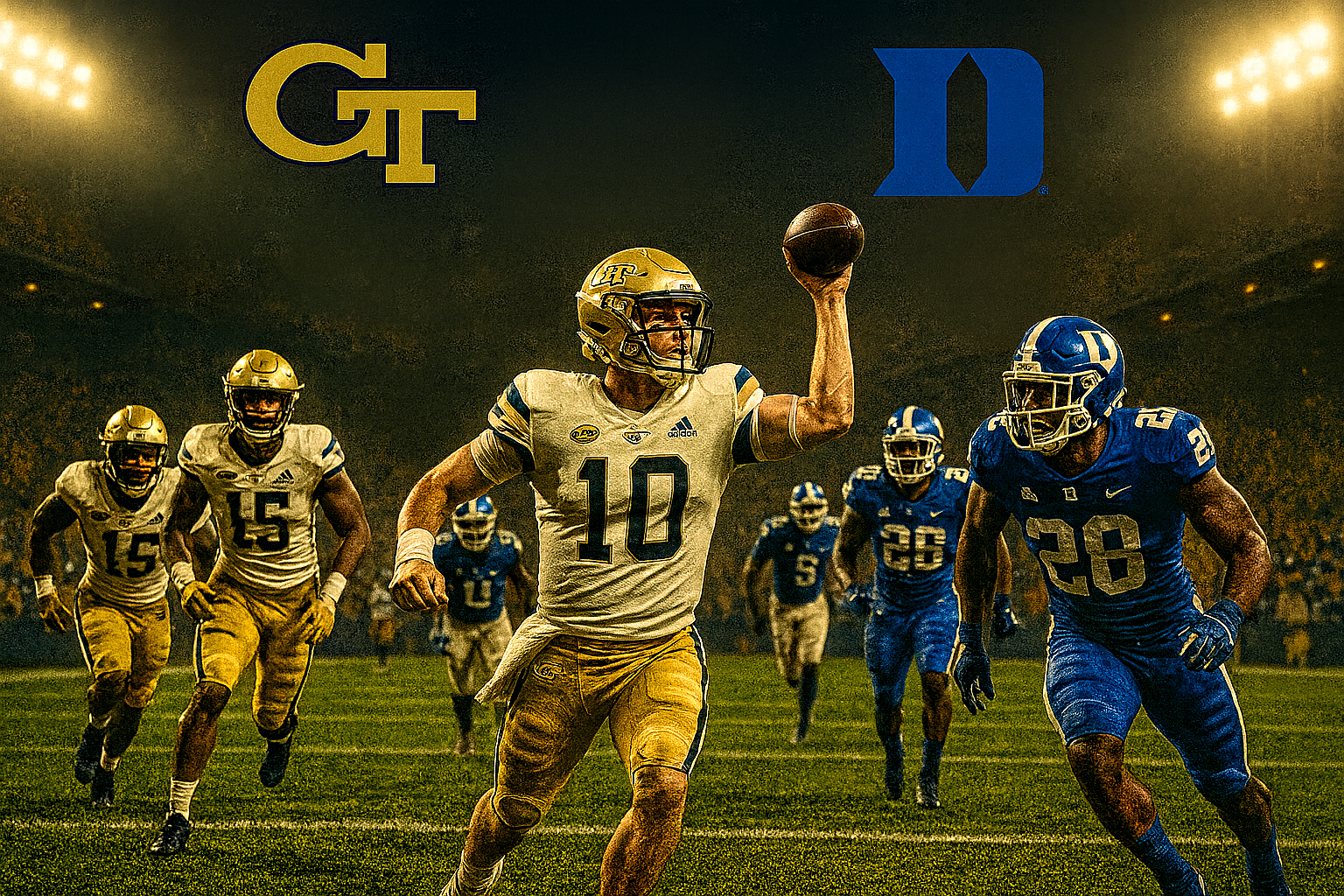
Daniels’ Record Fumble Return and King’s Late Touchdown Keep Jackets Perfect DURHAM, N.C. — No. 12 Georgia Tech stayed unbeaten Saturday afternoon, defeating Duke 27–18 at Wallace Wade Stadium to move to 7–0 for the first time since 1966 . Fueled by a record-setting defensive play from Omar Daniels and a late surge from quarterback Haynes King , the Yellow Jackets remained perfect through four Atlantic Coast Conference games. The win also marked Georgia Tech’s fifth straight victory over Duke and its longest such streak since 2013. It was a tale of two halves — a defensive struggle early and an offensive showcase late — as the Jackets turned a 7–7 halftime tie into a convincing road win. Early Defense Defines the First Half Both teams opened strong defensively, forcing each other into long drives without points. Duke appeared poised to strike first midway through the opening quarter after a 71-yard march led by quarterback Darian Mensah and wide receiver Cooper Barkate , who repeatedly found soft spots in Georgia Tech’s secondary. But just as the Blue Devils reached the 1-yard line, Daniels delivered the play of the game — scooping up a fumble and racing 95 yards down the sideline for a touchdown , the longest fumble return in school history. The score was Georgia Tech’s first defensive touchdown on a fumble return since 2021 and gave the visitors a 7–0 lead. Duke’s next possession ended with a missed field goal from 35 yards, and both teams traded empty drives until the final minute of the half. Duke finally broke through just before the break, tying the game with a precise 80-yard drive capped by a 20-yard touchdown catch by Landen King . At halftime, the game stood deadlocked at 7–7 , despite Duke outgaining Georgia Tech 238–110 and dominating time of possession. Jackets Adjust and Find Rhythm Georgia Tech entered the second half needing a spark on offense, and King delivered it. After Duke took its first lead of the game on a short field goal, the Jackets responded with their best drive of the day — a 63-yard march that ended with a 40-yard field goal from Aidan Birr , knotting the score at 10–10 midway through the third quarter. The sequence flipped momentum. On Duke’s next drive, Georgia Tech’s defense — led by linebacker Jy Gilmore , who posted a career-high 11 tackles — forced a three-and-out, setting up another long possession. This time, King’s blend of poise and mobility shined. The junior orchestrated an 89-yard drive capped by another Birr field goal to regain the lead, 13–10 , early in the fourth. From that point forward, Georgia Tech’s offense and defense worked in tandem to wear down Duke. King Takes Over Late With just under six minutes remaining, Georgia Tech’s offense delivered the knockout blow. A 10-yard touchdown run from Malachi Hosley capped a 72-yard drive, stretching the lead to 20–10 . The Yellow Jackets leaned on a balanced attack, as King completed three passes for 38 yards while Hosley and Jamal Haynes combined for 34 rushing yards on the series. After another defensive stand, King sealed the win with his signature play — a 28-yard scramble on third-and-eight , bursting through the middle and sprinting to the end zone with 2:10 left. The touchdown, his tenth rushing score of the season , pushed the margin to 27–10 and showcased the dual-threat ability that has defined his breakout year. King finished with 325 total yards , including 205 through the air and 120 on the ground, marking the seventh time in his Georgia Tech career he’s surpassed 100 yards in both categories. Duke’s Late Push To their credit, the Blue Devils refused to fade quietly. Mensah led a rapid 75-yard drive, completing five straight passes before connecting with Sahmir Hagans on a 19-yard touchdown to close the gap to 27–18 . A two-point conversion to Barkate cut the deficit to single digits with 1:12 remaining, but the comeback ended there. Georgia Tech recovered the ensuing onside kick and ran out the clock to secure its seventh consecutive win. Duke’s offense posted 446 total yards , including 373 passing from Mensah and a career-high 172 receiving yards from Barkate . However, turnovers, red-zone inefficiency, and special teams mistakes proved costly — a recurring theme throughout the afternoon. Defensive Excellence While King’s late-game heroics will draw headlines, Georgia Tech’s defense laid the foundation for the victory. The unit forced two fumbles , recorded five pass breakups , and held Duke to just 68 rushing yards — the fewest the Yellow Jackets have allowed all season. Gilmore’s 11 tackles led all players, while Daniels’ 95-yard fumble return not only broke the program record but also tied for the fourth-longest in ACC history . The play swung early momentum and set the tone for a defense that grew stronger as the game progressed. After surrendering 238 yards in the first half, the Jackets limited Duke to just 116 on its first four possessions after halftime. Even when Duke moved the ball efficiently, Georgia Tech’s red-zone discipline forced the Blue Devils into settling for field goals or committing drive-ending errors. Program History and Milestones The victory carried historical significance for Georgia Tech. The 7–0 start is the program’s best since the 1966 season and only the eighth time in school history the Yellow Jackets have opened with seven straight wins. It also marked the first time since 1998 that Georgia Tech has started 4–0 in ACC play . The team’s five-game winning streak against Duke is its longest since a 10-game run from 2004 to 2013. King’s performance also etched his name further into school lore. With his 205 passing yards, he became only the fifth player in program history to surpass 6,000 career passing yards — and the first to achieve the mark in just three seasons. The Turning Point The game’s turning point came midway through the third quarter when the Jackets trailed 10–7. Duke appeared to have control after an eight-minute scoring drive, but Georgia Tech’s offense responded immediately, and its defense never wavered again. From that moment on, the Yellow Jackets outscored Duke 20–8 and controlled every phase of the game. The offensive line began opening consistent running lanes, and King’s command of tempo kept Duke’s defense guessing until the final whistle. Looking Ahead With the win, Georgia Tech improved to 56–35–1 all-time against Duke and 24–21 in games played in Durham . The Jackets remain one of only two undefeated teams in the ACC, joining Virginia atop the standings. Head coach Brent Key and his team will now return home for their Homecoming matchup against Syracuse at Bobby Dodd Stadium at Hyundai Field. A win would mark their first 8–0 start in nearly 60 years . Duke, meanwhile, enters a bye week before traveling to Clemson on November 1, aiming to regroup after its first conference loss of the season. Final Takeaway Georgia Tech’s 27–18 win over Duke reflected everything that has defined its 2025 season — resilience, balance, and composure under pressure. Despite a sluggish first half, the Yellow Jackets’ explosive second half showcased why they are one of the ACC’s most complete teams. Daniels’ historic fumble return set the tone, and King’s late touchdown run sealed it, ensuring that Georgia Tech’s magical run continues. As the program pushes toward national contention, Saturday’s victory in Durham may stand as the defining performance of its unbeaten campaign so far.
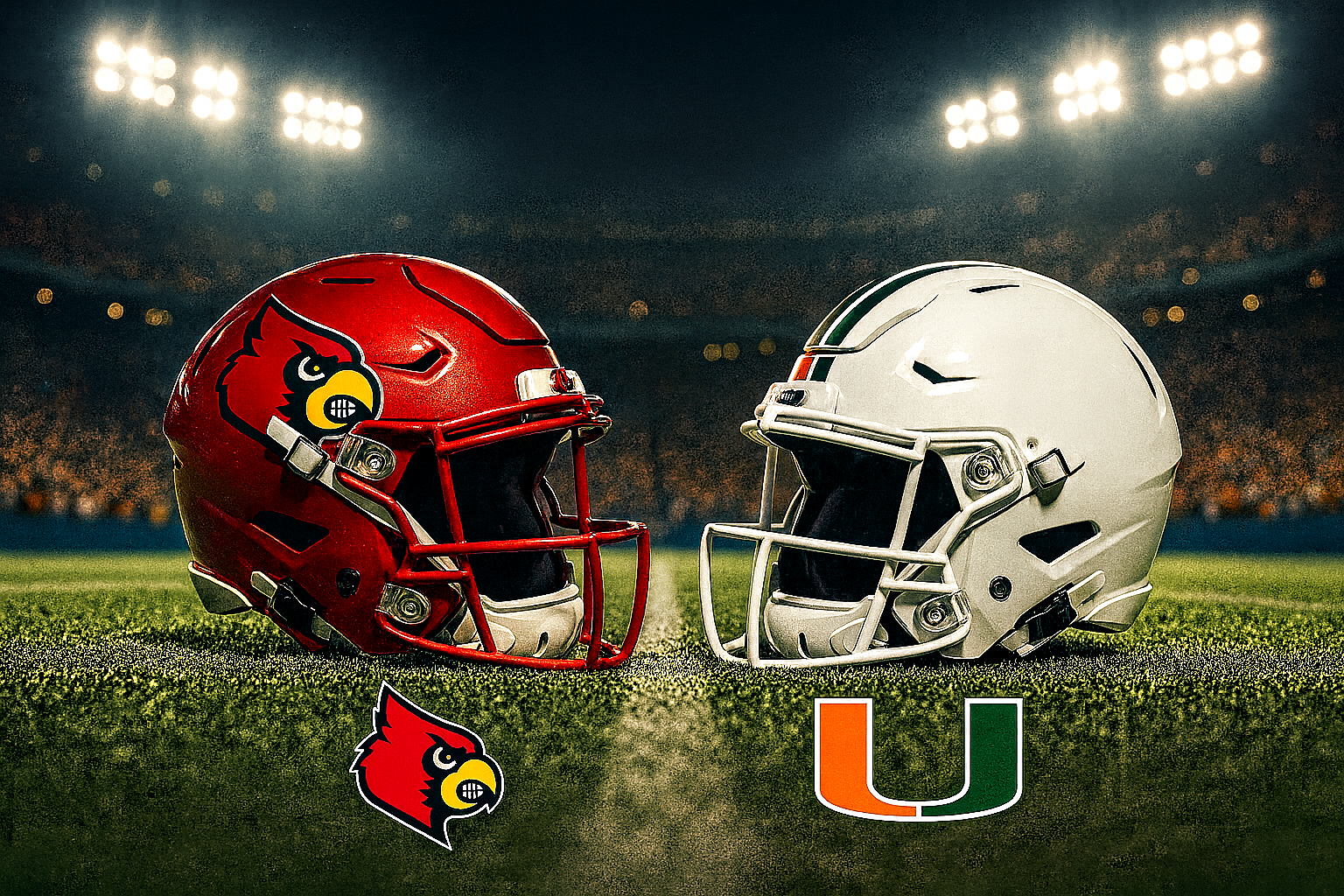
Cardinals Hand Hurricanes First Loss Behind Opportunistic Defense MIAMI GARDENS, Fla. — The Louisville Cardinals stunned the second-ranked Miami Hurricanes 24–21 Friday night at Hard Rock Stadium, forcing four interceptions and reclaiming the Schnellenberger Trophy in a tense finish before 66,573 fans . The win marked Louisville’s first victory over an AP top-two opponent since 2016 and ended Miami’s 10-game home winning streak. The Cardinals improved to 5–1 overall and 2–1 in the ACC , while Miami fell to 5–1 and 1–1 in league play . Quarterback Miller Moss led the way with 248 passing yards, two touchdowns, and a rushing score . Wide receiver Chris Bell continued his breakout season with nine receptions for 136 yards and both touchdown grabs. Running back Isaac Brown added 113 rushing yards on 15 carries , as the Cardinals’ balanced offense struck early and survived a late Miami rally. Defensively, Louisville controlled the tempo. The Cardinals held Miami to just 63 rushing yards on 24 attempts and intercepted quarterback Carson Beck four times — his first career game with more than two interceptions. Linebacker T.J. Capers sealed the victory with a late interception at the Louisville 30-yard line with 32 seconds remaining. Cardinals Start Fast Louisville wasted no time attacking Miami’s defense. On the opening possession, the Cardinals drove 75 yards in 11 plays. A 28-yard burst from Brown set up a fake field goal at the one-yard line, and Moss punched it in to give the visitors an early 7–0 lead. After a quick three-and-out by Miami, the Cardinals struck again. Moss found Bell on a crossing route, and the receiver outran two defenders for a 35-yard touchdown, stretching the lead to 14–0 just 10 minutes into the game. The Hurricanes, stunned by Louisville’s tempo and play-calling creativity, finally responded on their next drive. Beck connected with C.J. Daniels and Malachi Toney on back-to-back completions covering 69 total yards, setting up a two-yard touchdown run by Mark Fletcher Jr. that cut the lead to 14–7 . The first quarter ended with Louisville ahead, having scored on its first two possessions while forcing Miami to abandon its running game early. Louisville’s Defense Takes Over Momentum briefly shifted in the second quarter when the Hurricanes’ defense tightened, but Louisville’s secondary stole it back. Linebacker Antonio Watts intercepted Beck’s deep throw on the opening play of Miami’s second drive, giving the Cardinals the ball near midfield. Though the turnover didn’t immediately translate into points, it flipped field position and allowed Louisville’s defense to dictate pace. Miami’s next drive ended the same way — another deep interception, this time by Jabari Mack , who stepped in front of a sideline pass to halt a promising Hurricane possession. Toney reignited Miami’s offense with a 61-yard catch-and-run to the Louisville 9-yard line, but the Cardinals’ defense held firm. Kicker Carter Davis connected on a 27-yard field goal to narrow the gap to 14–10 with under two minutes left in the half. At halftime, Louisville led despite generating only 71 yards in its final four drives of the half. Still, the Cardinals’ defense — ranked No. 1 in the ACC entering the week — had limited Miami’s ground game and intercepted two of Beck’s passes. Special Teams Extend the Lead Louisville opened the third quarter with another composed drive, marching to Miami’s 30 before settling for a 48-yard field goal by Cooper Ranvier that pushed the lead to 17–10 . Miami answered with a steady 46-yard march of its own, capped by another Davis field goal from 41 yards out to make it 17–13 . But Louisville continued to control possession, aided by Moss’s accuracy on third downs and Bell’s consistency in the slot. Late in the third, Moss engineered an 8-play, 75-yard drive that ended with his second touchdown pass to Bell — a 36-yard strike through double coverage — restoring an 11-point advantage at 24–13 . Hurricanes Rally Late Miami’s defense briefly revived the home crowd midway through the fourth quarter. After Capers intercepted Beck for the third time, Keionte Scott stripped Brown on the very next play, and safety Zechariah Poyser recovered the fumble, returning it 13 yards to the Louisville 12. On the next snap, Toney took a jet sweep around the left side for a 12-yard touchdown. The Hurricanes then pulled out a trick play on the two-point conversion — Toney took a handoff and tossed a short pass to Daniels to cut the deficit to 24–21 with 7:37 remaining. Hard Rock Stadium erupted, sensing another Miami comeback. But Louisville’s composure held. The Cardinals’ offense drained nearly three minutes off the clock before punting, and their defense did the rest. Capers’ Interception Seals the Upset Trailing by three with just over four minutes to play, Beck guided the Hurricanes to midfield with completions to Daniels and Keelan Marion , moving into field-goal range. A short run by Jordan Lyle pushed the ball to the Louisville 31. With 36 seconds left, Miami appeared poised to at least tie the game. But on the next play, Beck’s pass over the middle was read perfectly by Capers, who leapt in front of Elija Lofton to make the game-clinching interception. Louisville’s sideline erupted as Moss took a knee to close out the program’s most significant road win in nearly a decade. It was Louisville’s first victory against a top-10 opponent on the road in 19 tries and the first time the Cardinals had beaten Miami at Hard Rock Stadium since 2023. Statistical Breakdown Louisville finished with 411 total yards — 248 through the air and 163 on the ground — while holding Miami to 334 yards of offense. The Cardinals’ four takeaways proved decisive, setting up two of their three touchdowns. Miller Moss: 23-of-37, 248 yards, 2 passing TDs, 1 rushing TD Chris Bell: 9 receptions, 136 yards, 2 TDs Isaac Brown: 15 carries, 113 yards Louisville Defense: 4 interceptions, 5 tackles for loss Miami’s offense showed flashes of brilliance but struggled with turnovers. Beck finished 25-of-35 for 271 yards, while Toney accounted for 147 total yards and two scores — one rushing and one passing on the conversion. Daniels added seven receptions for 74 yards. Trophy and Tradition With the victory, Louisville reclaimed the Schnellenberger Trophy , a bronze set of boots honoring legendary coach Howard Schnellenberger , who once led both programs. The Cardinals’ triumph marked the third straight season the rivalry had been decided by a single score. Louisville also ended Miami’s unbeaten home streak and handed the Hurricanes their first loss since November 2023 — also against the Cardinals. Looking Ahead Louisville returns home to face Boston College next Saturday at L&N Federal Credit Union Stadium, seeking its first 6–1 start since 2016. Miami will host Stanford on October 25, aiming to rebound before back-to-back road contests in November. Final Takeaway Louisville’s performance in Miami represented more than just an upset — it was a statement. Behind Moss’s steady leadership, Bell’s breakout game, and a defense that forced turnovers in critical moments, the Cardinals delivered their most complete win of the season. For Miami, the loss served as a harsh reminder that even the nation’s elite are vulnerable when mistakes mount. The Hurricanes’ high-powered offense met its match in a Louisville defense that refused to break — and in the end, it was the visitors celebrating under the South Florida lights with the Schnellenberger Trophy back in hand.
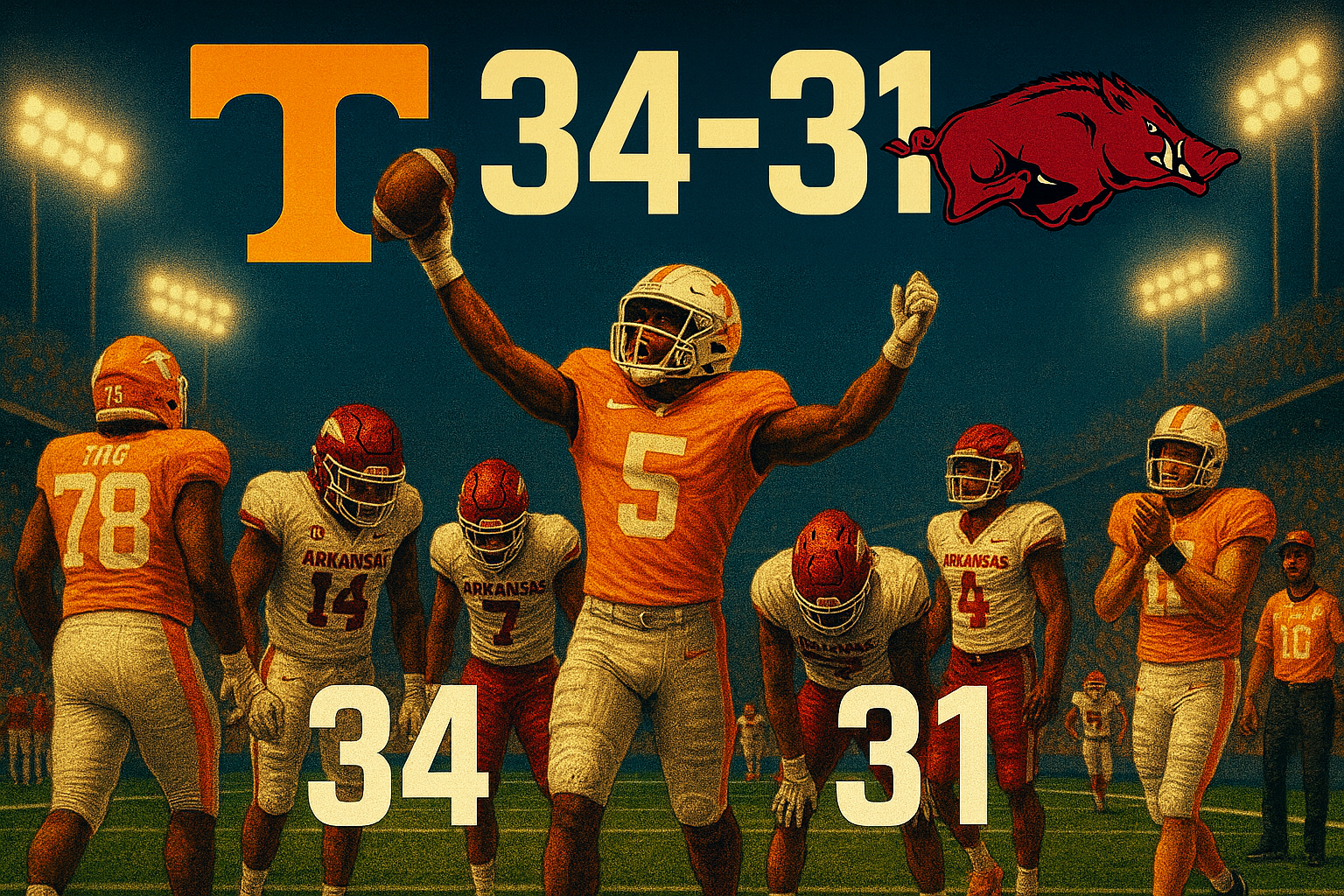
Bishop and Lewis Combine for Three Touchdowns as Vols Survive Razorbacks’ Late Surge KNOXVILLE, Tenn. — The No. 12 Tennessee Volunteers survived a scare on Saturday night, edging Arkansas 34–31 in a back-and-forth SEC showdown at Neyland Stadium. Running backs DeSean Bishop and Peyton Lewis powered the Volunteers’ offense, combining for 232 rushing yards and three touchdowns to help Tennessee improve to 5–1 overall and 2–1 in SEC play. It was an emotional evening for the Razorbacks (2–4, 0–2), who took the field for the first time since parting ways with head coach Sam Pittman . Under interim coach Bobby Petrino , Arkansas played with renewed aggression and nearly pulled off the upset, but turnovers and missed opportunities ultimately proved costly. The Vols rolled up 485 total yards — 264 on the ground and 221 through the air — while forcing three fumbles and sacking Arkansas quarterback Taylen Green five times. Quarterback Joey Aguilar led the balanced attack with 221 passing yards and a touchdown, while wide receiver Braylon Staley added six catches for 109 yards. Early Fireworks in Knoxville Arkansas set the tone early, winning the coin toss and scoring on its opening drive. Green capped a nine-play march with an 11-yard rushing touchdown to give the Razorbacks a 7–0 lead. Tennessee answered quickly, moving 75 yards in seven plays before Bishop burst through the right side for a 17-yard touchdown run that tied the game 7–7 with 7:39 left in the first quarter. The Razorbacks retook the lead late in the period with a 28-yard field goal from Scott Starzyk to go up 10–7 after one quarter. Tennessee responded again early in the second. Max Gilbert’s 37-yard field goal made it 10–10, but Arkansas punched back moments later when running back Mike Washington Jr. powered across the goal line from one yard out to restore the lead, 17–10, midway through the quarter. Just as the Razorbacks seemed to gain momentum, the Vols struck again. Aguilar found Staley deep downfield for a 42-yard completion, and two plays later hit tight end Miles Kitselman for an eight-yard touchdown to tie the score 17–17 with just under three minutes left in the half. Vols Take Control in the Third Quarter After a first half filled with explosive plays and offensive balance, Tennessee’s defense began asserting control after halftime. Gilbert’s 50-yard field goal on the opening drive of the third quarter gave the Vols their first lead of the night at 20–17. From there, the Volunteers’ defensive front dominated the line of scrimmage. Defensive ends Joshua Josephs and Jordan Ross consistently pressured Green, forcing hurried throws and three fumbles. Daevin Hobbs and Tyre West each added sacks as the Vols racked up nine tackles for loss on the night. Midway through the third, Tennessee extended its lead on a 74-yard drive highlighted by Bishop’s steady ground gains. On second-and-goal from the two, Lewis barreled up the middle for his first touchdown of the game, making it 27–17. The defense continued its relentless play. Josephs forced another fumble early in the fourth quarter that was recovered by freshman linebacker Jadon Perlotte at the Arkansas 19-yard line. Four plays later, Lewis scored again, running over defenders on a powerful eight-yard rush to extend the lead to 34–17 with just over 13 minutes remaining. Arkansas Mounts a Comeback Down 17, Arkansas refused to back down. Green led an impressive drive midway through the fourth, hitting tight end Rohan Jones for a nine-yard touchdown to narrow the gap to 34–24. The Razorbacks’ defense forced a quick Tennessee punt, setting up another scoring opportunity. Green capitalized again, connecting with wide receiver Kam Shanks on a 12-yard strike — his first touchdown as a Razorback — to make it 34–31 with 2:55 left on the clock. The Tennessee crowd fell silent as the Razorbacks lined up for a potential game-winning drive, but Aguilar’s composure under pressure sealed the win. On second down from his own 25, the quarterback kept the ball on a designed run, breaking free for 28 yards to move the chains. A few plays later, Lewis plowed ahead for another first down, allowing the Vols to run out the final two minutes and escape with a narrow victory. Bishop Shines Before Injury Before exiting late in the third quarter with a leg injury, DeSean Bishop delivered his best collegiate performance. The sophomore running back carried the ball 14 times for a career-high 146 yards, averaging more than 10 yards per carry. His first-quarter touchdown helped spark the Tennessee offense and set the tone for the game. When Bishop went down, Peyton Lewis stepped up seamlessly, finishing with 86 rushing yards on 17 carries and two scores. His physical running style wore down the Razorbacks’ defense and helped Tennessee control the clock late in the game. Aguilar’s efficiency complemented the ground attack. The junior quarterback completed 16 of 25 passes and displayed excellent pocket awareness, connecting with seven different receivers. Staley, in particular, was a consistent deep threat, notching his first 100-yard receiving game of the season. Defensive Grit and Key Takeaways While the offense provided the fireworks, Tennessee’s defense made the difference when it mattered most. The Vols’ ability to create turnovers and apply pressure proved crucial against a mobile quarterback like Green. Safety Andre Turrentine led the team with 11 tackles, while Edrees Farooq added nine stops, a forced fumble, and a pass breakup. Linebacker Arion Carter chipped in eight tackles and a fumble recovery, continuing his breakout season. Ross and Josephs were constant forces on the edge, combining for 2.5 sacks and two forced fumbles. Their disruption prevented Arkansas from establishing consistent rhythm, even as Green fought to keep drives alive with his legs. Despite giving up late scores, the defense held firm in the final minutes, allowing just 77 rushing yards in the second half after yielding 156 before the break. Razorbacks Show Fight Amid Transition For Arkansas, the loss came with both frustration and promise. Under interim coach Bobby Petrino , the Razorbacks played with urgency, displaying a more aggressive offensive approach. Green completed 23 of 35 passes for 256 yards, two touchdowns, and one rushing score while adding 63 yards on the ground. Running back Mike Washington Jr. was equally impressive, rushing for 131 yards on 19 carries — his second 100-yard performance since transferring to Arkansas. Wide receiver Raylen Sharpe caught seven passes for 74 yards, extending his streak of games with a reception to 35, one of the longest active runs in the nation. Defensively, linebacker Stephen Dix Jr. led the team with 11 tackles, marking his fourth career double-digit game and second of the season. Still, the Razorbacks’ inability to capitalize on turnovers and a failed fourth-down attempt deep in Tennessee territory proved decisive. What’s Next Tennessee’s victory kept its SEC title hopes alive and provided momentum heading into a crucial stretch that includes matchups against Alabama, Kentucky, and Oklahoma. The Vols’ offense continues to evolve, but their defense remains the foundation of their success. Arkansas, meanwhile, will look to regroup at home next week when it hosts Texas A&M . The Razorbacks will aim to clean up turnovers and build on Green’s improved command of the offense as they navigate the remainder of a challenging conference slate. In the end, Tennessee’s mix of explosive offense and opportunistic defense proved just enough to hold off a determined Arkansas team. The victory wasn’t perfect, but it was another reminder that the Volunteers remain a legitimate SEC contender .
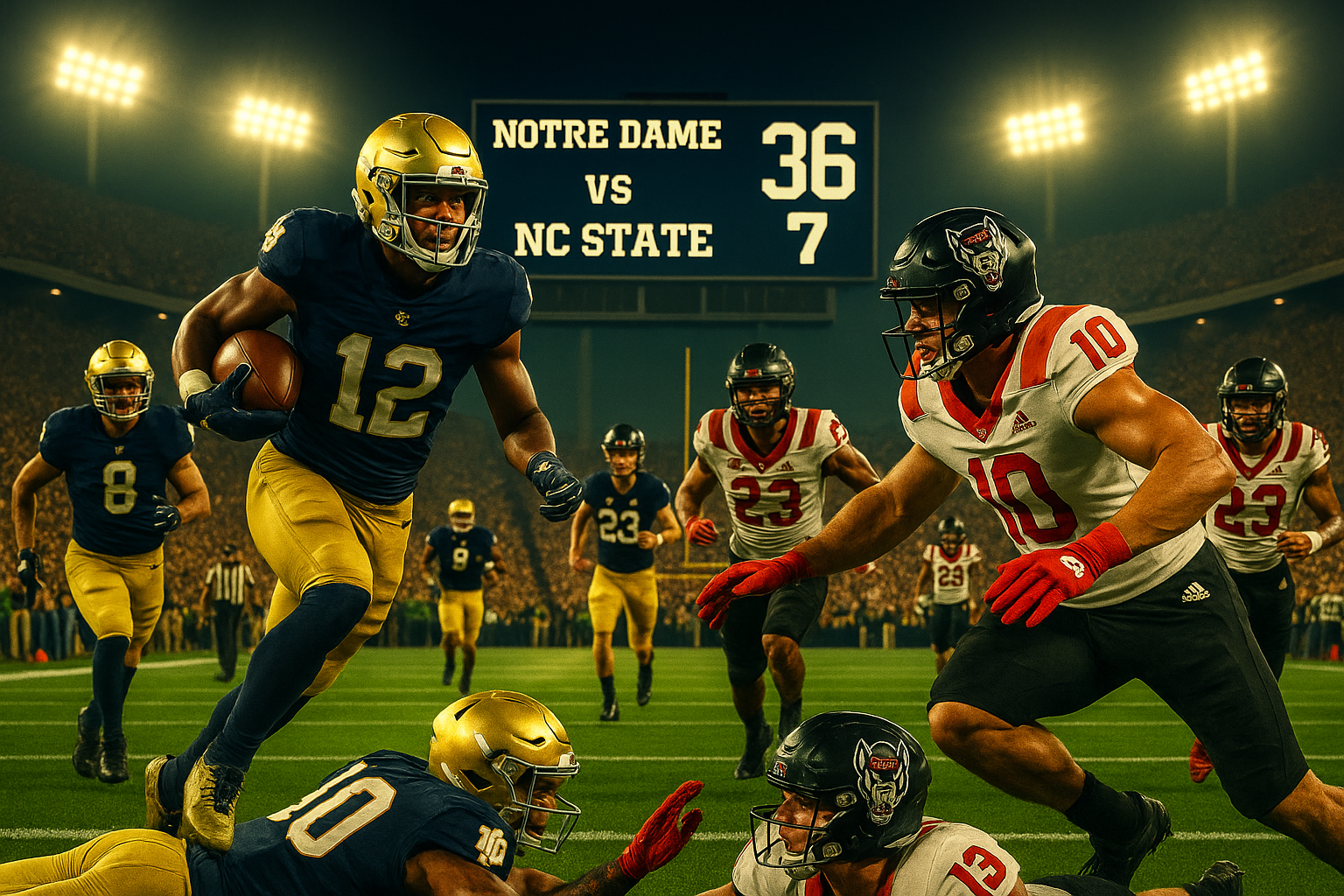
Fighting Irish Win Fourth Straight Behind Carr’s Career Day SOUTH BEND, Ind. — The No. 16 Notre Dame Fighting Irish extended their winning streak to four games with a decisive 36–7 victory over the NC State Wolfpack on Saturday at Notre Dame Stadium. Despite a close first half that ended 10–7 in favor of the Irish, the home team erupted in the second half, scoring 26 unanswered points and shutting down one of the ACC’s top offenses. Quarterback C.J. Carr led the charge with a career-best performance, throwing for 342 yards and two touchdowns . His precision passing and command of the offense fueled a balanced attack that overwhelmed NC State’s defense. Wide receivers Will Pauling and K.K. Smith each found the end zone, while tight end Eli Raridon turned in his first career 100-yard game, catching seven passes for 109 yards. Running back Jeremiyah Love added 86 rushing yards and two touchdowns as the Irish improved to 4–2 on the season. Their defense, meanwhile, continued its dominant stretch, forcing four turnovers — including three interceptions — and recording a safety to cap off a second-half shutout. Early Battle: NC State Holds Strong Notre Dame opened the game with authority, driving 75 yards on its first possession. After several completions from Carr to Pauling, Love powered his way into the end zone from two yards out to give the Irish an early 7–0 lead . NC State, however, quickly showed it would not go quietly. The Wolfpack defense forced back-to-back punts and then capitalized on field position midway through the second quarter. Quarterback C.J. Bailey connected with wide receiver Terrell Anderson for a 45-yard touchdown strike, tying the game at 7–7. Anderson, who entered the game as NC State’s leading receiver, would later leave with an injury and not return. The Wolfpack defense followed with one of its best sequences of the afternoon, stopping Notre Dame on a fourth-down attempt deep in Irish territory. But the Irish regained momentum before halftime. With time winding down, Carr guided a quick drive featuring completions to Raridon and Malachi Fields , setting up kicker Noah Burnette for a 48-yard field goal that gave Notre Dame a 10–7 lead at the break. At halftime, NC State’s defense had held the Irish to just 59 rushing yards — tied for Notre Dame’s lowest first-half total this season — and looked poised to keep the game within reach. Second Half Surge: Notre Dame Pulls Away The tide turned completely in the third quarter. Notre Dame’s offense found its rhythm early, thanks to a well-timed fake punt that changed the game’s complexion. Facing fourth-and-two on their own 38-yard line, the Irish lined up to punt but shifted into a direct snap to backup quarterback Tyler Buchner , who powered forward for a first down. The successful trick play ignited the Notre Dame sideline and silenced the Wolfpack crowd. Moments later, Carr hit Smith on an 18-yard touchdown pass to extend the lead to 17–7 . The Irish would never look back. On NC State’s next possession, pressure from Notre Dame’s defensive front forced Bailey into a hurried throw that was intercepted by safety Adon Shuler and returned deep into Wolfpack territory. Although the Irish offense couldn’t reach the end zone on that series, Burnette’s 34-yard field goal pushed the lead to 20–7 . The Wolfpack offense unraveled from there. Bailey threw another interception on the following drive, this time to linebacker Kyngstonn Viliamu-Asa , setting up another short field for Notre Dame. Two plays later, Carr connected with Pauling for a 12-yard touchdown, making it 27–7 midway through the third quarter. As the Wolfpack continued to struggle with ball control, the Irish defense tightened its grip. Defensive lineman Boubacar Traore recorded two of Notre Dame’s four sacks, repeatedly collapsing the pocket and forcing errant throws. The relentless pressure culminated in a disastrous sequence for NC State — a fumble in the end zone recovered for a safety — giving Notre Dame a 29–7 advantage late in the third quarter. Fourth Quarter Control: Irish Seal the Win The Irish added one more touchdown in the fourth quarter to complete the rout. Following the safety, Carr found Raridon on a deep route to set up Love’s second rushing touchdown of the game from four yards out. That score capped a 26–0 second-half surge and showcased Notre Dame’s offensive depth. Defensively, the Irish closed the game in dominant fashion. Cornerback Karson Hobbs intercepted a desperation pass from Bailey in the red zone on NC State’s final drive, marking the team’s third pick of the day. From there, Notre Dame entered victory formation to close out the 36–7 win. The second-half dominance was reflected in the numbers: Notre Dame outgained NC State 277–75 after halftime and controlled possession for over 19 minutes. The Irish finished with 485 total yards of offense , their second-highest output of the season, while holding NC State to a season-low 233 yards. Defensive Prowess and Key Performances Notre Dame’s defense once again proved why it’s among the nation’s best. The unit allowed just three touchdowns in its last three games and has generated seven interceptions over that span. Linebackers Drayk Bowen and Tae Johnson led the team with seven tackles apiece, while the front line dominated the trenches, recording five tackles for loss and a safety. For NC State, it was a frustrating day offensively. Bailey completed 17 of 30 passes for 186 yards and one touchdown but was intercepted three times. Running back Hollywood Smothers — the ACC’s leading rusher entering the game — was held to just 46 yards on 12 carries. The Wolfpack, averaging over 440 yards per game coming in, were limited to barely half that production. NC State’s lone bright spot came from linebacker Caden Fordham , who led all players with 10 tackles and a sack. But the Wolfpack defense struggled to contain Notre Dame’s passing game, allowing multiple receivers to surpass 100 yards for the first time this season. The Turning Point The game’s pivotal moment came with the fake punt early in the third quarter. That gamble shifted momentum firmly in Notre Dame’s favor, sparking three straight scoring drives and breaking open what had been a tightly contested matchup. From that point on, the Wolfpack never recovered, as turnovers and injuries compounded their second-half collapse. Notre Dame’s ability to adjust offensively — spreading the field through Carr’s passing attack instead of relying solely on its running game — was another key factor. By the fourth quarter, the Wolfpack defense had little left, overwhelmed by tempo and precision passing. Looking Ahead The win improved Notre Dame’s record to 4–2 and strengthened its case to move up in the national rankings. The Irish will return home next weekend for a marquee matchup against Southern California , looking to continue their climb toward a potential New Year’s Six bowl appearance. NC State, now 4–3 , will enter a much-needed bye week before traveling to Pittsburgh on October 25. The Wolfpack have lost three of their last four games, and head coach Dave Doeren’s group will look to regroup and refocus for the stretch run of conference play. For Notre Dame, the victory was a complete statement of balance and resilience. The Irish combined explosive offense, relentless defense, and sharp in-game adjustments to turn a narrow halftime lead into a commanding win. As October continues, the message from South Bend is clear — this team is playing its best football at the right time.
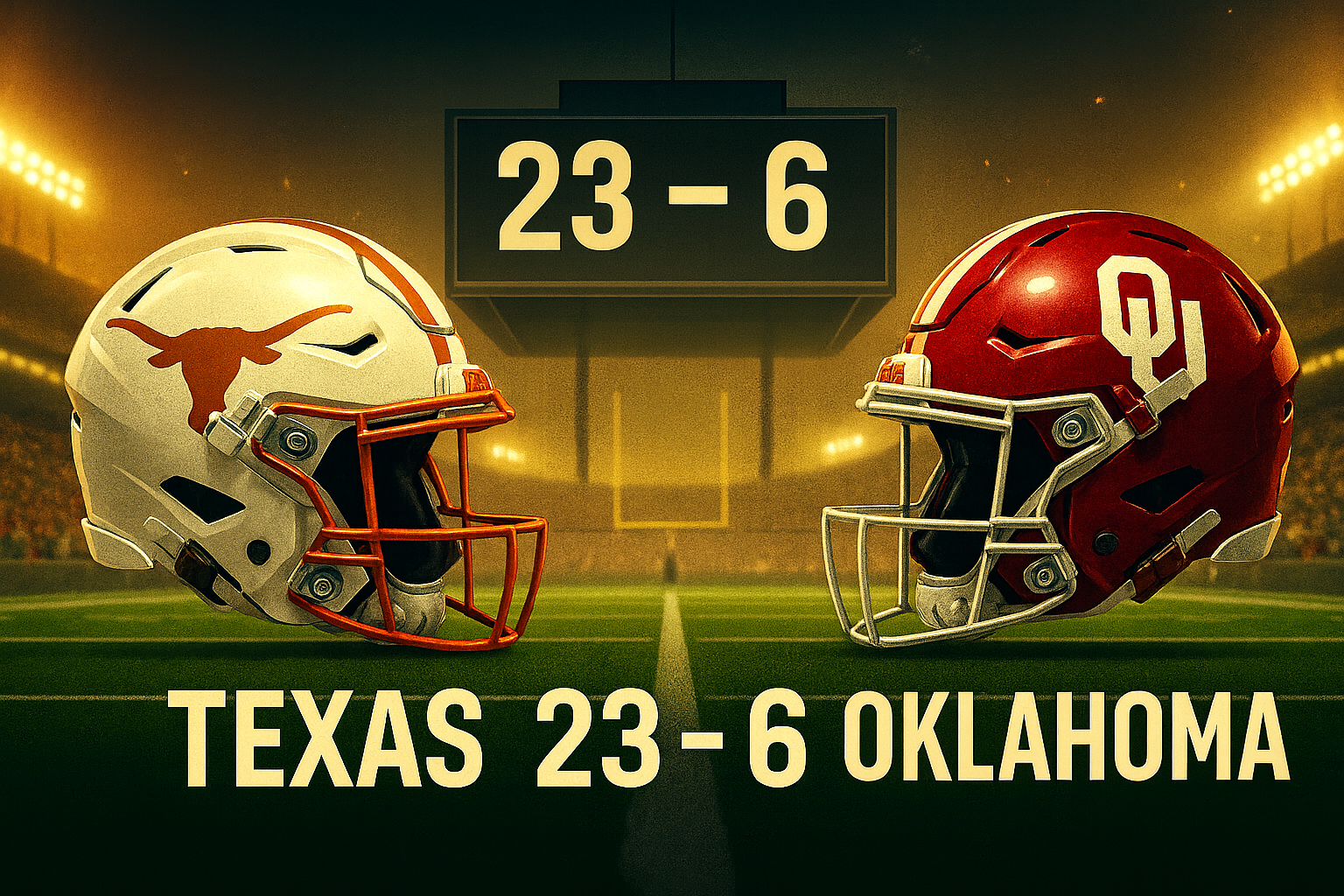
Longhorns’ Defense Shines as Arch Manning Leads Balanced Attack DALLAS, Texas — The annual Red River Rivalry delivered another classic chapter Saturday at the Cotton Bowl, but this time, it was Texas that dictated every phase of the game. Behind a smothering defense and a composed outing from quarterback Arch Manning , the Longhorns overpowered No. 6 Oklahoma 23–6, reclaiming the Golden Hat trophy and reasserting their place among the nation’s elite. The victory marked the second straight year Texas has defeated Oklahoma and the first time since 2008–09 that the Longhorns have won consecutive games in the historic rivalry. More importantly, it gave Texas (4–2, 1–1 SEC) its first victory over a top-10 opponent this season, while the Sooners (5–1, 1–1) suffered their first loss of the year. Manning completed 21 of 27 passes for 166 yards and one touchdown, spreading the ball across multiple receivers with precision and poise. Running back Quintrevion Wisner powered the ground attack with 94 rushing yards on 22 carries, adding 35 receiving yards to cap off a productive afternoon. Texas finished with 302 total yards, converting on third down at an extraordinary rate — 11-of-12 — while controlling time of possession and tempo throughout the contest. First Half: Oklahoma Strikes Early, but Texas Responds Oklahoma opened the scoring with a 42-yard field goal from Tate Sandell after an early defensive stop. On the Sooners’ next possession, a defensive stand by Texas forced another field goal, giving Oklahoma a 6–0 lead at the end of the first quarter. But from that point forward, the game shifted decisively in the Longhorns’ favor. The turning point came midway through the second quarter when Texas defensive back Malik Muhammad intercepted a pass from Oklahoma quarterback John Mateer near midfield. The takeaway energized the Texas sideline and set up a short drive that resulted in a 22-yard field goal from Mason Shipley , trimming the deficit to 6–3. The Longhorns’ defense struck again late in the half when Muhammad intercepted another pass — this time in the end zone — preventing an Oklahoma score before halftime. It marked the first multi-interception performance by a Texas player in the Red River Rivalry since 2016. Although Texas trailed 6–3 at the break, the second half would belong entirely to the Longhorns. Second Half: Manning and the Defense Take Over Texas wasted no time seizing control after the break. Manning orchestrated a 75-yard drive on the opening possession of the third quarter, completing all six of his pass attempts. He capped the drive with a 12-yard touchdown strike to wide receiver DeAndre Moore Jr. , giving Texas its first lead at 10–6 with 7:49 remaining in the third quarter. On Oklahoma’s ensuing drive, Texas’ front seven applied relentless pressure. Edge rusher Colin Simmons recorded his third consecutive game with a sack, pushing the Sooners out of scoring range. After another Texas stop, Shipley drilled a 48-yard field goal — the longest of his season — extending the Longhorns’ lead to 13–6 heading into the fourth quarter. The Texas defense continued to dominate, holding Oklahoma to just 88 total yards in the second half and forcing three interceptions overall — the most by Texas in the rivalry since 2002. Linebackers Brad Spence and Lance Jackson combined for a critical late-game sack that halted Oklahoma’s final drive, punctuating a complete defensive performance. Fourth Quarter: Niblett’s Punt Return Breaks the Game Open With less than 10 minutes remaining, Texas delivered the knockout blow. Following another defensive stand, freshman Ryan Niblett fielded a 48-yard punt near his own 25-yard line, sprinted up the right sideline, and broke free for a 75-yard touchdown — his first career return score and the longest punt return in the rivalry since 2013. The play sent the Texas sideline and the Cotton Bowl crowd into a frenzy, extending the lead to 20–6 with 9:59 left. Oklahoma’s offense, desperate to respond, managed only brief flashes of rhythm. A promising drive late in the fourth quarter stalled at the Texas 27-yard line after Mateer was sacked on consecutive plays and then threw incomplete on fourth down. Texas capitalized on the ensuing possession with Shipley’s third field goal of the day, this time from 39 yards, putting the game out of reach at 23–6. From there, the Longhorns’ defense closed the door. On Oklahoma’s final drive, Mateer was sacked again — this time by a combination of Spence and Jackson — before Texas ran out the clock to secure the dominant win. Defensive Brilliance Defines the Win The hallmark of the Texas performance was its defensive intensity and precision. The Longhorns held Oklahoma without a touchdown — the first time they have done so against a top-10 opponent since 1979, when they blanked Missouri 21–0. Texas limited Oklahoma to just 258 total yards , including 88 after halftime, and allowed the Sooners to convert only three of 13 third downs. The Longhorns also held their opponent under 100 rushing yards for the fifth time in six games this season. Muhammad’s two interceptions led a defensive unit that thrived on disruption. Simmons, Spence, and Jackson combined for three sacks, while defensive backs Graceson Littleton and Jahdae Barron provided lockdown coverage on the outside. Linebacker Anthony Hill added five tackles and a pair of quarterback pressures, contributing to a group that swarmed to the football on every possession. Special Teams and Offensive Efficiency Texas’ special teams were equally instrumental in the win. In addition to Niblett’s electrifying return, Shipley remained steady, going 3-for-5 on field goals, including makes from 22, 48, and 39 yards. His two long-range conversions helped Texas maintain control even when drives stalled. Offensively, Manning’s efficiency stood out. The sophomore quarterback finished with an 81 percent completion rate, including 11-for-12 passing on third downs — an exceptional mark that kept the offense moving and wore down Oklahoma’s defense. Wisner’s physical running style complemented Manning’s precision. His 37-yard burst in the second quarter set up Texas’ first field goal, while his short-yardage consistency allowed the Longhorns to stay ahead of the chains. Wide receivers Moore Jr. and Parker Livingstone provided reliable options in the passing game, while tight end Gunnar Helm contributed key blocks that helped open running lanes. Texas’ offensive line also deserves credit for protecting Manning, allowing just one sack against an Oklahoma defense that had averaged three per game entering the matchup. Oklahoma’s Missed Opportunities For the Sooners, the afternoon was one of frustration and missed chances. Quarterback John Mateer , making his return from hand surgery, threw for 202 yards but was intercepted three times — all at crucial junctures. Wideouts Deion Burks and Isaiah Sategna III each surpassed 60 receiving yards, while freshman Tory Blaylock led the team in rushing with just 33 yards. Defensively, Oklahoma’s front seven made occasional stops, with Kendall Daniels leading the team with six tackles and Taylor Wein adding three tackles for loss. However, the Sooners failed to generate consistent pressure, allowing Manning to settle into rhythm throughout the second half. The loss marked Oklahoma’s second straight in the Red River Rivalry, following a 34–3 defeat last season, and dropped them out of the ranks of the nation’s unbeaten teams. Looking Ahead With the victory, Texas improved to 65–51–5 all-time against Oklahoma in one of college football’s most storied rivalries. The Longhorns will travel to Lexington next week to face Kentucky, while Oklahoma heads to Columbia to take on South Carolina. The win restored momentum to a Texas team that entered the contest needing a statement performance. For head coach Steve Sarkisian’s squad, it was proof of growth — a display of balance, discipline, and defensive excellence that reestablished the Longhorns as a force in the SEC. From start to finish, the Longhorns outplayed, outcoached, and outlasted their fiercest rival, leaving Dallas with both the Golden Hat and a renewed sense of purpose for the rest of the season.
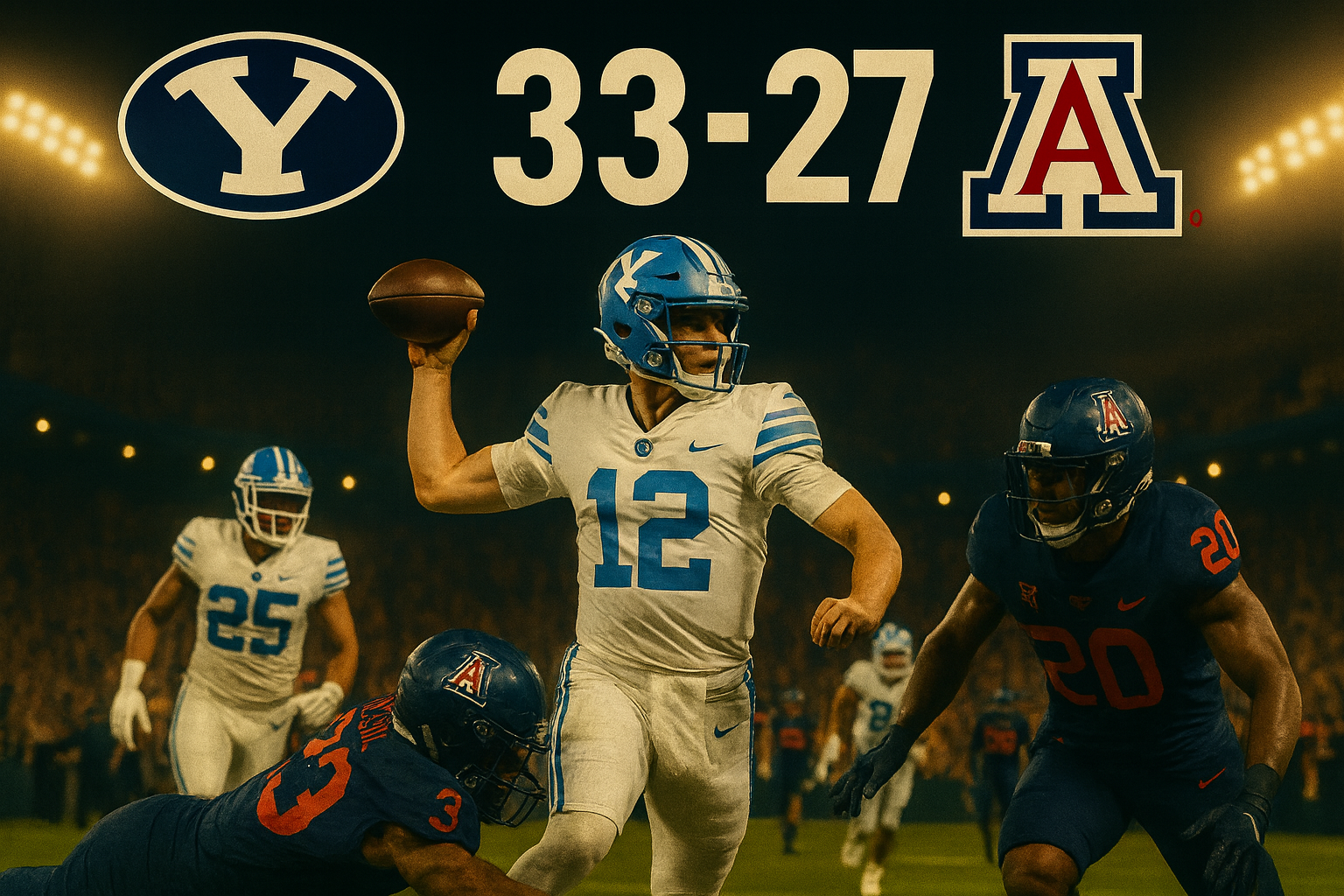
Cougars Overcome Weather Delay and Fourth-Quarter Deficit to Remain Perfect TUCSON, Ariz. — The No. 18 BYU Cougars remained undefeated in dramatic fashion Saturday night, overcoming a lightning delay, a double-overtime battle, and a ten-point fourth-quarter deficit to defeat Arizona 33–27 at Arizona Stadium. The victory improved BYU to 6–0 overall and 3–0 in Big 12 play , marking the first time in program history the Cougars have opened back-to-back seasons with six consecutive wins. Freshman quarterback Bear Bachmeier powered BYU’s comeback with 172 passing yards and 89 rushing yards , accounting for three total touchdowns. His seven-yard rushing score in the second overtime sealed the win after a grueling five-hour contest that tested both teams’ stamina and composure. Running back LJ Martin turned in a career-best performance with 162 rushing yards and one touchdown , pacing an offense that produced 258 yards on the ground — the most Arizona has allowed in a game this season. Linebacker Siale Esera led BYU’s defense with a career-high 16 tackles as the Cougars held firm late to preserve the victory. For Arizona (4–2, 1–2 Big 12) , the loss was a heartbreaker. The Wildcats led 24–14 midway through the fourth quarter but were unable to hold off BYU’s late surge. Quarterback Noah Fifita threw for 219 yards and two touchdowns, while receiver Kris Hutson hauled in nine passes for 106 yards and a score. Fast Start for the Cougars BYU opened the game with precision and pace, dominating the early stages on both sides of the ball. The Cougars marched downfield on their second possession, with Martin bursting through the middle for a 28-yard touchdown that gave them a 7–0 lead midway through the first quarter. Moments later, Bachmeier connected with wideout Parker Kingston over the middle for a 75-yard touchdown strike, extending the advantage to 14–0. The Cougars appeared in full control, executing crisp blocking schemes and converting both third-down attempts on the opening drives. Arizona’s offense found rhythm late in the first quarter as Fifita began distributing the ball efficiently. A 14-play, 77-yard drive culminated in Chris Hunter’s 35-yard touchdown reception, trimming BYU’s lead to 14–7 early in the second quarter. Just as the Wildcats gained momentum, play was halted by a lightning delay caused by the remnants of Hurricane Priscilla. The stoppage lasted more than 75 minutes and shifted the tone of the game entirely. Arizona Takes Control After Delay The extended delay seemed to benefit the home team. When play resumed, Arizona’s defense tightened, forcing BYU into consecutive punts. Fifita capitalized late in the half, leading an efficient two-minute drive capped by a touchdown pass to Hunter, giving Arizona its first lead at 17–14 heading into halftime. BYU’s rushing attack, which dominated early, stalled under Arizona’s adjustments. The Wildcats’ front seven began winning battles at the line of scrimmage, limiting Martin’s space and disrupting Bachmeier’s rhythm. Arizona extended its lead in the third quarter, capitalizing on BYU’s first turnover. Fifita orchestrated a balanced drive, mixing short completions with runs from Kedrick Reescano , who broke multiple tackles for a 36-yard touchdown run. The score gave the Wildcats a 24–14 advantage with just over 11 minutes to play, putting the Cougars in unfamiliar territory. Bachmeier and the Cougars Battle Back Facing their largest deficit of the season, BYU turned to its freshman quarterback. Bachmeier responded with a poised, methodical approach that showcased both his arm and legs. On a crucial fourth-quarter possession, he led a 12-play, 75-yard drive, highlighted by two scrambles that kept the offense alive on third down. With less than 20 seconds remaining, Bachmeier rolled right and powered through defenders for a two-yard touchdown, tying the game at 24–24 and sending it to overtime. BYU’s defense matched the intensity. Esera and linebacker Faletau Satuala combined for multiple key tackles on Arizona’s ensuing drives, including a stop at the one-yard line that prevented the Wildcats from reclaiming the lead earlier in the quarter. The defensive front, led by Cashius Howell and Isaiah Glasker , disrupted Fifita’s timing and limited explosive plays downfield. First Overtime: Trading Blows The opening overtime period mirrored the game’s dramatic swings. Both teams exchanged field goals — BYU’s Randy Bond converted from 38 yards, while Arizona’s Trey Smack answered with a 42-yarder to make it 27–27 . BYU appeared poised to end it in the first extra session, but a third-down pass from Bachmeier was deflected at the line. The Wildcats’ defense momentarily held firm, setting up a second overtime that would determine the outcome. Second Overtime: Bachmeier Seals It In the second overtime, BYU wasted no time asserting control. On third-and-four from the seven-yard line, Bachmeier called his own number, slicing through the middle for the go-ahead touchdown. The two-point conversion attempt was broken up, keeping the score 33–27 and leaving the door open for Arizona. The Wildcats’ final drive ended in heartbreak. On fourth down, Fifita’s fade pass toward the back of the end zone slipped through receiver Javin Whatley’s hands, falling incomplete and sealing BYU’s sixth consecutive win. As the Cougars celebrated, their defense — which had endured nearly 90 plays — walked off the field with another defining moment in a season built on resilience and balance. Key Performances Bachmeier’s leadership under pressure defined the night. The freshman finished with 261 total yards and three touchdowns, becoming the first BYU quarterback since 2014 to lead a double-digit fourth-quarter comeback. His mobility and decision-making were instrumental in sustaining drives during the Cougars’ late push. Martin’s 162-yard outing marked the fifth 100-yard rushing game of his career and his third this season. The offensive line, led by Kingsley Suamataia , paved the way for 258 total rushing yards — BYU’s highest single-game total since joining the Big 12. Defensively, Esera’s 16 tackles doubled his previous career high, while Glasker’s interception in the third quarter halted an Arizona drive deep in BYU territory. The defense also tallied seven tackles for loss and two takeaways, including Howell’s late-game fumble recovery that flipped momentum in the fourth quarter. For Arizona, Fifita’s 219 passing yards and two touchdowns highlighted another efficient outing, but late pressure and dropped passes derailed potential scoring drives. Reescano’s 91 rushing yards and physical style gave the Wildcats balance early, while Hutson’s reliability in key situations kept the chains moving throughout the night. Historical Context and What’s Next The win cemented BYU’s place among college football’s most consistent programs under head coach Kalani Sitake , who secured his 75th career victory . It also marked the Cougars’ first overtime win since 2022, when they defeated Baylor 26–20 in Provo. For BYU, the victory not only preserved an undefeated record but also secured bowl eligibility for the eighth time in the Sitake era. The Cougars will now prepare for their next major test — a home matchup against rival Utah on Saturday, Oct. 18. Arizona, meanwhile, will look to regroup when it travels to Houston next weekend. Despite the loss, the Wildcats showed flashes of the offensive efficiency that fueled their early-season success. Final Takeaway Saturday night in Tucson offered a showcase of BYU’s character — a blend of grit, depth, and discipline that continues to define its ascent in the Big 12. Through lightning delays, a hostile crowd, and a double-overtime test, the Cougars proved once again why they belong among college football’s elite. For a young quarterback like Bachmeier and a team determined to sustain perfection, the 33–27 victory wasn’t just another win — it was a defining moment in a season built on composure, belief, and execution
Weekly Press Conferences
College Football Action Shots
2024 Season

